This comprehensive annual report details the key initiatives, achievements, and ongoing activities of the Ministry of Personnel, Public Grievances & Pensions for the fiscal year 2018-2019. It covers a wide range of functions across its departments, including personnel policies, administrative reforms, public grievances redressal, pensions and pensioners’ welfare, cadre management, training programs, and vigilance measures. The report highlights the Ministry’s commitment to improving governance, enhancing public service delivery, and ensuring the welfare of government employees and pensioners.
SOURCE PDF LINK :
Click to access AR%202018-19%20English.pdf
Click to view full document content
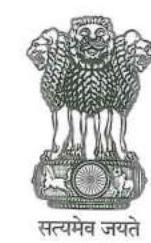
Ministry of Personnel, Public Grievances & Pensions
Government of India
ANNUAL REPORT 2018-2019
ANNUAL REPORT 2018-19
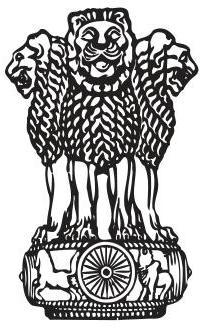
सत्यमेव जयते
Ministry of Personnel, Public Grievances and Pensions
Government of India
.
CONTENTS
| List of chapters | Page Nos. | |
|---|---|---|
| Vision and Mission | ||
| Executive Summary | ||
| DEPARTMENT OF PERSONNEL AND TRAINING | ||
| 1 | Overview | 1 |
| 2 | Major Initiatives/Achievements/Events during the year | 7 |
| 3 | Personnel Policies | 19 |
| 4 | Reservation in the Central Government services | 38 |
| 5 | Cadre Management | 45 |
| a) Indian Administrative Service (IAS) | 45 | |
| b) Central Secretariat Service (CSS) | 51 | |
| c) Central Secretariat Stenographer Service (CSSS) | 55 | |
| d) Central Secretariat Clerical Service (CSCS) | 58 | |
| e) State Reorganization | 59 | |
| 6 | Senior Appointments under Government of India | 63 |
| 7 | Training Policy and Programmes | 68 |
| 8 | Training Institutions | 77 |
| 9 | Administrative Vigilance Division | 97 |
| 10 | International Cooperation | 107 |
| 11 | Central Bureau of Investigation | 110 |
| 12 | Joint Consultative Machinery | 122 |
| 13 | Administrative Tribunals | 124 |
| 14 | Staff Welfare | 130 |
| 15 | Right to Information | 143 |
| 16 | Grievance Redressal Mechanism & Citizens’ Charter | 148 |
| 17 | Progressive Use of Hindi in Official Works | 150 |
| 18 | Financial Management | 156 |
| — | — | — |
| 19 | DEPARTMENT OF ADMINISTRATIVE REFORMS AND PUBLIC GRIEVANCES | 162 |
| 20 | Administrative Reforms | 175 |
| 21 | Public Grievances | 181 |
| 22 | Organisation and Methods Division | 186 |
| 23 | E-Governance | 188 |
| 24 | International Exchange & Cooperation (IE\&C) | 191 |
| 25 | Documentation and Dissemination Division (D\&D) | 195 |
| 26 | Hindi Section | 200 |
| 27 | DEPARTMENT OF PENSIONS AND PENSIONERS’ WELFARE | 201 |
| | ANNEXURES | 217 |
| 28 | Department of Personnel and Training
Annexure I – Incumbency Position of Under Secretary level Officers and above in DoPT | 219 |
| 29 | Department of Administrative Reforms and Public Grievances (DAR\&PG)
Annexure II – Organisational Chart of DAR\&PG | 223 |
| | Annexure III – Incumbency position of Under Secretary level officers and above in DAR\&PG | 224 |
| | Annexure IV – Prevention of Sexual Harassment of Women at Workplace | 225 |
| | Annexure V – Welfare of SC, ST, OBC and Person with Disability (PWD) | 226 |
| | Annexure VI- Citizen Charter of DAR\&PG | 227 |
| | Annexure VII- Publication of e-Magazine, ‘Minimum Government Maximum Governance’ | 230 |
| 30 | Department of Pensions and Pensioners’ Welfare
Annexure VIII – Organisation Chart | 233 |
| | Annexure IX – Incumbency Position of Group ‘A’ officers in D/o PPW | 234 |
Ministry of Personnel, Public Grievances and Pensions Department of Personnel & Training
Vision
To create an enabling environment for the development and management of Human Resources of the Government for efficient, effective, accountable, responsive, transparent and ethical governance.
Mission
Development and management of government personnel by attracting the best talent, providing excellent career advancement opportunities, encouraging competence and innovation, adopting a dynamic framework of personnel policies and procedures, ensuring capacity building at all levels, inculcating and supporting a culture of transparency, accountability and zero tolerance of corruption in public affairs, and institutionalizing a system of continuous and constructive engagement with stakeholders to make the public services in India more efficient, effective, accountable and responsive.
.
EXECUTIVE SUMMARY
The Ministry of Personnel, Public Grievances and Pensions is the nodal Ministry responsible for personnel matters, especially in respect of issues concerning recruitment, training, career development, staff welfare and the post retirement dispensation. The Ministry also works towards promotion of responsive, peopleoriented and modern administration.
The Ministry comprises three Departments:
(i) Department of Personnel and Training (DoP&T)
(ii) Department of Administrative Reforms and Public Grievances (DAR\&PG)
(iii) Department of Pensions and Pensioners’ Welfare (DoP\&PW)
DEPARTMENT OF PERSONNEL AND TRAINING
Various wings of DoP\&T are as under:
- Establishment Officer’s (EO) Wing
- Services \& Vigilance (S\&V) Wing
- Establishment (Estt.) Wing
- Training (Trg.) Wing
- Administration Wing
The Establishment Officer’s Wing deals with the matter relating to senior appointments under the Government of India requiring approval of the ACC.
The Services \& Vigilance Wing handles matters relating to Administration of Rules on all the service matters in respect of All India Services and acts as the nodal agency in the arena of vigilance and anti-corruption. This wing in addition to governing the implementation of RTI Act, also handles the administrative matters relating to the Administrative Tribunals and Central Information Commission. This wing also handles the work related to Cadre Restructuring in respect of the other Central Services.
The Establishment Wing is responsible for framing and revising rules and regulations regarding service conditions of the employees and personnel policies of the Central Government employees other than All India Service Officers. This wing also handles the work related to Reservation Policy of the Government, Joint Consultative Machinery (JCA) and Civil Services Officers’ Institute (CSOI).
The Training Wing acts as the nodal agency for training of Government functionaries and is primarily responsible for formulating policies with regard to training.
Administration Wing deals with the matters related to Cadre Management of the Central Secretariat Service, Central Secretariat Stenographers Service and the Central Secretariat Clerical Service. This wing also handles the administrative matters relating to the State Reorganization, Reservation Policy of the Government and Welfare Activities for benefit of the employees of the Government except CSOI.
The Department of Personnel and Training also handles the administrative work relating to the following Institutions: –
- Union Public Service Commission
- Central Vigilance Commission
- Lokpal
- Central Administrative Tribunals
- Central Information Commission
- Central Bureau of Investigation
- Staff Selection Commission
- Public Enterprises Selection Board
- Lal Bahadur Shastri National Academy of Administration
- Institute of Secretariat Training and Management
DEPARTMENT OF ADMINISTRATIVE REFORMS & PUBLIC GRIEVANCES
The Department of Administrative Reforms and Public Grievances is the nodal agency of the Government of India for administrative reforms as well as redressal of public grievances relating to the States in general and those pertaining to the Central Government agencies in particular. The Department endeavours to document and disseminate successful governance practices by way of audio-visual media and publications. The Department also undertakes activities in the field of international exchange and cooperation to promote public service reforms. There are 7 Divisions in the Department namely Administrative Reforms, Organization \& Methods, e-Governance, Documentation \& Dissemination, International Cooperation, Administration \& Coordination and Public Grievances.
DEPARTMENT OF PENSIONS AND PENSIONERS’ WELFARE
The Department of Pension \& Pensioners’Welfare was set up in 1985 as part of the Ministry of Personnel, Public Grievances and Pensions to formulate policy and coordination of matters relating to retirement benefits of Central Government employees (except Defence, Railway and Post \& Telecommunication).
OVERVIEW
1.0 The Ministry of Personnel, Public Grievances and Pensions acts as the formulator of policies pertaining to recruitment, regulation of service conditions, and deputation of personnel besides advising all organizations of the Central Government on issues pertaining to personnel management. The Organizational chart of the Department is at next page.
Major Initiatives / Achievements / Events during the year (Chapter 2)
1.1 Major Initiatives/Achievements during the period January, 2018 – March, 2019 have been brought out in Chapter 2.
Personnel Policies (Chapter 3)
1.2 The Department is responsible for framing rules and regulations governing service conditions including recruitment rules, promotions and seniority, Flexible Complementing Scheme, Leave Travel Concession, deputation and Child Care Leave of employees. Personnel are recruited for the Central Government by the Union Public Service Commission through competitive examinations conducted by them for appointments to higher civil services and through the Staff Selection Commission of non-gazetted staff in Group ‘B’ & ‘C’ categories.
Reservation (Chapter 4)
1.3 In order to achieve the objective of
upliftment and welfare of the Scheduled Castes and Scheduled Tribes, Other Backward Classes and Persons with Disabilities; the Department frames policies to provide reservation to these groups in various Central Government services and for monitoring its implementation.
Cadre Management (Chapter 5)
1.4 This Department is responsible for management of the cadres of All India Services (AIS) (IAS, IPS and IFS) and all three Secretariat Services namely Central Secretariat Services (CSS), Central Secretariat Stenographers’ Services (CSSS) and Central Secretariat Clerical Services (CSCS). In addition, this Department frames and also revises Rules and Regulations regarding conditions of the All India Services, such as Indian Police Service (IPS) and Indian Forest Service (IFS), in consultation with the Ministry of Home Affairs and Ministry of Environment, Forest and Climate Change respectively. This Department is also responsible for cadre review of 61 Central Group ‘A’ Services on a periodic basis.
Senior Appointments under the Government of India (Chapter 6)
1.5 The Department deals with appointments at senior level and personnel policies of the Government of India. All proposals for senior appointments under the Government of India, which require the approval of the Appointments
Committee of the Cabinet (ACC), are processed by the Department. These include board level appointments to Central Public Sector Undertakings and appointments under the Central Staffing Scheme for posts of Joint Secretary, Director and Deputy Secretary in Ministries /Departments. In addition, all appointments by promotion, which require the approval of the ACC, are also processed by the Department.
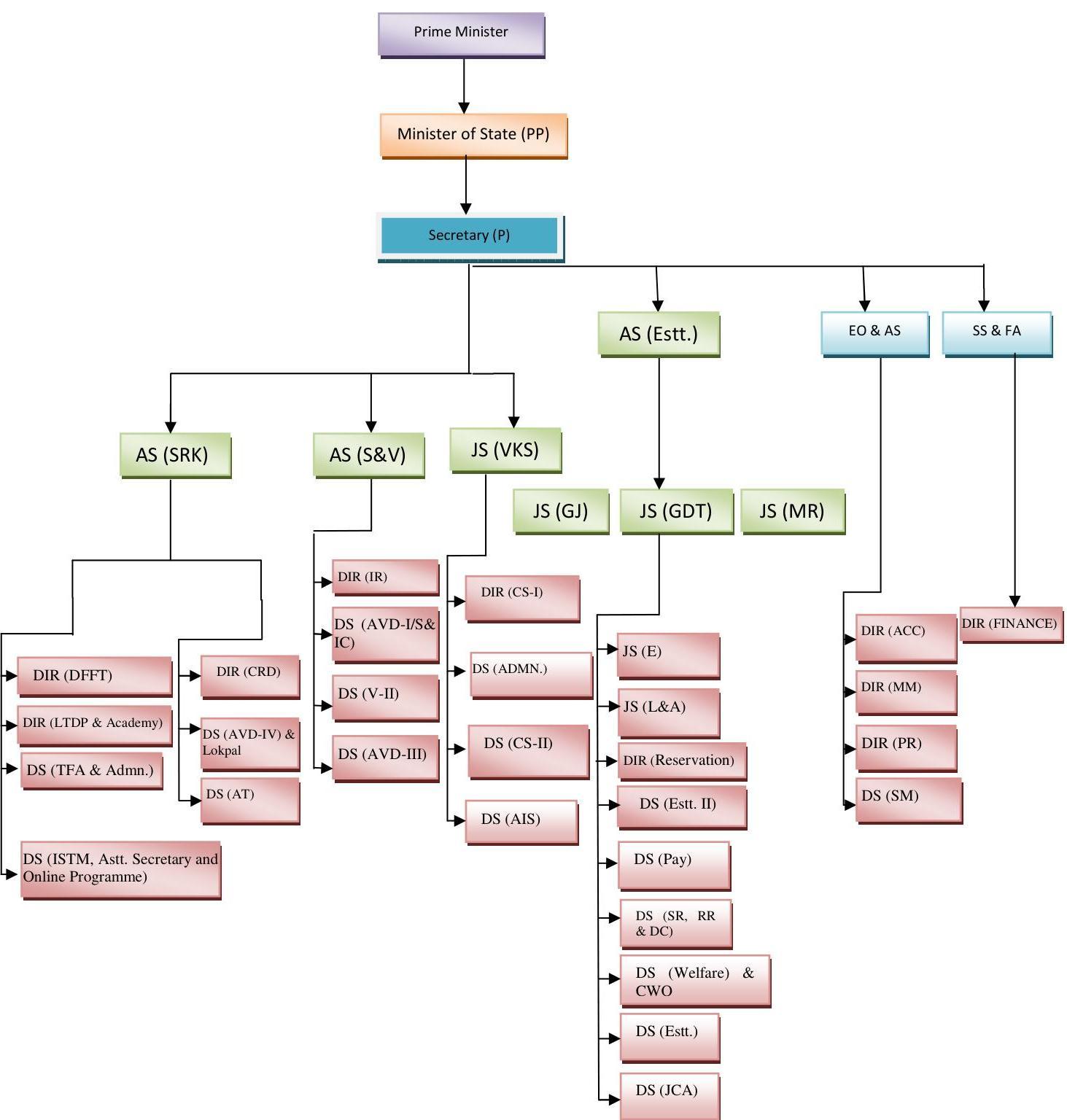
Organisation Chart for Department of Personnel & Training
| Abbreviations Used in the Organization Chart | |
|---|---|
| ACC | Appointments Committee of Cabinet |
| AVD | Administrative Vigilance Division |
| ADMIN | Administration |
| AIS | All India Services |
| AS | Additional Secretary |
| B&C | Budget \& Coordination |
| CS | Central Secretariat |
| CPC | Central Pay Commission |
| CRD | Cadre Review Division |
| CWO | Chief Welfare Officer |
| DFFT | Domestic Funding of Foreign Training |
| DS | Deputy Secretary |
| DIR | Director |
| E | Establishment |
| EO | Establishment Officer |
| IR | Information Rights |
| JS | Joint Secretary |
| JCA | Joint Consultative Machinery and Arbitration |
| LTTP | Long Term Training Programme |
| L\&A | Leave Allowances |
| MoS | Minister of State |
| MM | Middle Management |
| PR | Personal Records |
| PIIA | Pathways for an Inclusive India Administration |
| PESB | Public Enterprises Selection Board |
| PP | Personnel \& Pension |
| RES | Reservation |
| RR\&DC | Redeployments \& Retraining \& Departmental Council |
| S\&V | Services \& Vigilance |
| S | Services |
| SM | Senior Management |
| SR | State Reorganization |
| TRG | Training |
| V | Vigilance |
Training Policy and Programmes (Chapter 7)
1.6 The Department is the nodal Department to impart training to the government functionaries. The Training Wing of the Department formulates policies and implements its training programmes by identifying areas of training, designing training programmes, development of trainers and training capabilities and administering policies in training. Major training activities undertaken during the year are (i) In-service training of IAS officers (ii) MidCareer Training of IAS Officers (iii) Domestic Funding of Foreign Training (iv) Post Graduate Programmes in Public Policy (v) Training Support, (vi) Intensive Training Programme, (vii) Augmentation of the Capacity of training institutions (viii) Capacity Building for poverty reduction (ix) Distance and e-learning initiatives and (x) e-governance initiatives.
Training Institutions (Chapter 8)
1.7 Lal Bahadur Shastri National Academy of Administration (LBSNAA), Mussourie, Uttarakhand and Institute of Secretariat Training and Management (ISTM), Delhi are two premier training institutions, attached to this Department. These institutes cater to the needs of human resource development by imparting training to all officers of Central Government at frequent intervals for their career progression. The Department also supports the Indian Institute of Public Administration (IIPA) which is an autonomous organisation, in undertaking advance training programmes for administrators as well as researchers on issues relating to public administration.
Administrative Vigilance Division (Chapter 9)
1.8 The Department is the nodal agency responsible for formulation and implementation of vigilance and anti-corruption policies of the Government. Administrative Vigilance Wing in the Department oversees government programme for maintenance of discipline and eradication of corruption from public service. The Central Vigilance Commission (CVC) advises the Central Government on all vigilance matters. The jurisdiction of the Commission extends to all the organisations to which the executive powers of the Union of India extend.
International Cooperation (Chapter 10)
1.9 The Department of Personnel and Training is the nodal Department for anti corruption. To deal with international cooperation on these aspects an International Cooperation Cell was created in this Department. The primary tasks of this Cell emanate from the follow up to the ratification of the United Nations Convention Against Corruption (UNCAC) and the other consequential international collaborative efforts, on global platforms. This Cell acts in conjunction with specialized agencies like the Central Bureau of Investigation, the Enforcement Directorate and the other line Ministries entrusted with the specific ancillary tasks within their respective administrative domain, viz. corporate governance, extradition matters, prevention of money laundering, mutual legal assistance treaties etc.
Central Bureau of Investigation (Chapter 11)
1.10 Central Bureau of Investigation (CBI) was
set up by the Government of India by a Resolution dated April 1, 1963 to not only investigate cases of bribery and corruption, but also violation of central fiscal laws, major frauds relating to Government of India Departments, Public Joint Stock Companies, passport frauds and serious crimes committed by organized gangs and professional criminals. CBI was further strengthened by the addition of Economic Offences Wing by the Government of India by Resolution dated February 2, 1964.
Joint Consultative Machinery (Chapter 12)
1.11 The Government provides for a Joint Consultative Machinery for joint consultation at three levels between the Central Government and its employees for promoting harmonious relations and securing optimum level of cooperation between the Central Government and its employees in matters of common concern. The objective is to increase the efficiency of public services along with the well-being of the employees. The three tiers are:
a) National Council – at the apex level, functioning under the Department of Personnel and Training.
b) Department Councils – functioning at the level of the Ministries / Departments.
c) Office Councils – functioning at offices/ organisations under various Ministries / Departments.
1.12 The Scheme has proved to be an effective forum for amicable settlement of grievances of the Central Government employees relating to their service matters etc.
Administrative Tribunal (Chapter 13)
1.13 In order to provide speedy and inexpensive justice delivery system to the employees who feel aggrieved by Government decisions, the Government set up the Central Administrative Tribunal (CAT) in 1985, which now deals with all cases relating to service matters. The CAT has 17 regular benches, 15 of which operate at the Principal seats of High Courts and the remaining two are at Jaipur and Lucknow.
Staff Welfare (Chapter 14)
1.14 The Central Government being the largest single employer in the country discharges its responsibility for looking after the welfare of employees through various welfare measures. The Department also extends support to various staff welfare measures. The DoPT is the nodal Department for four registered societies set up for the welfare of the Government employees and their families. In addition, the Department lays down policies for Departmental Canteens and supports the Resident Welfare Associations.
Right to Information (Chapter 15)
1.15 The Department has brought out a comprehensive law in order to ensure right to information to the citizens of India in almost entire matters of governance at all levels from Central Government to the local self-government. The Law (RTI Act, 2005) has provided a mechanism where the Central Information Commission, being the apex body at the Centre, facilitates its citizenry in accessing information in a time bound, hassle free and affordable manner.
Grievance Redressal Mechanism & Citizens’ Charter (Chapter 16)
1.16 DOP\&T have identified some of the core services being offered by its various divisions and their standards for the purpose in its first charter. This has been undertaken by a Task Force in consultation with the Stakeholders. While identifying the services the focus has been on measurable and verifiable services and their standards. The charter contains Grievance Redress Mechanism related to the services mentioned in the Citizens’/Clients’ Charter. The Charter also provides links for other grievances which are not related to the Citizens’/Clients’ Charter. Time lines have been prescribed for final disposal of the complaint arising out of the Citizens’/Client’s Charter.
Progressive Use of Hindi (Chapter 17)
1.17 The Department is fully committed to promote the use of Hindi as the official language, in official matters and motivate compliance of the provisions of the Official Language Act, 1963, the rules framed thereunder. The Department
also ensures that the spirit of various orders and guidelines issued by the Department of Official Language is appropriately enforced for implementation of the official language policy of the Union. The Department has an Official Language Division which monitors the implementation of the policy in the Department.
Financial Management (Chapter 18)
1.18 In order to promote the various programmes administered by Ministry of Personnel, Public Grievances and Pensions, an allocation of Rs. 154.33 crore was made in the Central Sector Scheme Outlay for the year 2018-19 against a total allocation of Rs. 1547.00 crore at the Revised Estimate 2018-19 stage. The corresponding figures for 2019-20 are Rs. 194.27 crore as Central Sector Scheme Outlay against a total allocation of Rs. 1726.59 crore. The requirements and priorities of its attached and subordinate offices were kept in view while making budgetary allocation to them by this Department. No PAC/ C\&AG Para are pending in the Ministry.
Major Initiatives/Achievements/ Events during the year
Posting of IAS Officers as Assistant Secretaries in Govt. of India:
2.1
On completion of Phase-II training at Lal Bahadur Shastri National Academy of Administration, Mussoorie, this Department issued orders for posting of 176 IAS officers of 2016 Batch as Assistant Secretary in the Ministries/Departments of Government of India for a period of 3 months from 02.07.2018 to 28.09.2018 on Central Deputation. Exposure of Central Govt. functioning will provide insight into policy formulation at the Centre to these officers. During their field posting, the officers will benefit by having a macro picture of such policies which will help them in effective implementation of the schemes keeping citizen at the centre.
2.2
Inaugural Session of the Assistant Secretaries (IAS-2016 batch) held under the Chairmanship of Hon’ble Prime Minister at Parliament Annexe on 4th July, 2018.
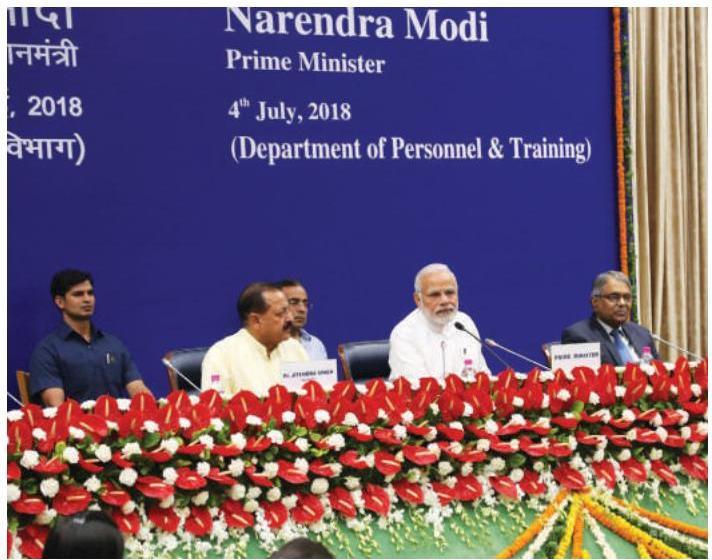
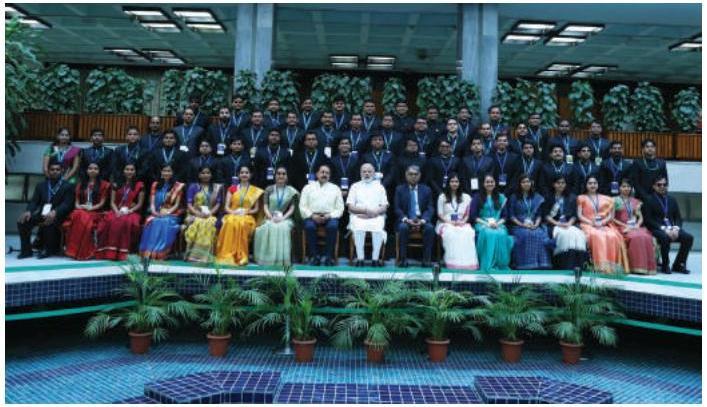
2.3
The Assistant Secretaries also got an opportunity to have an interactive session with Hon’ble President and Hon’ble Vice President.
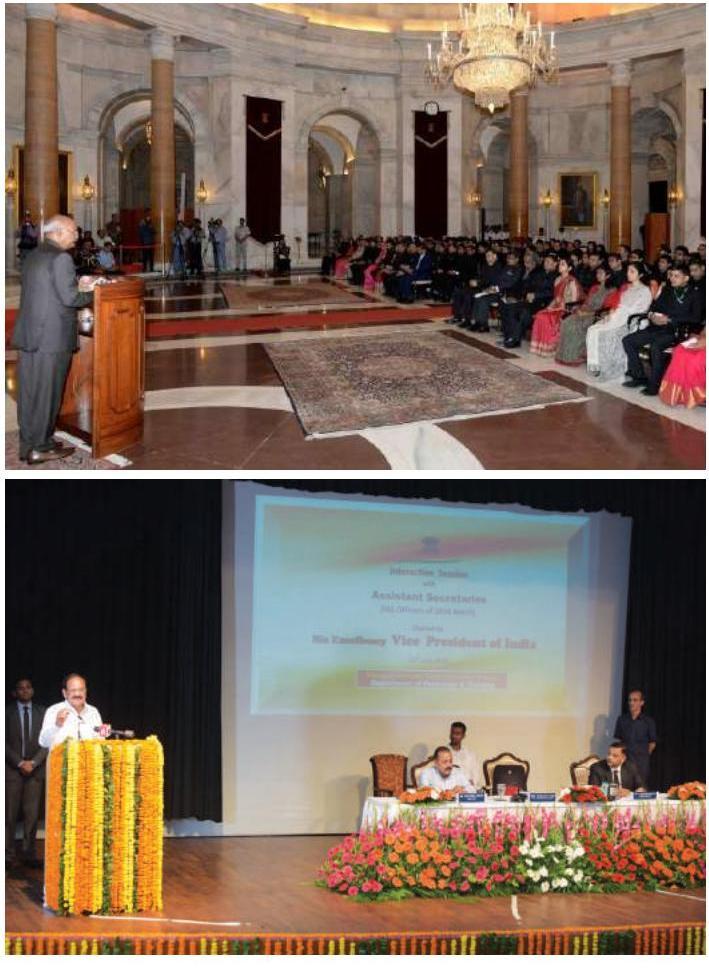
2.4 The IAS officers of 2016 Batch also benefitted from the interactive sessions organized by DoPT, in which a large number of dignitaries/ Heads of Departments/ Heads of Organizations/ Senior Officers participated. A feedback-cum-interactive session of the Assistant Secretaries (IAS Officers of 2016 Batch) with senior officers of various Ministries/Departments was organized on 28th September, 2018 at CSOI, New Delhi.
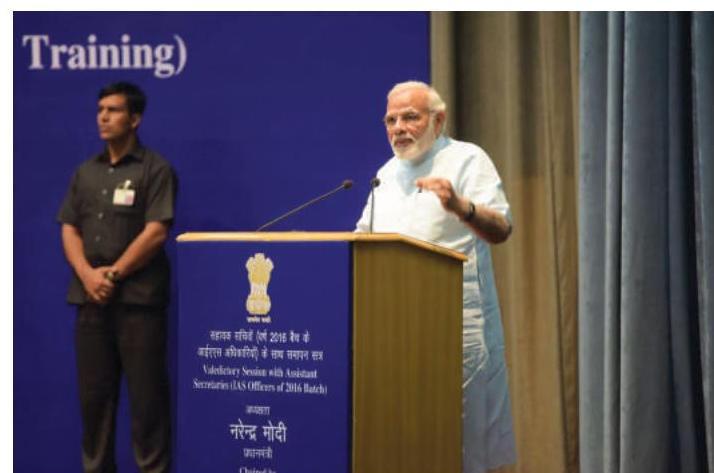
2.5 Hon’ble Prime Minister addressed the Valedictory Session of the Assistant Secretaries (IAS-2016 batch) at DRDO Auditorium, New Delhi on 27th September, 2018. During the Valedictory session, eight (8) Assistant Secretaries made presentations before Hon’ble PM.
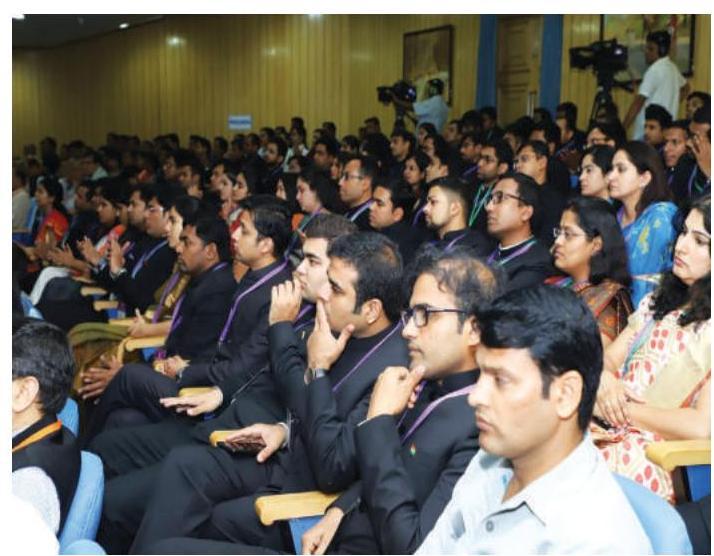
Felicitation of IAS Toppers of 2017 batch:
2.6 MoS (PP) chaired the felicitation ceremony held on 01.05.2018 for top achievers of Civil Services Examination-2017.
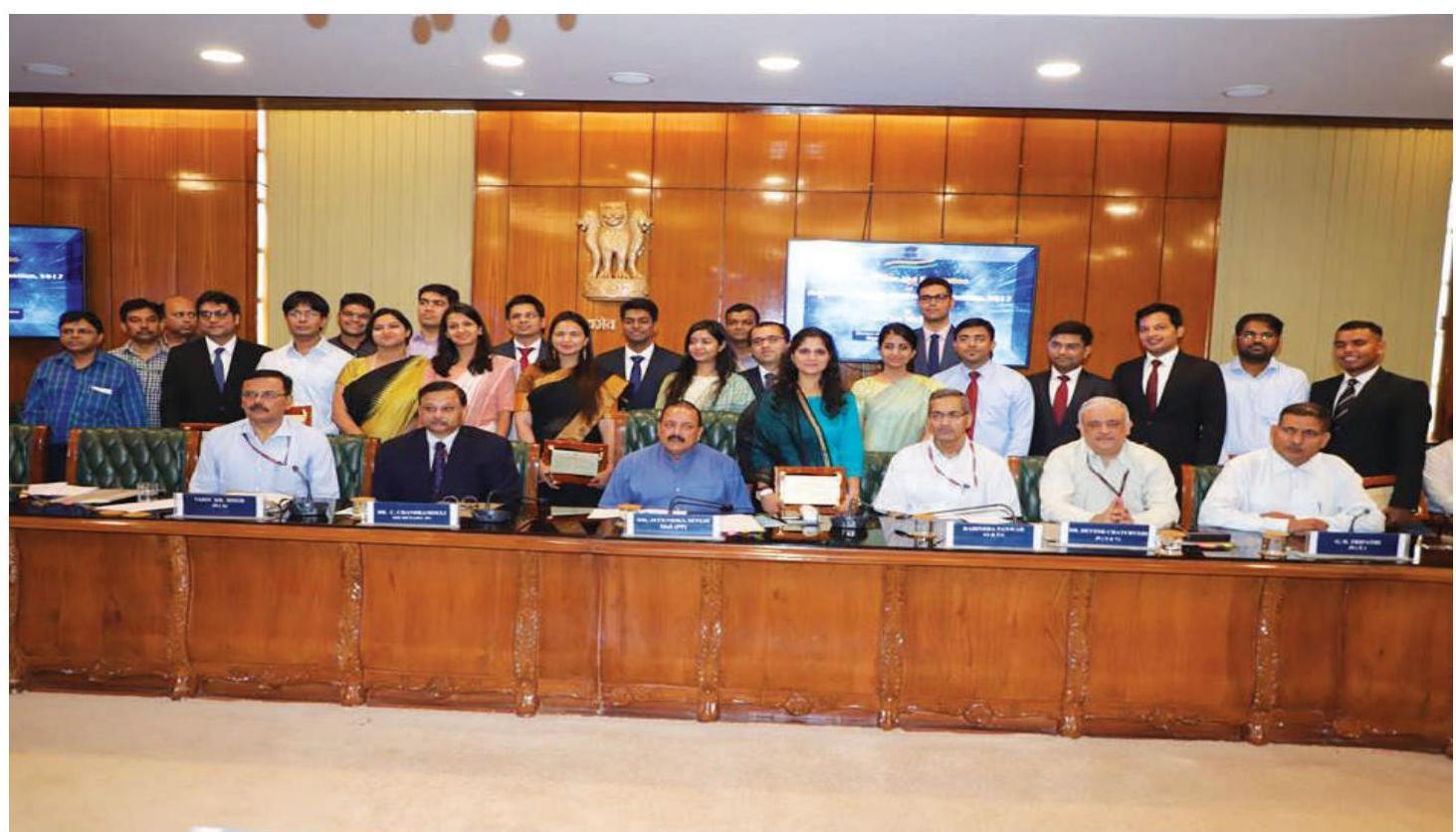
Launch of the iGOT (Integrated Government Online Training Programme)
2.7 Dr. Jitendra Singh, Hon’ble MoS(PP) launched the iGOT (Integrated Government Online Training Programme) developed by Department of Personnel and Training, Ministry of Personnel, Public Grievances & Pensions, on 20.12.2018. The National Training Policy-2012 mandates that all civil servants will be provided with training to equip them with the competencies for their current or future jobs. The current structure of training for Government servants including domestic and foreign training is mostly available to very small section of the government servants. However, consequent upon some recent initiatives undertaken by Department of Personnel and Training, Government of India aimed at providing training to cutting edge level functionaries in the Central/State Governments, significant changes have taken place. The outreach of the existing training setup is very limited in view of the large workforce employed in various States/ UT Governments. The Integrated Government Online Training Programme (iGOT) launched by Hon’ble MoS (PP) will augment the existing training mechanism with online module-based training coupled with certification. This will make training inputs available to government servant on site and on flexitime basis. Furthermore, the training will be focussed and targeted to the requirement of the officials.
2.8 The e-Learning mode provides unparalleled opportunities for training to a large number of civil servants scattered all over the country. The latest technologies make available vast resources of learning material and online courses, providing the individuals enormous choices and flexibility in learning. The online training programme through Massive Online Open Courses mechanism would
be a platform to bring together the numerous Government and other training institutions for providing a single point of access to the repository of training resources. This will provide a broad training eco-system creating synergies across various premier training institutes of the country and will cater to the training needs which can encompass all the officials in the entire hierarchy of Central and State Governments. This platform will ultimately build a large training eco-system. The training courses under this programme will be accessible through DoPT’s web portal. Among the bouquet of Training Courses on offer through this initiative are those offered by MIT, USA too. DoPT has collaborated with JPAL, South Asia and MIT, USA to launch MITx Micro Master Programmes for the government servants.
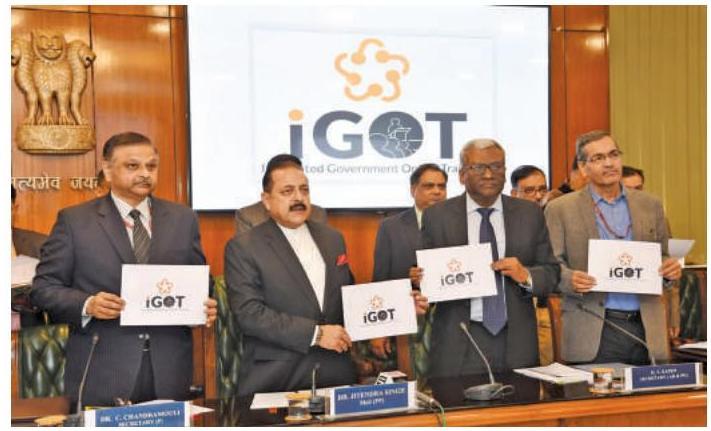
Launching of Hybrid Course on Administrative Laws
2.9 The DoPT, realising the need for training inputs in Administrative Laws, has collaborated with the premier law school, National Law School of India University (NLSIU), Bengaluru to develop and offer Long Term Diploma programme and Short Term Courses in these areas. The courses to be delivered by NLSIU were launched by Hon’ble MoS (PP) on 20.12.2018.
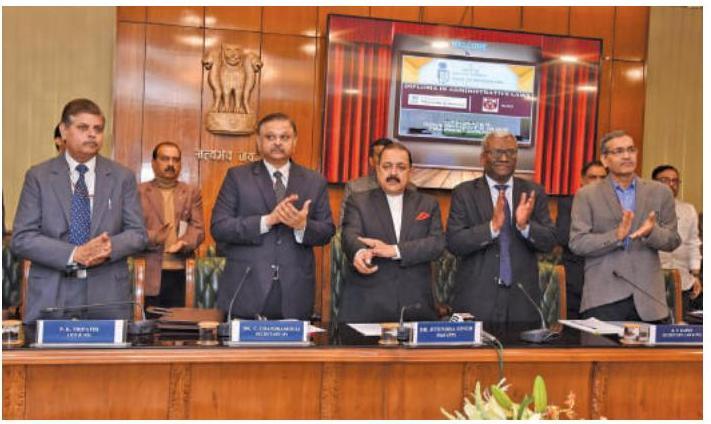
RTI Portal on Judgments/Orders of Supreme Court, High Courts and CIC
2.10 RTI Portal on Judgments/Orders of Supreme Court, High Courts and CIC, was launched on 20.12.2018 by Hon’ble MoS (PP). It aims at providing a learning environment for all stakeholders under which a repository on the landmark cases on the RTI will be available at one place. The Right to Information (RTI) Portal on Judgments/Orders of Supreme Court, High Courts and CIC has been developed by Institute of Secretariat Training and Management (ISTM), New Delhi. This Portal will provide a learning environment for all stakeholders under which a repository on the landmark cases on the RTI will be available at one place. The Portal also makes available the gist of the replies given by Central Public Information Officers (CPIOs), First Appellate Authorities as well as the Supreme Court. It will be helpful in learning the latest trends of implementation of RTI Act as the judgments/orders given by Central Information Commission, High Courts and Supreme Court are always a crucial source to track the developments on this subject.
Expanding online RTI Portal:
2.11 RTI Online portal has been expanded to cover all Public Authorities registered with the CIC for ease of access to inform by citizens. 2194 Public Authorities have been aligned till date, which is a significant increase from 96 Public Authorities aligned in 2013-2014.
Lateral entry for the post of Joint Secretary
2.12 The Group of Secretaries (GoS) on Governance in its report submitted in February 2017 made recommendation pertaining to ‘Infusion of Fresh Talent at Policy Making Levels’. The recommendations inter alia include selection of a pre-determined number of Joint Secretary level officers from open market to be taken on contract basis to overcome the shortage of officers at this level in the Government of India. On the basis of recommendations of GoS, the Government decided to recruit talented and motivated Indian Nationals willing to contribute towards nation building to 10 positions of Joint Secretary in ten identified Ministries/Departments. Accordingly, an advertisement was issued on 10.06.2018. 6077 applications were received in response to the advertisement. UPSC has been entrusted with the responsibility to undertake selection process.
Appointment in Central Information Commission, Central Administrative Tribunals and Union Public Service Commission:
2.13 The following appointments have been made at senior level posts:
(i) Appointment of CIC and ICs
Shri Sudhir Bhargava has been appointed as the Chief Information Commissioner in the Central Information Commission on 01.01.2019. On the same day, four more Central Information Commissioners have
been appointed 01.01.2019.
(ii) Appointments in Central Administrative Tribunals
During the financial year 2017-18, 27 Members including fifteen (15) Administrative Members and 12 Judicial Members have been appointed for the vacancies of 2017 for Central Administrative Tribunal.
(iii) Appointment in Public Enterprises Selection Board (PESB)
Shri K.D. Tripathi, former IAS (AM:80), has been appointed as Chairperson, PESB on $19^{\text {th }}$ November, 2018, for tenure of three years or until attainment of age of 65 years or until further orders, whichever is earlier.
Shri M. K. Gupta has been appointed as Member, PESB on 20.11.2018, for a tenure of three years or until attainment of age of 65 years or until further orders, whichever is earlier.
(iv) Appointment in Union Public Service Commission (UPSC)
Three eminent persons have been appointed as Member, UPSC in the Central Information Commission during the FY 2018-19.
(v) Appointment in Central Vigilance Commission (CVC)
Shri Sharad Kumar, former IPS (HY:79) was appointed as the Vigilance Commissioner in the Central Vigilance Commission vide Warrant of Appointment dated 08.06.2018. He has been appointed for a term of four years from the date on which he entered upon his office i.e. 12.06.2018 or till he attains the age of sixty five years, whichever is earlier.
Welfare of employees:
2.14 The following instructions have been issued for ensuring welfare of employees in various matters:
(i) An OM dated 03.04.2018 was issued under the CCS (Leave) Rules, 1972 providing: (a) An employee on Child Care Leave (CCL) may leave headquarters with the prior approval of appropriate competent authority; (b) LTC may be availed while an employee is on CCL; and (c) An employee on CCL may proceed on foreign travel provided clearances from appropriate competent authorities are taken in advance.
(ii) CCS (Leave) Rules, 1972 have been amended vide notification dated 03.04.2018 to bring them in conformity with the Rights of Persons with Disabilities Act, 2016. Various facilities have been provided to a disabled Government servant.
(iii) the limit of 22 years in case of disabled child for the purpose of a Government servant availing CCL under the provisions of Rule 43-C of the CCS (Leave) Rules, 1972 has been removed vide notification dated 06.06.2018 and now the CCL can be availed by a Government servant for her / his disabled child of any age subject to other provisions contained in Rule 43-C of the CCS (Leave) Rules, 1972.
(iv) In pursuance of the recommendations of the $7^{\text {th }}$ CPC, the CCS (Leave) Rules, 1972 have been amended vide notification dated 14.12.2018 to provide (a) 10 days Earned Leave in place of 20 days Half Pay Leave to Vacation Staff; (b) CCL to single male Government servant; (c) introduction of work related illness & injury
leave (WRIL) to a Government servant who suffers illness and injury that is attributable to or aggravated in performance of her / his official duties.
Introduction of Yoga Camps and celebration of Yoga Day:-
2.15 Yoga camps were organized for creating awareness about benefits of Yoga among employees of Department of Personnel & Training. On $21^{\text {st }}$ June, 2018, fourth International Day of Yoga was celebrated, in which employees of this Department participated enthusiastically.
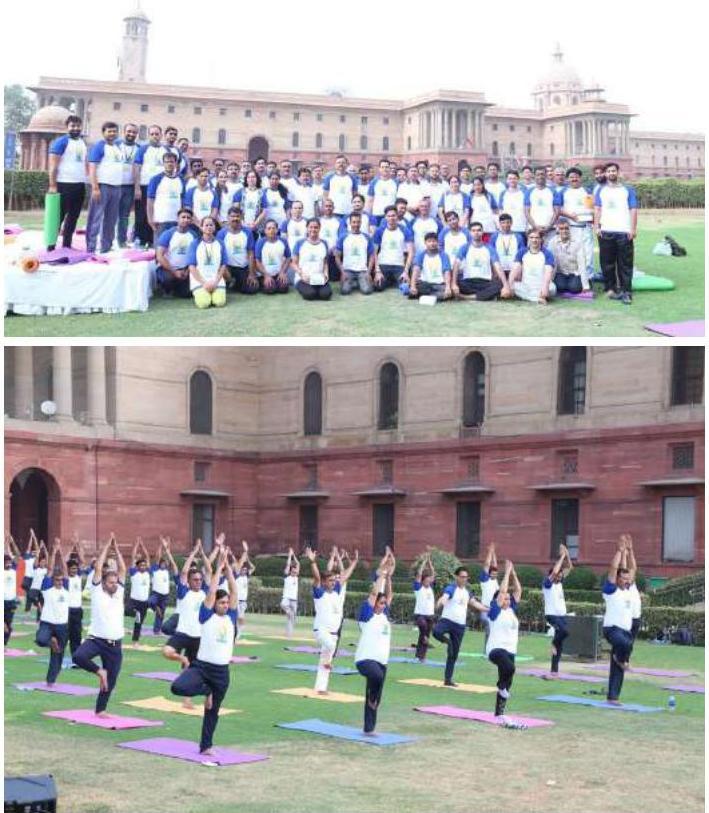
2.16 Appointment of Lokpal
For operationalisation of Lokpal, Selection Committee headed by Hon’ble Prime Minister and Shri Mukul Rohtagi as one of the Members
has held a series of meetings and has constituted a Search Committee for recommendation of a panel for selection of Chairperson and Members of Lokpal. The Selection Committee held its seventh meeting on 15.03.2019 and after consideration of panels submitted by the Search Committee, the Selection Committee made its recommendation for appointment of Chairperson and Members of Lokpal. On $19^{\text {th }}$ March, 2019, the Hon’ble President of India has appointed the Chairperson and Members of the Lokpal on the recommendation of the Selection Committee and they have assumed the charge of their respective offices.
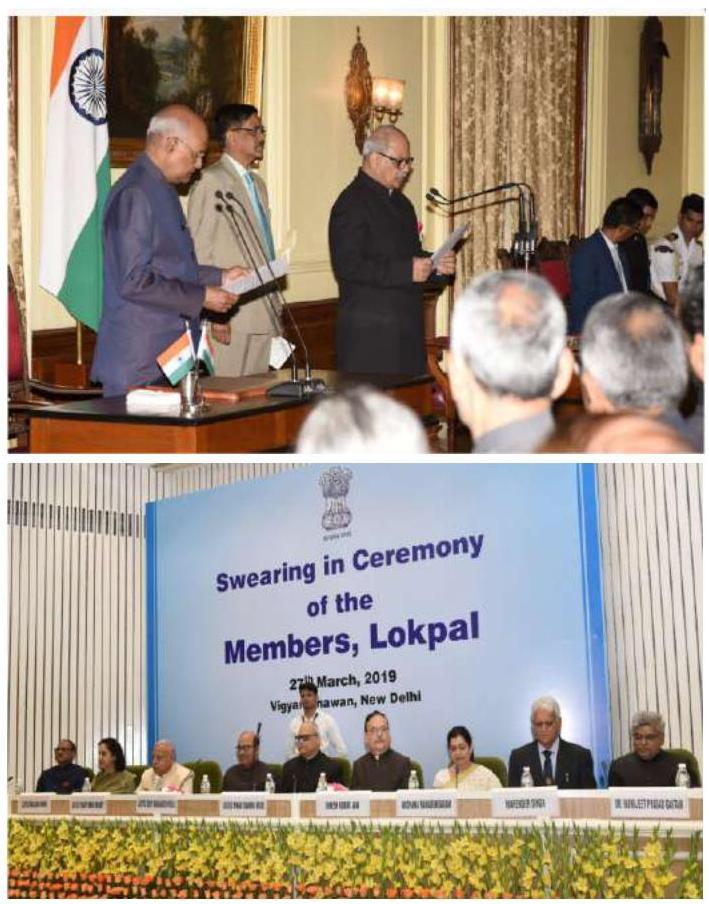
Civil Services Day, 2018
2.17 $12^{\text {th }}$ Civil Services Day was observed on 2021 April 2018 at Vigyan Bhavan, New Delhi. The programme was inaugurated on $20^{\text {th }}$ April 2018 by Hon’ble Vice President of India. On $21^{\text {st }}$ April,
2018, panel discussions in plenary and breakaway sessions on Aspirational districts, identified priority programmes followed by a Wrap up session were organized on the day. On 21st April 2018, the programme included a plenary session on “Artificial Intelligence for Effective Governance”. Two documentary films namely ‘A film on Journey of PM’s Awards’ and ‘New India- Shaping the Future’ were screened during the event.
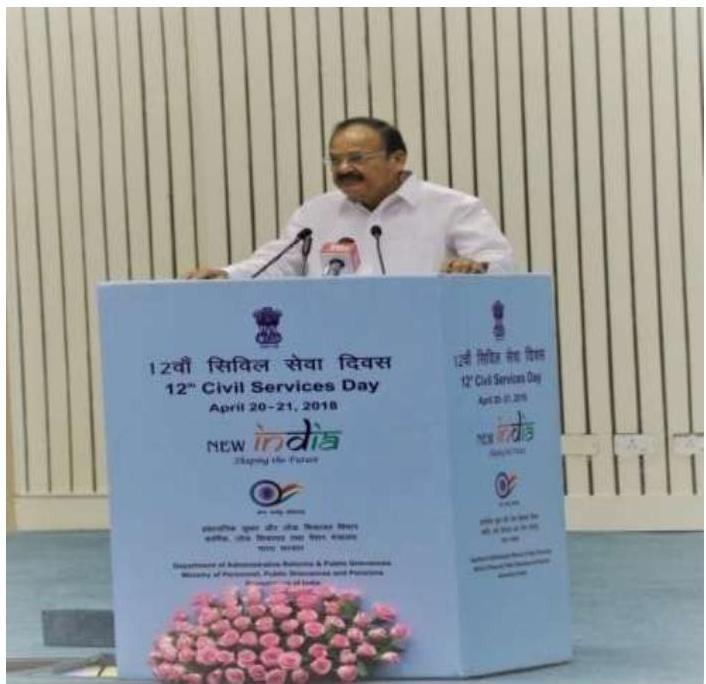
Hon’ble Vice-President of India inaugurating the 12th Civil Service Day function Vigyan Bhavan New Delhi on 20 April, 2018
Prime Ministerís Awards for Excellence in Public Administration, 2018
2.18 On 21st April, 2018, Hon’ble Prime Minister presented the Prime Minister’s Awards for Excellence in Public Administration to selected districts and implementing units under various categories. Hon’ble Prime Minister conferred Awards to 11 best performing districts in implementation of priority programmes namely (i) Pradhan Mantri Fasal Bima Yojana, (ii) Deen Dayal Upadhayay Grameen Kaushalya Yojana, (iii) Pradhan Mantri Awas Yojana (Gramin & Urban), and (iv) Promoting Digital Payments. Two Awards were also conferred under Innovation category, one of which was for an ‘Aspirational’ district. A new category of awards for Additional Secretary/Joint Secretary level officers and Director/Deputy Secretary serving in Government of India was also introduced in 2018 to recognize their contribution towards bringing about transformational improvements in processes/systems through simplification, process re-engineering etc. Two awards were conferred in this category.
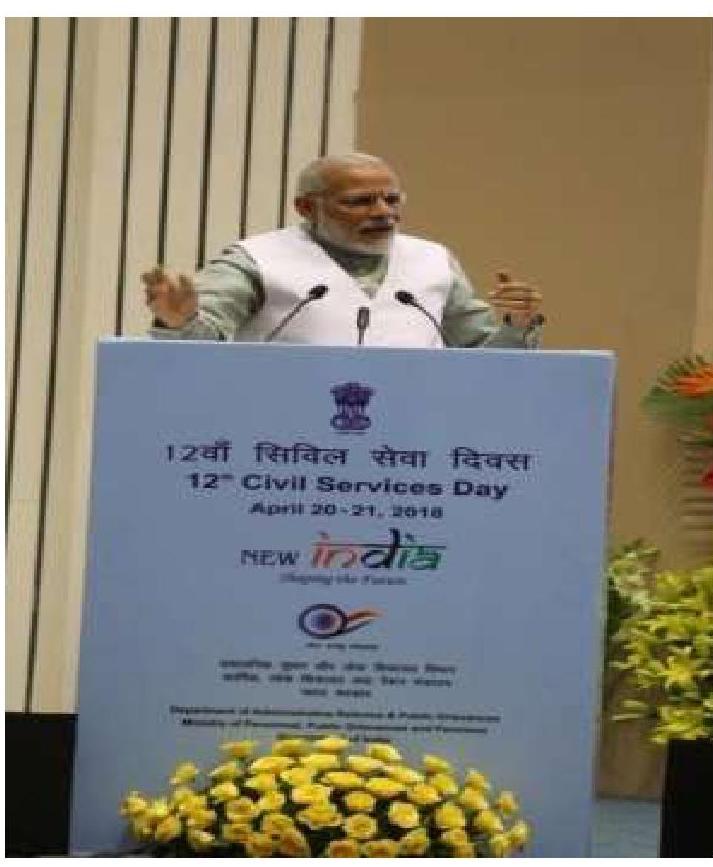
2.19 The 21st National Conference on e-Governance (NCeG) was held on 26th and 27th February, 2018 at Hyderabad, Telangana. The theme of the Conference was “Technology for Accelerating Development”. The sub-themes were (i) Universalization and Replication, (ii) Governing e-Governance, (iii) Emerging Technologies, (iv) Building User Experience and (v) e-Governance good/best practices. Five plenary sessions
were conducted including a wrap up Session on “Synergizing Role of National and State Government” in which eminent panellists/speakers of the concerned field deliberated upon.
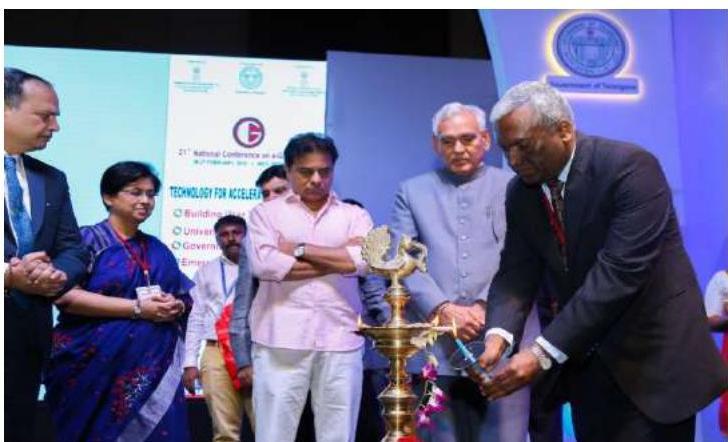
Inauguration of the 21st National Conference on e-Governance
Pension Adalat:
2.20 Department of Pension and Pensioners’ Welfare had started the unique experiment of holding Pension Adalat of those cases in CPENGRAMS which were either routinely closed by various Ministries or not disposed of within the time-line of 60 days. Encouraged by the response and speedy justice delivered, the Department organised the 2nd Pension Adalat on February 9, 2018. Out of the 34 selected cases, 20 cases were resolved in the Adalat itself. Out of these, 19 cases were resolved by accepting the claims of the Pensioners. Suitable instructions were conveyed to the concerned Departments for resolving the remaining cases. As on November 30, 2018, out of 34 grievances raised in Adalat, 30 have been resolved.
2.21 All India Pension Adalat – 2018: In its attempt to devote one day in the year to Pensioners, Department of Pension & Pensioners’ Welfare conducted an All India Pension Adalat on September 18, 2018, which was inaugurated by the Hon’ble MoS (PP).
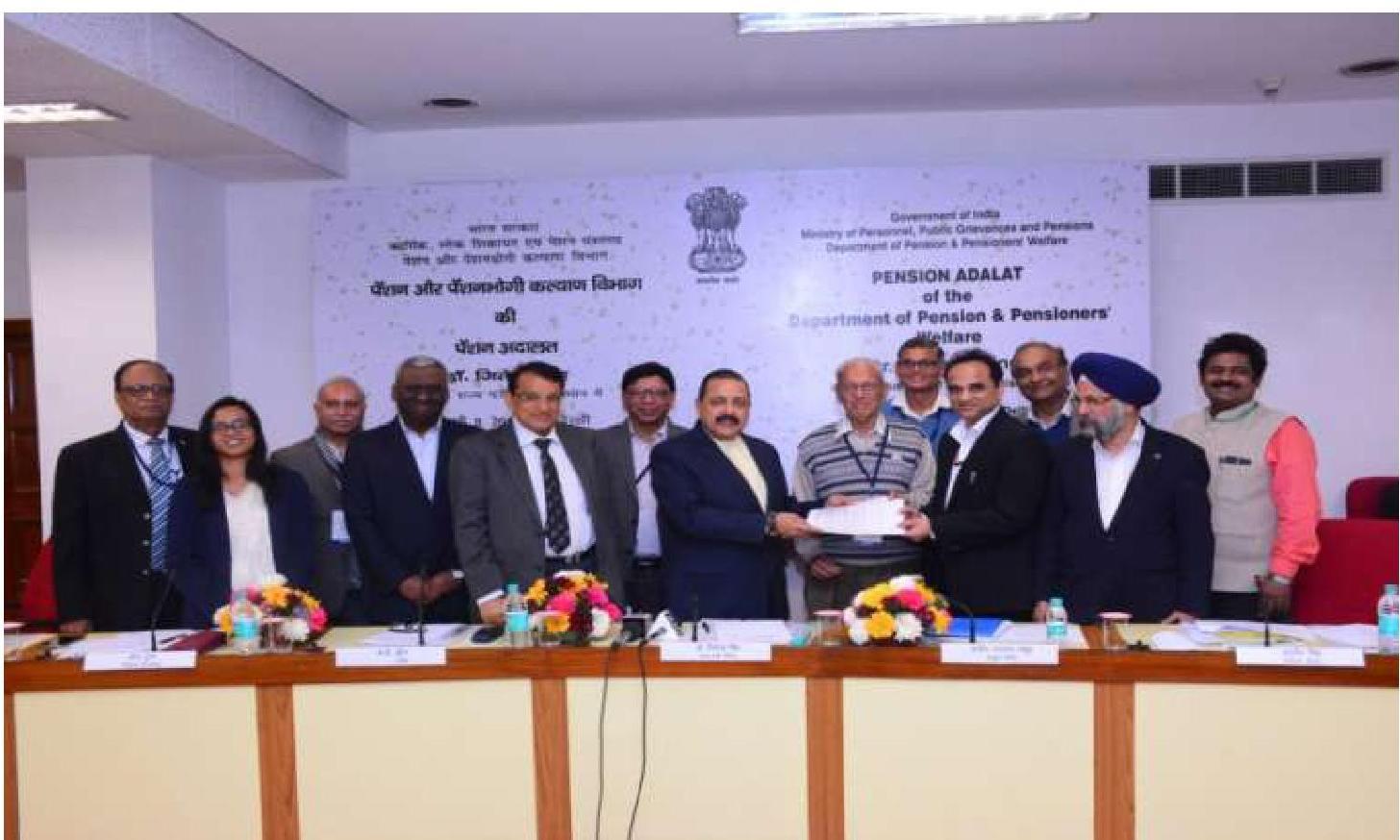
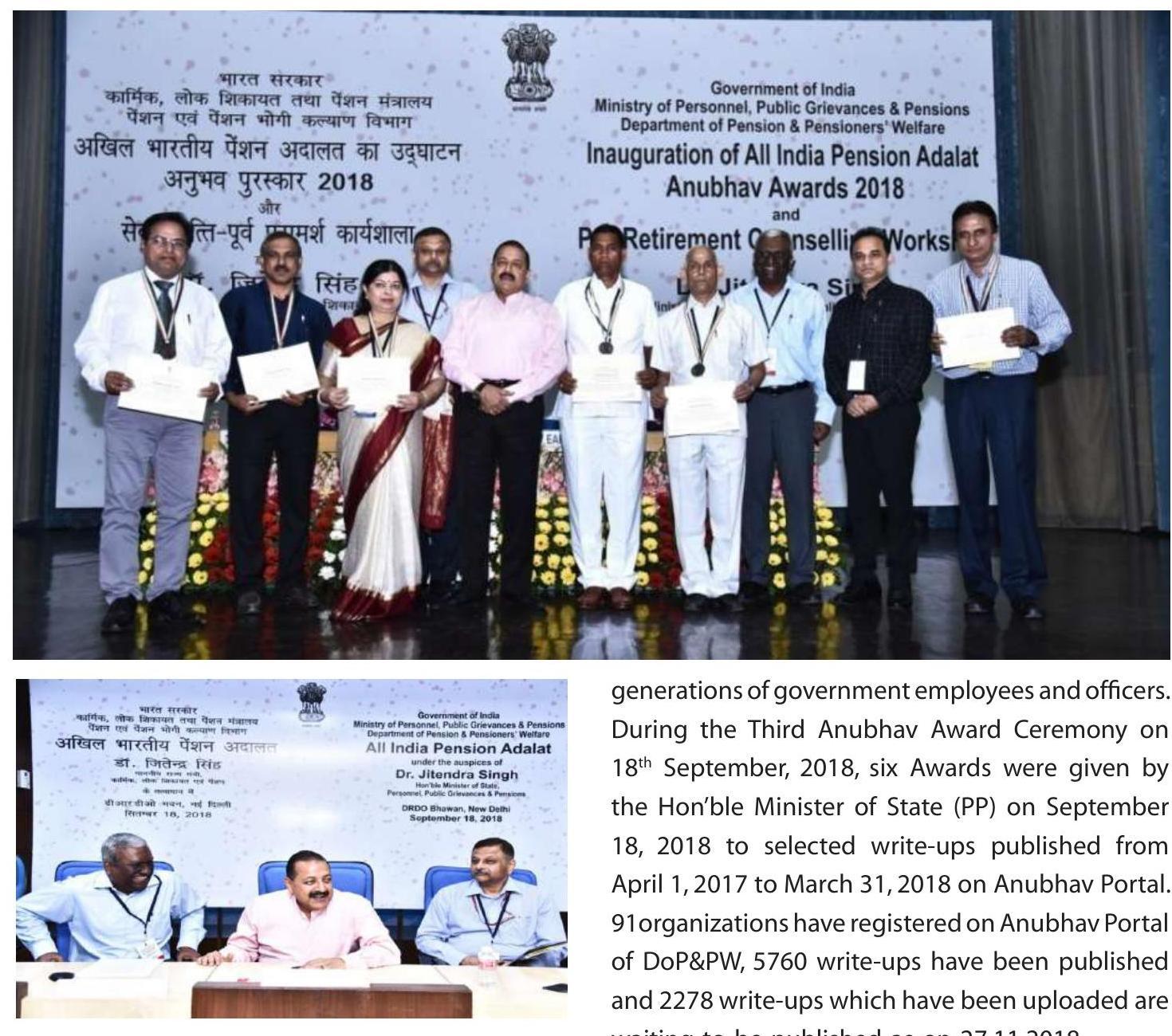
ANUBHAV:
2.22 Department of Pension & Pensioners’ Welfare had launched an online platform entitled ‘Anubhav’ for sharing experiences of retiring government employees while working with the Government. It is envisaged that over a period of time, this will create a wealth of institutional memory with replicable ideas and suggestions. This will prove an invaluable tool for helping in future governance related issues since a treasure trove of wealth shall be left behind by the retiring
generations of government employees and officers. During the Third Anubhav Award Ceremony on $18^{\text {th }}$ September, 2018, six Awards were given by the Hon’ble Minister of State (PP) on September 18, 2018 to selected write-ups published from April 1, 2017 to March 31, 2018 on Anubhav Portal. 91organizations have registered on Anubhav Portal of DoP\&PW, 5760 write-ups have been published and 2278 write-ups which have been uploaded are waiting to be published as on 27.11.2018.
Blood Donation Camps
2.23 In order to inculcate participation in Citizen Centric activities among employees of Central Government, this Department has been organizing Blood Donation Camps in association with the Indian Red Cross Society, New Delhi on monthly basis since June 2015 in all major buildings where Government offices are situated. During the year 2018, nine Camps were organized at various locations. Blood Donation Camp was organised
by DoP&T at North Block, New Delhi also on 20.06.2016 and 60 employees donated blood in this camp.
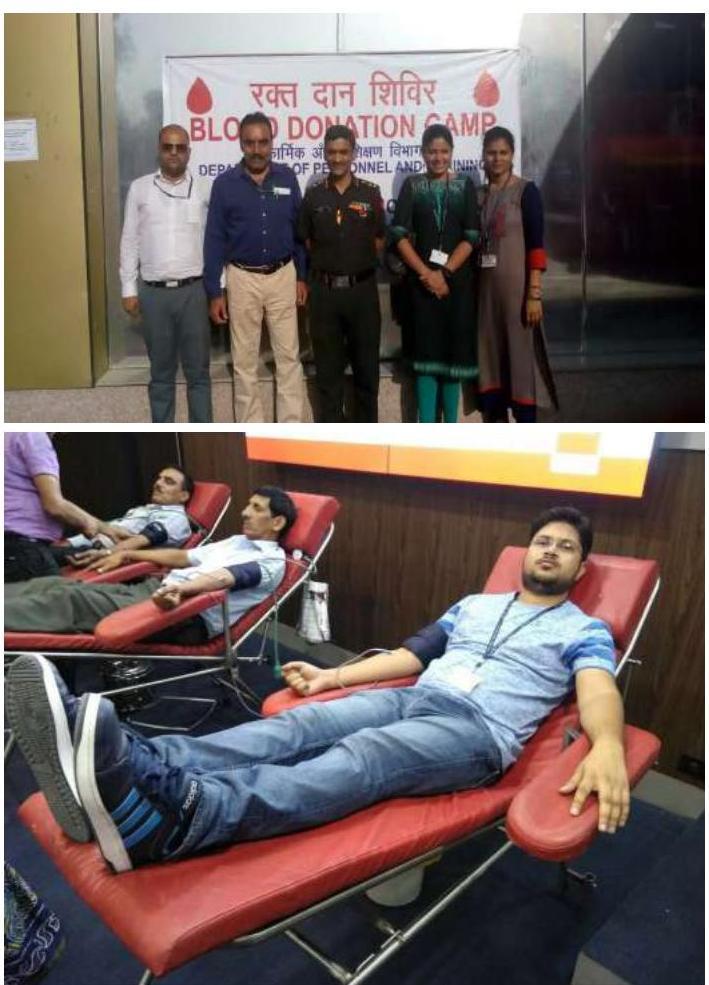
Celebration of International Womenis Day:-
2.24 International Women’s Day was celebrated by the Department on $8^{\text {th }}$ March, 2019, where women employees of all the three Departments of the Ministry participated. Hon’ble MOS (PP) also addressed the gathering on the occasion. Smt. Rashmi Verma, former Secretary, D/o Tourism was the chief guest. Address of Dr. Madhavi Chandra, Sr. Radiologist, SGRH on “Breast Cancer Awareness” and address of Dr. Nanditesh Nilay on “Stress Management” were organized in the workshop. Various competitions were held during the three days’ celebration of Women’s day. Awards were
distributed to achievers of the competitions.
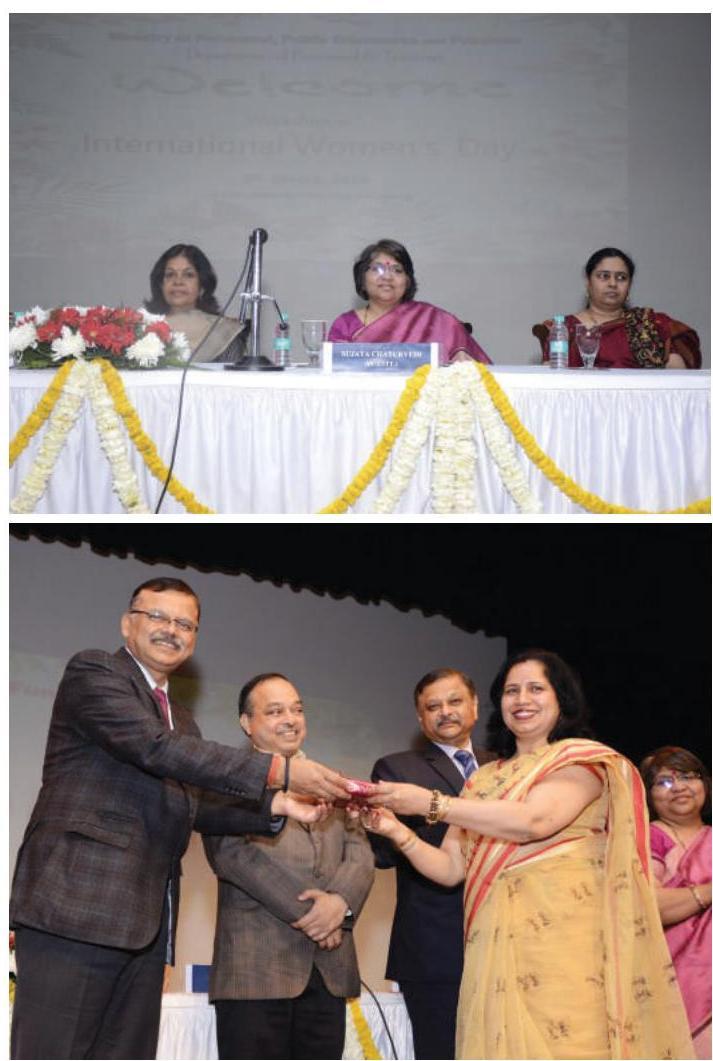
Smart Performance Appraisal Report Recording Window (SPARROW):
2.25 SPARROW is an online system based on the comprehensive performance appraisal dossier maintained for IAS officers. The system aims at bringing greater transparency in the recording of performance appraisals of the officers, eliminating loss of Performance Appraisal Reports (PARs) during transition, ensuring better monitoring and timely completion of PARs and providing easy and real time access to the PARs by authorized stakeholders. This system is not only user friendly but can be accessed uninterruptedly through an internet enabled computer system from anywhere round the clock, which reduces the delays in processing
of PARs by officers concerned. The system was launched with effect from 01.04.2014 and was initially linked to the intra-IAS database enabling the PAR form to be pre-populated with the existing information. Subsequently, the responsibility to update the requisite details in respect of officers was passed on to the Employee Master Data (EMD) manager of the respective Ministry or Department / State Cadre. In order to make the system hasslefree and more user-friendly, the system has been e-Sign (electronic Signature) enabled, an Aadhaar based authentication service.
The SPARROW system generates auto-alerts in respect of the officers whose PARs are pending beyond the stipulated timeline. The total number of the electronically generated PARs for the Assessment Year 2017-18 was 8616 (as on 31.12.2018).
Immovable Property Returns (IPR) Module
2.26 As per Rule 16(2) of AIS (Conduct) Rules, 1968, IAS officers are required to submit IPRs every year as on $1^{\text {st }}$ January and latest by $31^{\text {st }}$ January in respect of the preceding year. Since the year 2011, the IPRs of the officers are being uploaded on the Department’s website. Though digitization of IPRs was done through uploading these on Department of Personnel & Training’s website, however, as officers were filing their return in hard copy only, certain problems viz. IPRs getting lost in transit, IPRs though submitted but not uploaded by the State Governments, IPRs without date uploaded in the system, ante-dating IPR, etc. were still being faced. In order to address these issues, an IPR Module was introduced w.e.f. 1.1.2017, the navigation tab of which has been provided in the menu on Home Page of SPARROW. The officers
can access the Module by using the login ID and password, which have already been provided to them for accessing the SPARROW and after filing the return. The same is to be authenticated by using either DSC (Digital Signature Certificate) or e-Sign.
Cadre Review of CSSS
2.27 Based on the recommendations of the $3^{\text {rd }}$ Cadre Restructuring Committee for Central Secretariat Stenographers’ Service (CSSS) and acceptance by the Government, allocation of additional posts in various grades was carried out vide DoP\&T’s Order No. 15/1/2014-CS.II(A) dated the $5^{\text {th }}$ October, 2018.
Promotion in various grades after implementation of the $3^{\text {rd }}$ Cadre Review exercises for CSSS
2.28 Promotion orders in various grades of CSSS viz (i) 54 Steno ‘D’ to Personal Assistant (PA), (ii) 1191 Personal Assistant to Private Secretary (PS), (iii) 684 Private Secretary to Principal Private Secretary (PPS), (iv) 302 Principal Private Secretary to Sr. Principal Private Secretary (Sr. PPS), and (v) 3 Sr. Principal Private Secretary to Principal Staff Officer (PSO) were also issued during the year.
Release of e-Magazine ‘KAUSHAL’
2.29 In a first of its kind initiative the Department of Personnel and Training has started an e-Magazine christened as “KAUSHAL” to provide a platform to the officers and employees of the Department to make a creative, conducive and positive environment for progressive use of Hindi Language in official work. This initiative leads to a keen desire among the officers and employees to
give vent to their creative urge in Hindi. Hence, this ambitious initiative would help create a positive synergy among the officers and employees to do their official work in Official Language Hindi which in turn will make public administration more and more citizen centric and decentralized. This is a progressive step to make Official Language Hindi more popular among the officers and employees of the Department which would go a long way in translating the vision of ‘Sabka Sath Sabka Vikas’ of Government of India into reality by
rendering public administration and public service delivery mechanism more inclusive. It would also make public administration more responsive and accessible with greater participation of citizens from across the country irrespective of linguistic diversity. The magazine has been released by Hon’ble Minister of State (PP) during award distribution ceremony held on $1^{\text {st }}$ February, 2019 and the link of magazine is available on website of the Department.
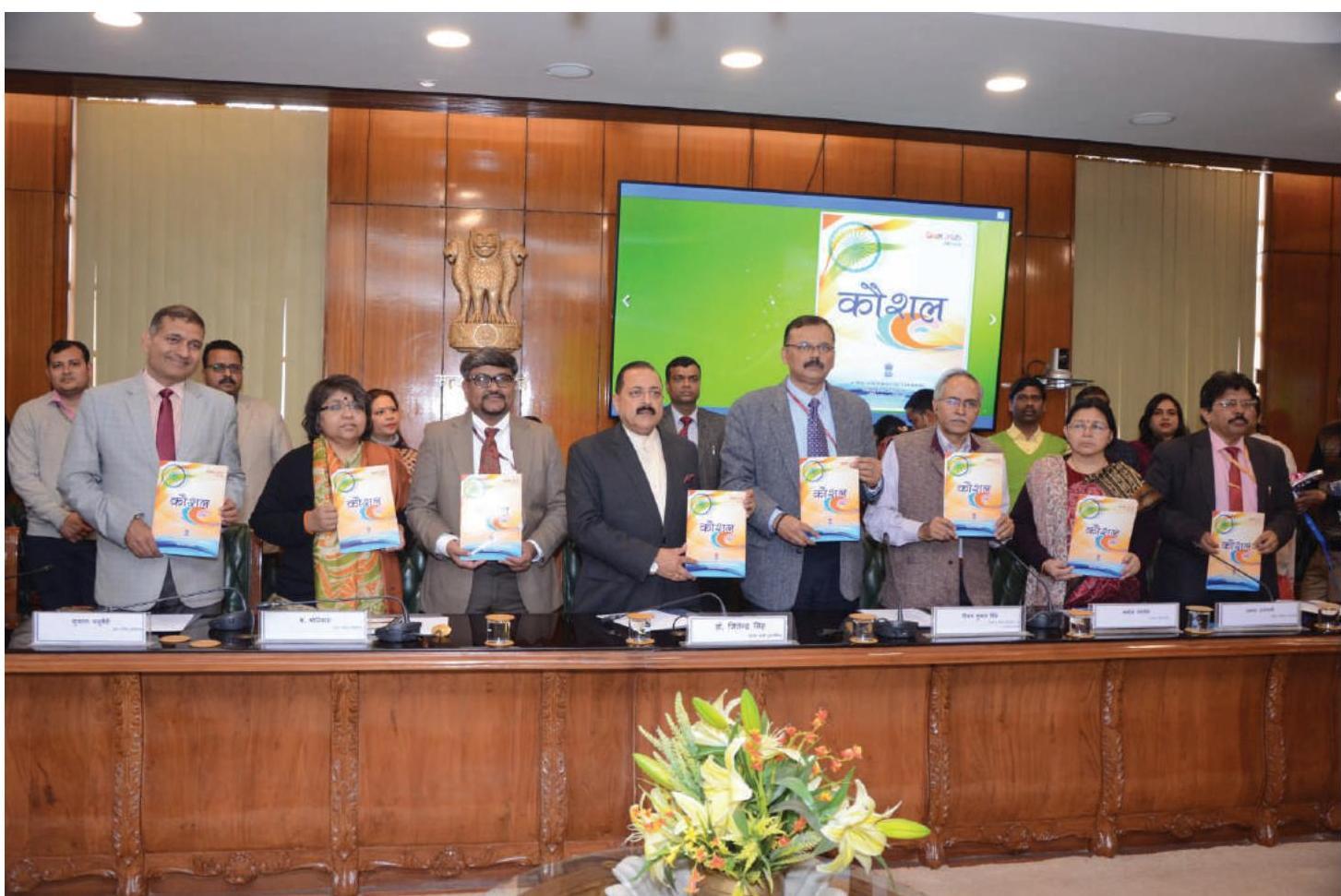
Release of e-Magazine “KAUSHAL” by Hon’ble Minister of State Dr. Jitendra Singh
3
- Matters relating to framing and amendment of recruitment rules/service rules for Group “A” and “B” posts
- Framing of policy relating to the procedure for Departmental Promotion Committee(s)
- Policy on seniority
- General policy matters relating to:-
(a) Flexible complementing scheme,
(b) Modified Assured Career Progression Scheme,
(c) Leave travel concession,
(d) Deputation,
(e) Child care leave,
(f) Pay & allowances,
(g) Holiday policy,
(h) Age relaxation and
(i) Other matters concerning service conditions. - Administration of UPSC and SSC including exams except the Civil Service Examination
- Policy matters of PESB
- Policy on Character verification before appointment
- Disagreement cases with UPSC from various Ministries except on appointment cases
- UPSC (Exemption from Consultation) Regulations
- Policy on APAR.
- Commercial employment after retirement
- Policy on
(a) Retirement, extension, re-employment,
(b) Posting and transfers, Conduct and CCA Rules,
(c) Sealed Cover procedure,
(d) Status of Women in Central Government,
(e) Temporary Service Rules, Etc.
(f) Lien, Probation, confirmation,
(g) Daily Wage Casual Labourers
3.0 Grant of Vigilance Clearance to the Government servants for obtaining Indian Passports
(A) Vigilance clearance can be withheld on the following circumstances: (i) The officer is under suspension; (ii) A charge sheet has been issued against the officer in a disciplinary proceeding and the proceeding is pending. (iii) Charge sheet has been filed in a Court by the investigating Agency in a criminal case and the case is pending. (iv) Sanction for investigation or prosecution has been granted by the Competent Authority in a case under the PC Act or any other criminal matter. (v) An FIR has been filed or a case has been registered by any Government entity against the officer, after a preliminary fact finding inquiry. (vi) The officer is involved in a trap/ raid case on charges of corruption and investigation is pending. (B) There may be situations wherein wards and relatives of the civil servants residing abroad (for education and other purposes) could be having medical emergencies or family events. The officer himself/ herself may require visiting abroad for medical reasons. Therefore, as a policy, ordinarily, a passport will not be granted if a disciplinary proceeding is pending against the officer. However, the competent authority can take a view wherein a foreign travel is necessitated due to extreme urgent situation like medical emergencies etc. on case to case basis. [Reference DoPT’s O.M. NO. 11012/7/2017-Estt.AIII dated $28^{\text {th }}$ March, 2018]
Amendment to Rule 6 of the Central Civil Services (Classification, Control and Appeal) Rules, 1965 for classification of Civil Posts 3.1 All civil posts under the Union shall be classified as follows:-
| S.No. | Description of
Posts | Classification of
Posts |
| — | — | — |
| 1 | A Central Civil Post
carrying the pay in
the Pay Matrix at the
Level from 10 to 18. | Group A |
| 2 | A Central Civil Post
carrying the pay in
the Pay Matrix at the
Level from 6 to 9. | Group B |
| 3. | A Central Civil Post
carrying the pay in
the Pay Matrix at the
Level from 1 to 5. | Group C |
(Reference Order No. S.O. 3964(E) dated $9^{\text {th }}$ August, 2018)
Intimation/ permission by the Government servant where the expenditure incurred on repairs or minor construction work in respect of immovable property regarding. 3.2 DoPT had issued an O.M No. 11013/9/89Estt.(A) dated 27/11/1990 which provided, interalia, that where the expenditure incurred on repairs or minor constructions work in respect of any immovable property belonging to a Government servant is estimated to exceed Rs. 10,000/-, intimation to the prescribed authority
was necessary. Now, these instructions have been reviewed and in supersession of the said O.M., it has now been decided that in respect of the expenditure incurred on repairs and minor additions to an immovable property by a Government servant, an intimation shall be necessary to be given to the prescribed authority only if the estimate exceeds the limit prescribed in Rule 18(3) of CCS (Conduct) Rules, 1964 i.e. 2 months of basic pay. However, prior sanction of the prescribed authority should be obtained in all cases regardless of amount involved, where the transaction regarding the material purchases or contract for such repairs or minor construction, is with a person with whom the Government servant concerned has official dealings.
[Reference DoPT O.M. No. 11013/2/2018-Estt.A-III dated 17th December, 2018]
LTC facilities to the Civilian employees of the Central Government serving in States of the North-Eastern Region, Ladakh region of State of Jammu & Kashmir and in Union Territories of Andaman & Nicobar Island and Lakshadweep Group of Islands.
3.3 Consequent upon acceptance of recommendations of Seventh Pay Commission
Government has decided that civilian Central Government employees serving in North-Eastern Region, Ladakh region of State of Jammu & Kashmir, Andaman & Nicobar Islands and Lakshadweep groups of Islands, who leave their family behind at the old headquarters or another selected place of residence and have not availed of transfer travelling allowance for family, shall be provided with the following options for the purpose of LTC:
(i) The Government servant may avail LTC for journey to the Home Town once in a block period of two years and/or one ‘Anywhere in India’ LTC in a block of four years under the normal LTC rules.
Or
(ii) In lieu thereof, the Government servant may avail the facility for himself/herself to travel once a year from the station of posting to the Home Town or the place where the family is residing and for the family [restricted only to the spouse and dependent children as per the ‘family’ definition of CCS (LTC), Rules, 1988] to travel once a year to visit the Government servant at the station of posting.
3.4 In addition, Central Government employees and their families posted in these territories shall be entitled to avail of the Leave Travel Concession, in emergencies, on two additional occasions during their entire service career. This shall be termed as “Emergency Passage Concession” and is intended to enable the Central Government employees and/or their families [restricted only to spouse and dependent children] to travel either to the Home Town or the station of posting in an emergency. The two additional passages under the Emergency Passage Concession shall be availed by the entitled mode and class of travel as admissible under the normal Leave Travel Concession Rules.
[Reference DoPT’s O.M. No. 31011/12/2015-Estt. A-IV dated 24.04.2018]
LTC facility to Railway employees.
3.5 Previously, LTC facility was not available to railway employees and Government servants whose spouses are working in Indian Railways in view of the “Free Pass” facility is available to them. However, Seventh CPC in its report had
recommended for bringing Railway employees (and employees whose spouses are Railway servants) into the fold of LTC. The matter was considered by the Government and it was decided to allow “All India LTC” to Railway employees once in a block of four years under CCS (LTC) Rules, 1988, subject to certain terms & conditions.
[Reference DoPT’s O.M. No. 31011/15/2017-Estt.AIV dated 27.03.2018]
CCS (LTC) Rules, 1988 – Extension of relaxation to travel by air to visit NER, J\&K and A\&N.
3.6 The Government has decided to extend the scheme of travel by air to visit North East Region (NER), Jammu and Kashmir and Andaman \& Nicobar Islands (A\&N) against conversion of one block of Home Town LTC, for a further period of two years w.e.f. $26^{\text {th }}$ September, 2018 till $25^{\text {th }}$ September, 2020. In view of the growing tourism in these segments, it was decided to allow the facility of travel by private airlines to J\&K, NER and A\&N on LTC for a period of two years. This concession may be availed in lieu of the Home Town LTC or against Anywhere in India LTC. The relevant O.M. is available on the official website of DoPT.
[Reference DoPT’s O.M. No. 31011/3/2018-Estt.AIV dated 20.09.2018]
Recommendations of $7^{\text {th }}$ Central Pay Commission – Applicability to the pay scales of Casual Labourers with Temporary Status.
3.7 The Government has decided that on the implementation of the recommendations of the $7^{\text {th }}$ Central Pay Commission as per Government of India Notification dated $25^{\text {th }}$ July, 2016, the Casual Labourers with Temporary Status will continue to
receive their wages with effect from 01.01.2016 as per provisions of the Casual Labours (Grant of Temporary Status \& Regularisation) Scheme, worked out on the basis of the pay scales of Group ‘C’ as per Level 1 of the Pay Matrix recommended by the $7^{\text {th }}$ Central Pay Commission and provided they are matriculate. In case of the similarly placed non- matriculate Casual Labourers with Temporary Status the above benefit of wages may be extended only after imparting the requisite training.
[Reference DoPT’s O.M.No.49011/2/2017-Estt(C) dated 19.02.2018]
Master Circular on Probation/ Confirmation.
3.8 With reference to this Department’s O.M. No. 28020/1/2010-Estt.(C) dated 21.07.2014 wherein consolidated instructions on Probation/ Confirmation were issued, it was decided to further consolidate/ modify the instructions/ guidelines in relation to probation and confirmation as a Master Circular to provide clarity and ease of reference. The Master Circular issued vide O.M. dated 21.07.2014 has been suitably updated as on date.
[Reference DoPT’s O.M No. 28020/3/2018- Estt. (C) dated 11.03.2019]
CCS (Conduct) Rules, 1964- Revision in limit for intimation in respect of transcations in sale and purchase of shares, securities, debentures etc.
3.9 With reference to this Departments’s O.M 11013/6/91- Estt. (A) dated 08.04.1992, it has been decided that an intimation may be sent to the prescribed authority in respect of all Government servants, if the total transcations in shares, securities, debentures, mutual funds scheme etc. exceeds six
months basic pay of Government servant during the calendar year (to be submitted by $31^{\text {st }}$ January of subsequent calendar year).
[Reference DoPT O.M No. 11013/2/2018- Estt. A- dated $17^{\text {th }}$ December, 2018]
Establishment (Allowances) Section
Revision of Children Education Allowance.
3.10 Consequent upon the implementation of the recommendations of $7^{\text {th }} \mathrm{CPC}$, the reimbursement limit of the Children Education Allowance (CEA) was revised vide OM dated 16.08.2017. However, many provisions relating to CEA which were existing during the $6^{\text {th }} \mathrm{CPC}^{\prime}$ s period are still valid even after the implementation of the recommendations of $7^{\text {th }} \mathrm{CPC}$. Accordingly, an OM dated 17.07.2018 was issued in which all the relevant instructions relating to CEA were included in order to bring clarity in the matter.
O.M. regarding Overtime Allowance.
3.11 An OM dated 19.06.2018 on the Overtime Allowance (OTA) was issued thereby implementing the recommendations of $7^{\text {th }} \mathrm{CPC}$.
Revision of rates of Special Allowance.
3.12 Instructions were also issued vide O.M. No. A-27032/02/2017-Estt(AL) dated 24-10-2017 revising the rates of Special Allowance payable to Parliament Assistants.
Incentives to the Central Government Employees working in Kashmir Valley
3.13 Based on the approval of the Cabinet Committee on Security (CCS), obtained by Ministry of Home Affairs, concessions/ incentives such as
Additional HRA, messing Allowance, and facility to draw pension outside the valley have been extended for two years w.e.f.1.1.2018 to the Central Government Employees working in Kashmir Valley in attached/subordinate offices or PSUs falling under the control of the Central Government. In addition, a new incentive known as ‘Kashmir Valley Special Incentive’ will be paid to these employees working in Kashmir Valley.
Establishment (Leave) Section
OM dated 03.04.2018 issued under the CCS (Leave) Rules, 1972.
3.14 The above O.M. provides that:
a. An employee on Child Care Leave (CCL) may leave headquarters with the prior approval of appropriate competent authority;
b. LTC may be availed while an employee is on CCL; and
c. An employee on CCL may proceed on foreign travel provided clearances from appropriate competent authorities are taken in advance. The limit of 22 years in case of disabled child for the purpose of a Government servant availing CCL under the provisions of Rule 43-C has been removed vide Notification dated 06.06.2018 the CCS (Leave) Rules, 1972 and now the CCL can be availed by a Government servant for her disabled child of any age subject to other provisions contained in Rule 43-C of the CCS (Leave) Rules, 1972.
Amendment of CCS (Leave) Rules vide Notification dated 14.12.2018.
3.15 In pursuance of the recommendations of the $7^{\text {th }} \mathrm{CPC}$, the CCS (Leave) Rules, 1972 have been amended vide Notification dated 14.12.2018 to provide:
a. 10 days Earned Leave in place of 20 days Half Pay Leave to Vacation Staff;
b. CCL to single male Government servant;
c. Introduction of Work Related Illness & Injury Leave (WRIIL) to a Government servant who suffers illness and injury that is attributable to or aggravated in performance of her or his official duties. On account of WRIIL, full pay and allowances shall be granted to all employees during the entire period of WRIIL. After hospitalisation,
(i) Government servant (other than a Military Officer) will be paid full pay and allowances for the first 6 months and HPL for the next 12 months;
(ii) officers of Central Armed Police Forces (CAPF) will be paid full pay and allowances for first 6 months and full pay only for the next 24 months; and
(iii) Personnel below the rank of officers of CAPF will be paid full pay and allowances with no limit regarding period.
O.M. dated 29.01.2018 regarding Maternity Leave in surrogacy.
3.16 Hon’ble Delhi High Court vide its order dated 17-7-2015 has allowed Maternity Leave to commissioning mother in case of surrogacy. In pursuance of these directions of the Hon’ble court, this Department vide its OM dated 29.01.2018 has circulated the above said order of the court to all Ministries/Departments for the purpose of giving vide publicity to the concerned officers.
Amendment of CCS (Leave) Rules vide Notification dated 14.12.2018.
3.17 The CCS (Leave) Rules, 1972 have been
amended vide notification dated 03.04.2018 to bring them in conformity with the Rights of Persons with Disabilities Act, 2016. As per the amended rules, various facilities have been provided to a disabled Government servant such as:
a. where a disabled Government servant unable to submit an application or medical certificate on account of disability, such application or medical certificate may be signed and submitted by his family members;
b. if due to disability a Government servant is unable to discharge further service, leave or an extension of leave may be granted to him on the basis of medical certificate issued by a Government doctor and such leave shall not be debited to the leave account of the Government servant; and
c. In case of grant of leave to such Government servants on account of disability, the benefits of the provisions contained in Section 20 of the RPWD Act, 2016 shall suo-motu apply. Section 20 of the RPWD Act, 2016 provides various benefits such as no denial of promotion due to disability, no reduction in rank due to disability, creation of supernumerary post to adjust a disabled employee in case he is not suitable for the post, he was holding, due to his disability etc.
Establishment (Pay) Section
Grant of special increment in the form of personal pay to Central Government Servants for participation in sporting events and tournaments of National or International importance, in the $7^{\text {th }}$ CPC Scenario: OM No. 6/1/2017-Estt.(Pay-I) dated 11.06.2018.
3.18 This Department vide OM dated 11.06.2018 has revised the rates of special increment in
the form of personal pay granted to Central Government Servants for participation in sporting events and tournaments of National or International importance, in the $7^{\text {th }} \mathrm{CPC}$ Scenario.
Availability of option for fixation of pay on promotion from the Date of Next Increment (DNI) in the lower post and method of fixation of pay from DNI, if opted for, in context of CCS (RP) Rules, 2016-clarification-reg.: OM No. 13/02/2017-Estt. (Pay-I) dated 28.08.2018.
3.19 This Department vide OM dated 28.08.2018 has (i) clarified the date of applicability of this Department’s OM No. 13/02/2017-Estt.(Pay-I) dated 27.07.2017; (ii) allowed re-exercise/revision of option for fixation of pay under FR 22(I)(a)(1), within one month from the date of issuance of this OM, to the employees who have been granted the pay fixation benefit on account of promotion between 01.01.2016 and the date of issuance of the OM ibid i.e. 27.07.2017.
Stepping up of pay-Consolidated guidelines: OM No. 4/3/2017-Estt.(Pay-I) dated 26.10.2018.
3.20 In supersession of Department of Expenditure’s OM No.F.2(78)-E.III(A)63 dated 02.02.1966 and DOP&T’s OM No. 4/7/92-Estt(Pay-I) dated 04.11.1993 and keeping in view the provisions of the Central Civil Services (Revised Pay) Rules, 2016, guidelines on stepping up of pay has been consolidated at one place.
The Fundamental (Amendment) Rules, 2018 Amendment in FR 22(I)(a)(1): Notification No. 13/1/2017-Estt.(Pay-I) dated 19.11.2018.
3.21 This Department vide Notification dated 19.11.2018 has amended FR 22(I)(a)(1) and vide this Notification this Department has inter-alia extended the option facility to those retired employees, who
have retired as ad-hoc before being regularised to that post and later on have been assessed during the process of regularisation and found fit by the competent authority along with his or her juniors, who are still in service and are eligible to avail of the option facility from a date on which the retired employee was still in service.
Restriction of officiating pay under FR 35 in the context of CCS (Revised Pay) Rules, 2016: OM No. 1/4/2017-Estt.(Pay-I) dated 28.02.2019.
3.22 This Department vide OM dated 28.02.2019 has revised the ceilings for restriction of basic pay under FR 35, in the $7^{\text {th }} \mathrm{CPC}$ context.
Incentive for acquiring fresh higher qualifications, in the $7^{\text {th }}$ CPC Scenario: OM No. 1/5/2017-Estt. (Pay-I) dated 15.03.2019.
3.23 This Department vide OM dated 15.03.2019 has revised the rate of Incentive for acquiring fresh higher qualifications, in the $7^{\text {th }} \mathrm{CPC}$ Scenario, and has also provided criteria/ guidelines for granting the same.
OM No.2/10/2017-Estt.(Pay-II) dated 24.04.2018Grant of Central Secretariat ( Deputation on Tenure) Allowance.
3.24 The rates of Central Secretariat (Deputation on Tenure) Allowance have been revised w.e.f $1^{\text {st }}$ July, 2017 to 10 percent of basic pay subject to a ceiling of Rs.9000/-p.m.
OM No.2/6/2018-Estt.(Pay-II) dated 18.05.2018 amendment in Para 8.1 and Para 8.2 of deputation guidelines issued vide OM No.6/8/2009-Estt. (Pay-II) dated $17^{\text {th }}$ June, 2010.
3.25 Provisions relating to tenure of deputation /Foreign Service and level of approval have been amended.
OM No.2/11/2016-Estt.(Pay-II) dated 20.07.2018 regarding mandatory cooling off period between two deputations for appointment in personal staff of Union Ministers
3.26 If an officer is appointed from the personal staff of one Minister to the personal staff of another Minister, the provision of mandatory cooling off has been dispensed with subject to overall ceiling of 10 years in personal staff of Minister and subceiling of 5 years as PS/OSD.
OM No. 2/15/2017-Estt.(Pay-II) dated 18.10.2018 – relaxation of para 8.5 of DoPT OM No. 6/8/2009Estt.(Pay-II) dated $17^{\text {th }}$ June, 2010
3.27 (a) It has been decided that Ministries/ Departments may consider and allow relaxations to para 8.5 of the OM dated 17.06.2010 with the approval of their Minister-in-charge in following category of cases:- a) A Central Government employee after completion of 7 years of service in his/her cadre, may be allowed to go on deputation to any State of North Eastern Region and Jammu and Kashmir and Union Territories of Andaman & Nicobar and Lakshadweep or on foreign service to any entity controlled by and located in the said States/ Union Territories.
(b) Central Government employees may be also allowed to go on deputation to State Governments /Union Territories or on foreign service to any entity controlled by and located in the States/ Union Territories on spouse ground after completion of 6 years of service in the cadre.
OM No. 4/6/2017-Estt.(Pay-II) dated 18.01.2019 Implementation of the recommendations of Seventh Central Pay Commission- Cash Handling and Treasury Allowance-reg.
3.28 Cash Handling Allowance and Treasury Allowance have been subsumed in ‘Cash Handling
and Treasury Allowance’ and following rates have been fixed:-
| Amount of average monthly cash handled (in Rs) |
Revised rates of Cash Hanlding and Treasury Allowance (in Rs) |
|---|---|
| $<=$ 5 lakh | 700 |
| Over 5 lakh | 1000 |
OM No. 2/8/2018 -Esst.(Pay-II) dated 07.02.2019, -Revision of the rates of Deputation (Duty) Allowance/pay fixation on appointment in the Personal Staff of Ministries-regarding
3.29 Rates of Deputation (Duty) Allowance / CDTA/ method of pay fixation have been revised in respect of officers of Central Govt. Autonoumous bodies, State Govts./ PSU, Private Sector, Retired pensioner on their appointment in personal staff of Ministers.
Establishment (RR) Section
3.30 The RRFAMS portal has succeeded in reducing the overall time taken for finalization of RRs to a significant extent. Towards the objective of full automation of RRFAMS portal, and to completely dispense with the practice of manual processing of files, DOPT has finalized the RRFAMS module for UPSC consultation, which is under operation w.e.f 03.12.2018.
3.31 Based on the recommendation made by Sectoral Group of Secretaries (SGoS) in its report submitted in Feburary, 2017, Government decided to undertake lateral recruitment of ten Joint Secretaries in ten identified Ministries/ Departments, on contract basis, in order to achieve the twin objectives of bringing in fresh talent as well as augment the availability of manpower. In response to the advertisement, 6077 applications
have been received as on the last date of receipt of applications i.e $30^{\text {th }}$ July, 2018 till 05.00. P.M. Selection process is underway in UPSC.
Establishment D Section
The Residents of the State of Jammu and Kashmir (relaxation of Upper Age Limit for Recruitment to Central Civil Services and Posts) Rules, 2018
3.32 The Residents of the State of Jammu and Kashmir (relaxation of Upper Age Limit for Recruitment to Central Civil Services and Posts) Rules, 2018 was notified on $09^{\text {th }}$ February, 2018. As per these Rules, wherever any recruitment to the Central Civil Services and Posts is made through the UPSC or the SSC or otherwise by the Central Government, relaxation of five years in the upper age limit shall be admissible to all persons who had ordinarily been domiciled in the State of Jammu and Kashmir during the period from the $1^{\text {st }}$ day of January, 1980 to $31^{\text {st }}$ day of December, 1989. Provided that the relaxation in the upper age limit for appearing in any examination shall be subject to the maximum number of chances permissible under the relevant rules. These Rules were given effect from $1^{\text {st }}$ January, 2018 and shall remain in force till the $31^{\text {st }}$ day of December, 2019 and there shall be no further extension beyond the said period.
No. 35034/1/2017-Estt.(D) dated 20.09.2018 on availability of option for fixation of pay on grant of MACP from the date of next increment (DNI) in the lower post and method of fixation of pay from DNI, if opted for, in the context of CCS(RP) Rules, 2016
3.33 An Office Memorandum was issued vide No. 35034/1/2017-Estt.(D) dated 20.09.2018 on availability of option for fixation of pay on grant of MACP from the date of next increment (DNI) in
the lower post and method of fixation of pay from DNI, if opted for, in the context of CCS(RP) Rules, 2016. By this OM, it has been decided that the OM No’s. 13/02/2017-Estt.(Pay-I) dated 27.07.2017 and 28.08.2018 will be applicable in the cases of pay fixation after grant of MACP also.
Promotion of Government servants found fit by review DPC after retirement – procedure and guidelines to be followed
3.34 It has been decided vide OM No. 22011/13/3/2013-Estt.(D) dated 15.11.2018 that a Government servant who is not recommended in the panel by the original / supplementary DPC but later on is recommended in the panel by a review DPC but has since retired may be given the benefit of notional promotion w.e.f. the date of promotion of his immediate junior in the reviewed panel and fixation of notional pay subject to the fulfilment of the following conditions:
(i) That the officer who is immediate junior to the retired Government servant assumed charge of the higher post on or before the date of superannuation of the retired Government servant.
(ii) That the said retired Government servant was clear from vigilance angle on the date of promotion of his immediate junior.
(iii) A retired Government servant who is considered for notional promotion from the date of promotion of his immediate junior on the recommendation of a review DPC would also be entitled to fixation of pension on the basis of such notional pay.
(iv) The notional promotion, notional pay fixation and revision of pension shall be further subject to extant rules on promotion, pay
fixation and CCS (Pension) Rules, 1972. Actual increase in pension shall be given only from the date of approval of reviewed panel by the competent authority. No arrears shall be paid.
3.35 The provisions contained in this Office Memorandum shall become operational from the date of issue of this Office Memorandum. Past cases settled in accordance with the earlier provision shall not be reopened.
RECRUITMENT AGENCIES
3.36 The Union Public Service Commission (UPSC) and the Staff Selection Commission (SSC) are the two designated recruitment agencies administered by the Department of Personnel and Training. While the UPSC is a Constitutional body set up under Article 315 of the Constitution, the Staff Selection Commission has been set up by Resolution of the Government and it has the status of an attached office of the Department of Personnel and Training. Both these agencies enjoy the reputation for selecting candidates for the Government services in fair, objective and impartial manner. The candidates for the various examinations come from a variety of social environment and having studied in different disciplines.
3.37 SET UP AND FUNCTIONS OF UNION PUBLIC SERVICE COMMISSION
3.37.1 The Union Public Service Commission comprises a Chairman and ten Members. The UPSC makes recruitment for All India Service, Group ‘A’ Central Civil Services /posts, and Group ‘B’ Gazetted posts in Ministries/Departments of the Central Government. The Commission also conducts the examination for recruitment of
Commissioned officers in the Defence forces. Some Union Territories (UTs) also avail the services of the Union Public Service Commission for recruitment to the posts under the UT.
3.37.2 The functions of the Commission are as specified in Article 320 of the Constitution. By exercise of powers conferred by the proviso to Article 320 (3) of the Constitution the President has made the UPSC (Exemption from Consultation) Regulations, 1958 as amended from time to time, as respects the All India Services and also as respects other services and posts in connection with the affairs of the Union specifying the matters in which it shall not be necessary for the UPSC to be consulted. The latest $67^{\text {th }}$ Annual Report (201617) of the Union Public Service Commission for the year ending March, 2017 is yet to be placed on the Table of both the Houses of Parliament. The major activities of the Commission during the period 2016-17, as included in the above Annual Report are given below:-
3.37.3 Examination
- The Commission conducted a total of 14 examinations under the method of Recruitment by Examinations. Of these, 10 examinations for selection to Civil Services/Posts and 04 for Defence Services were conducted. For these examinations, a total of 29,90,071 applications were received and processed and 6,556 candidates were interviewed for Civil Services/ Posts. The interviews for Defence Services were conducted by Services Selection Board (SSB) of Ministry of Defence. A total of 4,829 [4,192 + 637 (Reserve list)] candidates were recommended for appointment to various posts. A total of 3,323 candidates (including 637 candidates through Reserve List) were recommended for
Civil Services/ Posts and 1506 candidates for Defence Services/Posts.
- Of the 1,413 posts reserved for SC, ST and OBC candidates to be filled up under method of Recruitment by Examinations, the Commission recommended 1285 SC,ST and OBC candidates. In addition, 128 reserved category candidates were recommended against unreserved posts. The final status will be known after allocation of service upon applying the Reserve List Rule.
- Under the method of Recruitment by Examination, the offer of appointment is made by the Ministry/Department concerned. A delay in the issues of offer of appointment was reported in 165 cases.
- 13 (thirteen) cases of malpractices, committed by the candidates were reported to the Commission relating to suppression of information, submission of false information/ fabricated documents, using unfair means and copying etc. The Commission took serious note of such cases and, after following due process, imposed penalties on the delinquent candidates, ranging from cancellation of candidature to debarment from future Examination/ Selections, conducted by the Commission, for periods varying from five years to permanent debarment.
- Based on the recommendations of the Prof. Natarajan Committee and the Prof. Sonde Committee, the Engineering Services Examination, 2017 was held in a new three tier format, having a Preliminary Examination followed by the Main (Written) Examination and Personality Test/Interview. The logistical burden is reduced on the Commission to a large extent in conducting the Engineering Services (Main) Examination on a smaller scale.
3.37.4 Direct Recruitment by Selection
- The Commission received 193 requisitions for 1,291 posts from various Ministries/ Departments. After adding the cases carried forward from the previous year, a total of 397 requisitions for 3,214 posts were processed during the year. Of these, 73 requisitions for 708 posts were deemed as closed for want of clarifications from the Ministries/ Departments concerned, or withdrawal at the pre-advertisement stage by them.
- A total of 581 posts against 120 requisitions were advertised during the year and 67,151 applications were received. The recruitment process was cancelled in respect of 05 requisitions for 81 posts, subsequent to the publication of advertisement.
- During the year, a total of 7, 03,691 applications were finalized including applications received in the preceding year; 6,419 candidates were called for interview and 4,737 candidates actually appeared for interview. 1,465 candidates were recommended against 1,615 posts requisitioned in 170 cases. The Applicant to Post ratio was 436 and the Recommendation to Post ratio was 0.91.
- Computer Based Recruitment Tests/ Recruitment Tests (CBRTs/RTs) were conducted in 28 cases, where the number of applicants was disproportionately high vis-à-vis the number of vacancies. It includes one Recruitment Test to the post of Junior Works Manager (Mechanical), Ordnance Factory Board and Ministry of Defence involving 41,786 applications.
- The process of selection to 150 posts became infructuous due to non-availability of suitable candidates. Most of these posts required specialized medical or scientific qualifications.
- As against 801 reserved posts, a total of 691 candidates (188 SC, 84 ST and 419 OBC) were recommended. Thus 86.3 percent of the posts for reserved category were filled up. Besides, 11 SC, 02 ST and 109 OBC candidates were recommended for selection against the unreserved posts.
- The Commission recommended 45 candidates against 62 posts reserved for Person with Disabilities.
- A delay was reported in 11 cases in issue of offer letters of appointment, by the Ministry/ Department concerned, to the candidates recommended by the Commission. In certain cases, the Ministry/Department concerned did not provide information regarding the issue of the offer letters of appointment to the recommended candidates.
3.37.5 Appointments
- The Commission made recommendations regarding the suitability of candidates/officials for promotion, deputation, absorption etc. in respect of 3,398 officers/posts.
- The Commission considered the service records of 5,534 officers and recommended (a) 3,280 officers for promotion in Central Services and (b) 118 officers for appointment on Deputation (ISTC) /Absorption.
3.37.6 Recruitment Rules
- During the Financial Year 2017-18, RR proposals in respect of 595 posts were advised on by the Commission. Besides, 2 Service Rules and 9 One Time Mode proposals were also approved by the Commission during the year.
- Normal Disposal Time for processing the RR
proposals in the Commission was 17 working days during the year. - “E-Appointment under Single Window System” has been introduced in the RR Branch w.e.f. 19.02.2018 for discussing RR proposals.
3.37.7 Memorandum of Understanding (MoU) with Bhutan and Mauritius
- MoU with Royal Civil Service Commission (RCSC), Bhutan – A Memorandum of Understanding (MoU) with the Royal Civil Service Commission, Bhutan was signed on May 29, 2017. The area of cooperation includes sharing of experiences and expertise in Civil Service matters such as recruitment and selection, exchange of senior officers on the basis of reciprocity and mutual benefit, facilitating bilateral exchanges with a view to sharing and promoting best practices etc.
- MoU with Public Service Commission of the Republic of Mauritius – The Commission signed a MoU with Public Service Commission of the Republic of Mauritius on March 12, 2018. The area of cooperation includes sharing of experience on modern approach to public service recruitment and selection, exchange of information and expertise, sharing of expertise in the use of Information Technology (IT) and experience in SingleWindow System,organizing training sessions for officials and sharing of experience on the modalities adopted on audit of processes and procedures.
3.37.8 Inpursuant to the decision taken in the $19^{\text {th }}$ National Conference of Chairpersons of State Public Service Commissions held on February 18-19, 2017, the Commission organized the following two Workshops:-
- Workshop on “Guidelines and Processing – Framing of Recruitment Rules” – Oneday Workshop on “Guidelines and Processing – Framing of Recruitment Rules” for senior officers of State Public Service Commissions was convened at India Habitat Centre, New Delhi on August 24, 2017.
- Workshop on Interview Techniques – Oneday Workshop on Interview Techniques for Hon’ble Chairpersons and Hon’ble Member of the State Public Service Commissions was convened by the Union Public Service Commission on September 15, 2017. Thirty eight Hon’ble Chairpersons and Members from State Public Service Commission(s) participated in the workshop.
3.37.9 National Conference of Chairpersons of Public Service Commissions
The $20^{\text {th }}$ National Conference of Chairpersons of State Public Service Commissions was held at Panaji, Goa on January 12-13, 2018.
3.37.10 Visits of Foreign Delegations
- A 50 Member delegation from Afganistan along with three Officers from IIPA visited the Commission and had interactive session on May 8, 2017.
- A delegation led by Prof. Seewant Bhoojedhur, Dy. Chairperson of Mauritius Public Service Commission visited the Commission along with H.E. Mr. J Goburdhun, High Commissioner and Mr. S. Nundlall, Councilor (Trade & Investment), Mauritius High Commission in India and had interactive session with Hon’ble Chairman, Union Public Service Commission on December 20, 2017.
3.37.11 Progressive use of Hindi in official work
Union Public Service Commission continued to make sincere and concerted efforts to ensure compliance with the provisions of the Official Language Act/Rules and various Orders/ Instructions issued by the Department of the Official Language from time to time regarding the progressive use of Hindi for official purposes.
(i) Implementation of Government’s Language Policy and programme
The Union Public Service Commission has a Hindi Branch under the charge of a Director (Official Language) with two Deputy Directors (Official Language), four Assistant Directors (Official Language) and other supporting staff. Apart from guiding and monitoring the implementation of the Official Language policy and programmes of the Government, this Branch also performs the work relating to the translation of documents, which are required to be issued in Hindi or bilingually.
(ii) Official Language implementation Committee
During 2017-18, four meetings of the Official Language Implementation Committee under the chairmanship of Secretary UPSC were held in the Commission and necessary follow-up action was taken to implement the decisions of the Committee.
(iii) Hindi Workshop
During 2017-18, 04 (four) workshops were organized for the officers/employees of the Commission to encourage and to overcome the hesitation of doing their daily work in Hindi.
(iv) Cash Awards and Incentive Schemes
At present, three Incentive Schemes with cash prizes are in operation in the Commission. In accordance with the First Incentive Scheme of the Raj Bhasha Vibhag to encourage the officers/officials for doing their official work originally in Hindi, the Commission awarded 02 first prizes of 5000/- each, 03 second prizes of 3000/- each, 05 third prizes of 2000/- each and 12 consolation prizes of 400/- each to its officers/officials. Similarly, two prizes of 5000/- each were awarded to two officers under the Second Incentive Scheme for officers for giving dictation in Hindi. In addition to these incentives provided under the Official Language Policy, the Commission is also implementing an Incentive Scheme for rewarding those Sections who have performed their maximum official work in Hindi, the commission awarded one first prize of 5000/-, one second prize of 3500/- , one third prize of 2500/-, two encouragement prizes of 1500/- and three consolation prizes of 1000/-each to its sections.
(v) Training in Hindi
During 2017-18, 31 officials have received typing training and 2 stenographers have received stenography training under Hindi Teaching Scheme.
(vi) Correspondence in Hindi
In pursuance of Section 3(3) of the Official language Act, 1963, general orders, resolutions, notifications, press communiqués, administrative reports, rules, regulations, tender notices, tender forms etc. were issued bilingually during 2017-18. Correspondence with offices located in ‘A’ and B’ regions were generally carried out in Hindi.
(vii) Hindi Diwas and Fortnight
Hindi Pakhwara or Hindi Fortnight was organized from September 1, 2017 to September 15, 2017. The Pakhwara started with an appeal made by the Chairman of the Commission, requesting the officers / officials of the Commission to perform their maximum official work in Hindi. During this period, competitions on Noting and Drafting, Essay writing, Poetry, Dictation, Quiz, Chitra Abhivyakati, Typing and On-the-Spot Speech competitions in Hindi were held during this period. To conclude the Hindi Pakhwara, the main function was organized on September 19, 2017 under the Chairmanship of Hon’ble Member of UPSC Shri Vinay Mittal wherein cash prizes and certificates were distributed to the winners.
3.38 THESTAFFSELECTIONCOMMISSION
A INTRODUCTION
3.38.1 The Staff Selection Commission is one of the largest recruiting agencies in India in terms of the number of applicants who apply for posts in the Central Government. The Staff Selection Commission is mandated to make recruitment to Group ‘B’ (Non-Gazetted) and Group ‘C’ (NonTechnical) Posts in the Government of India. The Commission also makes recruitments for Group ‘B’ (Gazetted) Posts of Assistant Accounts Officer and Assistant Audit Officer for the Indian Audit and Accounts Department.
B. EXAMINATIONS CONDUCTED BY THE COMMISSION
3.38.2 The Commission is mandated to conduct the following examinations:
I. Combined Graduate Level Examination
II. Combined Higher Secondary (10+2) Level Examination
III. Junior Engineers (Civil, Mechanical, Electrical and Quantity Surveying & Contracts) Examination.
IV. Sub Inspectors in Delhi Police, CAPFs and Assistant Sub Inspectors in CISF Examination
V. Junior Hindi Translators, Senior Hindi Translator and Hindi Pradhyapak Examination.
VI. Junior Translators (CSOLS) Examination.
VII. Multi Tasking (Non-Technical) Staff Examination.
VIII. Stenographer’s Grade ‘C’ \& ‘D’ Examination
3.38.3 Non-mandated Examinations: In addition to the above, the Commission also conducts non-mandated Examinations on the specific directions of the Government. Such Examinations are conducted on a Memorandum of Understanding basis. During the year 2018-19, the Commission has conducted the Constables (GD) in CAPFs, NIA \& SSF and Rifleman (GD) in Assam Rifles Examination, 2018.
3.38.4 Departmental Examinations: Besides, the Commission also conducts three Limited Departmental Competitive Examinations in a year for promotion from (i) Multi-Tasking Staff (MTS) to Lower Division Clerk (LDC) Grade, (ii) Lower Division Clerk (LDC) to Upper Division Clerk (UDC) Grade and (iii) Stenographer Grade ‘D’ to Stenographer Grade ‘C’.
3.38.5 Selection Posts: The Commission makes recruitment for Selection Posts also. Selection posts are isolated posts (not covered under the open competitive examinations conducted by the Commission) where the number of vacancies
are small and the essential qualification vary from matriculation to Post Graduate degree, specific to the job requirement which may also have an experience/ skill set component, for different Group B' (Non-gazetted) and GroupC’ (Non-Technical) posts in different Ministries/ Departments and Attached and Subordinate Offices of the Government of India. These posts were earlier filled through interviews only. As interviews have been dispensed with by the Government of India w.e.f. 1.1.2016, the said posts are now being filled through written examinations, conducted in the format of Objective Type Multiple Choice Questions, in the computer based mode.
3.38.6 During the Financial Year 2018-19, up-to 31.03.2019, a total of 1,22,55,924 candidates had registered for appearing in various Competitive Examinations to be conducted by the Commission.
C. MEASURES ADOPTED IN THE EXAMINATION SYSTEM
3.38.7 Introduction of Computer Based Mode (CBM) of Examination for conduct of various examinations.
In June 2016, the Commission adopted the Computer Based Mode for conducting its Objective Type Multiple Choice Examinations. Earlier these examinations were conducted in the conventional Optical Marks Reader (OMR) mode. The computer based mode of the examination has the following strategic advantages:-
(i) It is more effective and with adequate safeguards in place, the said modality is more reliable, efficient and robust.
(ii) Human intervention is minimal which reduces the chances of the examination being compromised.
(iii) There is greater flexibility and higher confidentiality in the administration and management of Question Papers.
(iv) Complete automation leads to greater accuracy and faster processing of results.
(v) There is better data management, analysis and report generation.
3.38.8 Recruitment to Selection Posts
As a sequel to the Government’s decision to dispense with interviews for all Group ‘B’ and ‘C’ posts w.e.f. 01.01.2016, the Staff Selection Commission has adopted the computer based mode of written examinations for Selection Posts also. These examinations are conducted at three EQ Levels viz.(i) Matriculation (ii) Higher Secondary $(10+2)$ and (iii) Graduation & above.
3.38.9 Measures for the benefit of Persons with Disabilities (Divyangjan)
The Commission has been extending the facility of Scribes for its written examinations/Computer Based Mode of examinations, and Passage Reader for Skill Tests to the eligible Persons with Disabilities (PwD) candidates. The eligibles candidates are also given compensatory time of 20 minutes per hour, in conformity with the extant directions of the Government. The Commission also takes due precautions, to ensure that a separate set of questions are administered in Quantitative Aptitude and General Intelligence to VH candidates, which do not have components of maps, graphs, statistical data, diagram and figures.
In addition, the Commission makes a concerted effort to provide PwD friendly examination venues. Instructions are issued to the Venue Supervisors
for making necessary arrangements for PwD (Divyangjan) candidates, preferably on the ground floor, with easy, safe and trouble free accessibility. In case adequate number of rooms or computer labs are not available on the ground floor, PwD (Divyangjan) candidates are accommodated at venues which are easily accessible and where lift facilities are available. Accordingly, the Commission makes comprehensive efforts to ensure that the PwD (Divyangjan) candidates are not subjected to any undue inconvenience while taking their examinations.
3.38.10 Transparency in Governance
As a premier Recruiting Agency, the Commission maintains a high standard of integrity, discipline and efficiency in the conduct of its examinations to ensure merit based selection.
The Commission also maintains transparency in its processes. The Commission has put in place a robust grievance redressal mechanism wherein references received through CPGRAMS, RTI or any other mode of communication are addressed on priority with due weightage assigned to the quality of replies given to candidates.
3.38.11 Candidates registering with the Commission
Total number of candidates registered for various examinations of the Commission during the Financial Year 2018-19, as on 31.03.2019, is as under:
| SI. No. | Name of Examination | Date of Examination | Registered candidates |
|---|---|---|---|
| 1. | Junior Hindi Translators Examination, 2018 (CBE) | 13.01.2019 | 49,651 |
| 2. | Stenographer Grade C and D Examination, 2018 (CBE) | $\begin{gathered} 05.02 .2019 \text { to } \ 07.02 .2019 \text { & re- } \ \text { exam on } 08.02 .2019 \end{gathered}$ | $4,38,905$ |
| 3. | Combined Graduate Level Examination, 2018 (CBE) | To be conducted | 25,97,431 |
| 4. | Sub Inspectors in Delhi Police and CAPFs \& Assistant Sub Inspectors in CISF Examination, 2018 (CBE) | $\begin{gathered} 12.03 .2019 \text { to } \ 16.03 .2019 \end{gathered}$ | 2,08,215 |
| 5. | Constables (GD) in CAPFs, NIA \& SSF and Rifleman (GD) in Assam Rifles Examination, 2018 | $\begin{gathered} 11.02 .2019 \text { to } \ 11.03 .2019 \end{gathered}$ | 52,36,566 |
| 6. | Selection Post Examination (Matric Level) | $\begin{gathered} 16.01 .2019 \text { to } \ 18.01 .2019 \end{gathered}$ | 2,10,601 |
| 7. | Selection Post Examination (Higher secondary Level) | $\begin{gathered} 17.01 .2019 \text { to } \ 18.01 .2019 \end{gathered}$ | 74,462 |
| 8. | Selection Post Examination (Graduate and above level) | $\begin{gathered} 17.01 .2019 \text { to } \ 18.01 .2019 \end{gathered}$ | 1,52,079 |
| 9. | Junior Engineer (Civil, Mechanical, Electrical and Quantity Surveying \& Contracts) Examination, 2018 | To be conducted | 8,16,012 |
| 10. | Combined Higher Secondary (10+2) level Examination, 2018 | To be conducted | 24,72,002 |
| TOTAL | 1,22,55,924 |
3.38.12 Progressive use of Hindi in Commission’s work
During the period under review, provisions of Section 3(3) of Official Language Act, 1963 and Official Language Rule, 1976 were duly complied with. All the notices of various examinations published during the period were issued bilingually and due emphasis was accorded to increase the original correspondence in Hindi with three Regions categorized as A, B and C, in compliance with the target prescribed by the Department of Official Language.
The Commission was awarded the Rajbhasha
Shield for the $2^{\text {nd }}$ consecutive year in 2017-18, for progressive use of Hindi from the Department of Personnel \& Training.
Three regional/ sub regional offices of Staff Selection Commission namely Raipur (Region-A) Mumbai (Region-B) and Bangaluru (Region-C) were awarded Rajbhasha Shields under the scheme of commendable work in Official Language Hindi for the year 2017-18. In the year 2017-18 two officers and six officials of the commission were given cash awards for original work in Hindi. EstablishmentII Section of the SSC (HQs) was awarded the Rajbhasha Running Shield for the year 2017-18.
The Hindi Pakhwada was organized from $14^{\text {th }}$ September, 2018 to $28^{\text {th }}$ September, 2018. During the ‘Pakhwada’ various competitions in Hindi Typing, Hindi Story Writing, Noting and Drafting, General Knowledge, Hindi Essay writing and Debate were organized. Certificates were distributed to the winners by the Chairman of Staff Selection Commission on $22^{\text {nd }}$ October, 2018. A one day Hindi Workshop was also organized on $26^{\text {th }}$ June, 2018 on Hindi Typing on computers using Unicode.
3.38.13 Candidates selected by the Commission
During the Financial Year 2018-19, the Commission has recommended 16,748 candidates to various User Ministries/ Departments. Details in this regard are given in the table below:-
| S. No | Name of Examination | Date of Result | Candidates Selected |
|---|---|---|---|
| 1. | Multi Tasking Staff (Non Technical) Examination, 2016 | 28.04 .2018 | 10,674 |
| 2 | Multi Tasking Staff (Non Technical) Examination, 2015 | 14.05 .2018 | 19 |
| 3. | Junior Hindi Translator Examination, 2017 | 14.06 .2018 | 323 |
| 4. | Junior Engineers (Civil, Mechanical, Electrical, Q.S. & C) Examination, 2017 |
15.10 .2018 | 341 |
| 5. | Sub-Inspectors in Delhi Police, CAPFS and Assistant Sub Inspectors in CISF Examination, 2017 (Male/ Female) |
31.10 .2018 | 3,355 |
| 6. | Stenographer’s Grade ‘C’ \& ‘D’ Examination, 2017 | 29.03 .2019 | 1467 |
| 7. | Selection posts | 569 | |
| 8. | Total | $\mathbf{1 6 , 7 4 8}$ |
3.39 Public Enterprises Selection Board
3.39.1 The Public Enterprises Selection Board (PESB) is a high powered body constituted by Government of India Resolution dated 3.3.1987 which was subsequently amended from time-to-time. The latest amendment was made vide notification dated 10.06.2016 whereby candidates from State Public Sector Enterprises (SPSEs) and Private Sector have been made eligible to apply for Board Level posts of CPSEs. The PESB has been set up with the objective of evolving a sound managerial policy for the Central Public Sector Enterprises (CPSE) and, in particular to advise Government on appointment to top management
posts. The PESB is headed by a full – time Chairman with three Members.
3.39.2 The specific functions assigned to the PESB include the following:
(i) To be responsible for the selection and placement of personnel for the posts of Chairman, Managing Director or Chairman-cum-Managing Director (Level-I) and Functional Director (Level-II) in PSEs as well as in posts at any other level as may be specified by the Government;
(ii) To advise the Government on matters relating to appointments, confirmation or extension
of tenure and termination of services of the personnel of the above mentioned levels;
(iii) To advise the Government on the desired structures at the Board level, and for senior management personnel, for each PSE or a group of PSEs;
(iv) To advise the Government on a suitable performance appraisal system for both the PSEs and the managerial personnel in such enterprises;
(v) To build a data bank containing data relating to the performance of PSEs and its officers;
(vi) To advise Government on formulation and enforcement of a code of conduct and ethics for managerial personnel in PSEs;
(vii) To advise Government on evolving suitable training and development programs for management personnel in PSEs.
3.40 Action taken by PESB during the year 2018-19 (as on 31.03.2019)
The achievements made during the period under report are as follows :-
| Sr. No. | ||||
|---|---|---|---|---|
| 1. | Selection process | No of Advertisements issued: |
No. of selection meetings held |
No. of posts where recommendations were made by PESB |
| $\mathbf{1 7 0}$ | $\mathbf{1 2 6}$ | $\mathbf{1 0 1}$ | ||
| 2. | Joint Appraisal for non- extension/ non-confirmation of tenure. |
$\mathbf{3}$ | ||
| 3. | Meetings for creation of posts | $\mathbf{1}$ | ||
| 4. | Meetings for Categorization/ up-gradation of CPSEs. |
$\mathbf{1}$ |
3.41 PESB has introduced online Management System under e-Governance initiated by the Government during the latter part of 2017-18. Software for inviting applications online for the Board level posts for various CPSEs has been
enabled. Nodal officers have been nominated & registered by CPSEs, Ministries and Cadre Controlling Authorities for verifying \& forwarding applications.
Reservation in the Central Government Services
MANDATE
Policy matters regarding Reservation in Services in Central Government for the following:-
- Scheduled Castes, Scheduled Tribes & Other Backward Classes;
- Economically Weaker Sections who are not covered under the scheme of reservation for SCs, STs and OBCs;
- Persons with Benchmark Disabilities; and
- Ex-servicemen.
4.0 The Government has taken several steps for the upliftment and welfare of the Scheduled Castes, the Scheduled Tribes and Other Backward Classes. One of the welfare measures as per constitutional provisions is to give them reservation in services under the State. Persons with Benchmark Disabilities, Ex-servicemen and Economically Weaker Sections who are not covered under the scheme of reservation for SCs, STs and OBCs also get the benefit of reservation in services.
RESERVATION FOR SCs, STs AND OBCs:
4.1 Clause (4) of Article 16 of the Constitution of India enables the State to make provision for reservation in appointments or posts in favour of any backward class of citizens which, in the opinion of the State, is not adequately represented in the services under the State. Clause (4A) of the same Article enables the State to provide reservation for the members of the Scheduled Castes and Scheduled Tribes in the matter of promotion. Article 335 provides that the claims of the members of the
Scheduled Castes and the Scheduled Tribes shall be taken into consideration, consistently with the maintenance of efficiency of administration, in the making of appointments to services and posts in connection with the affairs of the Union or of a State.
4.2 In consonance with the powers given by the Constitution, the Government has issued various instructions from time to time providing for reservation in services for the members of the Scheduled Castes (SCs), the Scheduled Tribes (STs) and the Other Backward Classes (OBCs). Such members of Other Backward Classes who fall in creamy layer, however, do not get the benefit of reservation. The income limit for determining the creamy layer status amongst the OBCs to exclude the socially advanced persons/sections is presently Rs.8.0 lakh per annum.
4.3 Reservation to SCs, STs and OBCs, in case of direct recruitment, is available in all groups of posts. When direct recruitment is made on all India
basis by open competition, reservation for SCs, STs and OBCs is respectively $15 %, 7.5 \%$ and $27 \%$; and when direct recruitment is made on all India basis otherwise than by open competition it is $16.66 \%$, $7.5 \%$ and $25.84 \%$ respectively.
4.4 In case of direct recruitment to Group C and (erstwhile) Group D posts normally attracting candidates from a locality or a region, percentage of reservation for SCs and STs is generally fixed in proportion to the population of SCs and STs in the respective States/UTs and reservation for OBCs in such cases is fixed keeping in view their proportion in the population of the State/UT and that it is not more than $27 \%$ and total reservation for SCs, STs and OBCs does not exceed the limit of $50 \%$, prescribed by the nine- Bench Constitutional Bench of the Hon’ble Supreme Court in Indira Sawhney Judgment.
4.5 The Government had provided a sub-quota of 4.5 per cent for minority communities from within the $27 \%$ reservation for OBCs. However the Hon’ble High Court of Andhra Pradesh quashed the same. A Special Leave Petition (SLP) has been filed by Union of India in the Hon’ble Supreme Court against the decision of the High Court of Andhra Pradesh and the matter is sub-judice.
4.6 Reservation in promotion by non-selection method is available to SCs and STs in all groups of services at the rate of $15 \%$ and $7.5 \%$ respectively. In case of promotion by selection method, SCs and STs get the benefit of reservation upto the lowest rung of Group ‘A’. However, no reservation is given in the matter of promotion to the grades of posts or services in which the element of direct recruitment, if any, exceeds 75 per cent. There is no reservation for OBCs in the matter
of promotion. However, the Office Memorandum dated 13.08.1997 on reservation in promotion has been quashed by the Hon’ble High Court of Delhi and an SLP has been filed against the judgment.
4.7 In promotion by selection to posts within Group ‘A’ which carry a Grade Pay of Rs.8700/or less (in pre-revised pay scale), there is no reservation, but the Scheduled Caste/Scheduled Tribe officers who are senior enough in the zone of consideration for promotion so as to be within the number of vacancies for which the select list is to be drawn up, are included in that list provided they are not considered unfit for promotion.
4.8 Relaxations and concessions are given to SC and ST candidates with a view to increase their representation in services. They get relaxation in upper age limit, unlimited number of chances within the relaxed age limit prescribed for appearing in the competitive examinations, exemption from payment of fees and relaxation in standards of suitability.
4.9 Likewise, the OBC candidates get concessions like relaxation in the upper age limit upto three years, relaxation in number of chances upto seven within the relaxed age limit for appearing in the Civil Services Examination, etc. The SC/ST/OBC candidates appointed on their ‘own merit’ are adjusted against unreserved vacancies. However, the Office Memorandum relating to the concept of ‘own merit’ issued by this Department on 10.8.2010 on reservation in promotion to SCs/ STs is under challenge and is presently sub-judice in the Hon’ble Supreme Court.
4.10 To ensure that posts reserved for SCs, STs and OBCs are filled by candidates belonging to these categories of persons only, there is general
ban on de-reservation of vacancies in case of direct recruitment. 4.11 Provision of reservation has, over the period, helped in increasing the representation of Scheduled Castes and Scheduled Tribes in services of the Central Government. As per available information, there were only $13.17 %$ Scheduled Castes and $2.25 \%$ Scheduled Tribes in services as on 1st January, 1965, which has increased to $17.49 \%$ and $8.47 \%$, respectively, as on 01.01 .2016 . Representation of Scheduled Castes in Group A service has increased from $1.64 \%$ in 1965 to about $13.38 \%$ as on 01.01 .2016 . Likewise, the representation of Scheduled Tribes in Group ‘A’ services has increased from $0.27 \%$ in 1965 to about $5.92 \%$ as on 01.01 .2016 . 4.12 Representation of Other Backward Classes in services, as per information received from various Ministries/ Departments, is $21.57 \%$ as on 01.01.2016. Reservation for the Other Backward Classes started in the year 1993. Moreover, there are employees of Other Backward Classes who were appointed prior to introduction of reservation for them. It is expected that as a result of introduction of reservation, their representation in services would increase in due course of time. Information provided by 78 Ministries/ Departments about representation of Scheduled Castes, Scheduled Tribes and Other Backward Classes as on 1st January, 2016 as further updated is summarized below:-
| GROUP | Number of Persons | | | | | | |
| — | — | — | — | — | — | — | — |
| | Total
Number of
Employees | SC | | ST | | OBC | |
| | | Number | \% | Number | \% | Number | \% |
| A | 84705 | 11333 | 13.38 | 5013 | 5.92 | 11016 | 13.01 |
| B | 290941 | 46625 | 16.03 | 20915 | 7.19 | 42995 | 14.78 |
| C(excluding
Karamchari) | 2834066 | 489820 | 17.28 | 246700 | 8.7 | 641930 | 22.65 |
| C(Safai Karamchari) | 48951 | 22108 | 45.16 | 3379 | 6.9 | 7076 | 14.46 |
| Total | 3258663 | 569886 | 17.49 | 276007 | 8.47 | 703017 | 21.57 |
4.13 The details of number of vacancies reserved in Indian Administrative Service, Indian Foreign Service and Indian Police Service for the year of
Examination, 2017 and vacancies filled up are given in the following statement:
| Unreserved | | | Scheduled Castes | | Scheduled Tribes | | Other Backward Classes | |
| — | — | — | — | — | — | — | — | — |
| Service
(s) | Vacancies
earmarked
unreserved | Service
allocated
as
unreserved | Vacancies
earmarked/
reserved for
SCs | Service
allocated
to SCs | Vacancies
earmarked/
reserved for
STs | Service
allocated
to STs | Vacancies
earmarked/
reserved for
OBCs | Service
allocated
to OBCs |
| I.A.S | 93 | 81 | 28 | $28+1^{}$ | 13 | $13+1^{}$ | 46 | $46+10^{*}$ |
| I.F.S. | 22 | 21 | 7 | 7 | 2 | 2 | 11 | 11 |
| I.P.S. | 77 | 77 | 23 | 23 | 10 | 10 | 40 | 40 |
- Allocation against unserved vacancies 4.14 Quantum of reservation for the SCs, STs and OBCs in any grade/cadre is determined on the basis of number of posts in the grade/cadre. However, in small cadres having less than 14 posts, where it is not possible to give reservation to all the three categories on the basis of this principle, reservation is provided by rotation by way of L-Shaped 14-Point rosters prescribed by Department of Personnel and Training Office Memorandum No.36012/2/96-Estt. (Res.) dated 2.7.1997. 4.15 While determining reservation, it is ensured that total number of reserved posts for SCs, STs and OBCs in any cadre does not exceed 50% of the total number of posts in the cadre. At the same time, total number of vacancies earmarked reserved in a year in any cadre should not be more than $50 \%$ of the total vacancies of the year. However, the backlog reserved vacancies are treated as a separate and distinct group, on which limit of 50\% does not apply. This provision to treat backlog reserved vacancies has been done through an amendment in the Constitution. 4.16 In each Ministry/Department, the Deputy Secretary in-charge of administration or any other officer at least of the rank of Deputy Secretary is appointed to act as Liaison Officer in respect of matters relating to the representation of Scheduled Castes and Scheduled Tribes in all establishments and services under the administrative control of the Ministry/Department. He is, inter alia, responsible for ensuring due compliance, by the subordinate appointing authorities, of the orders and instructions pertaining to the reservation of vacancies in favour of Scheduled Castes and Scheduled Tribes and other benefits admissible to them. Each Ministry/ Department is supposed to have a Cell within the Ministry/Department under the direct control of the Liaison Officer to assist him to discharge his duties effectively. In offices under the control of Head of Department also, a Liaison Officer is nominated for work relating to representation of Scheduled Castes and Scheduled Tribes. The duties of Liaison Officers for offices under such Heads of Departments are similar to those of Liaison Officer of the Ministry/Department in respect of offices under their charge. 4.17 Orders were issued on 6-3-1997 and reiterated from time to time for appointment of separate Liaison Officers in each Ministry/ Department for looking into the matters concerning reservation for Other Backward Classes.
4.18 In view of the extant instructions, separate Liaison Officers for matters relating to representation of SCs, STs and PWDs and matters relating to representation of OBCs were appointed on 23.10.2015 by the Department of Personnel and Training.
4.19 Instructions exist to the effect that a clause providing for reservation should be included in terms and conditions while giving grant to the voluntary agencies employing more than 20 persons on regular basis and meeting at least 50 per cent of their recurring expenditure from grants-in-aid from Central Government.
4.20 Department of Personnel and Training monitors the progress in filling up of backlog vacancies reserved for Scheduled Castes, Scheduled Tribes and Other Backward Classes with 10 Ministries/Departments having more than $90 %$ of the employees in Central Government. As per information provided by these 10 major Ministries/Departments including their Public Sector Banks/Financial Institutions, Central Public Sector Undertakings etc. 20,975 backlog vacancies for Scheduled Castes, 15,874 backlog vacancies for Scheduled Tribes and 27,027 backlog vacancies for Other Backward Classes were filled up as on 31.12.2016 since 01.04.2012.
Out of these ten Ministries/Departments, five Ministries/Departments have further informed that 4514 backlog vacancies for Scheduled Castes, 3595 backlog vacancies for Scheduled Tribes and 4225 backlog vacancies for Other Backward Classes were filled up as on 31.12.2017.
4.21 Instructions have been issued on $13^{\text {th }}$ February, 2014 wherever a Selection Committee/ Board exists or has to be constituted for making
recruitment to 10 or more vacancies in any level of posts or services, it is mandatory to have one member belonging to SC/ST, one member belong to OBC and one member belonging to Minority Community in such Committees/Boards. One of the members of the Selection Committee/Board, whether from the general category or from the minority community or from SC/ST/OBC, should be a lady failing which a lady member should be co-opted on the Committee/Board. It is also to be ensured that where the number of vacancies against which selection is to be made is less than 10, no effort should be spared in finding a Scheduled Caste/Scheduled Tribe/Other Backward Class Officer, a Minority Community officer and a lady officer for inclusion in such Committees/ Boards.
4.22 Reservation for ex-servicemen and Persons with Benchmark Disabilities is termed as “horizontal” reservation and reservation for SCs, STs and OBCs is termed as “vertical” reservation. Guidelines have been issued vide Para No. 9 of OM No. 36035/2/2017-Estt.(Res) dated 15.01.2018 which are available on the website of this Department (at dopt.gov.in>>Notifications>>OMs & Orders>>Estt.(Reservation)>>Persons with Disabilities) explaining how the “horizontal” reservation is to be adjusted against the “vertical” reservation.
RESERVATION FOR PERSONS WITH BENCHMARK DISABILITIES:
4.23 With enactment of ‘The Right of Persons with Disabilities Act, 2016’ and notification of ‘The Rights of Persons with Disabilities Rules, 2017’ issued by the Department of Empowerment of Persons with Disabilities, the Department of
Personnel and Training issued instructions vide OM No. 36035/2/2017-Estt.(Res) dated 15.01.2018 providing reservation for Persons with Benchmark Disabilities against the posts/services of the Central Government in direct recruitment as follows:-
In case of direct recruitment, four per cent of the total number of vacancies to be filled up by direct recruitment, in the cadre strength in each group of posts i.e. Groups A, B and C shall be reserved for persons with benchmark disabilities.
Against the posts identified for each disability, of which, one per cent each shall be reserved for persons with benchmark disabilities under clauses (a), (b) and (c) and one per cent, under clauses (d) and (e), namely:-
(a) blindness and low vision;
(b) deaf and hard of hearing;
(c) locomotor disability including cerebral palsy, leprosy cured, dwarfism, acid attack victims and muscular dystrophy;
(d) autism, intellectual disability, specific learning disability and mental illness;
(e) Multiple disabilities from amongst persons under clauses (a) to (d) including deafblindness.
4.24 As per, data received from 78 Ministries/ Departments, updated information on representation of persons with Benchmark disabilities in the Central Government services as on 01.01.2016 is as under:-
| GROUP | Number of Persons with Benchmark Disabilities | |||
|---|---|---|---|---|
| Blindness or low vision |
Hearing impairment |
Locomotor disability or cerebral palsy |
Total | |
| A | 36 | 79 | 416 | 531 |
| B | 297 | 326 | 2437 | 3060 |
| C (Excluding Safai Karmchari) |
2282 | 2745 | 12546 | 17573 |
| C (Safai Karmchari) | 319 | 401 | 808 | 1528 |
| Total | $\mathbf{2 9 3 4}$ | $\mathbf{3 5 5 1}$ | $\mathbf{1 6 2 0 7}$ | $\mathbf{2 2 6 9 2}$ |
4.25 The Hon’ble Supreme Court in Contempt Petition No.499/2014 in Civil Appeal No. 9096/2013 noted the steps taken by the Government to expedite the process of filling up of vacancies already identified for persons with disabilities. As per data received from Ministries/Departments, 14,263 vacancies for Persons with Disabilities have so far been filled up.
4.26 As per OM dated 08.10.2018, a Government employee who is a care-giver of dependent daughter/son/ parents/spouse/brother/sister with Specified Disability, as certified by the certifying authority as a Persons with Benchmark Disability as defined under Section 2(r) of the Rights of Persons with Disabilities Act, 2016 may be exempted from the routine exercise of transfer/rotational transfer subject to the administrative constraints.
RESERVATION FOR EX-SERVICEMEN:
4.27 Reservation for ex-servicemen is available in terms of the Ex-servicemen (Re-employment in Central Civil Services and Posts) Rules, 1979 as amended from time to time. As per these Rules, ten percent of the vacancies in the posts upto of the level of Assistant Commandant in para-military forces, ten percent of the vacancies in Group ‘ $C$ ‘ posts, and twenty per cent of the vacancies in Group ‘D’ posts are reserved for ex-servicemen to be filled by direct recruitment in any year. The DG (Resettlement), Ministry of Defence monitors the implementation of resettlement of ex-servicemen.
4.28 As per Office Memorandum dated 14.08.2014, if an ex-serviceman applies for various vacancies before joining any civil employment, he/ she can avail of the benefit of reservation as exserviceman for any subsequent employment, which are filled through direct recruitment and wherever reservation is applicable to the ex-servicemen. However, to avail of this benefit, an ex-serviceman as soon as (s)he joins any civil employment, should
give self-declaration/undertaking to the concerned employer about date-wise details of application for various vacancies for which (s)he had applied for before joining the initial civil employment. These Orders took effect from the date of the Office Memorandum i.e. $14^{\text {th }}$ August, 2014.
RESERVATION FOR ECONOMIC WEAKER SECTIONS (EWSs) WHO ARE NOT COVERED UNDER THE SCHEME OF RESERVATION FOR SCs, STs AND OBCs:
4.29 In pursuance of insertion of clauses15 (6) and 16(6) in the Constitution vide the Constitution (One Hundred and Third Amendment) Act, 2019 and in order to enable the Economically Weaker Sections (EWSs) who are not covered under the scheme of reservation for SCs, STs and OBCs, Office Memorandums dated 19.01.2019 and 31.01.2019 have been issued for providing $10 %$ reservation to them in direct recruitment in civil posts and services in the Government of India.
Cadre Management
MANDATE
The Services Division is responsible for Cadre Management of All India Services (IAS, IPS and IFS) which includes framing and revising rules and regulations regarding service conditions of the employees, in consultation with the Ministry of Home Affairs and Ministry of Environment and Forests. Matters relating to framing and amendment of recruitment rules, clarification related to rules etc., are examined and processed in this Division. Some of the important issues/initiatives taken during the year include:
5.0 Amendments in AIS Rules
(i) Amendment in IAS (Pay) Rules, 2016 related to pay of IAS officers was notified on 30.08.2018.
(ii) AIS (Death-cum-Retirement-benefits) Rules, 1958 were amended vide All India Services (Death-Cum-Retirement-Benefits) Amendment Rules, 2018 on 16.05.2018.
Cadre strength of IAS
5.1 The Total Authorized Cadre Strength of the IAS as on 01.01.2018 was $\mathbf{6 5 5 3}$ and the number of officers in position was 5104. The corresponding figures are 6699 and $\mathbf{5 2 0 5}$ as on 01.01.2019 respectively. The authorized cadre strength and the number of officers in position in different years since 1951 are as given below:
| Year | Authorized cadre strength |
Number of officers in position (As on 1 st January) |
|---|---|---|
| 1951 (At the time of initial constitution of the service) |
1232 | 957 (Including 336 officers of the Indian Civil Service) |
| 1961 | 1862 | 1722 (Including 215 officers of the Indian Civil Service) |
| 1971 | 3203 | 2754 (Including 88 officers of the Indian Civil Service) |
| 1981 | 4599 | 3883 |
| 1991 | 5334 | 4881 |
| 2001 | 5159 | 5118 |
| 2002 | 5159 | 5051 |
|---|---|---|
| 2003 | 5159 | 4871 |
| 2004 | 5159 | 4791 |
| 2005 | 5261 | 4788 |
| 2006 | 5337 | 4790 |
| 2007 | 5422 | 4731 |
| 2008 | 5460 | 4761 |
| 2009 | 5671 | 4572 |
| 2010 | 5689 | 4534 |
| 2011 | 6077 | 4456 |
| 2012 | 6154 | 4377 |
| 2013 | 6217 | 4737 |
| 2014 | 6270 | 4619 |
| 2015 | 6375 | 4802 |
| 2016 | 6396 | 4926 |
| 2017 | 6500 | 5004 |
| 2018 | 6553 | 5104 |
| 2019 | 6699 | 5205 |
5.2 There is a provision for quinquennial cadre review in respect of every cadre of the three All India Services under the relevant Cadre Rules. 5.3 In the year 2018, notifications have been issued revising the strength and composition of the following cadres participating in the All India Services:
| Indian Administrative Service | |
|---|---|
| 1. | Maharashtra |
| 2. | AGMUT |
| 3. | Gujarat |
| 4. | Haryana |
Indian Police Service
| 1. | Assam-Meghalaya |
|---|---|
| 2. | Maharashtra |
| 3. | Odisha |
| 4. | Tamil Nadu |
| Indian Forest Service | |
|---|---|
| 1. | Andhra Pradesh |
Commercial Employment
5.4 As per Rule 26 of the All India Services (Death-Cum-Retirement Benefits) Rules, 1958 a pensioner shall not accept any commercial employment before the expiry of one year from the date of his retirement, except with the previous sanction of the Central Government. During the year 2018, permission of the Central Government were granted to 2 (two) retired IAS officers for accepting commercial employment (post retirement) under this rule.
Resignation of AIS Officers
5.5 The issue of resignation of AIS officers is governed by Rule 5 of AIS (DCRB) Rules, 1958. Rule 5(1) of AIS (DCRB) Rules, 1958 provides that no retirement benefits may be granted to a person who has been dismissed or removed from the service or who has resigned from service. During the current year i.e. 2018, four cases of resignation of IAS Officers in terms of the AIS (DCRB) Rules, 1958 were received / finalized.
5.6 In 2017-18, The Union Public Service Commission conducted the Civil Services Examination 2017 for recruitment to the following 24 services out of which 19 are Group ‘A’ Services and the remaining 5 are Group ‘B’ Services.
i) The Indian Administrative Service.
ii) The Indian Foreign Service.
iii) The Indian Police Service.
iv) The Indian P&T Accounts and Finance Services. Group ‘A’
v) The Indian Audit and Accounts Service, Group ‘A’
vi) Indian Revenue Service (Customs \& Central Excise) Gr. ‘A’
vii) The Indian Defence Accounts Service, Group ‘A’
viii) The Indian revenue Service, (I.T) Group ‘A’
ix) The Indian Ordnance Factories Service, Group ‘A’ (Asstt. Works Manager-Non-technical).
x) The Indian Postal service, Group ‘A’
xi) The Indian Civil Accounts Service, Group ‘A’
xii) The Indian Railway Traffic Service, Group ‘A’
xiii) The Indian Railway Accounts Service, Group ‘A’
xiv) The Indian Railway Personnel Service, Group ‘A’
xv) Post of Assistant Security Officer, Group ‘A’ in Railway Protection Force.
xvi) The Indian Defence Estates Service, Group ‘A’
xvii) The Indian Information Service, Junior Grade Group ‘A’
xviii) The Indian Trade Service, Group “A’ (Gr.III)
xix) The Indian Corporate Law Service, Group ‘A’.
xx) The Armed Forces Headquarters Civil Service, Group ‘B’ (Section Officer’s Grade).
xxi) The Delhi, Andaman and Nicobar Islands, Lakshadweep, Daman \& Diu and Dadra \& Nagar Haveli Civil Service, Group ‘B’
xxii) The Delhi, Andaman and Nicobar Islands, Laskhadweep, Daman \& Diu and Dadra \& Nagar Haveli Police Service, Group ‘B’
xxiii) Pondicherry Civil Service, Group ‘B’
xxiv) Pondicherry Police Service, Group ‘B’
Data regarding service allocation on the basis of CSE 2017.
5.7 During the year 2018 (Jan 2018 to March 2019), service allocation to 922 candidates out of 1056 candidates recommended by UPSC on the basis of Civil Service Examination-2017 was done.
5.8 The Government issued new Cadre Allocation Policy, 2017 for allocation of cadres to the All India Services (IAS/IPS/IFoS) officers, to be implemented from Civil Services Examination-2017 and Indian Forest Service Examination, 2017 itself. In this policy, candidates belonging to Person with Disability (PwD) categories will be allocated in the second preferred cadre by creating an additional vacancy in the 2nd preferred cadre in their zone in which their home cadre exists, in case they do not get their first preferred home cadre as per their rank. The determination/allocation of cadres based on Civil Services Examination-2017 was done and communicated to all concerned on 03.12.2018 with the approval of the competent Authority.
Appointment by Promotion/ Selection:-
5.9 Filling up of the posts in IAS through appointment by Promotion/ Selection is important to achieve the objective of bridging up the shortage of officers in the service. During 2018, this Department made some concerted efforts to make appointment from SCS/Non-SCS category to the IAS. As a first step towards that, all the proposals regarding determination of vacancies received from cadres/segments were finalized. As regards, appointment from SCS/ Non-SCS to IAS during the period from 01.04.2015 till date, in all 202 officers have been appointed in various cadres.
IAS Regulation of Seniority:-
5.10 Seniority / Year of Allotment is determined in accordance with the provisions contained in IAS (Regulation of Seniority) Rules, 1987 as amended from time to time. During 01.01.2018 to 31.03.2019, seniority / year of allotment pertaining to 30 cadres/States including 308 officers under SCS and Non-SCS category have been determined, and orders have been issued accordingly.
Inter-cadre deputation / transfer during 2018
(A) Inter-Cadre deputation: –
5.11 Inter-cadre deputation is permissible to All India Service officers on completion of their nine years of service and before reaching pay at Level 14 of the Pay Matrix in his/her home cadre. Such deputation is considered in view of the personal difficulties of the officers concerned and is permissible for a maximum period of 5 years in the entire service career of the officers.
5.12 However, All India Service Officers borne on a Cadre other than North East Cadre, after completion of 7 (Seven) years of service in his/ her Cadre may be allowed to go on Inter-Cadre deputation to any North East Cadre, for a maximum period of 5 (Five) years in case of deputation to his/ her Home State and 9 (Nine) years in case of deputation to other than his/ her Home State at any time in his/ her entire career to be availed in two or more spells. Every spell should not exceed 5 years at a time.
5.13 Further, All India Service lady officers borne on a North East Cadre may be allowed to go on inter-Cadre deputation including her Home State
after completion of 6 (Six) years of actual service in the North East. Such lady officers would also be eligible for deputation for a maximum of 9 (Nine) years with flexibility to utilize the maximum allowable period of inter-cadre deputation in two or more spells in her entire career. Every spell should not exceed 5 (Five) years at a time; and
5.14 Male Officers borne on a North East Cadre may be allowed to go on Inter-Cadre deputation to other cadres including his Home State after completion of 9 (Nine) years of actual service in the North East and not being in SAG scale (to be seen only at the time of being sent on deputation) for a maximum period of 5 (Five) years in his entire career.
(B) Inter cadre transfer:-
5.15 Inter cadre transfer is normally permissible to an All India Service Officer on the ground of his/her marriage to another officer of the All India Service. Other grounds for cadre transfer of All India service officers is ‘extreme hardship’ which includes (a) threat to the life of the officer or his immediate family and (b) severe health problems to the officer or his immediate family due to the climate or environment of the State to which he is allotted. All India Service officers belonging to North East State and borne on any Cadre including North East Cadres may be allowed change of cadre to one of the cadres in North East except their Home State subject to availability of deficit in the insider quota. However, no officer shall be allowed change of cadre to any joint cadre in case he/she belongs to one segment of such joint cadre. In case of marriage between an All India Service lady officer borne on the North East Cadre and an officer of another Cadre, the lady officer would
be mandatorily accommodated in the cadre of her spouse, if she so opts.
5.16 During the period from January 2018 to 31.03.2019, ACC approval has been obtained on Inter cadre transfer, Inter cadre deputation, Regularization of overstay and Extension on inter cadre deputation, in the following number of cases:-
| TYPES OF CASES | NUMBER |
|---|---|
| Inter cadre transfer | 23 |
| Inter cadre deputation | 21 |
| Extension on inter cadre deputation |
9 |
| Premature repatriation | 2 |
| Regularization of overstay | 1 |
Cadre Review of Group ‘A’ Services
5.17 The Department of Personnel & Training is the nodal agency of the Govt. of India for personnel management policies. One of the major functions envisaged for the Department of Personnel \& Training is periodical review of Central Group ‘A’ Civil Services/Cadres. Cadre Review encompasses several key elements of cadre management such as manpower projection, recruitment planning, training, deputation,etc.It helps to realign a Service/ Cadre to the ever changing organizational needs and maintain congruence between functional needs and legitimate aspirations of the officers.
5.18 Cadre Review Division facilitates the review of 62 existing Central Group ‘A’ Services/Cadres in consultation with Department of Expenditure and Cadre Review Committee headed by the Cabinet Secretary and with the approval of the Cabinet. The DoPT acts as the Secretariat of the Cadre Review Committee.
Target/Achievements
5.19 A new Central Group ‘A’ Service viz. Indian Petroleum and Explosives Safety Service (IPESS) has been constituted with the approval of the Cabinet in 2018.
5.20 The cadre review of all eight Group ‘A’ Central Services under Ministry of Railways viz. viz. Indian Railway Personnel Service (IRPS), Indian Railway Traffic Service (IRTS), Indian Railway Accounts Service (IRAS), Indian Railway Stores Service (IRSS), Indian Railway Service of Engineers (IRSE), Indian Railway Service of Electrical Engineers (IRSEE), Indian Railway Service of Signal Engineers (IRSSE) and Indian Railway Service of Mechanical Engineers (IRSME) has been completed.
5.21 The cadre review proposal of Indian Ordnance Factories Health Services (IOFHS), Indian Naval Armament Service (INAS), Indian P&T Building Works Service and Indo Tibetan Border Police (ITBP) has been considered by Cadre Review Committee.
5.22 The cadre review proposals of 8 Services such as Survey of India Group ‘A’, Indian Economic Service, India Supply Service, Indian Inspection Service, Indian Defence Estate Service (IDES), Railway Protection Force (RPF), Indian Railway Medical Service (IRMS) and Central Health Service (CHS) are under consideration at various stages.
5.23 The Task Force constituted under the Chairmanship of Shri T. Jacob, the then Additional Secretary, DoPT for comprehensive study of the cadre structures of all the organised Group ‘A’
Services in Government of India and addressing their issues in a time bound manner submitted its report on 31/1/2017. A Working Group has been constituted under the Chairmanship of Shri Ashim Khurana, Chairman, Staff Selection Commission, to study the recommendations and suggest measures on the observations of the Task Force. Seven meetings of the Working Group have been held and the Working Group is likely to submit its report shortly.
5.24 Observing the ideal periodicity of 5 years for cadre review not being followed by the Cadre Controlling Authorities concerned, DoPT has started a new initiative and prepared a calendar for cadre review of those Central Group ‘A’ Cadres/ Services where cadre review is pending for more than 5 years. This Calendar has been issued for strict compliance of the Cadre Controlling Authorities as the pendency in some cases was found to be more than 40 years. Meetings with representatives of Cadre Controlling Authorities concerned are being held frequently to submit the cadre review proposals. In 2018, 25 Central Group ‘A’ Services were identified where cadre review was due and accordingly concerned Cadre Controlling Authorities were requested to submit the proposals.
5.25 This Division updates status of all pending cadre review proposals at various stages on monthly basis on the official website of DOPT i.e. www.dopt.gov.in to promote transparency and disseminate information to its all stakeholders for easy access.
CENTRAL SECRETARIAT SERVICE (CSS)
Mandate of CS-I Division
5.26 CS-I Division is responsible for the cadre management of the Central Secretariat Service (CSS) comprising the grades, starting from the entry grade of Assistant Section Officer, Section Officer, Grade-I (Under Secretary), Selection Grade (Deputy Secretary) and Senior Selection Grade (Director). The responsibility involves, inter alia, policy making, framing CSS Rules and Regulations, encadrement of posts in CSS & CSSS and managing the human resources of the service viz. recruitment, posting and transfer.
5.27 The details of the grades comprising CSS are as under:-
| Grade and Classifcation | Pay Scale and Grade Pay | Sanctioned Strength as on 30.01.2018 |
|---|---|---|
| Senior Selection Grade (Director); Group ‘A’ (Gazetted) |
Level 13 -Rs. 118500-214100; | |
| Selection Grade (Deputy Secretary); Group ‘A’ (Gazetted) |
Level 12- Rs. 78800-209200; | $763^{*}$ |
| Grade-I (Under Secretary); Group ‘A’ (Gazetted) |
Level 11- Rs. 67700-208700; | 1842 |
| Section Officers’ Grade Group ‘B’ (Gazetted) |
Level 8 – Rs. 47600-151100; Level 10- Rs. 56100-177500 (after 4 years of approved service) |
3599 |
| Assistant Section Officers’ Grade Group ‘B’ (Non-Gazetted) |
Level 7 – Rs. 44900-142400. | 6677 |
- The strength of Deputy Secretary/Director is operated on combined basis with inter se flexibility. CSS officers empanelled as Joint Secretaries under Central Staffing Scheme are also given in situ promotion as Joint Secretary in SAG grade at their current places of posting till they are placed under the Central Staffing Scheme, with such in-situ promotions restricted to 40 in number. In the combined strength the ceiling for Director Grade is 220. Any unfilled post at Dir/ JS (in-situ) is operated at the level of DS.
5.28 Cadre management of the grades of Under Secretary and above of CSS is centrally administered in the CS-I Division. The grades of Assistant Section Officer and Section Officer are partly centralized. Functions such as conduct of DPC for promotions,
cadre clearance for deputations, acceptance of resignation, voluntary retirement, disciplinary powers etc. are carried out by the respective Ministries/Departments (also known as cadre units) in so far as the grades of Assistant Section
Officer and SO are concerned. However, issue of zone of consideration for promotions, calculation of vacancies, maintenance of reservation roster etc. for these grades are done centrally by the CS.I Division.
Major developments during the year
5.29 Promotions/appointments
5.29.1 Joint Secretary (in-situ): 02 CSS Officers were empanelled as JS (in- situ).
5.29.2 Director: 84 CSS officers were promoted as Director on regular basis against Select List year 2017 and one Officer was promoted as Director on regular basis against Select List 2016 on completion of Level ‘F’ mandatory training programme.
5.29.3 Deputy Secretary: 353 CSS officers were promoted as Deputy Secretary (DS) on ad-hoc basis.
5.29.4 Under Secretary: 440 CSS Officers were promoted as Under Secretary on ad-hoc basis. 26 Officers have been promoted as Under Secretary on regular basis consequent upon their completion of Level ‘D’ training.
5.29.5 Section Officer: 465 Officers have been promoted as Section Officer against SOSL (SQ) 2016 & SOSL 2017(SQ) in month of September \& November 2018 on regular basis. 410 CSS Officers were promoted as Section Officer on ad-hoc basis.
5.29.6 Assistant Section Officer’s Grade:
75% Vacancies in this grade are filled by Direct recruitment through Combined Graduate Level Examination (CGLE) conducted by the Staff Selection Commission (SSC) and 25\% Vacancies filled by Seniority Quota in ASO grade . The
appointment of ASOs of CGLE 2016 has been completed. Total 381 ASOs have joined.
5.29.7 Civil List of Grade-I (Under Secretary) and above of the CSS for the year 2018 has been published in the month of October, 2018.
5.30 Annual Performance Appraisal Report of CSS officers:
CS.I Division is the custodian of APARs of Under Secretary and above level officers of Central Secretariat Service (CSS). For effective management and bringing transparency, a system has been developed through Web Based Cadre Management by uploading of APARs by the respective Cadre Units. From 2015-16 on line recording of APARs on SPARROW system was introduced for Deputy Secretary and above level officers in CSS. From 2016-17, SPARROW has been introduced upto Under Secretary level officers in CSS. From 201819 Sparrow has been extended to all grades of CSS/CSSS/CSCS. During the year 2017-18, a total number of 3195 APARs were generated online. Throughout the year, progress of generation of online APARs of CSS officers was closely monitored by the Department and instructions were issued to cadre units for completion of all APARs related activities before closure of the window for SPARROW.
5.31 Web based cadre management of CSS
A web-based cadre management system has been developed for effective and efficient cadre management of CSS to facilitate timely and better quality of decision making for activities such as postings, training, promotions etc. The System is continuously being improved.
5.32 Cadre Training Plan for CSS
A comprehensive Cadre Training Plan (CTP) is in place for CSS officers. The training programmes under CSS (CTP) are mandatory and promotion linked.
5.33
ISTM is the nodal agency for training of CSS officers, including foundational training for Direct Recruit Assistants. During the year 2018-19, ISTM has so far conducted 38 training programmes under the CSS-CTP. The table below gives the levelwise details:
| Sl. No |
Training Programme |
Eligible officers | Duration | Number of training courses held |
Officers nominated during the year |
|---|---|---|---|---|---|
| 1 | Assistant DR | Direct Recruit Assistants on joining | 11 weeks | 1 | 376 |
| 2 | Level A | UDCs with eight years of approved service |
4 weeks | 6 | 286 |
| 3 | Level B | Assistants with six years of approved service |
5 weeks | 13 | 920 |
| 4 | Level D | Section Officers with six years of approved service |
12 weeks | 10 | 375 |
| 5 | Level E | Under Secretaries with four years of approved service |
6 weeks | 7 | 268 |
| 6 | Level F | Deputy Secretaries with four years of approved service |
3 weeks | 1 | 42 |
5.34 Cadre Review of CSS:
To address the stagnation in various grades of CSS, enhance the effectiveness of service and capacity building of its members, and harmonise the functional needs with the legitimate career expectations of its members, 146 posts of Deputy Secretary, 228 posts of Under Secretary and 446 posts of Section Officer have been allocated among Cadre Units of Central Secretariat Service (CSS) under $3^{\text {rd }}$ Cadre Review of CSS vide order dated 04.09.2018.
5.35 Rotational Transfer Policy:
37 Deputy Secretary/Director were transferred under Rational Transfer Policy (RTP).
5.36 Review of Officers under FR56 (j):
During the month(s) of April to March 201819, the performance of 145 Deputy Secretary/ Director and 228 Under Secretary grade officers have been reviewed under FR 56(J). Similarly based on the inputs received from the Internal Review Committee of the respective Ministry/Departments the performance of 303 Section Officers and 331 ASOs was also reviewed under FR 56 (J).
5.37 MANDATE OF CS-II DIVISION
(i) Matters pertaining to Central Secretariat Stenographers’ Service (CSSS) including:
(a) General policy and framing and interpretation of CSSS Rules.
(b) Open competitive / departmental examinations, recruitment and allocation of candidates to different grades of CSSS.
(c) Advice to Cadre Authorities on individual cases of promotion, confirmation, seniority and other related service matters.
(d) Preparation of panels of Senior Principal Private Secretary (Sr. PPS) and Principal Private Secretary (PPS) of CSSS.
(e) Cadre clearance in respect of PPS and Sr. PPS / Principal Staff Officer (PSO) of CSSS.
(f) Fixation of Zones of promotions for various grades in CSSS.
(g) Allocation and transfers of personnel to other Ministries / Departments.
(h) Policy regarding training courses for officers of CSSS cadre on various subjects including mandatory training programmes.
(i) Direct Recruitment of candidates to Stenographers Grade ‘D’ through competitive examination conducted by Staff Selection Commission (SSC).
(j) Matters relating to compassionate appointment in the grade of Steno Grade. ‘D’ of CSSS.
(ii) All matters pertaining to Central Secretariat Clerical Service (CSCS) including:
(a) General policy and framing and interpretation of CSCS Rules.
(b) Open competitive and/or departmental examinations, recruitment and allocation of candidates to different grades of CSCS.
(c) Advice to Cadre Authorities on individual cases of promotion, confirmation, seniority and other related service matters.
(d) Fixation of Zones of promotions for various grades in CSCS/ CSS (SSA/ASO).
(e) Allocation and transfers of personnel to other cadres under the zoning schemes and inter-cadre transfers.
| (f) | Policy regarding training courses for the members of CSCS Cadre. Matters relating to appointment of eligible employees in the SSA Grade of CSCS. |
|
|---|---|---|
| (iii) Matters relating to personal staff of the members of the Union Council of Ministers. |
Central Secretariat Stenographers’ Service (CSSS):
5.38 The Central Secretariat Stenographer’ Service (CSSS) is one of the three services in the Central Secretariat. CS-II Division is the cadre controlling authority in respect of the CSSS:-
| Grade | Classification | Level in Pay Matrix | Sanctioned
Strength after
3rd cadre
review* |
| — | — | — | — |
| Principal Staff Officer (PSO) | Group ‘A’ (Gazetted) | Level-13,
Rs.118500-
214100 | $\begin{gathered} 143 #+247^{} \ =390 \end{gathered}$ |
| Senior Principal Private Secretary (Sr.PPS) | Group ‘A’ (Gazetted) | Level-12,
Rs.78800-209200 | |
| Principal Private Secretary (PPS) | Group ‘A’ (Gazetted) | Level-11,
Rs.67700-208700 | $\begin{gathered} 780+549^{} \ =1329 \end{gathered}$ |
| Private Secretary (PS) (after 4 years service) | Group ‘B’ (Gazetted) | Level-10,
Rs.56100-177500 | 2090 |
| Private Secretary (PS) (entry grade for 4 years) | | Level-8,
Rs.47600-151100 | |
| Personal Assistant (PA) | Group ‘B’
(Non-Gazetted) | Level-7,
Rs.44900-142400 | 1627 |
| Stenographer Grade ‘D’ | Group ‘C’
(Non-Gazetted) | Level-4,
Rs.25500-81100 | $\begin{gathered} 1324+204^{* *} \ =1528 \end{gathered}$ |
#- At present 138 *Since the cadre review has addressed the problems arising out of stagnation in various grades of CSSS, sanctioned strength after cadre review are subject to condition that vacancies arising out of retirement, death or VRS of incumbents promoted to the newly created additional posts in the grade of Sr. PPS/PSO, PPS would be downgraded to Steno Grade D.Therefore, these are dynamic figures. **The posts to be downgraded over the next few years
will increase the sanctioned strength of Stenographer ‘D’ level over that period of time.
5.39 The grades of PSO, Sr.PPS and PPS are centrally administered by Department of Personnel & Training and all matters relating to cadre management to these grades are directly dealt with by CS-II Division of the Department.
5.40 The other three grades viz. PS, PA \& Steno Grade D are decentralized into 51 cadre units. This Division coordinates the process of filling up the vacancies in these grades. Accordingly, as provided in CSSS Rules, 2010 and CSSS Regulations, 2010, the CS-II Division prescribes the zone of promotion in respect of vacancies to be filled up through seniority quota on the basis of seniority-cum-fitness. In respect of vacancies to be filled up through direct recruitment in Stenographers Grade ‘D’ as well as Limited Departmental Competitive examinations in the grades of PSs and PAs, the vacancies are reported by this Division to the recruiting agency, namely, Union Public Service Commission (UPSC) \& Staff Selection Commission (SSC) respectively.
Major developments during the year Promotions/Appointments
Work done by CS-II Division during the year 2018-19
5.41 In respect of Stenographer Grade D, SSC recommended 87 candidates for appointment as Stenographer Grade D of CSSS on the basis of stenographer Grade C \& D Examination, 2016. Out of 87,72 joined the nominated cadre units of CSSS. Besides the above, the following promotion orders in other grades viz (i) Steno ‘D’ to Personal Assistant (PA), (ii) Personal Assistant to Private Secretary (PS), (iii) Private Secretary to Principal Private Secretary
(PPS), (iv) Principal Private Secretary to Sr. Principal Private Secretary (Sr. PPS), and (v) Sr. Principal Private Secretary to Principal Staff Officer (PSO) were also issued:-
i. Appointment of 3 Sr. PPS to the post of Principal Staff Officer (PSO) in CSSS in the level-13 for the Select List Year-2018;
ii. Appointment of 28 PPS to the post of Sr. PPS in CSSS in the level-12 for the Select List Year2016;
iii. Appointment of 81 PS to the post of PPS in CSSS in the level-11 for the Select List Year2016;
iv. Appointment of 5 Steno ‘D’ to the post of PA in CSSS in the level-7 for the Select List Year2017;
v. Appointment of 49 Steno ‘D’ to the post of PA in CSSS in the level-7 for the Select List Year-2018;
vi. Promotion of 274 PPSs to the post of Sr.PPS on ad-hoc basis;
vii. Promotion of 603 PSs to the post of PPS on ad-hoc basis;
viii. Promotion of 1191 PAs to the post of PS on ad-hoc basis;
Cadre Training Plan
5.42 With a view to ensure that the officials are suitably trained before they are promoted to the next higher grade, officials have been regularly nominated to the various training programmes under CTP as per the calendar of ISTM. Level-II training for PAs, which was earlier non-mandatory, has been made mandatory vide O.M. dated 31.07.2014. Induction Training has been made
mandatory for Steno Grade D before they join the allotted cadre unit. During the year 2018-19,ISTM has so far conducted 13 training programme under CSSS/CTP.
5.43 The table below gives the level-wise details:
| SI. No |
Training Programme |
Eligible officers | Duration | Number of training courses held upto March, 2019 |
Officers nominated during the year |
|---|---|---|---|---|---|
| 1 | Foundation training of Stenographer Grade D |
Induction training course for stenographer Grade D |
8 weeks | 1 | 66 |
| 2 | Level I | Stenographer Grade D with seven years of regular service |
3 weeks | 1 | 35 |
| 3 | Level II | Personal Assistants with three years of regular service |
2 weeks | 6 | 270 |
| 4 | Level III | PS with four years of regular service |
3weeks | 6 | 240 |
| 5 | Level IV | PPS with four years of regular service |
4 weeks with 1 week foreign component |
3 | 118 |
| 6 | Level V | Sr.PPS with four years of service |
3 weeks | 0 | 0 |
Cadre Review of CSSS:
5.44 Based on the recommendations of the $3^{\text {rd }}$ Cadre Restructuring Committee for Central Secretariat Stenographers’ Service (CSSS) and acceptance by the Government, allocation of additional posts in various grades was carried out vide DoP&T’s Order No. 15/1/2014-CS.II(A) dated the $5^{\text {th }}$ October, 2018.
Annual Performance Appraisal Report of CSSS officers:
5.45 CS.II Division is the custodian of APARs of the officers in the grade of PSO, Sr.PPS and PPS of Central Secretariat Stenographer Service (CSSS). For effective management, curb delay and bringing transparency, a system has been developed through Web Based Cadre Management
by uploading of APARs by the respective Cadre Units. From 2015-16 on line recording of APARs on SPARROW system was introduced for Sr.PPS/ PSO, which was then extended to cover all Group ‘ A’ officers from 2016-17.
SPARROW has also been introduced in CSCS and the same has also been extended i.r.o. the officials/ officers below Group ‘A’ in CSSS w.e.f. the reporting year 2018-19.
Web based cadre management of CSSS:
5.46 A web-based cadre management system has been developed for effective and efficient cadre management of CSSS to facilitate timely and better quality of decision making for activities such as postings, training, promotions etc. The System is continuously being improved. As a part of the PMO and Niti Ayog’s initiatives, a SUPREMO Dashboard for the CSSS Officials has also been operationalised. The system has been operational for the past two years and a number of cadre management activities are being done through the system.
Rotational Transfer Policy:
5.47 In terms of the revised Rotational Transfer Policy (RTP) on promotion the following CSSS officials/officers have been considered for Rotational Transfer.
i. 55 Steno ‘D’ were considered for Rotational Transfer under RTP on their ad-hoc promotion to the grade of PA;
ii. 1170 PAs were considered for Rotational Transfer under RTP on their ad-hoc promotion to the grade of PS;
iii. 579 PSs were considered for Rotational Transfer under RTP on their ad-hoc promotion to the grade of PPS;
iv. 268 PPSs were considered for Rotational Transfer under RTP on their ad-hoc promotion to the grade of Sr. PPS.
Review of Officers under FR56 (j):
5.48 During 2018-19, 60 PA & 105 PS have been reviewed under FR 56(J). Further the same exercise will be carried out in respect of PPS/Sr. PPS already due for review.
Probity Portal:
5.49 Details of officers reviewed and also retired under FR 56(j) or rule 48 of CCS pension rule 1972 is regularly uploaded on probity portal by CS-II Division.
CENTRAL SECRETARIAT CLERICAL SERVICE (CSCS):
5.50 The Central Secretariat Clerical Service (CSCS) is one of the three services in the Central Secretariat. CS-II Division is the cadre controlling authority in respect of the service.
CSCS comprises the following grades:-
| Grade | Classification | Level in Pay Matrix |
|---|---|---|
| Senior Secretariat Assistant (SSA) |
Group ‘C’ (Non- Gazetted) |
Level-4, Rs.25500- 81100 |
| Junior Secretariat Assistant (JSA) |
Group ‘C’ (Non- Gazetted) |
Level-2, Rs.19900- 63200 |
5.51 The Central Secretariat Clerical Service (CSCS) is decentralized into 40 cadre units. This
Division coordinates the process of filling up the vacancies in the grade of Senior Secretariat Assistant as reported by the cadre units. Accordingly, as provided in CSCS Rules and extant instructions, the CS-II Division prescribes the zone of promotion in respect of vacancies to be filled up in Senior Secretariat Assistant grade through seniority quota on the basis of seniority-cum-fitness. In respect of vacancies to be filled up through Limited Departmental Competitive Examination, the vacancies are reported, after compiling the inputs received from participating Ministries / Department, to the recruiting agency namely, Staff Selection Commission (SSC). In addition, CS-II Division prescribes the range of seniority for promotion under Seniority Quota to the Assistant Section Officer of CSS.
5.52 CS-II Division also coordinates the filling up of vacancies in the Junior Secretariat Assistant/ Senior Secretariat Assistant grades respectively of CSCS through Limited Departmental Examination for eligible Group C staff (Level-1, Rs. 18000-56900 and Level-2, Rs. 19900 to 63200).
5.53 During the year, orders for promotion to the grade of ASO under seniority quota on ad-hoc basis were issued in respect of 771 SSAs. Further, 19 JSAs were nominated to the grade of SSA on qualifying Upper Division Grade LDCE-2015/2016 and 93 MTS were nominated to the grade of JSA on qualifying Clerk Grade LDCE-2016. Zone of consideration for regular promotion of JSA to the post of SSA for the SLY 2016 & 2017 were issued.
STATE REORGANISATION DIVISION
The State Reorganisation (SR) Division in the Department of Personnel \& training is entrusted with the task of the State Governments’ employees
(other than All india Services) between the successor States.
5.54 Andhra Pradesh and Telangana
(i) Final allocation of State cadre employees has been completed in these States except for the categories where the process could not be completed due to the ‘interim stay’ on the allocation by the Hon’ble High Court of Judicature at Hyderabad.
(ii) The Final Allocation order in respect of the 901 officers, belonging to the Subordinate Judicial Service, in the category of District Judge,Senior Civil Judge and Junior Civil Judge were issued on 10.12.2018, in compliance of the judgment dated 03.10.2018 passed by the Hon’ble Supreme Court in WP No.85/2015 with SLP Nos. 18787-18790/2016.
(iii) Aggrieved with the final allocation, some State cadre employees have filed cases in the Hon’ble High Court of Judicature at Hyderabad for revision of the final allocation. Statement of court cases pending in the Court (s) are as under:-
| No. of court cases pending in APAT/High Court/Supreme Court as on 01.04.2018 |
210 |
|---|---|
| Cases filed during the year | 13 |
| Cases disposed of during the year | 13 |
| Total No. of court cases pending in APAT/High court/Supreme Court as on date (as on 31.03.2019) |
$\mathbf{2 1 0}$ |
5.55 Uttar Pradesh / Uttarakhand
A large number of Court Cases were filed by the employees who had been allocated to a successor State against their option/domicile. As present only 90 Court cases remain pending before the concerned High Court(s) / Supreme Court in
respect of such employees of UP / Uttarakhand.
Statement of court cases pending in the Court (s) are as under:-
| Total No. of cases pending court cases in the High Courts/ Supreme Court as on 01.04 .2018 |
120 |
|---|---|
| Court cases filed during the year | 8 |
| Court cases disposed of during the year | 43 |
| Total No. of court cases pending in the High Courts/Supreme Court as on date (as on 31.03 .2019 ) |
85 |
5.56 Madhya Pradesh / Chhattisgarh
Final allocation of State cadre employees has been completed in these States. The $28^{\text {th }}$ meeting of Advisory Committee in respect of MP/Chhattisgarh was held on 06.03.2019 to consider all the pending representations including compliance of Court directions. It wasinter-alia decided to wind up the Advisory Committee, since all the pending issues attained finality. Further follow up action is being taken.
Statement of court cases pending in the Court(s) are as under:-
| No. of Court cases pending in various High Courts/Supreme Court as on 01.04 .2018 |
137 |
|---|---|
| Cases disposed of during the year | 25 |
| Cases filed during the year | 4 |
| Total No. of pending Court cases in various High Courts/Supreme Court as on date (as on 31.03 .2019 ) |
116 |
5.57 Bihar / Jharkhand_
Final allocation of State cadre employees has been completed in these States. Final meeting of Advisory Committee in respect of Bihar /Jharkhand has been held. The process of winding up of the Advisory Committee is under process. State Governments have been requested to give their consent for closure of the Advisory Committees.
Statement of court cases pending in the Court(s) are as under:-
| Total No. of pending Court cases in various High Courts/Supreme Court as on 01.04 .2018 |
25 |
|---|---|
| Court Cases disposed of during the year | 11 |
| Court Cases filed during the year | 0 |
| Total No. of pending Court cases in various High Courts/Supreme Court as on date (as on 31.03 .2019 ) |
14 |
REDEPLOYMENT OF SURPLUS STAFF
5.58 Central Government employees rendered surplus along with their posts as a result of (1) administrative and financial reforms including inter-alia, restructuring of an organization, zero base budgeting, transfer of an activity to a State Government, Public Sector Undertaking or other autonomous organization, discontinuation of an on-going activity, and introduction of changes in technology; or (2) Studies of work management undertaken by the Staff Inspection Unit of the Ministry of Finance or any other body set up by the Central Government or the Ministry/ Department concerned; or (3) Abolition or winding up either in whole or in part of an organization of the Central Government, are taken on surplus
rolls and redeployed in suitable vacancies by this Department under extant rules. The scheme for redeployment of personnel declared surplus has been in operation since 1966 and has undergone various modifications and improvements. Salient Provisions of the Revised Scheme for Redeployment-1989 are:-
- Surplus employees enjoy first priority for absorption against the vacancies meant for direct recruitment;
- The need of interview etc. in appointments to the posts requiring recommendations of UPSC are decided by them. However, normally, appointments to other posts including Group-C posts are not subject to any test, interview, fresh medical examination or age limit.
- Prescribed educational qualifications may also be relaxed by DoPT, if necessary for redeployment;
- The provisions of relevant recruitment rules would be deemed to have been amended to the extent required for redeployment;
- A redeployed surplus employee enjoys protection of pay;
- Past service, however, does not count for seniority and promotion;
- There is no time limit for redeployment and a surplus employee can remain on surplus roll until he is redeployed or retired.
5.59 In order to make the Scheme of redeployment of surplus staff more effective, proactive measures have been adopted to ensure that the prior claim of surplus staff is considered before any action for fresh recruitment is initiated by the Ministries/Departments/Offices of the Government of India covered under the scheme.
5.60 Details of activities from 01.04.2018 to 31.03.2019 in respect of surplus employees are listed below:-
| SI. No. | Details of Activities | No. of Employee(s) |
Surplus |
|---|---|---|---|
| 1. | Surplus employees available for redeployment as on 01.04.2018 | 368 | |
| 2. | Surplus employees taken on surplus roll | 10 | |
| 3. | Surplus employees nominated for redeployment | 96 | |
| 4. | Surplus employees retired on SVRS/ superannuation | 78 | |
| 5. | Surplus employees available for redeployment as on date | 204 |
Departmental Council
5.61 Functioning of the Departmental Council which is a vital part of Joint Consultative Machinery formed with the very important purpose of promotion of harmonious relations and ensuring cooperation between Government and its employees.
5.62 This division is concerned with the recognition of Service Associations formed by employees of different services working in Central
Secretariat. At present, there are following two Associations, recognised under CCS (Recognition of Service Associations) Rules, 1993: –
(i) Central Government Staff Car Drivers’ Association; and
(ii) Central Secretariat MTS Association.
Activities held by ëR&R and DCi Section in 2018
5.63 This Division is entrusted with the work to
accept surplus employees as per Redeployment Schemes, 1989 and redeploy them as per CCS (Redeployment of Surplus Staff) Rules, 1990. In addition, this Division is also entrusted to deal with the matters related to Associations formed by Central Government employees of Central Secretariat.
5.64 Accordingly, following activities have been done by ‘R\&R and DC’ Section from 01.01.2018 to 31.03.2019:-
| (i) | Surplus employees available for redeployment as on 01.04.2018 | ‘368 |
|---|---|---|
| (ii) | Surplus employees taken on surplus roll | 10 |
| (iii) | Surplus employees nominated for redeployment | 96 |
| (iv) | Number of NOCs issued during the period | 936 |
| (v) | Number of Associations recognised under CCS(Recognition of Service Association) Rules, 1993 |
02 |
6
CHAPTER
Senior Appointments Under The Government of India
6.0 The Department of Personnel & Training (DoPT) is not only responsible for the personnel policy of the Government of India but also looks after appointments at senior levels in the Government. For this purpose, the Establishment Officer in the Department is the Secretary to the Appointments Committee of the Cabinet (ACC). All proposals for senior appointments under the Government of India requiring approval of the ACC, as per the Government of India (Transaction of Business Rules) 1961 are processed through the Establishment Officer. These include Board level appointments in Public Sector Undertakings and appointment to posts at the level of Joint Secretary. In addition, all appointments by promotion, which require approval of the ACC, are also processed through the Establishment Officer.
6.1 The Establishment Officer is the Member Secretary of the Civil Services Board (CSB) chaired by the Cabinet Secretary. The Establishment Officer also assists the Screening Committee chaired by the Cabinet Secretary for considering cases of Foreign Assignments for All India Service (AIS) officers under Rule 6 (2) (ii) of the AIS (Cadre) Rules 1954 and para 2.1 of the Consolidated Deputation Guidelines (CDG) for members of the organized Group A and Group B Services of the Central Government (Officers of JS level \& above).
THE CENTRAL STAFFING SCHEME
6.2 The Central Staffing Scheme provides a
systematic arrangement for the selection and appointment of officers to senior administrative posts at the Centre, excluding posts which are specifically encadred for the organized Group ‘A’ services or filled by recruitment through the Union Public Service Commission, by borrowing from the All India Services and participating Group ‘A’ services. The raison d’être of such a scheme is the Centre’s need for fresh inputs at senior levels in policy formulation and programme implementation from diverse sources viz. the AllIndia Services and the participating organized Group ‘A’ Services. The officer’s serve for specified periods on deputation and return to their respective cadres at the end of their tenure. This two-way movement is of mutual benefit to the service cadres and the Government of India.
PLACEMENT AT MIDDLE \& SENIOR MANAGEMENT LEVELS
6.3348 Officers have been appointed under the Central Staffing Scheme during the year 2018-19 (for the period from 01.04.2018 to 31.03.2019) 45 officers at Secretary/Equivalent level, 47 officers at Additional Secretary/Equivalent level, 93 officers at Joint Secretary/Equivalent level and 163 officers at Director and below levels. Out of these, 153 officers belong to the IAS and 195 officers are from the organized Group ‘A’ Services. These appointments include 76 women.
6.4 43 meetings of various Experts Panels and 10 meetings of the Civil Services Board (CSB) have been convened during the year 2018-19 for assessment of officers belonging to 48 different batches of participating services. The cases of 1121 officers of various services have been considered.
NUMBER OF APPOINTMENTS MADE UNDER CENTRAL STAFFING SCHEME DURING THE LAST FIVE YEARS
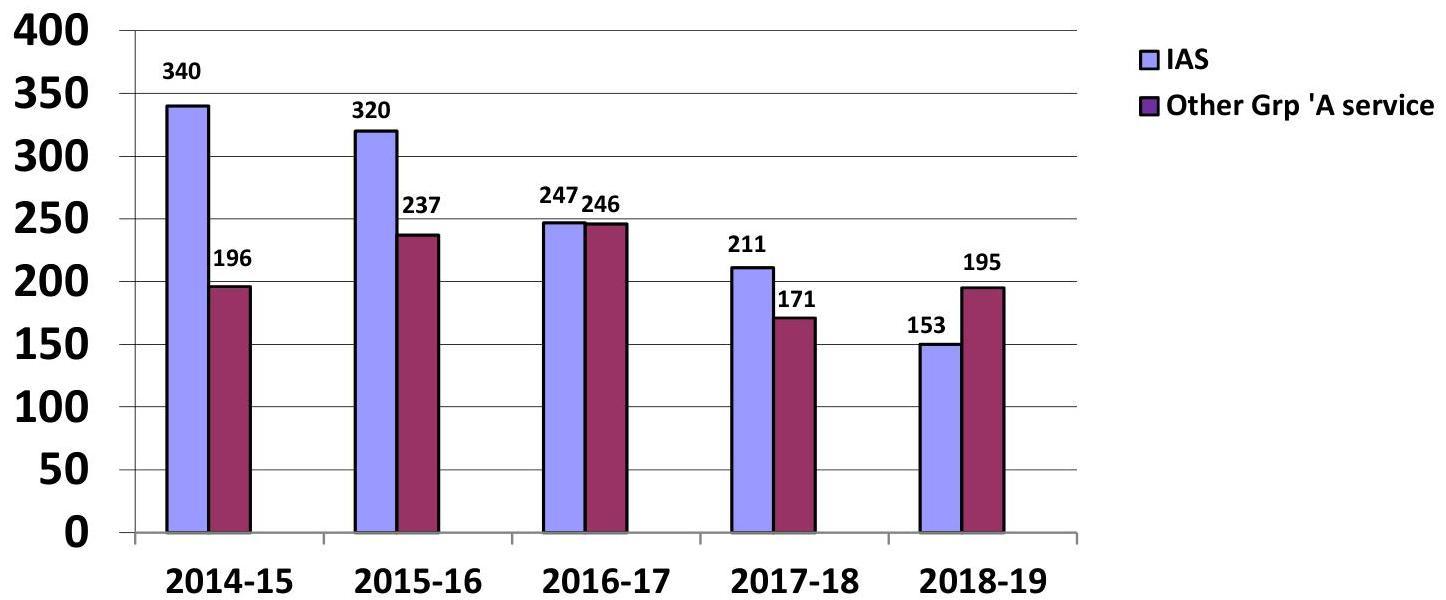
Figures for 2014-15 are up to 28/2/2015, for 2015-16 are up to 31/12/2015, for 2016-17 are up to 31/12/2016, for 2017-18 are up to 30/11/2018 and 2018-19 are up to 31/3/2019.
CENTRAL DEPUTATION RESERVE
6.5 The Establishment Officers (EO) Division in the Department of Personnel & Training maintains an electronic database of the IAS officers \& of Group ‘A’ service officers working at the Centre under the Central Staffing Scheme. These records are maintained on the basis of orders/ letters/notifications issued by the DOPT, various Central Ministries/Departments and the State Governments. The maintenance/ updation of
this database is significant, as it helps in providing readily available digitized information in respect of all officers and also processing of cases for foreign appointments/assignments and training etc.
6.6 The Central Deputation Reserve statement in respect of Indian Administrative Service summarizes the state wise number of officers that are on central deputation vis-a-vis senior duty posts. It also indicates the number of officers presently on central deputation from each cadre.
CENTRAL DEPUTATION RESERVE FIGURES AS ON 01/01/2019
| Sl. No. |
Cadre | Total Authorized Strength |
Central Deputation Reserve |
No. of Officers at Centre |
Col. 5 as Percentage of Col. 4 |
|---|---|---|---|---|---|
| 1 | 2 | 3 | 4 | 5 | 6 |
| 1 | A G M U T | 337 | 73 | 42 | 57 |
| Sl. No. |
Cadre | Total Authorized Strength |
Central Deputation Reserve |
No. of Officers at Centre |
Col. 5 as Percentage of Col. 4 |
|---|---|---|---|---|---|
| 1 | 2 | 3 | 4 | 5 | 6 |
| 2 | Andhra Pradesh | 211 | 46 | 18 | 39 |
| 3 | Assam Meghalya | 263 | 57 | 34 | 59 |
| 4 | Bihar | 342 | 74 | 38 | 51 |
| 5 | Chhattisgarh | 193 | 38 | 7 | 18 |
| 6 | Gujarat | 297 | 64 | 17 | 26 |
| 7 | Haryana | 205 | 44 | 12 | 27 |
| 8 | Himachal Pradesh | 147 | 32 | 26 | 81 |
| 9 | Jammu & Kashmir | 137 | 30 | 13 | 43 |
| 10 | Jharkhand | 215 | 45 | 10 | 22 |
| 11 | Karnataka | 314 | 68 | 20 | 29 |
| 12 | Kerala | 231 | 50 | 31 | 62 |
| 13 | Madhya Pradesh | 439 | 90 | 28 | 31 |
| 14 | Maharashtra | 361 | 78 | 24 | 30 |
| 15 | Manipur | 115 | 24 | 15 | 62 |
| 16 | Nagaland | 94 | 20 | 9 | 45 |
| 17 | Odisha | 237 | 51 | 20 | 39 |
| 18 | Punjab | 221 | 48 | 15 | 31 |
| 19 | Rajasthan | 313 | 64 | 18 | 28 |
| 20 | Sikkim | 48 | 10 | 7 | 70 |
| 21 | Tamil Nadu | 376 | 81 | 22 | 27 |
| 22 | Telangana | 208 | 35 | 11 | 31 |
| 23 | Tripura | 96 | 21 | 11 | 52 |
| 24 | Uttar Pradesh | 621 | 134 | 44 | 32 |
| 25 | A G M U T | 120 | 26 | 6 | 23 |
| 26 | Andhra Pradesh | 359 | 78 | 9 | 11 |
| Total | 6500 | 1381 | 507 | 36 |
6.7 In addition to the appointments under the Central Staffing Scheme, 293 appointments as Chairman/CMDs/MDs/Deputy Governor/ Chairman/Vice Chairman/Members/Executive Directors/Officers Employee Directors/Workmen Employee Directors/Functional Directors/Non Official Directors were made on the Boards of Public Sector Undertakings and Banks/Financial Institutions during the period 1.04.2018 to 31.03.2019. During the same period, 578 appointments were made at the level of Chairman/ Financial Commissioner/General Managers equivalent/Members/Additional Members/ Director General in the Railway Board/Zonal
Railways/RCT and Promotion/empanelment were carried out for appointments to Higher Administrative in various Group ‘A’ Services under the Ministry of Railways. Besides, 334 Officers were also approved during the above period for additional charge/current charge/extension of tenure/non-extension of tenure/ad-hoc/rejection/ termination of service of GM/DG/VC/CMDs/MDs, Functional Directors, Non-Official Directors in PSUs/Banks/Financial Institutions, and the Ministry of Railways. Out of these 1205 appointments/ Additional charges, 72 pertain to women during this period.
NUMBER OF APPOINTMENTS TO THE POST OF CHAIRMAN-CUM-MANAGING DIRECTOR/MANAGING DIRECTOR ETC IN PSUs/BANKs
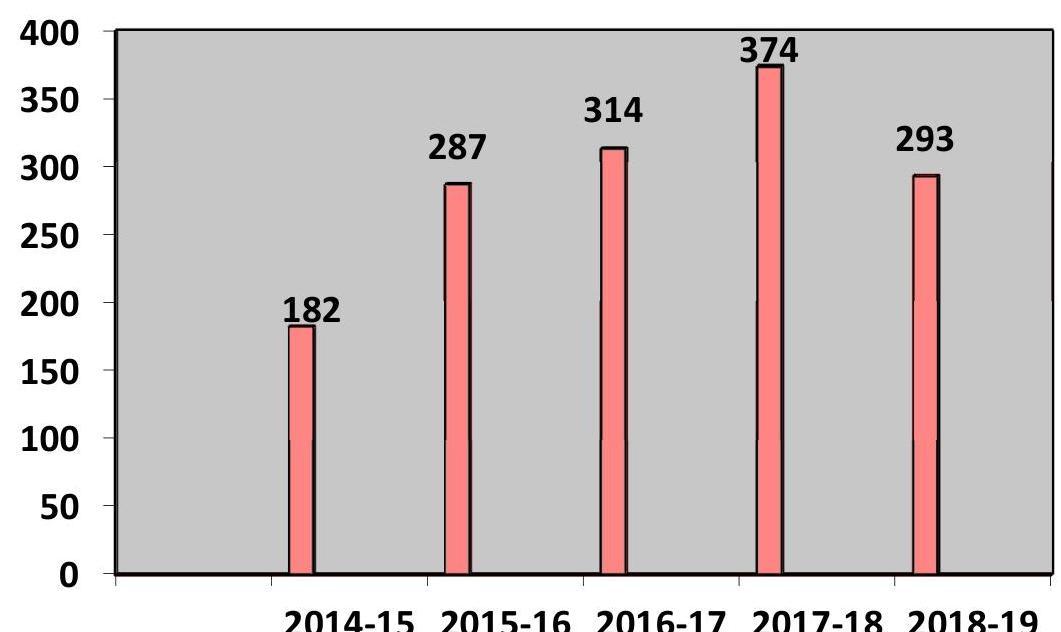
APPOINTMENTS OF CMDs/MDs/ PSUs/BANKs
6.8 During this period 191 Member/Chairman/ Chief Executive Officer/Advisor/ were approved in various Autonomous Bodies, Administrative Tribunals, Labour Courts and Regulatory Bodies. Out of these, 35 are women.
6.9 A total of 1693 officers were approved for
empanelment for promotion to posts of and above the level of Joint Secretary in various organized Central Services which are not included in the Central Staffing Scheme. Out of these 181 are women.
6.10 The Election Commission of India has been
provided the names of 299 (Year 2018) and 313 (year 2019 till $31^{\text {st }}$ March) IAS officers in the rank of Additional Secretaries and senior Joint Secretaries, drawn from the Central Ministries/ Departments for appointment as Observer for General Election to the Lok Sabha and States Legislatures.
REPRESENTATION OF WOMEN
6.11 While taking up empanelment of officers to Joint Secretary rank, it is ensured that women get adequate representation.
6.12 A total of 76 women were appointed under Central Staffing Scheme during the period from 1/4/2018 to 31/03/2019 including 50 women at Secretary/Addl. Secy./ Joint Secy. levels.
6.13 The appointments/ additional charge/ Extension of tenure /service as CMDs/MDs, Executive Directors, Functional Directors, Nonofficial Directors in PSUs/Banks, Financial Institutions, Railway Claims Tribunal (Indian Railways) include 72 pertaining to women during the above period.
6.14 A total of 181 women were approved for appointment to posts of Joint Secretary level and above in various organized Central Services excluding appointments under the Central Staffing Scheme.
6.1535 women were approved for appointment as Member/Chairperson/CEO etc. in various Autonomous Bodies, Administrative Tribunals, Labour Courts and Regulatory Bodies.
Chief Vigilance Officer
6.16 During the year 2018-19 (upto $31^{\text {st }}$ March, 2019), 36 officers have been appointed as Chief Vigilance Officer (CVO) in various organizations. Deputation tenure of 6 CVOs were extended after completion of initial tenure and 28 officers were given additional charge of the vacant posts of CVOs.
7
CHAPTER
Training Policy and Programmes
7.0 The Training Division of the Department of Personnel and Training is the nodal agency for training of government functionaries and is primarily responsible for formulating policies with regard to training. It also implements certain components of training directly. In the implementation of its mandate, the Division has set the following objectives:
- Administering Policy matters in training
- Identification of functional areas of training
- Designing and implementing training programs for officers involved in the priority development sectors
- Development of trainers and training capability
7.1 The ultimate goal of the Training Division is to attain “Training for All” which means that training would be imparted to all rungs of Civil Services starting from the lowest and cutting-edge to the highest in policy making.
Major Activities
1) In-service Training of IAS Officers
2) Mid Career Training of IAS Officers
3) Domestic Funding of Foreign Training
4) Post Graduate Programmes in Public Policy
5) Training Support
6) Intensive Training Programme
7) Augmentation of the Capacity of training institutions
8) E-governance initiatives
9) Comprehensive Online Modified Modules for Induction Training (COMMIT)
10) Posting of IAS Officers as Assistant Secretary in Govt of India
Long-Term Domestic Post Graduate programmes in Public Policy and Management
7.2 Indian Institute of Management- Bangalore (IIMB), Indian School of Business – Hyderabad/ Mohali (ISB-H/M), Management Development Institute- Gurugram (MDIG) and TERI School of Advance Studies (TERI SAS)- New Delhi are offering these programmes.
These programmes were envisaged to enhance the competence of Mid-Career Civil Servants in Public Policy and Management by –
- Broadening awareness of the latest trends in policy approaches,
- Developing technical, analytical and leadership skills for public policy,
- Providing opportunity in specialization and
- Exposing them to alternative systems of public management in other countries.
7.3 During 2018-2019, $17^{\text {th }}$ Batch of Post Graduation Programme in Public Policy and Management (PGPPM) was conducted at Indian Institute of Management- Bangalore, which was attended by 21 participants. $3^{\text {rd }}$ Batch of One year Management Programme in Public Policy (MPPP) was conducted at Indian School of BusinessHyderabad/ Mohali, which was attended by 19 participants. $12^{\text {th }}$ Batch of Post Graduation Diploma Programme in Public Policy and Management was conducted at Management Development Institute- Gurugram, which was attended by 11 participants. $10^{\text {th }}$ Batch of Programme in Public Policy & Sustainable Development (PP \& SD) at was conducted TERI University- New Delhi, which was attended by 10 participants.
Mid-Career Interaction between Armed Forces and Civil Services Officers
7.4 Mid-Career interactions between Armed Forces and Civil Services Officers are being organized at the Central Training Institutes/State Administrative Training Institutes and Defence Institutions in various parts of the country with the objective to benefit both the Armed Forces and Civil Services Officers by way of mutual learning from each other’s strength and also by imbibing the best points of each other’s work culture, ethos and customs. This, in the long run, is expected to help the participating officers to combat future challenges to national security in a better manner.
7.5 During the current financial year 2018-2019, 4 programmes have been conducted at Maritime Warfare Centre- Mumbai (NAVY), Indian Institute
of Public Administration (IIPA)- New Delhi (DoP\&T), College of Air Warfare- Secunderabad (Air-Force) and HQ South Western Comd- Jaipur (Army) on the themes ‘Need for a unified Maritime approach to National opportunities and Challenges’, ‘Food and Energy Security’, ‘Civil-Military Interface to tackle threat of terrorist attacks to military installations and infrastructure’, ‘Unified intelligence’ and ‘CivilMilitary coop in Disaster Management during large scale natural and manmade disasters’ and ‘CivilMilitary coop in Aid to Civil Authority during vide spread agitation, demonstrations and riots’. The total number of participants in four programmes was 105 .
Capacity Building Programmes for State Civil/Secretariat Service Officers of North Eastern Region
7.6 DoP\&T has conducted one Capacity Building Training Programmes of two weeks’ duration for the State Secretariat Service Officers of North Eastern Region States at Institute of Secretariat Training and Management (ISTM)- New Delhi during the current financial year, which was attended by 44 participants. The objective of this programme was capacity building, personality development and sensitization to national and developmental issues. The programme also covered inputs on Good Governance, Public Service Delivery, Project Appraisal \& Management and Public Private Partnership.
TRAINING SUPPORT
Thematic Training Programmes State Category Training Programme
7.7 Under the scheme of “Training for All”, support is provided to State Administrative Training
Institutions (ATIs) by way of sponsoring training programmes in the areas accorded priority by the Central Government. The Training Programmes conducted by the State ATIs are designed to develop management skills and knowledge in different areas for senior and middle level officers of State Govt. /State Public Sector Undertakings and State autonomous bodies. These training courses are also meant to sensitize the officers to new and important issues facing our society. The courses are also being conducted at District and Sub District Centres of the State ATIs. These courses cover a large variety of subjects under broad thematic groups.
7.8 During the year 2018-19, 603 such shortterm courses have been sponsored at various State ATIs on subjects such as Sustainable Development, Decentralized Planning, Public Private Partnership, Gender Issues, Minority Issues, Disability Issues, Audit & Budget, Human Rights, Leadership \& Team Building, Computer \& IT, E-Governance, Cyber Security, Goods \& Service Tax (GST), Court Procedures, Office Procedures, Women Empowerment, Child Development, Role of NGOs, Labour Law, Panchayati Raj, Environment Issues, Road Safety, Right to Information, Establishment Rules, Ethics \& Values in Governance, Disaster Management, Financial Management, Urban Management, Consumer Rights etc. During the Financial Year 2018-19, out of 603 sponsored courses, 439 courses have actually been conducted and 12527 participants have been trained under this Scheme.
TRAINER DEVELOPMENT PROGRAMME
7.9 Recognizing the importance of trainers in the training function, Training Division started
the Trainer Development Programme in the early 1990s. Initially, faculty members of various training institutions were developed as Master Trainers and Recognized Trainers of various “Training of Trainers (ToT)” packages in collaboration with the Thames Valley University of U.K. Over a period of time, indigenous mechanisms were evolved for developing a cadre of professional trainers and resource persons in the country to create a cascading and multiplier effect. The programme has gone a long way in embedding the Systematic Approach to Training (SAT) into the process of designing and imparting effective training to government officials.
7.10 Currently, the following ToT programmes are sponsored under Trainer Development Programme at various training institutions across the country:
- Training Needs Analysis (TNA)
- Design of Training (DOT)
- Direct Trainer Skills (DTS)
- Evaluation of Training (EoT)
- Management of Training (MoT)
- Experiential Learning Tools (ELT)
- Mentoring Skills
- Facilitation Skills
- Introduction to SAT courses
7.11 The Department has developed a pool of more than 60 Master Trainers and approximately 350 Recognized Trainers in different packages under this Scheme, who are called upon to conduct TDP courses. DoPT has sponsored 114 TDP courses on various packages during the current financial year 2018-19. During the Financial Year 2018-19,
out of 114 sponsored courses, 93 courses have actually been conducted and 1553 participants have been trained under this Scheme.
INTENSIVE TRAINING PROGRAMME
7.12 Intensive training programme for frontline Government functionaries of State Governments was initiated during the year 2008-09. The focus of this programme is on demand-driven training of frontline personnel and is conducted in close coordination with line Departments by the State Administrative Training Institutes (ATIs). The programme was given a momentum through issue of new ITP implementation and management guidelines to all the Chief Secretaries and the State ATIs; holding three workshops in the beginning covering all 29 States at Delhi, Hyderabad and Assam; followed by workshops, mid-term-reviews of this programme in Chandigarh, Shillong and Goa. This programme aims at improving functional knowledge, skill and attitudinal orientation of the frontline functionaries through appropriately designed training interventions to strengthen Public Service Delivery Mechanism.
7.13 The intensive training programme has been implemented in more than 280 districts and 92,605 officials have been trained since its inception. Some of the sectors covered under the Programme include – Water and Sanitation, Public Health, Public Distribution System, Revenue, Integrated Child Development Services, School Education, Dairy Development, Registration, Social Welfare, Police, Citizen Centric Delivery and Right to Public Services Act etc. A national documentation-cum-facilitation centre for this programme has been established (www.itpndfc.in) under which an
ITP knowledge portal is in existence for the benefit of general public and for the use of all those who are involved in the process of implementation of this Programme.
INDUCTION TRAINING PROGRAMME
7.14 In order to promote a citizen centric attitude in the employees, for better public service delivery and promote good practices towards achieving the vision of citizen centric governance Department of Personnel and Training had launched a capacity building programme on pilot basis in three States of Jammu & Kashmir, Maharashtra and Tamil Nadu for 3000 newly recruited cutting edge level government functionaries to develop in them Generic \& Domain specific competencies covering 15 districts in the financial year 2014-15.
7.15 After successful completion of the Pilot, a 12-Days Induction Training Programme (ITP) was launched in the year 2016-17, the Induction Training Programme has been implemented in 115 new districts of 24 States. with a Two Day Regional Training of Trainers (ToT) Workshop at various State ATIs for training of 7000 frontline State government functionaries. A motivational talk by locally available inspirational achievers/ national award winners/sports persons in the inaugural session of the ToT Workshop and training programme in the districts, one day blood donation camp during the middle of the course and one night stay in the village as part of field/ NGO visit were compulsory component of the 12 Days Induction Training Programme. In the year 2017-18, the Induction Training Programme has been implemented in 75 districts in 15 States.
7.16 In the year 2018-19, the Induction Training
Programme has been implemented in 43 districts of 09 States.
COMPREHENSIVE ONLINE MODIFIED MODULES FOR INDUCTION TRAINING (COMMIT)
7.17 A new Blended Training Programme called Comprehensive Online Modified Module on Induction Training (COMMIT) has been conceptualized and digitally launched on 27.06.2017, in the light of the mandate given in the National Training Policy, 2012, whichstipulates that all civil servants from lowest level functionaries to the highest level will be given to the training of front-line staff, including trainingon soft skills, so as to improve customer orientation as well as quality service delivery to the citizen. This programme supplements the existing 12-Day Induction Training Programme (ITP). The programme has the potential to cover 3 lakhs (approx.) officials every year. With this programme there would be a huge jump in the coverage of the participants in comparison to the existing 12-Day ITP, wherby a maximum of 10,000 officials only are covered year. During the Financial Year 2017-18 and 2018-19, the programme was rolled out in 13 States with the target of training 1,17,852 recently recruited frontline functionaries with an expenditure outlay of around Rs. 16.30 Crore. As on date, while 1,06,771 officials have completed face-to-face training, 48,777 officials have completed training in e-modules.
7.18 An online training programme namely integrated Government Online Training Programme (iGOT) has been launched digitally by the Hon’ble Minister of State (PP) on $20^{\text {th }}$ December, 2018 along with NLS, Bangalore’s Law Training Programme (i-GOT). The Online
Training Programme is available initially on pilot basis. The programme covers approximately 1,000 Government functionaries on the pilot basis. Based on the outcome of the programme implemented as a pilot, the online training programme will be rolled out nationwide in the next financial year. In the pilot run of the online training programme through integrated Government Online Training Programme (iGOT) mechanism, the existing online training courses of the premier institutes/ academies of the country will be made available for the officers. The training courses under this programme will be accessible through DoPT’s web portal. Under the online training programme through (iGOT) mechanism, the eligible officers will be get enrolled in the approved open programmes on their own, as per the procedure to be laid down separately, complete the course successfully and obtain certificate. Thereafter, the officer will submit the proof of successful completion to DoPT for reimbursement of the expenses incurred to the extent approved by DoPT.
7.19 This mechanism will help in putting in place a systematic training hierarchy, which shall cater to the training requirement of the officials, especially the State Government official commensurate with their changing role with upwards movement in the hierarchy. In the process these official should also accumulate credits that will in turn enable them for training programmes of higher levels. The training will not only be focused to the specific requirement of the sector but also be able to cater to the needs of the officials in his/her current role as well as his/her desire role in future. It will build a creditable expertise of social delivery and give tangible returns to the Government delivery system. Simultaneously, it will also act as an incentive for an
officer to deliver effectively and be self-motivated for getting trained for better delivery of public services.
Overseas Training Programmes
7.20 Department of Personnel and Training has been nominating officers for training programs abroad. In the past, these programs were funded by bilateral or multilateral assistance. However, over the years, this assistance had come down. Keeping in view the importance and benefits of providing international exposure to the officers, a scheme of Domestic Funding of Foreign Training (DFFT) was started in 2001. This covers both long term and short-term training in various universities/institutes in several countries. A scheme of “Partial Funding of Foreign Study” was also started in 2002-03 as another component of the scheme of DFFT. Under this scheme, Government of India provides limited financial assistance to such officers who secure admission on their own in reputed universities and in programs relevant to their present or future job context.
7.21 During the financial year 32 officers were nominated for long term foreign training programs and 300 officers were nominated under short term foreign training programs. Further, 16 officers have also been granted partial funding assistance under the DFFT Scheme.
Scheme of scholarship by Private Foundation Trust
7.22 A scheme for scholarship offered by private foundation/trust in top 10 ranked universities as per the world university ranking for officers of all the three All India Services has been approved by the Government. Funding under
this scheme is available for pursuing programs in Master in Public Policy/Public Administration/ International Development and Master in Business Administration, subject to the eligibility conditions.
Under this scheme, ‘Desai Sethi Family Foundation’ has offered ‘Desai Sethi Family Foundation Fellowship’. On this, two fellowships/scholarships are available for officers belonging to Indian Administrative Service, Indian Foreign Service, Indian Police Service and Indian Forest Service for pursuing a 2 year Masters program in Public Policy/ Public Administration/International Development at Harvard Kennedy School, Harvard University. The funding is US$ 50,000 per officer per year. The guideline on the fellowship is available on the website of this Department.
One-week In-Service Training (IST) Programs for Officers of All India Services and for those working under Central Staffing Scheme- Sponsored by Department of Personnel & Training
7.23 The Training Division sponsors ‘In-Service Training Programme’ of ‘one-week duration’ in various ATIs/CTIs/ Premier Training Institutes in the country by inviting proposals from them on relevant themes. During the year (2018-19), 9 programmes have been conducted at 9 training institutions. These programmes provide middle and senior management level officers an opportunity to update their skills in areas of their choice-in sectors they are currently working in, or in an areas they are expected to work in near future, or in areas they feel they want to specialized in. These programs also provide a valuable platform for horizontal and vertical knowledge sharing.
7.24 The primary objective of the IST program is to sensitize the participants to national concerns and the values enshrined in the Constitution; to provide for exchange of experience and adequate discussion on issues of values, ethics and attitudes; to make the participants more confident to face problems in their work areas and attempt solutions; and to train the participants to look at problems in an integrated manner and develop a systematic approach.
7.25 In the past, these programs have been offered in diverse and broad thematic areas: such as Administrative Law, Agricultural & Rural Development, Climate Change (preparedness), Competition Law (policy formulation), Corruption (eradication strategy), Education (reforms \& challenges), E-governance (opportunities \& challenges), Environment \& Natural Resource (management), Environmental Impact Assessment (development projects), Ethics (Public Governance and Administration), Financial Markets (regulation), Fiscal Policy (Macroeconomic Management), Governance (IT management and improving through accountability), Infrastructure (Finance), Innovations (public service), Land Acquisition (rehabilitation \& resettlement), Leadership, Participatory Management (Community Mobilization), PPP (negotiating strategies and urban development), Procurement (procedure \& contracting), Project Analysis/Appraisal (risk analysis/management), Public Policy (management/governance), Quantitative Methods (management), Service Delivery (management), Social Policy (Governance), Social Sector (financing/ marketing), Urban Development, WTO (basic/ advance course), Citizen Centric, Cyber Crime, Stress Management, etc.
Advanced Professional Programme in Public Administration (APPPA) At Indian Institute of Public Administration, New Delhi
7.26 The Training Division has been sponsoring a ten-month Advanced Professional Programme in Public Administration (APPPA) at the Indian Institute of Public Administration (IIPA), New Delhi every year since 1975-76.
7.27 The objectives of this programme are to prepare the participants to make greater contribution to better governance, develop attitudes that focus on citizen services and also to strengthen leadership qualities in the civil service. It provides an opportunity to the participants to analyze major contemporary issues in Governance, learn about recent developments in the social sciences and their application in administration; review their experiences by making a critical analysis of environmental and other factors, apply relevant concepts, skills and techniques relating to policy, behavioral and administrative sciences and to demonstrate their creative and analytical abilities individually and in groups. It also seeks to develop interpersonal skills and sensitiveness to the needs of the people with a view to making administration more responsive and result oriented.
7.28 The course covers classroom studies relating to various facets of administration viz, Social, Political, Economic, Legal and Administrative Systems, Organizational Behavior, Social Science and Research Methods, Operational Research, Information Technology in Management and Financial Management. Participants are also required to conduct rural and urban field studies and prepare a project report and
dissertation. They are expected to select an area for specialization relevant to their present and likely future assignments from following fields of study: Advanced Information Technology and MIS, Comparative Development Experience, Project Management, Constitutional Law, Disaster Management, Economics of Regulation, Inter Governmental Relations, Management Systems, Organizational Needs Analysis, Public Expenditure Management, Public Organizational Theory, TQM, Finance, Personnel, Corporate or Public Sector Management, General Administration, Planning and Rural Development etc.
7.29 This 10 month programme includes three semesters, rural and urban field visits in India and a 10 day foreign study tour. In the $44^{\text {th }}$ APPPA Programme, the participants visited in two groups to USA, Czech Republic, South Africa & Spain. 40 participants are attended this programme.
Posting of IAS Officers as Assistant Secretary in Government of India:
7.30176 IAS Officers of 2016 batch were posted as Assistant Secretary in the Ministries/ Departments of Government of India from $2^{\text {nd }}$ July, 2018 to $28^{\text {th }}$ September, 2018 on Central Deputation.
7.31 The objective of the Assistant Secretary Scheme is to provide exposure to the IAS officers of 2016 batch to Government of India functioning. This exposure would help them acquire a national perspective and a deeper appreciation of the harmonization of diversities in national policies. This will sensitize them to the larger perspective (vision) of any policy \& programme of Government of India.
7.32 Important Desks related with policy, flagship programmes of the concerned Ministries/ Departments, etc. was assigned to the Assistant Secretaries. They worked on Desk Office pattern, initiated and disposed off files, the reports of which were submitted to DoPT periodically by concerned Ministries/Departments.
7.33 The Hon’ble PM addressed the Assistant Secretaries in the Inaugural Session at Parliament House Annex on the $4^{\text {th }}$ July, 2018 and in the Valedictory Session of Assistant Secretaries (IAS2016 batch) at DRDO Auditorium, New Delhi on $27^{\text {th }}$ September, 2018. Interaction of these Assistant Secretaries was also held with President, Vice President, Cabinet Secretary, Election Commission, etc. They also visited attached offices of the concerned Ministries/Departments and undertook visits to Aspirational Districts in addition to the Desk work assigned to them.
7.34 Interactive sessions with Assistant Secretaries (IAS-2016 Batch) were organized by DoP\&T, NITI Aayog, Cabinet Secretariat on different topics in which a large number of dignitaries / Head of Departments /Head of Organizations / Senior Officers participated. The Special Interactive Sessions were organized on POSHAN Abhiyaan by WCD and Swach Bharat Abhiyaan by M/o Drinking Water.
7.35 The Assistant Secretaries had prepared presentations on the key learnings based on the work allocation. These presentations were shortlisted by sectoral group of Secretaries and thereafter shortlisted by Cabinet Secretariat. The following top 8 presentations were presented before the Hon’ble PM in Valediction session:
- Preparing an ideal timeline for various stages of Soil Health Card (SHC) delivery- Improving the design of SHCs by Shri Vaibhav Chaudhary,
- Promotion of Large Cardamom GI in Sikkim – Nurturing an ecosystem to leverage the GI Tag by Shri. Vishu Mahajan,
- Smart Solutions for Storm Water Management in Cities by Shri Ashish Sangwan,
- Leveraging the Post Office Network for promoting citizen centric services by Ms. Artika Shukla,
- Market Development in Power Sector by Ms. Jayati Singh,
- Another Push to Clean Up Banking System: E-Auction of Properties of Defaulters by Bhavya Verma and others,
- CPGRAMS: A Revamped version by Shri Vivek H P, and
- Incredible India Tour Facilitator by Shri Athar Aamir Khan.
8
Training Institutions
LAL BAHADUR SHASTRI NATIONAL ACADEMY OF ADMINISTRATION, MUSSOORIE (UTTARAKHAND)
Introduction
8.0 The Lal Bahadur Shastri National Academy of Administration (LBSNAA), Mussoorie is Government of India’s premier institution for the training of higher civil services in the country. The Academy imparts induction level and in-service training. A common Foundation Course is held for entrants to All India Services and all Group “A” services of the Union. The professional training to regular recruits of the Indian Administrative Service (IAS) and members of the Royal Bhutan Civil Service is conducted after the Foundation Course. The Academy also conducts in-service and Mid-Career Training Program (MCTP) for members of the IAS and Induction Training program for officers promoted to the IAS from State Civil Services, as well as workshops and seminars on various issues in public administration.
8.1 To ensure that the academic curriculum is relevant, it is constantly reviewed and updated through extensive consultations with the representatives of the State Governments, the Central Government and other scholars and practitioners. Given the limitations of conventional classroom lectures, new pedagogical methods have been introduced to deliver training inputs in a more effective manner. Most courses operate on
a modular structure whereby relevant themes are chosen and dealt with in a consolidated fashion to ensure that all aspects relating to them are covered comprehensively.
8.2 In order to promote all-round development of the personality, due emphasis is placed on outdoor and co-curricular events. Physical training, team games and tennis, badminton, cross-country running, yoga, horse riding and adventure sports like river rafting, para-gliding, bungee jumping and rifle shooting are some of the activities that the officer trainees are involved in. Exposure to public speaking, theatre workshops, motor mechanic skills, gardening, photography and music appreciation are some of the co-curricular activities offered to the young administrators.
8.3 To nurture the values of integrity, moral courage, empathy and respect for the underprivileged, and freedom from any sectarian prejudices based on religion, region, caste, class or gender, Officer Trainees are encouraged to participate in diverse social activities. Various Clubs and Societies have been formed to which the Officer Trainees are elected as office-bearers. They organize and take part in quizzes, debates, poetry competitions and numerous other activities after class hours. This lends a spirit of bonhomie and also promotes esprit-de-corps.
Induction Training Courses
8.4 The Academy conducts Induction training
courses for direct recruits to the IAS and other senior civil services as well as officers promoted to the IAS.
Foundation Course (15 Weeks)
8.5 The Foundation Course is the flagship course of Induction training and is intended for fresh entrant, to the All-India Services, i.e. the Indian Administrative Service, the Indian Police Service and the Indian Forest Service, and the various Central Services (Group-A) of the Union. It is a fifteenweek course conducted from August to December
every year. The course aims at imparting a basic understanding of the constitutional, political, socioeconomic and legal framework of the country; and also fostering greater co-ordination among the members of the different public services by building esprit-de-corps and cultivating an attitude of co-operation and inter-dependence. This year total of 370 Trainees including eleven officers from RBCS have participated in the Course organised from $27^{\text {th }}$ August, 2018 to $7^{\text {th }}$ December, 2018. The course was inaugurated by the Shri Hardeep Singh Puri, Hon’ble Minister of State, Housing and Urban Affairs, Government of India.
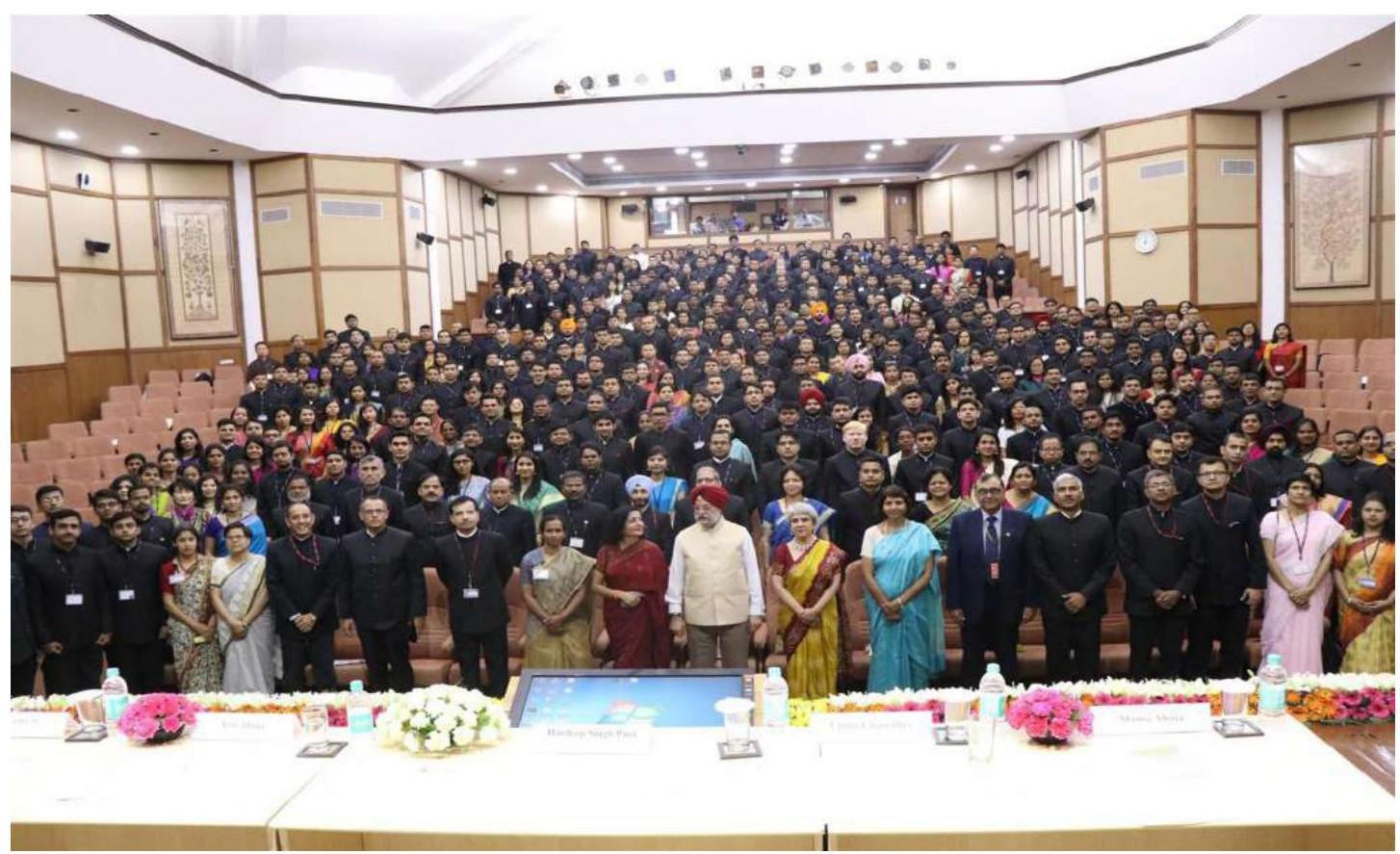
Inauguration of $93^{\text {rd }}$ Foundation Course, 2018
Parallel Foundation Courses were also conducted at MCR HRD Institute, Hyderabad and RCVP Noronha Academy of Administration, Bhopal.
8.6 The main activities organized during the Foundation Courses were:
- Trekking: The objective of trek is to inculcate the spirit of adventure and to strengthen Esprit de corps in the Trainees. The trek is also a significant learning experience in group dynamics, interpersonal relations, courage,
endurance and love and respect for nature.
2. Village Visit Programme: Trainees spent one week in selected villages in Uttar Pradesh, Bihar, Madhya Pradesh, Jharkhand, Chhattisgarh and Rajasthan in groups of 5-6. Here they were sensitized to the empirical realities of rural India, through a structured study of a village. A special feature of the village visit this year was organization of “Swachatta Diwas” in each of the selected villages when the trainees raised awareness about the cleanliness mission of the Government and also undertook cleanliness
drives in the villages along with the residents. The Trainees also undertook an awareness drive on ‘Financial Inclusion’.
3. Extra-Curricular activities are conducted in the afternoons and evenings in order to impart skills other than purely academic to the trainees in recognition of the need for an officer to have diverse interests and a wellrounded personality. Primarily, these include celebration of India Day, AK Sinha One-Act Play Competition, Cross Country Run, Athletic Meet and Blood Donation Camp.
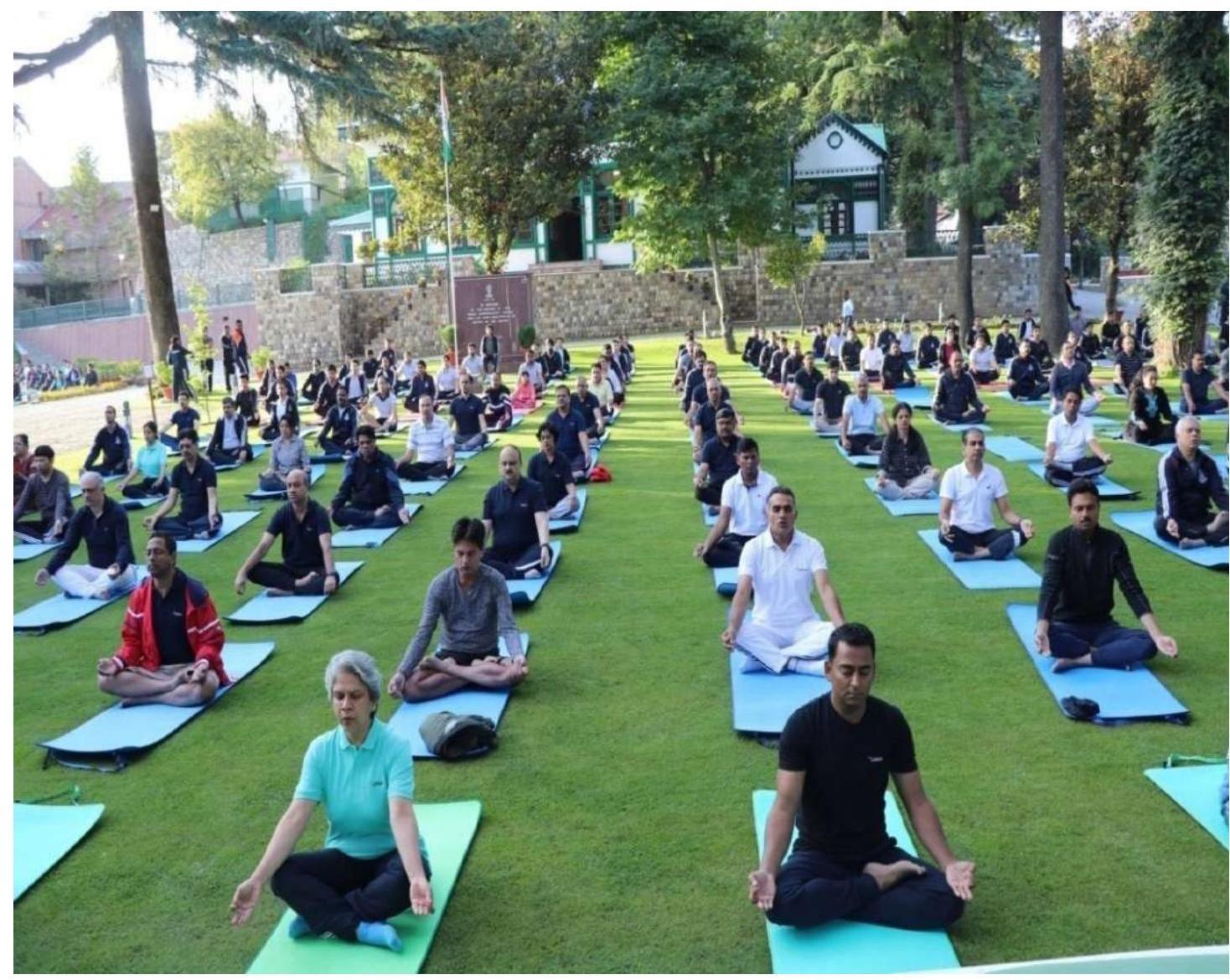
Yoga at the Academy on International Yoga Day on June 21, 2018
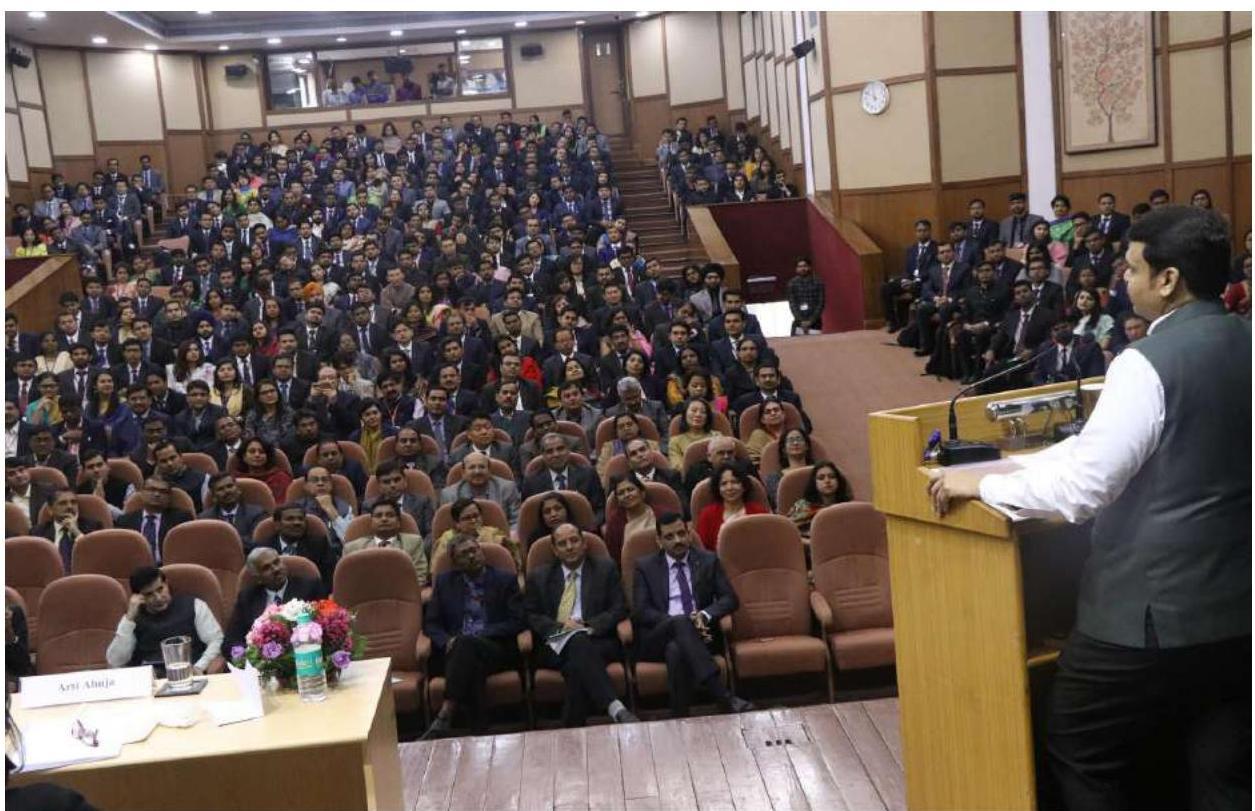
The Hon’ble Chief Minister of Maharashtra Shri Devendra Fadnavis visited the Academy on 11-12 October 2018 and had informal interaction with the Officer Trainees and Faculty in groups.
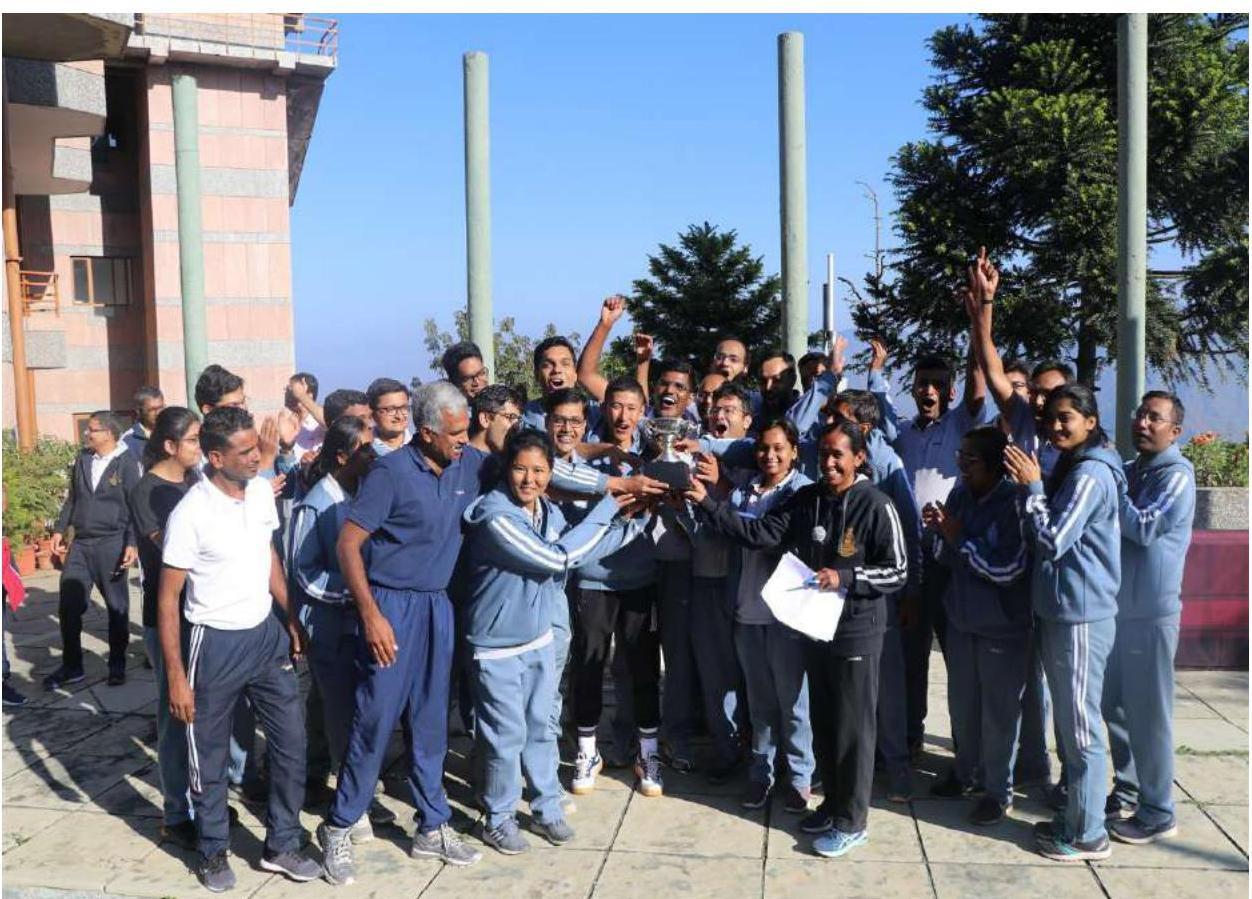
Cross-country race in 93rd Foundation Course
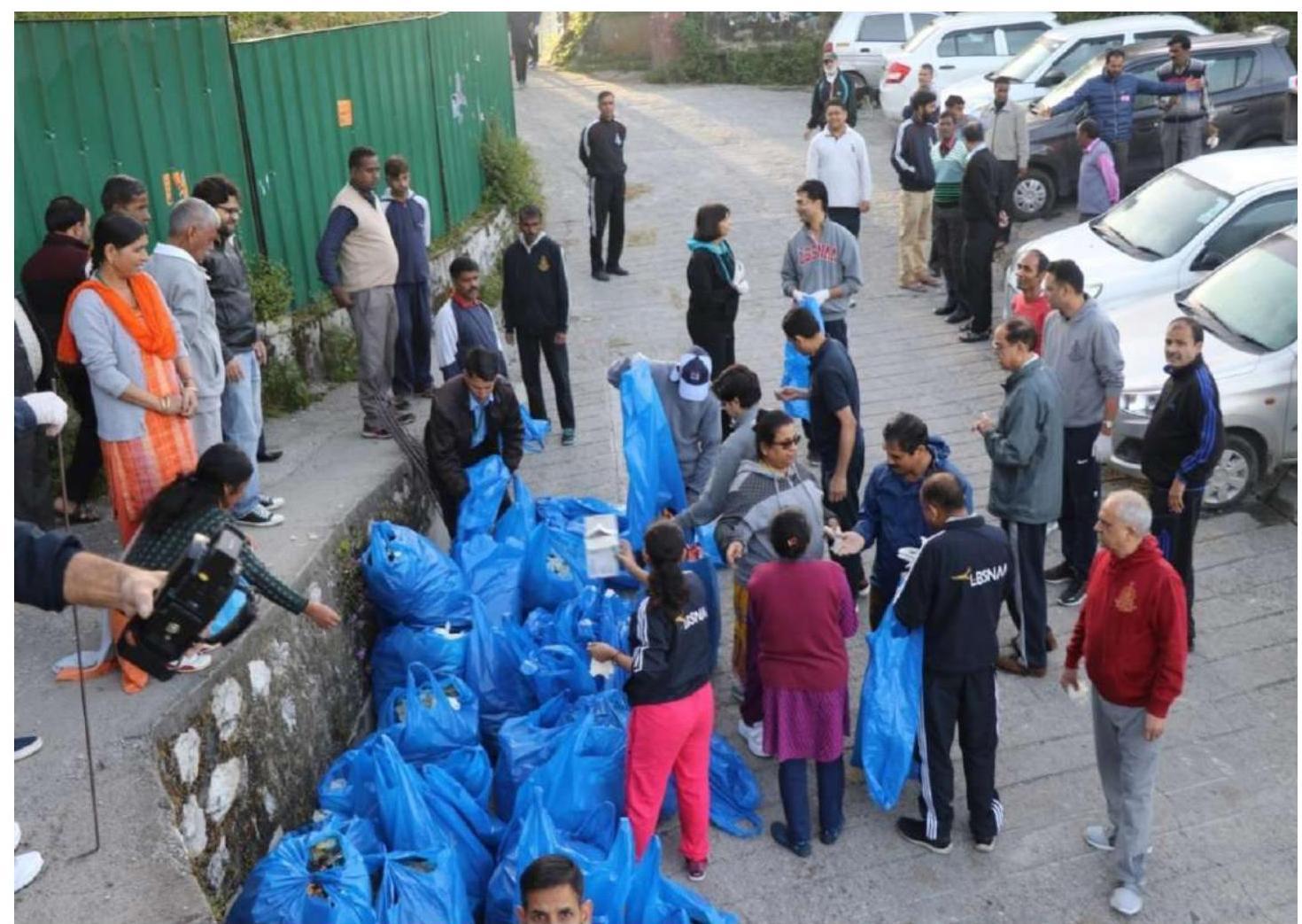
IAS Officers of Phase-IV and staff of LBSNAA doing Shramdan
IAS Professional Course Phase-I 2017 Batch (22 Weeks)
8.7 The IAS Officer Trainees of the 2017 batch (total 181 including 03 Trainees from Royal Bhutan Civil Service) underwent the IAS Professional Course Phase – I from December 11, 2017 to May 11, 2018. This course aims at developing professional skills in handling a large range of responsibilities that an officer shoulders within the first ten years of service. Emphasis is laid on understanding public systems and their management, together with a grounding in Public Administration, Law Economics, Management and Computer Applications. During the first part of Phase – I, the Trainees were sent on a 7 week Winter Study Tour (Bharat Darshan) comprising of attachments with the three Armed Forces, Public Sector, Private Sector Units, Municipal Bodies, Civil Society Organizations and civil administration in challenging areas, etc. special focus visits to places with traditional and modern water conservation practices were organized after completion of IAS Phase-I, they were relieved on May 11, 2018 for their District Training as part of IAS Professional Course Phase – II.
District Training (53 Weeks)
8.8 During the year-long District Training, the IAS Officer Trainees learn about the various facets of administration at the district level. During this
period they are under the direct charge of the District Collector and the State Government. They get an opportunity to obtain first-hand knowledge of the work of the Collector/District Magistrate and various other institutions in the State Government, along with orientation training at the State Administrative Training Institute. Most of the State Governments give them an opportunity of holding independent charge as Tehsildar/Mamlatdar, Sub Divisional Magistrate, Block Development Officer and/or Executive Officer of a Municipality. The 2017 batch of the IAS will return to the Academy for their second phase of professional training commencing on May 19, 2019.
IAS Professional Course Phase-II 2016 Batch (06 Weeks)
8.9 While theoretical concepts are sought to be imparted in the Foundation and Phase-I courses, the ground level delivery mechanisms are expected to be imbibed during District Training. Phase-II is a time to debrief and share experience and good practices from the various States of the country. The course content of Phase-II is designed to consolidate the learning and assimilation of the district experience with the theoretical constructs taught earlier. A total of 181 Trainees (including 2 trainees of 2015 & 3 Officer of Royal Bhutan Civil Service) underwent the Phase II course organized from May 21, 2018 to June 29, 2018. Upon completion of the Phase II course, the officers proceeded for 3 months deputation to the Government of India as Assistant Secretaries for first-hand experience of Government of India functioning.
Induction Training Programme for officers promoted to IAS (06 Weeks)
8.10 The Academy organizes Induction Training Programme for officers promoted to the IAS from the State Civil Services. The aim of these courses is to update levels of knowledge, skills and information and to provide opportunities for exchange of ideas, views and experiences with people who have developed expertise in different sectors of national development. The underlying focus of the course is to provide the Induction Course participants an all-India perspective. The $120^{\text {th }}$ edition of the Induction Training Programme had 89 participants from AGMUT, Andhra Pradesh, Bihar, Chhatisgarh, Gujarat, Himachal Pradesh, Jammu \& Kashmir, Jharkhand, Kerala, Madhya Pradesh, Maharashtra, Manipur, Telengana, Orissa, Punjab, Rajasthan, Sikkim, Tamilnadu, Union Territory, Uttarakhand \& West Bengal, and was held from July 02 to August 10, 2018. The programme aimed at training and sensitizing officers from the state services for the next level of governance and administration. The course included a Study Tour within India and to Seoul, South Korea to familiarize participants with successful interventions in various areas of governance. Participants were evaluated by means of a mid-term exam, policy memo and presentations and an overall assessment based upon peer review, discipline and participation in the programme.
Besides LBSNAA, Mussoorie, two Induction Training Programmes were also organized at ATI, West Bengal \& IMG, Kerala from 16.07.2018 to 24.08.2018 and from 10.09.2018 to 17.10.2018 respectively. 28 participants attended the course at ATI, West Bengal whereas 19 participants attended the course at IMG, Kerala.
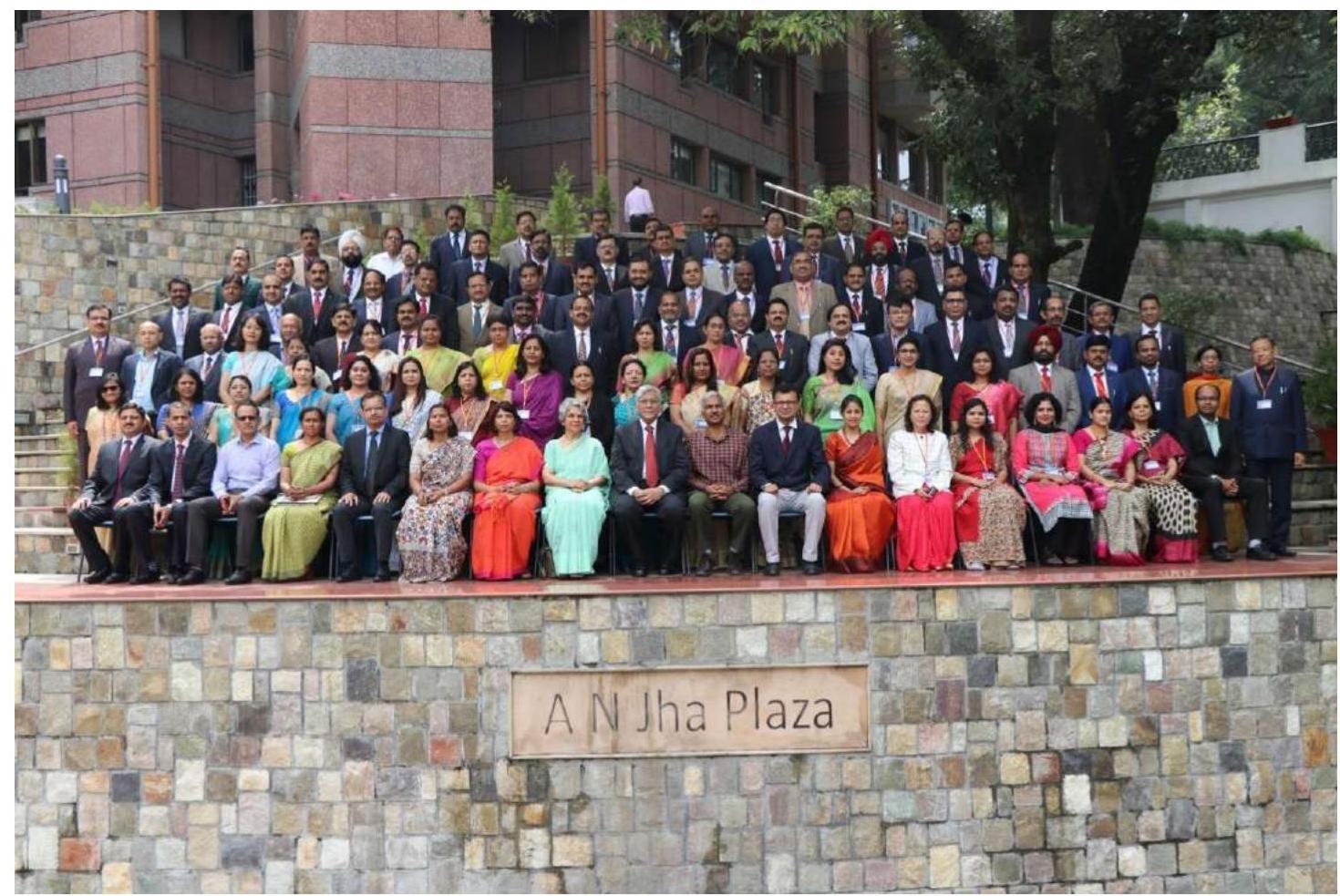
Group Photo of promoted IAS (120 th ITP)
Mid Career Training Programme (MCTP)
8.11 The issue of mandatory and structured mid-career training for IAS Officers was formalized with the introduction of the Mid-Career Training Programme (MCTP) in 2007. The objective of MCTP was to equip officers to handle the next, higher level of responsibilities at certain identified stages of their careers; broadly when they were primarily working in the field (7-9 years), at the policy formulation stage (14-16 years) and intersectoral policy formulation and implementation stage (26-28 years). These three stages were named Phase III,IV and V respectively. In the first three-year cycle, these programmes were outsourced by the Ministry to international/ national institutions of repute. However, since 2010, the mandate for the
design and delivery of the programme has been devolved by the Government to the Academy. The MCT Programme was reviewed by Government and its durations were shortened. The revised programme is as follows: Phase III (4 weeks); Phase IV (4 weeks including 1 week Foreign Study Tour) and Phase V (3 weeks).
Phase III Course (13 th MCTP)-04 Weeks
8.12 The Phase III course targets the officers of 7-9 years of seniority. The Academy organized this 4 weeks course from $09^{\text {th }}$ April to $04^{\text {th }}$ May, 2018. The focus of the course was on Reflections, Public Policy, Leadership, project appraisal, Negotiation and IAS in Perspective. Total 84 participants underwent the training course.
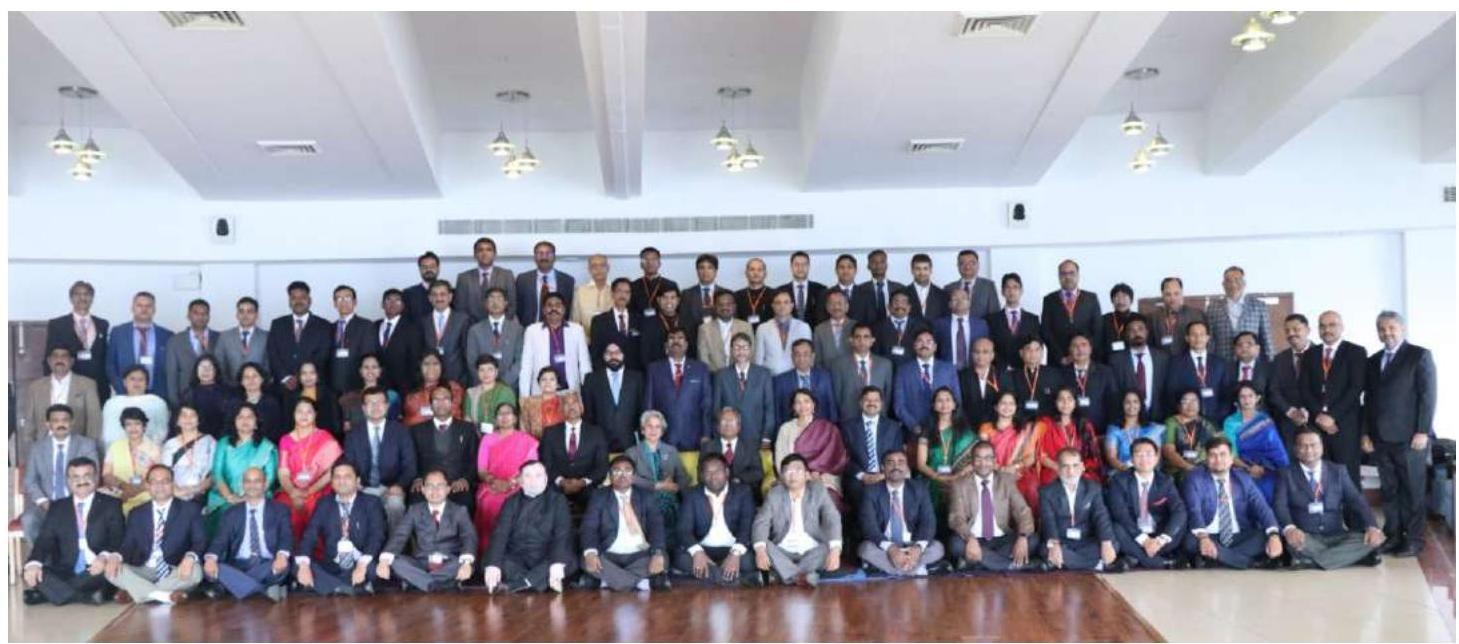
Phase IV Course (13 th Round) – 04 Weeks
8.13 The Phase IV Course targets middle level officers (of 14-16 years seniority) with a thrust on public policy. Besides enhancing domain knowledge of the participants, especially in the realm of various aspects of public policy, the Course
also aims at broadening their perspective and developing soft skills. 61 participants attended the course organized from September 24 to October 19, 2018. The Course included a short Foreign Study Tour to the Syracuse University Maxwell School of Citizenship & Public Affairs, USA.
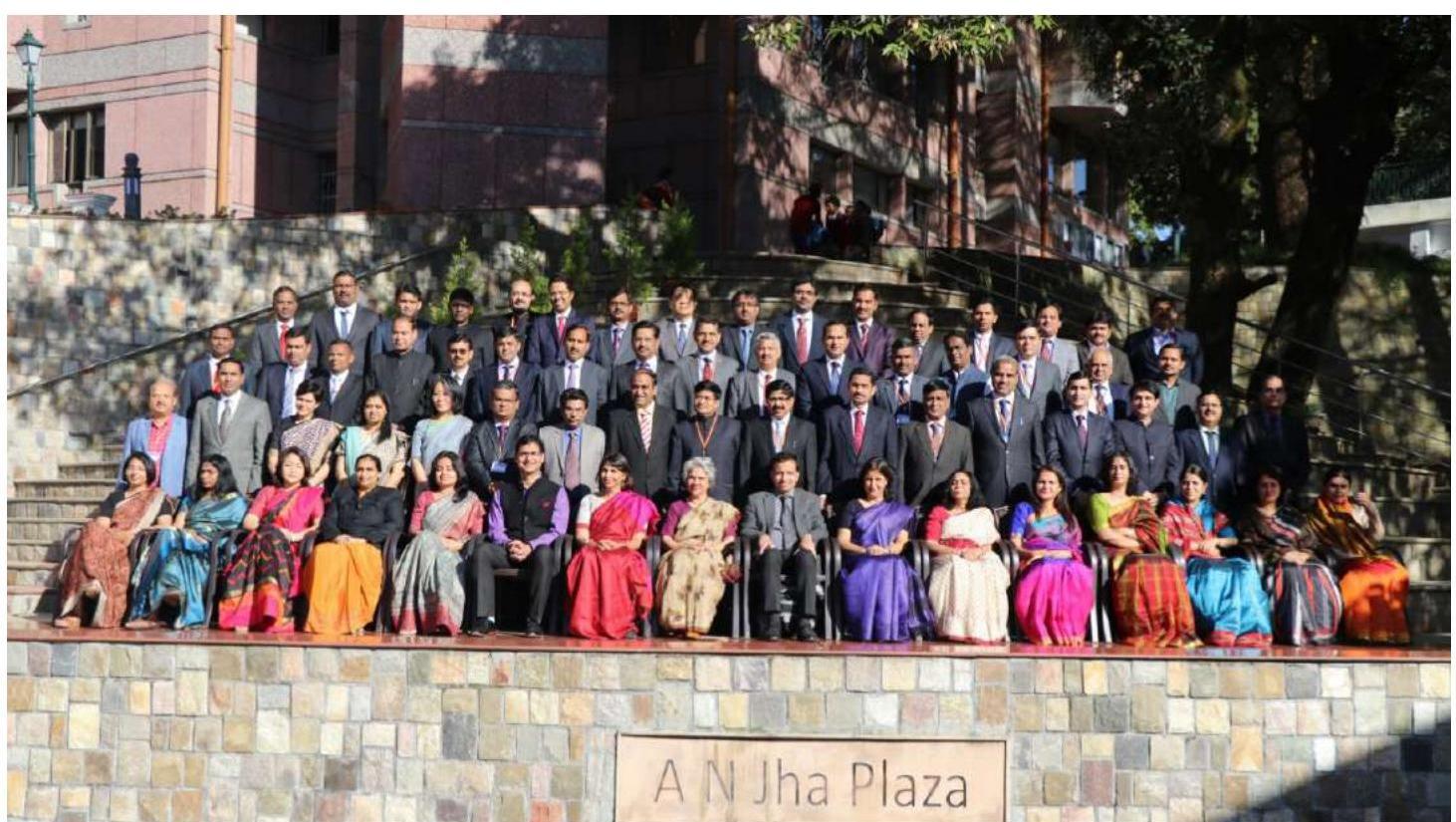
Group Photo of IAS Phase-IV Course (13 th Round)
Phase V Course (12 th Round) – 03 Weeks
8.14 The Phase V Course aims at developing strategic leadership skills in senior level IAS Officers (26-28 years seniority) for effective inter-sectoral policy formulation and strategic leadership in Government. 66 officers underwent the training course organized at the Academy from June 04 to 22, 2018.
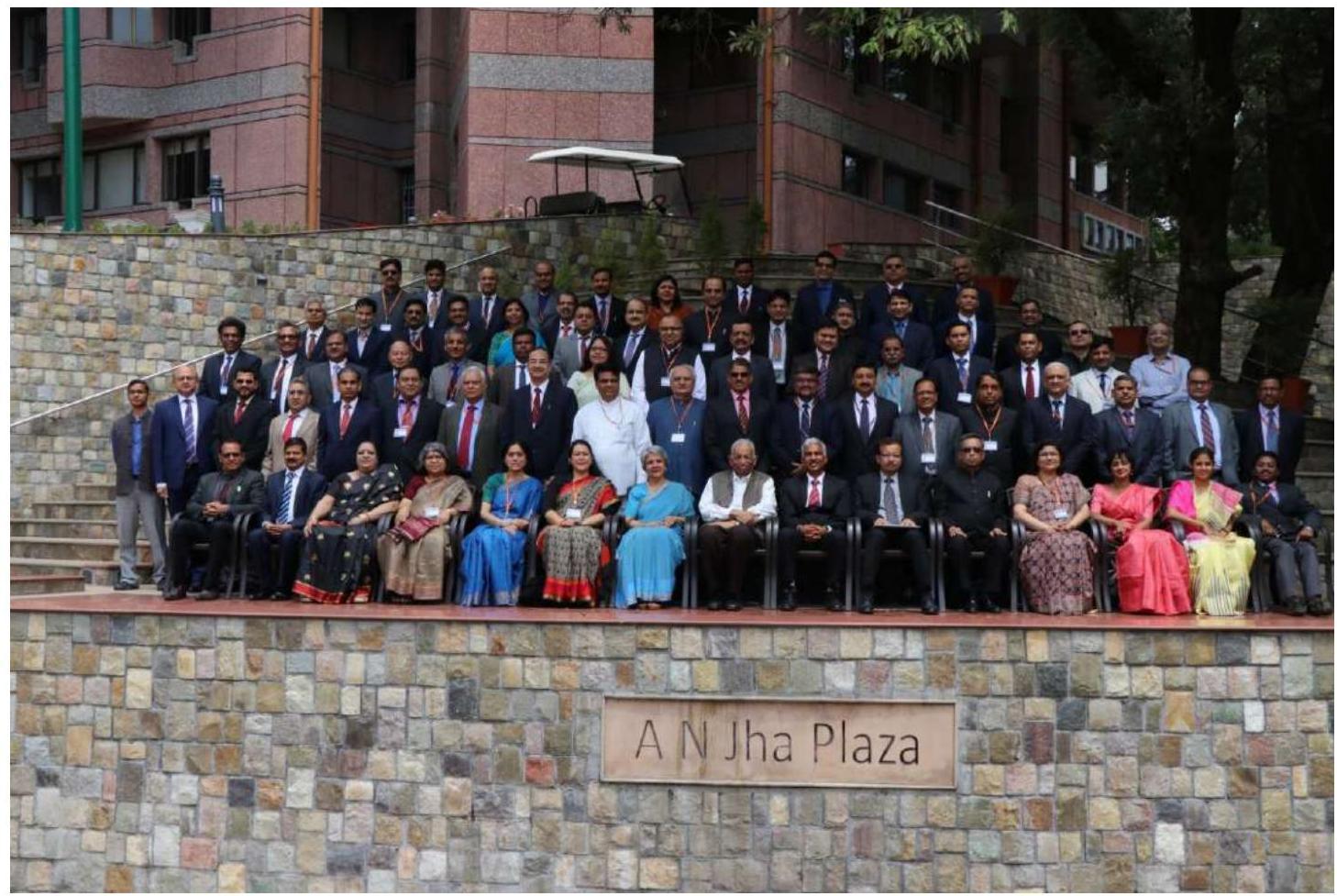
Group Photo of IAS Phase-V (12 th Round)
Other In-Service Training Courses/ workshop/ seminars
8.15 The Academy annually conducts short duration courses (ranging from one to two weeks) on a variety of subjects such as Joint Civil-Military Course on National Security, Courses on Gender, Disaster Management, etc.
Golden Jubilee Reunion
8.16 The Academy organizes a reunion every year for Officers who joined the service 50 years
ago. The first was held in 1997, the Golden Jubilee Year of the new nation, where the ICS and IAS Officers, who were in service at the time of independence, participated. Since then, the retired officers are called every year for a period of twothree days to share their rich experience with the faculty and Trainees. The Golden Jubilee Reunion for 77 officers of the 1968 batch (from various civil services who underwent FC at the Academy) was organized on May 25-26, 2018. The Reunion commenced with the inaugural ceremony on May 25, followed by a group photograph in the A.N. Jha Plaza. The participants were taken for a walk around
the Academy campus before lunch and postlunch there was a two hour interaction with the Trainees of the Phase-II 2016-18. The participants also had a session in small groups wherein they
deliberated on issues of importance for the civil services in the present context before the Reunion come to a close with the valedictory ceremony on May 26, 2018.
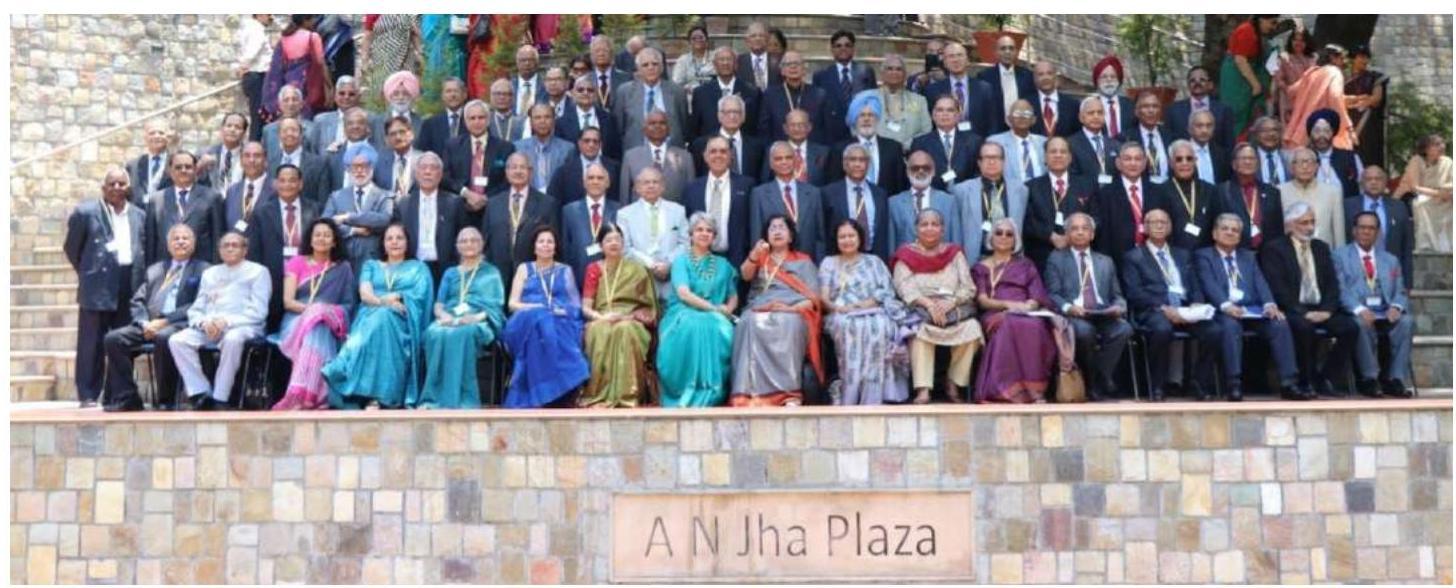
Golden Jubilee Reunion of 1968 BATCH
Joint Civil Military Training Program
8.17 The Joint Civil-Military Programme on National Security was initiated in the year 2001 following the recommendations of GoM on National Security pursuant to the Kargil Review Committee with the aim of fostering structured interface between Civil Servants and Armed Forces
officers for a shared understanding of National Security. Participants are drawn from the Civil Services, Armed Forces, and the Central Armed Police Forces.
In $23^{\text {rd }}$ JCM, 30 officers underwent the training course organized at the Academy from April 16 to 27,2018 .
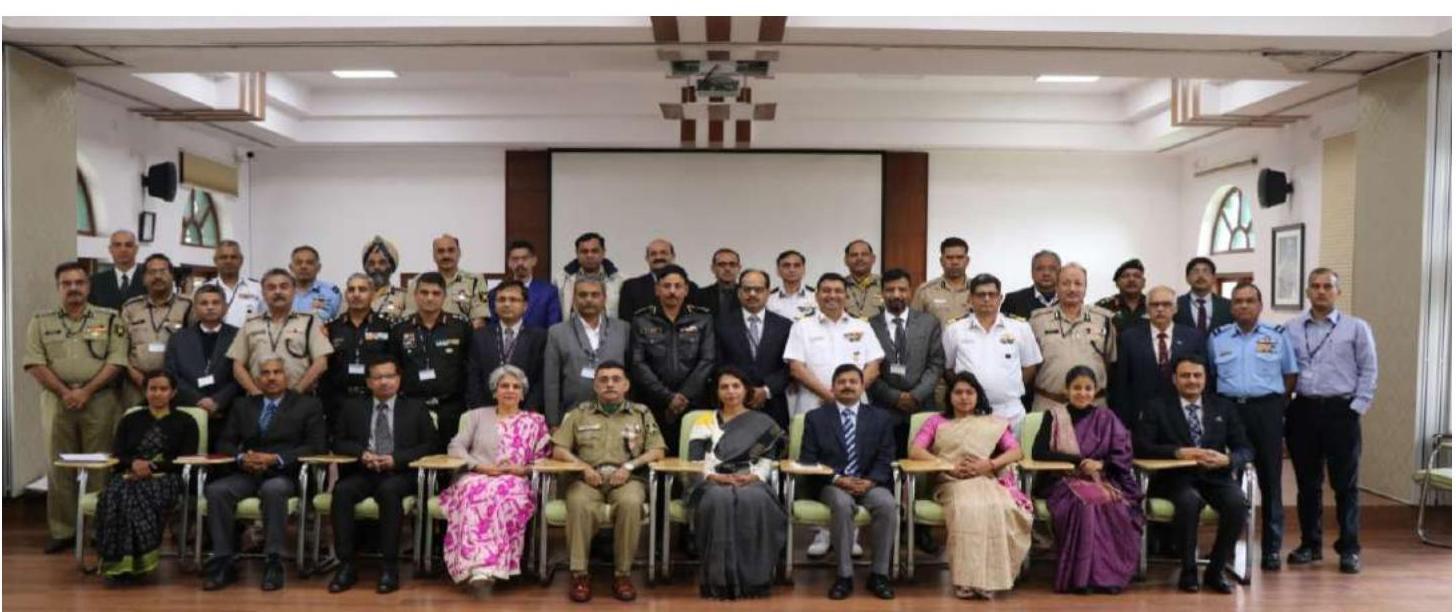
Group Photo of $23^{\text {rd }}$ Joint Civil-Military Training Programme
In $24^{\text {th }}$ JCM, 37 officers underwent the training course organized at the Academy from August 05 to 17, 2018.
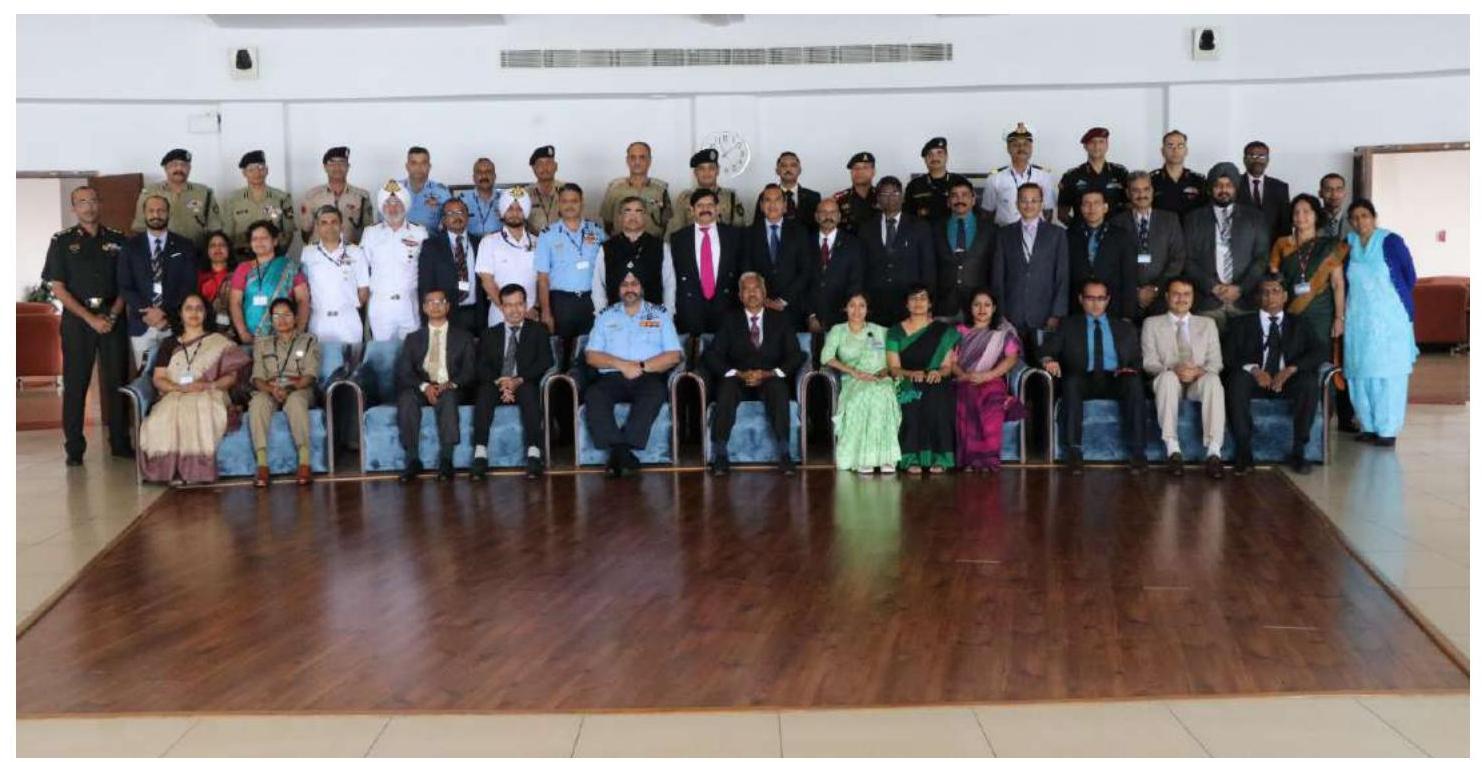
Group Photo of $24^{\text {th }}$ Joint Civil-Military Training Programme
Research Centres in the Academy
8.18 The centers of the Academy have been established with an aim to provide an avenue for initiating research in key areas of governance both from policy as well as implementation perspectives. The research is supposed to feed into the training curriculum and provide it with fresh insights. These centers are mostly funded either by line Ministries, like CRS, or are self-sustaining like the NGC and CDM and collaborate with various national and international funding agencies. Various Research Centers have been set up for undertaking actionresearch on domains linked to Academy’s mandate and to feed into training inputs. These are as follows:
Centre for Rural Studies (CRS)
8.19 The Centre for Rural Studies (CRS), a research Centers of the Academy was registered as
a scientific training and research society under the Indian Societies Registration Act 1860 on $1^{\text {st }}$ May, 2015. Since 1989, Ministry of Rural Development, Government of India has been supporting CRS in its endeavours by providing regular financé.
The Centre performs mainly four functions: (i) trains the officer trainees (OTs) of the Indian Administrative Service (IAS), broadly on land Administration and Rural Development, by exposing them to ground realities, providing tools for field research and evaluation of their work during various phases of the training; (ii) conducts research studies of different genre and disseminate knowledge gained in form of publications; (iii) organises national level workshops for regular exchange of views on land administration and rural development. (iv) Publishing International Journal of Land and Rural Studies (JLRS) by SAGE Publications, New Delhi.
Centre for Disaster Management (CDM)
8.20 Center for Disaster Management (CDM) is a research and training centre sanctioned by the Ministry of Home Affairs and established in the year 2003 under the umbrella of Lal Bahadur Shastri National Academy of Administration, as registered society and it is a nodal agency for training in Incident Command System (ICS).The Centre is involved in training/capacity building of officers belonging to the IAS and other Group – A civil services at induction as well as at in-service level in various aspects of disaster and emergency management through Classroom sessions, Case Studies, Experience Sharing Presentation, Panel Discussions, Workshops, Mock Drills, Scenario Building Exercise and Short film / Documentary. Apart from conducting training programmes on Fire Safety, Search and Rescue, IRS, DDMP, School Safety, the Centre is involved in various types of documentation/preparation and publication activities in terms of case studies, documentation of best practices, research papers, books and posters in national and international journals and many IEC training modules annually in the area of Disaster and Emergency management and Science and Technology. CDM has engaged in the provision of consultancy services in disaster management like conducting action research projects and to co-ordinate and organise, sponsor and aid seminars, workshops, study circles, working groups conferences for promoting research in disaster management and also collaborate with various national and international organizations, educational institutions in and outside government, which were engaged in research and training in disaster risk management. CDM is well equipped with GIS Softwares and conducted a number of activities related to GIS based risk assessment and
risk mapping, besides this CDM is also providing training on GPS in terms of acquiring field level GPS points and mapping of these points through GIS Software. Centre is also equipped with wireless and HAM radio equipments for robust communication network.
National Gender Centre (NGC)
8.21 The Centre was established in 1995, with the foremost aim of mainstreaming gender and child rights in policy, programme formulation and implementation in Government. NGC is a capacity building centre under the aegis of the Academy, driven by the mandate of gender mainstreaming and its commitment to build synergies with different institutions, working on gender equality, child rights and women’s empowerment.
Working towards that end, the Centre, since inception has been actively involved in designing and conducting thematic workshops, programmes and trainings including Training of Trainers for trainers and policy makers – both to enhance gender sensitization but also to increase capacities for gender analysis and gender planning. Since the Centre was established, the Centre has successfully ensured the mainstreaming of gender training into all courses at the LBSNAA viz. Induction trainings and in-service mid-career training programmes for IAS officers at all levels besides conducting programmes on myriad aspects for officers from All India/ Central Services.
Centre for Public Systems Management (CPSM)
8.22 The Centre for Public Systems Management was set up in 2016 by reconstituting the existing National Centre for Sustainable Community
Systems (NCSCS) for more broad-based coverage of issues in public systems and their management.
The LBSNAA, has already organized the following Training of Trainers Courses during January, 2018 to March, 2019:-
- ToT on Ambassadors of Evidence – January $13^{\text {th }}$ to $15^{\text {th }}, 2018$.
- Indian Flagship Course on Health Strengthening and Sustainable Financing- during $28^{\text {th }}-31^{\text {st }}$ May, 2018.
The Academy Spirit
8.23 LBSNAA seeks to imbue civil servants with the required attitude and values expected in public service. The skills and knowledge required by a professional civil servant are relatively easier to impart, and these have traditionally been the strength of the Academy. However, to positively influence in the brief period available to us, the attitudes and values of intelligent young persons in their mid-twenties and thirties, coming from diverse backgrounds, is a more challenging task.
8.24 It is generally argued that for public service one needs integrity, moral courage, empathy with and respect for the underprivileged, and freedom from any sectarian prejudices based on religion, region, caste, class or gender. To nurture these values, Trainees are encouraged to participate in diverse social activities. They are given responsibilities for improving the Lalita Shastri Balwadi School, where LKG/UKG & Class-I are conducted at a concessional rate for the children of the employees and the public besides conducting regular coaching classes for poor students of the neighborhood. Trainees also do shramdaan to clean their premises and to instill a
dignity of labour. Emphasis on caring for the poor, listening to the people, providing safety nets for the vulnerable, and being open and transparent runs as a continuous thread in all the courses and interactions. In addition, Trainees are divided into counselor groups where they are able to articulate their views in an open and frank atmosphere. This forum serves as a great means of eliciting their views and conveying the right messages to them.
The Academy as Alma Mater
8.25 All Trainees in the All India Services and Central Services begin their careers from the proverbial “gaumukh” of the civil service, the Lal Bahadur Shastri National Academy of Administration at Mussoorie. As a result, this institution provides a foundation that paves the way for lifelong professional and personal associations among officers across different civil services. These officers look back to the Academy with great nostalgia and also draw inspiration from the values and ideals instilled in them during their formative years.
Facilities
8.26 The Academy is well-equipped with good training infrastructure in terms of academic buildings, classrooms, hostels and other support infrastructure. Some of the key infrastructure facilities are given below:
- Academic \& Administrative Blocks
Karmashila
Dhruvshila
Gyanshila
Aadharshila
- Gandhi Smriti Library – stocks 1.71 lac books, 279 journals/magazine/Newspapers and 7 e-resources databases
- Officers Mess – can cater to around 500 persons at 3 locations
- Sports – well-equipped Officers Club, Riding Ground and Shooting Range
- Health – well-equipped Medical Centre
- Executive Hostels – 4 executive hostels with 167 rooms
- Officer Trainee Hostels – 3 hostels with 131 rooms
- Wi-fi campus
Faculty
8.27 The Faculty comprises a blend of senior administrators and academicians and researchers. The administrators combine the richness of their field experience with strong academic achievements to provide a stimulating atmosphere for learning. The Academy is presently headed by the Director Smt. Upma Chawdhry, IAS, and an officer of the 1983 batch of Himachal cadre in the rank of Secretary to the Government of India.
Institute of Secretariat Training and Management
Introduction
8.28 The Institute of Secretariat Training and Management (ISTM) is imparting training to the officers of the Central/State Governments, Public Sector Undertakings & Autonomous Bodies. Originally set up with the objective of conducting foundational and in-service training programmes for Assistants and Section Officers of the Central Secretariat, the range of the activities of the Institute has increased exponentially over the last seven decades. In addition to the in-house training
programmes, the Peripatetic Training provided by the Institute to the officials of State Governments and Union Territories in Behavioral Skills, Management Techniques, Financial Management and Office Management, is of particular significance. On specific request from Central Government Departments, Autonomous Bodies, Public Sector Organizations, the Institute also organizes special programmes addressed to the specific customer needs in different areas.
8.29 From the year 2007-08,ISTM is also involved in implementation of the Central Secretariat Service Cadre Training Plan (CSS-CTP) and from 2011 onwards Central Secretariat Stenographer’s Service Cadre Training Plan (CSSS-CTP), which envisages mandatory training programmes having linkages with career progression up to Director level officers.
Training Programmes
8.30 ISTM conducts following programmes in various categories:
i. Foundational and in-service Courses conducted as per new CSS and CSSS Cadre Training Plan
ii. Induction Training for Group ‘A’ services of ICoAS, and Director General Civil Aviation (DGCA). CVOs of CVC
iii. Induction Training Component for various Group ‘A’ service like IAS, IFS, IRS, ISS, IES, ITS, ICLS, IDES, IIS \& IRTS probationers.
iv. Personnel Administration and Office Management
v. Financial Management
vi. Management Services
vii. Behavioral Training
viii. Training of Trainers, Master & Recognized Trainers Development Programmes sponsored by DOPT
ix. Peripatetic Training Programmes
x. Right to Information
xi. Prevention of Sexual Harassment of Women at Workplace
xii. Citizen Centric \& Service Delivery Approach
xiii. Organization Specific Programmes/ Cadre Specific Programmes
xiv. Capacity Building Programmes for State Civil Services Officers and State Secretariat Service Officers of North Eastern States sponsored by DoPT
xv. Orientation Training Programmes on Office Procedure for IAS Officers sponsored by DoPT.
xvi. Newly introduced training programmes on Big Data Analytics ( Basic and Advanced), Workshop on Public Policy Formulation (WPPF), Workshop on EFC/SFC, OTPPreventive Vigilance, OTP-Drafting of charge sheet in Disciplinary matter.
xvii. Three-day State Category Training Programmes (SCTP) sponsored by DoPT for Divyang Employees of Central and State Government on Office Management, Computer Applications, Financial Management and Establishment Rules. Also 3 days SCTP programme on Sensitization of Government functionaries on issues relating to Minorities.
8.31 Number of Training programmes and Training weeks Planned \& conducted during the year 2018-19.
Table 1
| SI. No. | Programmes | No. of Programmes | Training weeks |
|---|---|---|---|
| 1. | Number of programmes planned / scheduled during 2018-19 |
183 | 504 Weeks 4 days |
| 2. | Programmes Conducted during 2018-19 | 313 | 620 Weeks \& No. of participants 9243 |
8.32 Special Programmes for Officers of DoPT
(a) Special Training Programme for 176 IAS officers sponsored by Department of Personnel \& Training, conducted on Office Procedure on 06.07.2018.
(b) Three one-hour training programmes were conducted for officials of Department of Personnel \& Training at North Block, New Delhi, on Right to Information Act, 2005
8.33 Other Non-Calendar Training Programmes
| SI No |
Name of the programme | Number of programmes conducted during 2018-19 |
No. of training weeks and participants |
|---|---|---|---|
| 1. | Organisation Specific Programmes | 111 | 131 Weeks 4 day (3264 participants) |
| 2. | Cadre Specific Programmes | 09 | |
| 3. | Peripatetic Training Programmes | 18 | 8 weeks 4 days (740 participants) |
| Total | 138 | 140 Weeks 3 days ( 4004 participants) |
8.34 Consultancy Projects
ISTM is also engaged in the research and consultancy projects. The consultancy projects relating to following Government Departments/ Organizations have been conducted / ongoing at present: –
(a) Consultancy work
i. Work-study and Cadre Review of the Farakka Barrage Project
ii. Review of Recruitment Rules of IIFT (on going)
iii. Work-study and restructuring of Kendriya Vidyalaya Sangthan (KVS) non-teaching Cadre (on going)
iv. Work study of hydrological observation sites of “Central Water Commission”.
(b) Audit of Proactive disclosure under RTI Act, 2005
i. Audit Report of Bank of Maharashtra, Pune (on going)
ii. Audit Report of Kamarajar Port Limited, Chennai
iii. Audit Report of Central Administrative Tribunal (CAT)
iv. Audit Report of National Institute of Wind Energy (NIWE)
v. Audit Report of Maulana Azad National Urdu University(on going)
vi. Audit Report of Artifical Limbs Manufacturing Corporation of India.
New Initiatives
8.35 Inclusion of additional module in Training Management Information System (TMIS)
The Training Management Information System (TMIS) project was initiated in the year 2011-12. TMIS has been evolved as a robust digital MIS and it is continuously enabling ISTM to establish a complete paperless system for the following:-
- Development and implementation of RTI Portal
- Auto Populate at participant’s end:
i. Participant list &
ii. Weekly Calendar
iii. Auto Populate at course director’s end:
iv. course circular of calendar course.
v. acceptance letter
vi. relieving letter of all the courses.
vii. Guest Faculty Receipt
viii. Alert system for course circular
3. Online Hostel Inventory
4. Hostel Allotment Module
5. Canteen Feedback Graph Generation
6. Suggestion Box
8.36 Special Training Programmes/ Sessions/ Workshops/ Seminars
(i) A two-day Workshop on Sexual Harassment of Women at Workplace (Prevention, Prohibition and Redressal) Act, 2013
(ii) International Yoga Day was celebrated in ISTM on $21^{\text {st }}$ June, 2018.
(iii) Service Books of all employees of ISTM have been digitized and e-Service Book made operational
(iv) Valedictory Function of Assistant Section Officers (Direct Recruits) was successfully completed on $13^{\text {th }}$ July, 2018 by Dr. Jitendra Singh, MoS(PP).
(v) A Seminar on “Government initiative on Disability matters & their status” was organized on $26^{\text {th }}$ May, 2018.
(v) A Seminar on “New Methodologies \& ideas for effective delivery of training” was organized on $3^{\text {rd }}$ August, 2018.
(vi) A seminar on “Use of Multimedia \& Graphics in PPTs used in the classrooms”.
(vii) A Seminar on”A path towards true Happiness”.
(viii) A Seminar on “India’s Geo-Political ScenarioSecurity Challenges”.
(ix) A Seminar on “New Health Policy of Government”
(x) A Seminar on “Introductory Workshop on Competency Development Framework”
(xi) An Induction Training Programme was conducted for part time Chief Vigilance Officers (CVOs) from 10th to14 th September, 2018.
(xii) Soft copy of the updated reading material now provided to all the participants on their e-mail or pen drive.
(xiii) Citizen’s/ Client’s Charter of ISTM has been updated on $24^{\text {th }}$ April, 2018 and same is available on the ISTM website www.istm.gov. in
(xiv) Master Trainer Development Programme on Direct Trainer Skill and Design of Training (MTDP-DTS \& DoT) have been organized successfully at ISTM for Potential Recognized Master Trainers.
(xv) Post Training Seminar on Level-E training programme was conducted on $18^{\text {th }}$ and $19^{\text {th }}$ June, 2018, in which 16 CSS officers participated and made presentation to improve the structure of the training programme.
(xvi) Development of e-learning module in association with IIT Madras, IGNOU, C-DAC etc.
(xvii) Inauguration \& Implementation of e-Office in ISTM.
(xviii) Development \& Implementation of RTI Portal of ISTM.
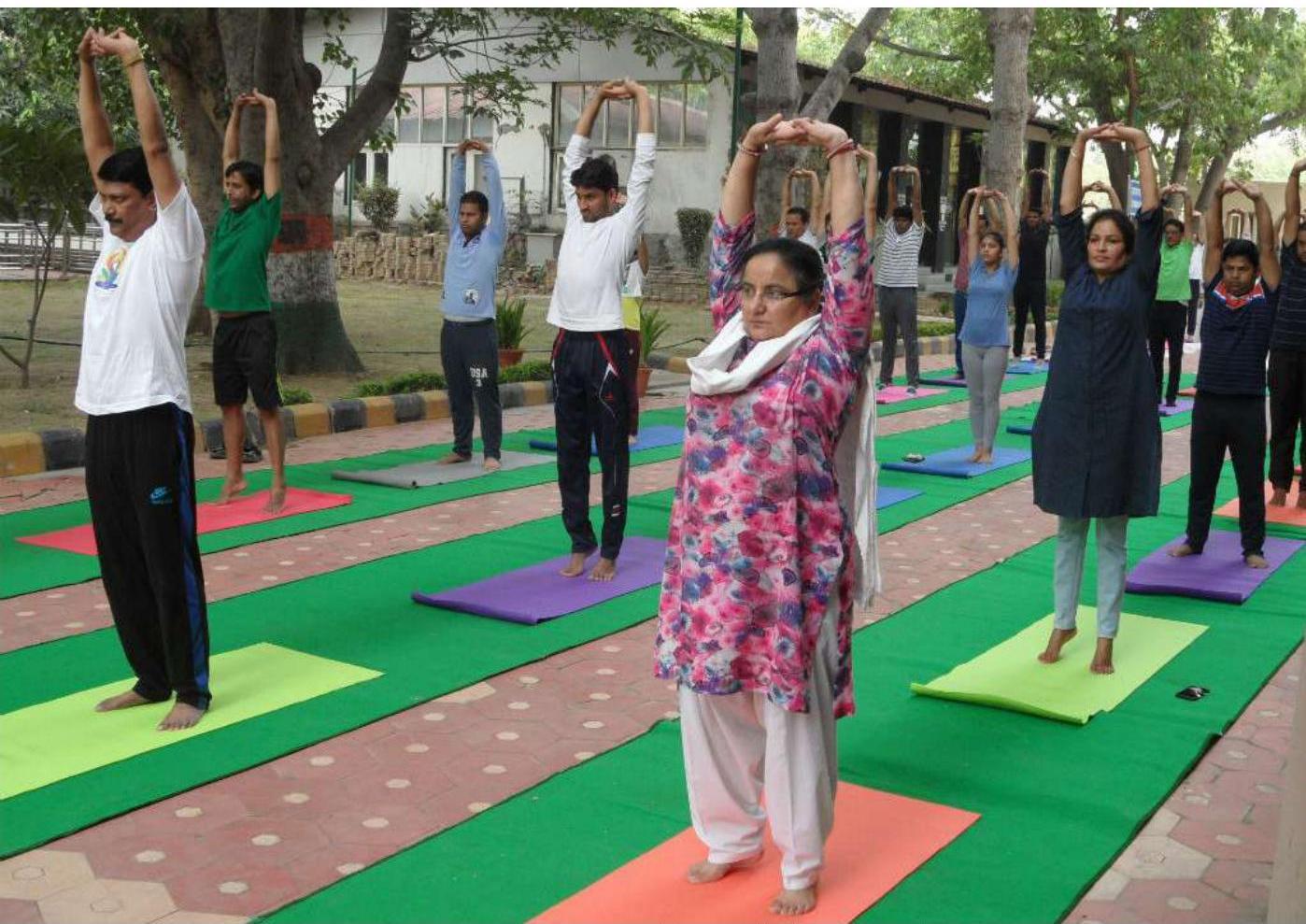
International Yoga Day Celebration (21st June, 2018)
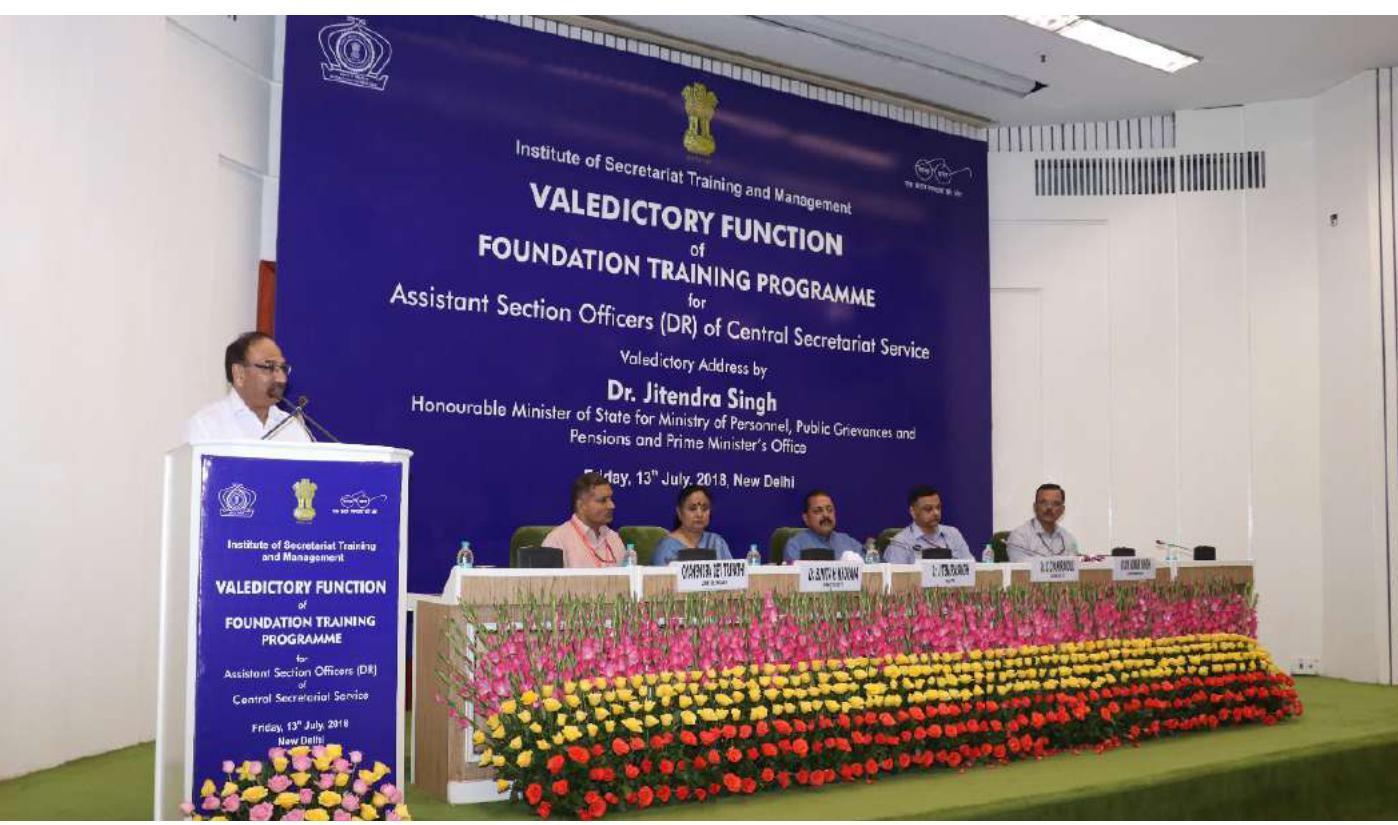
Valedictory Function of ASO (DR) – 13th July, 2018
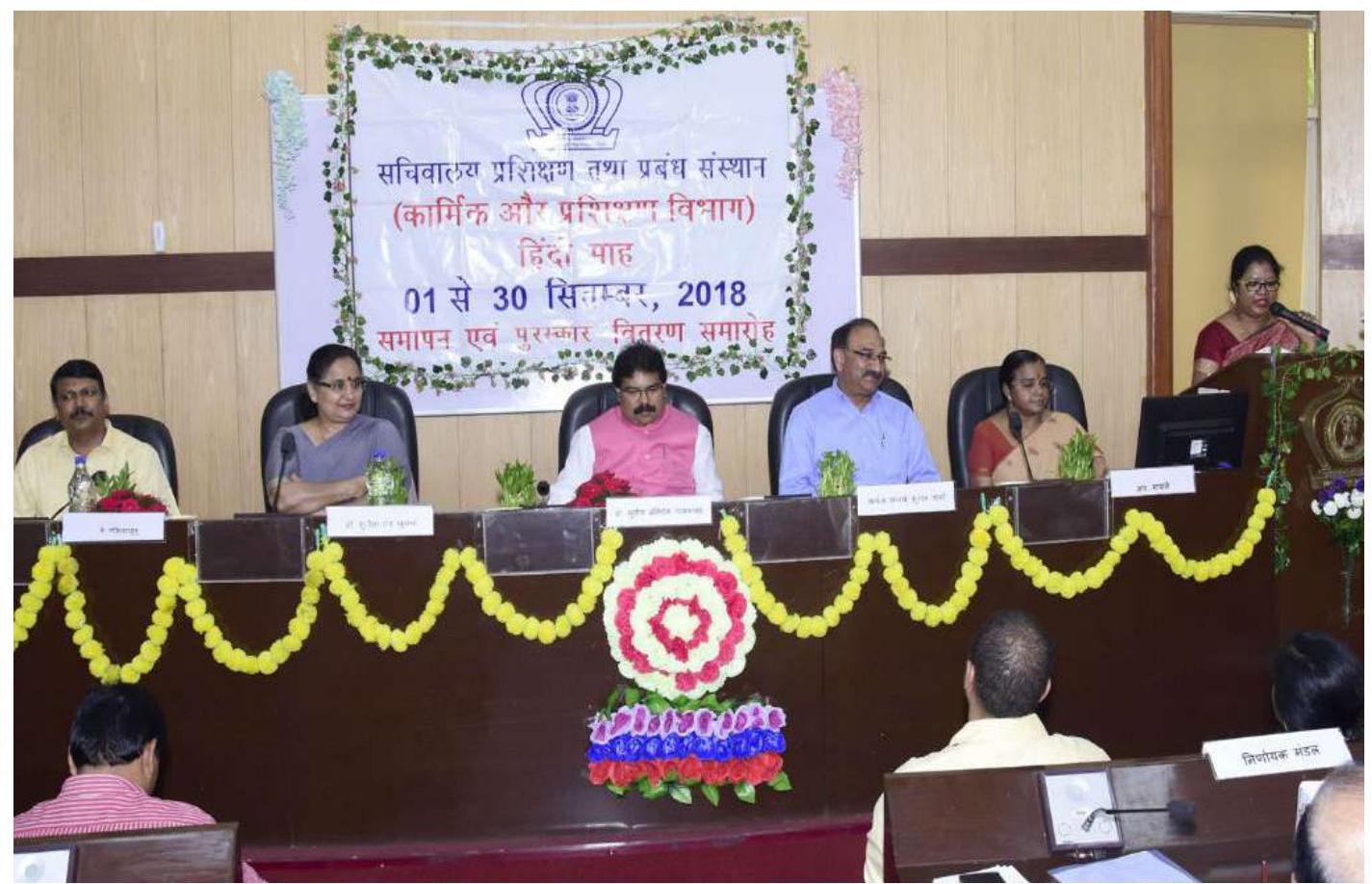
Hindi Maah Celebration on 18th September 2018
8.37 New Initiatives in Training during the year 2018-19
- (i) Introduction of three-day Workshop on Analytics for Big Data (Basic & Advanced) in Government.
- (ii) Introduction of two-day Orientation Training Programme on Drafting of Charge Sheet in Disciplinary matters.
- (iii) Introduction of one-day Orientation Training Programme on Preventive Vigilance.
- (iv) Introduction of two-day Workshop on Expenditure Finance Committee (EFC) / Standing Finance Committee (SFC).
- (v) Introduction of two-day Orientation Training Programme on Retiring Government Officials.
- (vi) Introduction of three-day MS-Access Training Programmes.
- (vii) Introduction of three-day MS-Excel (advanced) Training Programme.
- (viii) Introduction of one-week Workshop on Public Policy Formulation for Government Officials.
- (ix) Introduction of four-day Workshop on Process from Policy Formulation & Legislation conducted from 14th to 17th January, 2019.
- (x) Introduction of three-day training programme on Managerial and Supervisory Skills conducted on 21st to 23rd January, 2019.
8.38 Library Resources
ISTM has Library with all the modern facilities consisting of more than 17,450 books besides modest video collection. ISTM also subscribed to DELNET online services and provided access to faculty and staff members to update themselves. The Institute has built up a rich reservoir of continuously updated training material for distribution to its course participants
8.39 Infrastructural Development
The following infrastructural facilities have been undertaken at ISTM during 2018-19: –
i. Replacement of electrical panels in the Library Building during the year 2018-19-The work is in progress
ii. Installation of Security System (CCTV at all the entry/exit gates, Reception, Corridors in the Hostel Block, Library Building, Administrative Block, Cafeteria, Dining Hall etc of ISTM-The work is in progress
iii. Up gradation of ICT Laboratories with latest systems including replacement of furniture/ minor civil works- The work is in progress
iv. Provision of Lift (to facilitate differently abled persons barrier free access in Administrative Block)- The work is in progress
v. Repair, Rehabilitation and sprucing up of library building in ISTM Campus- Work completed.
vi. Bio-gas plant in Hostel block with associated facilities for use in hostel kitchen-The work is under consideration
vii. Development of a new Conference room on the second floor in Administrative buildingThe work is under consideration
viii. Conversion of existing residential Type- I quarters as Women Hostel for the participants and dedicated accommodation for FacultyThe work is under consideration.
8.40 Blood Donation
During the year 2018-19, 02 blood donation camps were organized and 70 units of blood were collected. Four blood donation camps were organized during the year 2017-18 at ISTM, in which 126 trainees and members of faculty donated blood.
8.41 Redressal of Grievances
Three grievances received during 2018-19 have been disposed-off in time.
8.42 Public Service
The trainees (present and past) and also some of the faculty members visit at regular intervals to Rain-Baseras and Dharmashalas of major hospitals of Delhi and arrange for medicines, radiological and pathological tests to the poor patients as prescribed by doctors. In winters, they also distribute woolen blankets/ clothes in the odd hours of the day to the really needy people. Through these initiatives it is expected that these officials/officers will be able to develop a positive attitude which is expected to be reflected in their people-friendly, responsive and sensible approach at work.
9
CHAPTER
Administrative Vigilance Division
9.0 Administrative Vigilance Division is responsible for examination of disciplinary cases in respect of Indian Administrative Service officers working under the Central Government. The Division also processes cases referred by the State Governments and Ministries / Departments under Government of India on the following issues:
- Proposals from State Governments seeking to impose major penalty of dismissal / removal / compulsory retirement on members of IAS;
- Proposals from State Governments seeking permission under the AIS (DCRB) Rules to initiate action against retired members of IAS;
- Proposals from State Governments for imposing penalty of cut in pension against IAS officers;
- Proposals to initiate disciplinary proceedings / suspension of IAS officers working under the Government of India;
- Appeal against suspension submitted by IAS officers serving in the States;
- Requests for sanction for prosecution under the Prevention of Corruption Act, 1988 against the above categories of officers;
- Advice / clarification to the State Governments / Departments on the procedural aspects of disciplinary proceedings;
- Vigilance status of IAS officers at the time of their empanelment / training / posting on deputation etc. To facilitate this function, a
Computerized Vigilance Information System is in operation with a central data base which can be accessed by the requisitioning Divisions concerned of this Department;
- Handling of Privilege Notices and Complaints from Members of Parliament against IAS Officers received from the Lok Sabha / Rajya Sabha Secretariat.
Disciplinary Proceedings
9.1 Final order in disciplinary proceedings was issued in 01 case during 2018-2019.
Sanction for Prosecution
9.2 Orders of sanction for prosecution against IAS Officers under Prevention of Corruption Act, 1988 was granted in 01 proposal in r/o 04 IAS officers and sanction was denied in 01 case in r/o 01 IAS officer during 2018-2019.
Monitoring of Proposals of Sanction for Prosecution under provisions of Prevention of Corruption Act, 1988.
9.3 In terms of para 2(ix) of DoP&T O.M. No.399/33/2006-AVD-III dated 06.11.2006, the delayed cases of sanction for prosecution were reviewed by the Committee chaired by the Secretary (Personnel) on 03.05.2018, 02.08.2018, 17.12.2018 and 28.02.2019 during 2018-19.
Complaints against IAS officers
9.4 During 2018-2019, 625 complaints were received and processed and 596 complaints were finally disposed of.
Privilege Notices and Complaints from Members of Parliament against IAS officers
9.5 During 2018-2019, 12 Privilege notices were received from the Lok Sabha / Rajya Sabha Secretariat and processed and 02 notices were finally disposed of.
9.6 During 2018-2019, 06 complaints were received from Hon’ble Members of Parliament and processed and 02 complaints were finally disposed of.
9.7 Administrative Vigilance Division is also responsible for examination of disciplinary cases received from the Ministries / Departments in respect of Group ‘A’ officers of the Central Secretariat Service (CSS) and Central Secretariat Stenographers Service (CSSS) for initiation of disciplinary proceedings under Rule 14 (Major penalty), Rule 16 (Minor penalty), Rule 19 of CCS (CCA) Rules, 1965 and under Rule 9 of CCS (Pension) Rules.
During 2018-19, final orders in 09 disciplinary cases against the Group ‘A’ officers of CSS were issued and two Group ‘A’ officers of CSS were placed under suspension/ deemed suspension. Prosecution sanction in respect of 01 Group ‘A’ officer was issued during this period.
Central Vigilance Commission
Introduction
9.8 The Central Vigilance Commission is the
apex integrity institution mandated to fight corruption and to ensure integrity in administration. It is a statutory multi member body vested with the superintendence of vigilance administration in the Central Government and its organisations. The Commission also endeavours to create awareness amongst civil society and the public at large towards achieving transparency, accountability and corruption free governance with its outreach measures.
Statutory Provisions
9.9 The Central Vigilance Commission (CVC) was set up by the Government of India through a Resolution vide No. 54/7/64 dated 11.02.1964 and was accorded statutory status by the Central Vigilance Commission Act, 2003 (No. 45 of 2003), notified in the Gazette of India Extraordinary on 12.09.2003.
9.10 The Commission is empowered to inquire or cause inquiries to be conducted into offences alleged to have been committed under the PC Act 1988 by specified categories of public servants and in terms of clause (b) of sub Section (2) of Section 8 of the Central Vigilance Commission Act, 2003 and subsequent notification issued vide $18^{\text {th }}$ March 2004 and $12^{\text {th }}$ September 2007.
The specified categories of officers are the following:
- Members of All India Services serving in connection with the affairs of the Union and Group ‘A’ officers of the Central Government;
- Chief Executives and Executives on the Board and other officers of the level of E-8 and above in Schedule ‘A’ and ‘B’ Public Sector Undertakings of the Central Government;
- Chief Executives and Executives on the Board and other officers of the level of E-7 and above in Schedule ‘C’ and ‘D’ Public Sector Undertakings of the Central Government;
- Officers of the rank of Scale V and above in the Public Sector Banks;
- Officers in Grade ‘D’ and above in Reserve Bank of India, NABARD and SIDBI;
- Managers and above in respect of General Insurance Companies;
- Senior Divisional Managers and above in Life Insurance Corporation of India; and
- Officers drawing grade pay of Rs 8700/- per month (pre-revised) and above on Central Government DA pattern, as may be revised from time to time, in societies and local authorities owned or controlled by the Central Government.
9.11 The Commission exercises superintendence over the vigilance administration of the Ministries/ Departments/Organisations of the Central Government.
9.12 The Commission is mandated to exercise superintendence over the functioning of CBI and monitoring cases taken up by CBI for investigation under PC Act.
9.13 The Central Vigilance Commission has been designated as the agency to receive and act on complaints or disclosure on any allegation of corruption or misuse of office from whistle blowers under the “Public Interest Disclosure and Protection of Informers’ Resolution” (PIDPI), 2014, which is popularly known as “Whistle Blowers” Resolution. The Commission is also empowered as the designated agency to take action against
complainants making motivated or vexatious complaints.
9.14 The Commission conducts its activities concerning inquiry or causing inquiry through the Chief Vigilance Officers (CVOs), who are the extended arms of the Commission.
9.15 As per Section 14 of the CVC Act, 2003, the Commission submits an Annual Report of its activities to the President within six months of the close of the year under report. The report also contains a separate part on the functioning of the Delhi Special Police Establishment (DPSE) in so far as it relates to sub-section (1) of section 4 of the DSPE Act, 1946 (25 of 1946).
Multi Pronged Strategy of the Commission to combat Corruption
Punitive, Preventive and Participative Vigilance
9.16 As a part of its multi-pronged strategy the Commission has been stressing on not just punitive but preventive and participative vigilance measures to combat corruption.
Punitive Vigilance
9.17 As far as punitive vigilance is concerned, the Commission feels that time-bound and effective punitive action resulting in award of exemplary and adequate punishment deters others from committing such misconduct. It tenders advice on issues referred to it by various organisations, reviews the progress of work periodically through the mechanism of annual sectoral reviews and other meetings, guides the Chief Executives and the CVOs of various organizations on issues pertaining to vigilance, seeks organizational responses and suggests systems improvement in areas attracting
complaints, conducts direct inquiries on certain sensitive complaints and also summons officials for hearings on specific issues. All this is done as part of comprehensive effort for better vigilance administration.
The advisory role of the Commission extends to references received from Departments/Organisations of the Central Government in individual cases of officers covered under its jurisdiction and consists of a two stage mechanism i.e. on investigation /inquiry reports before initiating disciplinary action termed as first stage advice and on completion of disciplinary proceedings as to the nature of penalty or otherwise termed as second stage advice.
Preventive Vigilance
9.18 The Commission has been laying stress on the importance of preventive vigilance in curbing corruption. Preventive vigilance is broadly a package of measures to improve systems and procedures to reduce discretion and public interface and thereby eliminate corruption. The Commission believes in the dictum – Prevention is always better than cure and therefore, it has been strongly focussing on identifying the loopholes in the system to pre-empt the occurrence of corruption. Although potential areas of corruption are specific to organisations/sectors, there are some broad areas common to all organisations, such as procurement, sale of goods and services, allocation of scarce natural resources, human resource management (recruitment, promotion, transfer and postings), delivery of services to the common citizen, implementation of rules and regulations which remain more susceptible to corruption. The generic measures to combat corrupt practices
include simplification and standardization of rules, leveraging technology, rethinking the structure of core processes in order to better fulfil the objectives of the organization and enhance transparency and accountability, regular and effective inspections, periodical rotation or transfer of staff, training and awareness of employees and public etc. The Commission believes that preventive vigilance measures will lead to better management and governance resulting in improved deliverance of services and operational results. The thrust of the Commission on preventive vigilance has led to organisations revisiting their processes and has also led to many new initiatives and innovations. A booklet titled ‘Preventive Vigilance Initiatives and Outreach Activities’ has been issued by the Commission to share initiatives of 42 best practices and Outreach Activities of 20 organization on preventive vigilance, for wider dissemination during the Vigilance Awareness Week, 2018. Compilation of ‘100 Top Bank Frauds’ analysed by the Commission to identify the loop holes and suggestion for systemic improvements has been published by the Central Vigilance Commission which is also available on CVC’s website www.cvc. nic.in.
Integrity Pact
9.19 The concept of Integrity Pact envisages an agreement between the prospective vendors /bidders and the buyers committing the persons / officials of both the parties, not to exercise any corrupt influence on any aspect of the contract. As part of this scheme, organisations are directed to appoint a panel of Independent External Monitors in order to ensure proper implementation of the Integrity Pact.
Integrity Index
9.20 The Commission is developing an Integrity Index based on bench marking of internal processes and controls within an organization as well as management of relationships and expectations of external stake holders.
9.21 The Integrity Index will bring out annual scores/rankings of Public Sector Undertakings/ Public Sector Banks and Financial Institutions/ Departments/Ministries of Government of India by linking the essential drivers of vigilance with long term efficiency, profitability and sustainability of public organizations and create an internal and external ecosystem that promotes working with Integrity in public organizations.
9.22 Central Vigilance Commission has adopted a research-based approach for creating an integrity index that various organizations can use to measure themselves and which will evolve with changing needs and with this view IIM-Ahmedabad has been engaged to develop the Integrity Index. Being a new initiative, initially 25 organizations have been selected for development of the Integrity Index. Subsequently, it is proposed to extend the Integrity Index concept to all other CPSUs and organizations of Government of India.
Participative Vigilance
9.23 Participative vigilance seeks engagement with the citizens to root out corruption from the country. The most notable participative vigilance measure of the Commission is the observation of the Vigilance Awareness Week every year with a specific theme to create awareness amongst citizens, stakeholders, private sector, especially among youth and students about the menace of
corruption and the need for its eradication. This outreach activity across the country is conducted every year. During the week, all the Ministries/ Departments, PSUs, Banks, etc. are engaged extensively, especially reaching out to schools and colleges, NGOs, etc. under an action plan prepared by the Commission to spread awareness amongst the common citizens. The activities inter alia include organising workshops, seminars, debate, competition, slogan / essay writing, cartoon, painting contests, etc. at urban and sub-urban level such as school, colleges, institutes, etc. The Commission also encourages the organisations to conduct similar outreach activities throughout the year to keep the anti-corruption momentum alive and the officers of the Commission actively participate in such activities. The theme of the Vigilance Awareness Week, 2018 was “Eradicate Corruption- Build a New India”(“भ्रष्टाचार मिटाओ-नया भारत बनाओ”).
9.24 The Vigilance Awareness Week commenced with the taking of the Integrity Pledge by Shri K.V. Chowdary, Central Vigilance Commissioner, Dr T.M. Bhasin, Vigilance Commissioner and Shri Sharad Kumar, Vigilance Commissioner along with all employees of the Commission. Hon’ble President of India presided over the function at Vigyan Bhavan, New Delhi on $31^{\text {st }}$ October 2018 on the occasion of Vigilance Awareness Week 2018.
9.25 Activities conducted within organizations included distribution of pamphlets/handouts on preventive vigilance activities, whistle blower mechanism and other anti-corruption measures, and conduct of workshops and sensitization programmes for employees and other stake holders on policies/procedures of the organization and preventive vigilance measures. Other activities
included publication of journals/newsletters on vigilance issues, systemic improvements and good practices adopted for wider dissemination and awareness, conduct of various competitions such as debates, quiz etc. for the employees and their families on issues relating to anti-corruption and the use of organizational websites for dissemination of employees/customer oriented information.
9.26 Seminars, panel discussions and other outreach events were organised involving the private sector, professional associations, trade unions and associations for wide participation of all sections of civil society. Outreach activities for public/citizens included the display of hoardings, banners, posters and distribution of handouts etc. at prominent locations/places in offices/field units and also at places with public interface and conduct of grievance redressal camps for citizens/customers by organisations having customer oriented services/activities. “Awareness Gram Sabhas” were organized on a large scale for dissemination of awareness in Gram Panchayats (in rural and semi-urban areas) to sensitise citizens on the ill-effects of corruption. Public at large were encouraged to take the online “Integrity Pledge” developed by the Commission.
9.27 Marathons, walkathons, bicycle rallies, human chains, street theatre, etc., were also organised in various cities and towns across the country. Many organizations extensively used bulk sms/E-mail, Whatsapp, electronic, print and social media for spreading awareness.
9.28 Laying stress for creation of awareness on the ill-effects of corruption amongst school and college students, special efforts were made by each field unit/branch of public sector enterprises, nationalized banks and other organisations to
reach out to students in schools and colleges. In this regard, various activities such as lectures, panel discussions, debates, quiz, essay writing, slogans/ elocution/cartoon/poster competitions on moral values, ethics, good governance practices etc. were organized across the country.
9.29 A new feature introduced in 2017 was the establishment of ‘Integrity Clubs’ in schools and colleges, as children are the future assets of the country and it is important to cultivate moral values in them.
Vigilance Excellence Awards
9.30 To give recognition to the reforms and good work done by organizations in the field of punitive, preventive and participative vigilance, the Vigilance Excellence Awards have been instituted from the year 2017 onwards. This year the Hon’ble President of India gave the Vigilance Excellence Awards at the function organized on $31^{\text {st }}$ October 2018 on Vigilance Awareness Week for good work done by both vigilance functionaries and management in the field of punitive, preventive and participative vigilance.
Training and Capacity Building
9.31 Another part of the intervention strategy emphasises capacity building for officials working in this area. For newly appointed CVOs, Induction Training is being imparted to provide suitable exposure to statutory rules and regulations and also to empower them to discharge their functions efficiently. Besides induction trainings, short-term thematic training and refresher courses are organised, both nationally and internationally to build professional competencies and inculcate personal attributes by exposing the
officers to courses on leadership development, stress management, ethics and values in public governance.
Lokpal & Lokayuktas Act, 2013 (No. 1 of 2014) \& Rules thereunder
9.32 The Act came into force with effect from $16^{\text {th }}$ January, 2014. The Lokpal and Lokayuktas Act, 2013 requires some amendments, inter-alia, so as to provide for situations where the composition of the Selection Committee is deficient/ incomplete due to absence of Leader of Opposition in the Lok Sabha, etc. Accordingly, Lokpal \& Lokayuktas and other related law (amendment) Bill 2014 was introduced in Lok Sabha on 18.12.2014. The same was referred to the Department-related Parliamentary Standing Committee on Personnel, Public Grievances, Law \& Justice for examination \& report. The Committee has submitted its report in the Parliament on 07.12.2015. The recommendations made in the said report are presently under consideration of the Government and Inter Ministerial Committee is seized of the matter. Six meetings of Inter Ministerial Committee (IMC) have been held so far. Further, in view of the Apex Court’s decision in the matter of Common Cause- a registered society, wherein it was observed that the law as it stands today is an eminently workable piece of legislation, Selection Committee was reconstituted as per the existing law. Upon the recommendations of the Selection committee, Hon’ble President nominated Shri Mukul Rohatgi, former Attorney General of India as “Eminent Jurist” as Member of the Selection Committee. Seven meetings of the Selection Committee under section 4(1) of the Lokpal and Lokayuktas Act, 2013 held under the chairmanship of Hon’ble Prime Minister in this regard. The Selection
Committee constituted the Search Committee to operationalise the institution of Lokpal vide order issued on 27.09.2018. The Selection Committee held its seventh meeting on 15.03.2019 and after consideration of panels submitted by the Search Committee, the Selection Committee made its recommendation for appointment of Chairperson and Member of Lokpal. On $19^{\text {th }}$ March, 2019, the Hon’ble President of India has appointed the Chairperson and Members of the Lokpal on the recommendation of the Selection Committee and they have assumed the charge of their respective offices.
Meanwhile, the Government moved the Lokpal and Lokayuktas (Amendment) Bill, 2016 seeking amendment inter-alia to section 44 of the Act. The said Bill was passed by both the houses of Parliament and after the assent of the President on 29.07.2016 has become an Act tilted “the Lokpal and Lokayuktas (Amendment) Act, 2016”. This Amendment Act shall be deemed to have come into force on 16-01-2014.
Rules made under the Act
9.33 The Central Government, in exercise of powers conferred by sub-section (1) read with clause (b) of sub-section (2) of section 59 of the Lokpal and Lokayuktas Act, 2013, notified on $17^{\text {th }}$ January, 2014 the Search Committee (Constitution, Terms and Conditions of appointment of members and the manner of selection of Panel of Names for appointment of Chairperson and Members of Lokpal) Rules, 2014. A writ petition was filed by Common Cause, a Registered Society, before the Supreme Court wherein, inter alia, challenge was made to the validity of the said Search Committee Rules. During the course of hearing of the case by
the Supreme Court on $5^{\text {th }}$ May, 2014, the Court was informed that the Government will re-examine the issue and make formal amendments in the Rules and only thereafter proceed further in the matter. Accordingly, Government examined the matter and necessary amendments in the Search Committee Rules were notified in the official Gazette on $27^{\text {th }}$ August, 2014.
9.34 In terms of original section 44 of the Lokpal and Lokayuktas Act, 2013, the Central Government, in exercise of powers conferred by sub-section(1) read with clause (k) of sub-section (2) of section 59 of the Lokpal and Lokayuktas Act, 2013, notified the Public Servants (Furnishing of Information and Annual Return of Assets And Liabilities and the Limits for Exemption of Assets in Filing Returns) Rules, 2014 as amended from time to time. However, with the passing of the Lokpal and Lokayuktas (Amendment) Act, 2016, these rules and all the amendments made thereto have become redundant. In this regard, a fresh set of rules to prescribe forms and manner for declaration of Asset and Liabilities as per the amended provisions of section 44 of the Lokpal and Lokayuktas Act were drafted and were placed before the Department related Parliamentary Standing Committee on Personnel, Public Grievances, Law and Justice for consideration and report on $5^{\text {th }}$ May, 2017 in order to fulfill the assurance given by MoS(PP) in Rajya Sabha on 28.07.2016. The said Committee has submitted its $97^{\text {th }}$ report on $19^{\text {th }}$ July, 2018, which is presently under examination. The fresh set of asset rules are thus pending consideration & finalisation before the same are notified.
The Prevention of Corruption (Amendment) Act, 2018:
9.35 The Prevention of Corruption (Amendment)
Bill, 2013, for amending the Prevention of Corruption Act, 1988, was introduced in the Rajya Sabha on 19.08.2013 in order to fill certain gaps in description and coverage of the offence of bribery so as to bring it in line with the current international practice and also to meet more effectively, the country’s obligations under United Nations Convention Against Corruption (UNCAC). The Bill traversed through the Department related Parliamentary Standing Committee on Personnel, Public Grievances, Law and Justice and the Select Committee of the Rajya Sabha to be considered and reported upon. The Law Commission of India also considered the draft Bill to make its recommendations in its $254^{\text {th }}$ Report. Giving due regard to the recommendations of the august bodies, the Bill as reported upon by the Select Committee of the Rajya Sabha, with official amendments thereto was considered and passed by the Rajya Sabha during its $246^{\text {th }}$ Session and Lok Sabha in its $15^{\text {th }}$ Session of the $16^{\text {th }}$ Lok Sabha and received the Presidential assent by the President to culminate into the Prevention of Corruption(Amendment) Act, 2018 which has since been notified and brought into force with effect from $26^{\text {th }}$ July, 2018.
SALIENT ASPECTS
9.36 The amendments are aimed at harmonising the existing provisions by use of uniform phraseology to facilitate clear and unambiguous interpretation and making the law more stringent to strike at big ticket corruption while at the same time also ensuring that adequate protection is provided to honest public servants for discharge of their duties without fear of any frivolous or vexatious investigation/ prosecution. The incorporation of provision to criminalize active
bribery is also one of the salient aspects of the new law. This is in consonance with the commitment of the country to provisions of UNCAC. Paragraph (a) of article 15 of the Convention mandates for having in place a legislation to cover such offences. Other salient features of the Amendment Act are as under:-
i. Consolidating all offences relating to receiving of bribe by a public servant under a single umbrella section – section 7
ii. Using common terminology of “undue advantage” to eliminate divergence of interpretation and use of diverse phraseology reflected by words like “valuable thing”, “gratification” or “pecuniary advantage” in the existing Act so as to cover benefits other than pecuniary advantage viz. sexual favours as bribe for improper performance of duty – section 2(d)
iii. Criminalization of acts of bribery of an intermediary/middleman for which minimum punishment is 3 years which may extend to a maximum of 7 years – section 7A
iv. While the act of bribe giving is penalized, safeguard is provided in case of prior intimation by bribe giver to investigating authority or in the case of coercive bribery when intimation regarding giving of such undue advantage or bribe is provided within 7 days of such incident.
v. Criminalization of the act of bribe-giving by any person or commercial organization to a public servant. However, it would be a defence for commercial organizations against such liability if adequate safeguards are put in place by them to prevent persons associated
with it from giving bribes to public servants – section 9
vi. Creating criminal liability for senior management of commercial organizations when such acts are committed with their consent or connivance, while the commercial organization shall itself be guilty of an offence and shall be punishable with fine.
vii. Guidelines with regard to adequate procedures would be prescribed by the Government in consultation with stakeholders – section 10
viii. The habitual offenders, be it bribe givers or bribe receivers shall be subject to higher levels of punishment with a minimum imprisonment of 5 years which may extend to 10 years and also imposition of fine – section 14
ix. To achieve the ends of justice, it has been provided for endeavouring to complete the trial within a total period of 4 years for speedy trial – section 4
x. In order that unscrupulous public servant do not benefit from corrupt acts it is provided to simplify attachment procedure of tainted property as per PMLA, 2002 which will make it difficult to conceal or dispose of such properties – section 18A under new Chapter IV A.
xi. The glaring gap existing in the present provisions, which is in conflict with the tenets of criminal jurisprudence i.e. absence of mens rea in provision of s. 13(1)(d)(iii) has also been attempted to be corrected so that any unintentional action of a public servant is not viewed as a criminal act if there has been no improper performance
Whistle Blowers Protection (Amendment) Bill, 2015:-
9.37 In order to establish a mechanism to receive complaints relating to disclosure on any allegation of corruption or wilful misuse of power or wilful misuse of discretion against any public servant and to inquire or cause an inquiry into such disclosure and to provide adequate safeguards against victimization of the person making such complaint and for matters connected therewith and incidental thereto, the Government has notified the Whistle Blowers Protection Act, 2014 (No. 17 of 2014) on $9^{\text {th }}$ May, 2014. The Act requires some amendments aimed at safeguarding against disclosures affecting sovereignty and integrity of India, Security of the State, etc., before it is brought into force. To make these amendments to the Act, the Government introduced the Whistle Blowers Protection (Amendment) Bill, 2015 in the Lok Sabha
on $11^{\text {th }}$ May, 2015 which has been passed by the Lok Sabha on $13^{\text {th }}$ May, 2015 and transmitted to the Rajya Sabha. Parliament and is presently pending in the Rajya Sabha with discussion thereon yet to be concluded.
Prevention of Bribery of Foreign Public Officials and Officials of Public International Organisations Bill, 2011
9.38 In order to meet India’s obligations under Article 16 of the UNCAC, necessary legislation to criminalise foreign bribery is being considered. A proposal for introduction of a fresh Bill in Parliament for this purpose is under consideration of the Government and a High Level Ministerial Team is presently seized of the matter to consider the broad contours of the proposed legislation.
International Cooperation
MANDATE
10.0 The Department of Personnel and Training is the nodal Department for anti corruption. The primary tasks of this Division emanate from the follow up to the ratification of the United Nations Convention Against Corruption (UNCAC) and the other consequential International collaborative efforts, on global platforms. This Division acts in conjunction with specialized agencies like the Central Vigilance Commission, Central Bureau of Investigation, Enforcement Directorate and other line Ministries entrusted with the specific ancillary tasks within their respective administrative domain, viz. corporate governance, extradition matters, prevention of money laundering, mutual legal assistance treaties etc.
10.1 The United Nations Convention Against Corruption (UNCAC) is a universally binding international legal Instrument to fight corruption at both domestic and global level and was adopted by the United Nations General Assembly in October 2003. The convention through its prescription aims to bring in rationalization and uniformity in legal frameworks and in the approaches in the fight against corruption. The prescriptions contain both mandatory and non mandatory obligations. India signed the Convention in December 2005 and ratified the same in May 2011, after being satisfied of substantial compliance status of its domestic laws with the tenets of the Convention.
10.2 The Convention provides for a detailed mechanism for peer review of the status of implementation of its provisions by the Member States. During the first cycle of review, based on the self assessment report, India was reviewed for compliance status of domestic laws with the provisions contained in Chapters III (Criminalization and Law Enforcement) and IV
(International Cooperation) of the Convention in 2015. This Department in coordination with various Ministries/Departments /Organizations like M/o Home Affairs, M/o Corporate Affairs, M/o External Affairs, Central Bureau of Investigation, Department of Legal Affairs, Enforcement Directorate and Constitutional bodies like CVC and UPSC provided its inputs from time to time to the reviewers regarding implementation of chapter-III and IV of UNCAC. On the basis of these inputs, reviewers have shared the Executive Summary for ChapterIII & IV of UNCAC which is under examination. The second cycle of review of implementation of chapter-II (Preventive measures) and Chapter-V (Asset Recovery) has been initiated in 2016. India will be reviewed in the $5^{\text {th }}$ year of the second cycle of the review.
10.3 Details of interactions held on various global platforms specific to UNCAC related issues during the period April 2018 to March 2019 are indicated below:
| S. No. | Description | Period | Organized by | Venue |
|---|---|---|---|---|
| 1. | Ninth Session of Implementation Review Group Meeting (IRG) | 4-6 th June 2018 | UNODC | Vienna, Austria |
| 2. | Working Group of Asset Recovery | 6-7 th June 2018 | UNODC | Vienna, Austria |
| 3 | Open Ended Expert Meeting on International Cooperation | $8^{\text {th }}$ June 2018 | UNODC | Vienna, Austria |
| 4. | First Resumed Ninth Session of IRG | 3-5 th September 2018 | UNODC | Vienna, Austria |
| 5. | Open-ended Intergovernmental Working Group on Prevention | 5-7 th September 2018 | UNODC | Vienna, Austria |
| 6. | Second Resumed Ninth Session of IRG | 12-14 th November 2018 | UNODC | Vienna, Austria |
10.4 India is also a Member of G-20 Anti Corruption Working Group for review of implementation of UNCAC provisions. The focus of this Group is towards the global financial system, particularly from the point of view of denial of entry or visa to corrupt officials, providing measures to protect whistle blowers, promote effective functioning of anti corruption bodies and association of private and business sector in combating corruption. India has been participating in Anti Corruption Working Group (ACWG) meetings. Three G-20 ACWG meetings are held every year. In year 2018, Argentina was the G-20 Chair, while in 2019, Japan is the chair. 10.5 India made a presentation on the topic of Fugitive Economic Offenders with circulation of a concept paper on the said subject in the $2^{\text {nd }}$ G-20 ACWG meeting 2018 and $1^{\text {st }}$ G-20 ACWG meeting 2019. The basic objective behind the presentation was to place the concern of India and other developing countries on the issue of black money and the need for deliberation in the anti-corruption group for enhanced international cooperation. In the Leaders’ Summit of G-20 held on $30^{\text {th }}$ November -1st December 2018 at Buenos Aires, Argentina, India and other members of G-20 committed to fully implement the G-20 Anti Corruption Action Plan 2019-21. They decided to explore the links between corruption and other economic crimes and ways to tackle them, including through cooperation on the return of persons sought for such offences and stolen assets, consistent with international obligations and domestic legal systems. India’s participation in this forum from April 2018 to March 2019 is as follows:
| S. No. | Description | Period | Venue |
|---|---|---|---|
| 1. | $2^{\text {nd }}$ G-20 ACWG of 2018 | 27-28 th June 2018, | Paris(France) |
| 2. | $3^{\text {rd }}$ G-20 ACWG of 2018 | 9-10 th October 2018 | Paris (France) |
| 3. | $1^{\text {st }}$ G-20 ACWG of 2019 | $22^{\text {nd }}-23^{\text {rd }}$ January 2019 | Tokyo(Japan) |
10.6 The Organization for Economic Cooperation and Development Convention (OECD) on Combating Bribery of Foreign Officials in International Business Transactions (OECD Anti Bribery Convention) is a multilateral international convention which contains prescriptions for criminalizing the supply side of the bribery of Foreign Public Officials in International Business Transactions. This Convention entered into force from $15^{\text {th }}$ Feb 1999. India is not a signatory to the said Convention but has been a regular participant on this forum and its Working Groups as an Observer, so as to avoid multiplicity of similar activities as are covered under the UNCAC umbrella. India is a founding member of Asian Development Bank (ADB)-OECD Anti Corruption Initiative and hosted the $16^{\text {th }}$ Steering Group Meeting and $7^{\text {th }}$ Regional Conference of the Initiative in New Delhi in September, 2011. The sole objective of such participation is to enhance capacity building and to stay in tune with the developments on the international level with respect to Foreign Public Officials.
10.7 BRICS Anti Corruption Working Group holds its meeting on the margins of G-20 ACWG meetings at least twice every year to discuss strategies for presenting a united front for anti-corruption in G-20 Anti corruption working group meetings. Under
South Africa’s chairmanship of BRICS in 2018, the $1^{\text {st }}$ BRICS ACWG meeting was held on 26/02/2018 in Buenos Aires, Argentina while $2^{\text {nd }}$ BRICS ACWG was held on $26^{\text {th }}$ June 2018. In the Leaders’ Summit of BRICS 2018, through Johannesburg declaration, all the BRICS leaders committed to strengthen international cooperation within the context of the BRICS Working Group on Anticorruption Cooperation in anti-corruption law enforcement, extradition of fugitives, economic and corruption offenders and repatriation in matters relating to assets recovery and other related criminal and noncriminal matters involving corruption and call on the International community to deny safe haven to corrupt persons and proceeds of corruption. The $3^{\text {rd }}$ BRICS ACWG (Under Brazilian Presidency 2019) meeting was held on $21^{\text {st }}$ January 2019 in Tokyo, Japan respectively. India actively participated in the meetings.
10.8 Apart from the direct interactions by the Department of Personnel and Training there are other specialized areas for which the line Ministries are representing the Government of India in respect of specialized areas and the role of this Department in such cases is specific to providing overarching support and inputs and such association on global platforms include participation in FATF, SAARC, Stolen Asset Recovery (StAR) initiative, etc.
Central Bureau of Investigation
CBI – AN OVERVIEW
11.0 In the early stages of the World WarII, the Government of India realised that the vast increase in expenditure for war efforts had provided opportunities to unscrupulous and antisocial persons, both officials and non-officials, for indulging in bribery and corruption. This led to the setting up of the Special Police Establishment (SPE) under a DIG in the then Department of War, through an executive order in 1941, with a mandate to investigate cases of bribery and corruption in transactions with which the War and Supply Department was concerned. At the end of 1942, the activities of the SPE were extended to include cases of corruption in Railways also.
11.1 In 1943, an Ordinance was issued by the Government, constituting a Special Police Force vested with powers for investigation of certain offences committed by officials of Central Government which was replaced by the Delhi Special Police Establishment Ordinance of 1946. Subsequently, the same year, Delhi Special Police Establishment Act, 1946 (DSPE Act) was enacted.
11.2 After promulgation of the DSPE Act, the superintendence of SPE was transferred to the Home Department and its functions were enlarged to cover all departments of the Government of India. The jurisdiction of SPE was extended to all the Union Territories and the Act provided for its extension to the States
with the consent of the State Government. The Headquarters of SPE was shifted to Delhi and the organisation was put under the charge of Director, Intelligence Bureau. In 1948, a post of Inspector-General of Police, SPE was created and the organisation was placed under his charge.
11.3 In 1953, an Enforcement Wing was added to the SPE to deal with offences under the Import and Export Control Act. By 1963, SPE was authorised to investigate offences under 91 different sections of Indian Penal Code and 16 other Central Acts, besides offences under the Prevention of Corruption Act, 1947.
11.4 A growing need was felt for a Central Police Agency at the disposal of the Central Government, which could investigate not only cases of bribery and corruption, but also violation of Central fiscal laws, major frauds relating to Government of India Departments, Public Joint Stock Companies, Passport frauds, crimes on the High Seas, crimes on the Airlines and serious crimes committed by organised gangs and professional criminals. Therefore, the Government of India set up Central Bureau of Investigation by a Resolution dated 1st April, 1963.
11.5 Back then, CBI had the following divisions:
(i) Investigation & Anti-Corruption Division (Delhi Special Police Establishment).
(ii) Technical Division.
(iii) Crime Records and Statistics Division.
(iv) Research Division.
(v) Legal and General Division.
(vi) Administration Division.
11.6 The Investigation & Anti-Corruption Division (Delhi Special Police Establishment) was entrusted with the following mandate in the Resolution although it continued to derive its jurisdiction and powers from DSPE Act, 1946:
- Cases in which public servants under the control of the Central Government are involved either by themselves or along with State Government servants and/or other persons.
- Cases in which the interests of the Central Government or of any public sector project or undertaking, or any statutory corporation or body set up and financed by the Government of India are involved.
- Cases relating to breaches of Central Laws with the enforcement of which the Government of India is particularly concerned, e.g.:
(a) Breaches of Import and Export Control Orders.
(b) Serious breaches of Foreign Exchange Regulation Act.
(c) Passport frauds.
(d) Cases under the Official Secrets Act pertaining to the affairs of the Central Government.
(e) Cases of certain specified categories under the Defence of India Act or Rules
with which the Central Government is particularly concerned. - Serious cases of cheating or fraud relating to the Railways, or Posts \&Telegraphs Department, particularly those involving professional criminals operating in several States.
- Crime on the High Seas.
- Crime on the Airlines.
- Important and serious cases in Union Territories, particularly those by professional criminals.
- Serious cases of fraud, cheating and embezzlement relating to Public Joint Stock Companies.
- Other cases of a serious nature, when committed by organised gangs or professional criminals, or cases having ramifications in several States, including Union Territories, serious cases of spurious drugs, important cases of kidnapping of children by professional interstate gangs, etc. These cases will be taken up only at the request of or with the concurrence of the State Governments/Union Territories Administrations concerned.
- Prosecution of cases investigated by this Division.
11.7 CBI was further strengthene`d by the addition of an Economic Offences Wing by a Government of India Resolution dated February 2, 1964. At this time, CBI had two Investigation Wings; one called the General Offences Wing, which dealt with cases of bribery and corruption involving employees of Central Government/PSUs and the other Economic Offences Wing, which dealt with cases of violation of fiscal laws.
11.8 In September 1964, a Food Offences Wing was formed which was later on merged with the Economic Offences Wing in 1968.
11.9 Over a period of time, some of the work originally allotted to the CBI was transferred to other organisations like the work relating to Crime Records and Statistics Division was transferred to National Crime Records Bureau (NCRB) and that relating to Research Division was transferred to Bureau of Police Research &Development (BPR\&D).
11.10 With the passage of time, requests were made by various quarters for CBI to take up investigation even in conventional crimes like assassinations, kidnappings, hijackings, crimes committed by extremists, violation of Official Secrets Act, large scale Banks and Insurance Frauds, etc. and others complicated cases like Bhagalpur Blinding, Bhopal Gas Tragedy, etc. Since early 1980’s, Constitutional Courts also reposed faith in CBI and started referring cases to it for enquiry/ investigation on the basis of petitions filed by the aggrieved persons in cases of murders, dowry deaths, rape, etc. In view of these developments, it was decided in 1987 to have two Investigation Divisions in CBI, namely, Anti-Corruption Division and Special Crimes Division, the latter dealing with cases of conventional crimes as well as economic offences. Banking Frauds and Securities Cell was created in 1992 to investigate cases related to Banking Frauds \& Securities Scams.
11.11 Even after the establishment of Special Crimes Division, Special Cells were created to take up investigation in important \& sensational cases of conventional nature, e.g. Special Investigation Team (SIT) was constituted in 1991 to investigate case relating to the assassination of Shri Rajiv
Gandhi, Special Investigation Cell-IV was created in 1992 to investigate cases relating to the demolition of Babri Masjid in Ayodhya and Special Task Force was created in 1993 to take up investigation relating to bomb blast in Bombay.
11.12 Due to increased workload relating to Securities Scam cases and rise in economic offences with the liberalisation of Indian economy,a separate Economic Offences Wing was established in 1994. Accordingly, three Investigation Divisions were created in CBI:
(a) Anti-Corruption Division – To deal with cases of corruption and fraud committed by public servants of all Central Government Departments, Central Public Sector Undertakings and Central Financial Institutions.
(d) Economic Crimes Division-To deal with bank frauds, financial frauds, Import Export \& Foreign Exchange Violations, large-scale smuggling of narcotics, antiques, cultural property and smuggling of other contraband items, etc.
(c) Special Crimes Division- To deal with cases of terrorism, bomb blasts, sensational homicides, kidnapping for ransom and crimes committed by the mafia/underworld.
11.13 Pursuant to the direction of Hon’ble Supreme Court in Vineet Narain and Others vs. Union of India, the then Legal Division was reconstituted as the Directorate of Prosecution in July 2001. The synergy between the prosecution wing and the investigating arm of the agency has been over the years the hallmark of CBI.
11.14 CBI of today continues to derive its power to investigate from DSPE Act, 1946. Section 2 of the Act vests DSPE with jurisdiction to investigate offences notified under section 3 of the Act in the Union Territories only. However, the jurisdiction of the DSPE Act can be extended by the Central Government to other areas, including Railway areas and States under Section 5(1) of the Act, provided a State Government accords consent under Section 6 of the Act. The Executive Officers of CBI of the rank of Sub-Inspector and above exercise all powers of a Station Officer-in-charge of the Police Station for the concerned area for the purpose of investigation. As per Section 3 of the Act, Special Police Establishment is authorised to investigate only those cases, which are notified by the Central Government from time to time.
11.15 Over the years, the Central Bureau of Investigation has emerged as a Premier Investigating Agency of the country, which enjoys the trust of the people, Parliament, Judiciary and the Government. The motto of CBI – Industry, Impartiality and Integrity has stood it in good stead. CBI has been successful in reaizing it’s mission of upholding the Constitution of India and Law of the Land through in-depth investigation and successful prosecution of offences. It has also provided leadership and direction to Police Forces and acted as the Nodal Agency for enhancing interstate and international co-operation in law enforcement.
11.16 In the last 77 years, the organisation has evolved from an Anti-Corruption Agency to a Multifaceted, Multi-Disciplinary Central Police- Law Enforcement Agency with capability, credibility and legal mandate to investigate and prosecute offences anywhere in India. As on date, offences
under existing 92 Central Acts, 34 State Acts and 275 offences under the Indian Penal Code have been notified by the Central Government under Section 3 of the DSPE Act.
11.17 With the enactment of CVC Act, 2003, the superintendence of Delhi Special Police Establishment vests with the Central Government save investigations of offences under the Prevention of Corruption Act, 1988, in which, the superintendence vests with the Central Vigilance Commission. Director, CBI as Inspector-General of Police, Delhi Special Police Establishment, is responsible for the administration of the organisation. Director, CBI has been provided security of two year tenure in CBI by the CVC Act, 2003. The CVC Act also provides mechanism for selection of Director, CBI and other Officers of the rank of SP and above in CBI.
11.18 The Parliament has passed Lokpal and Lokayuktas Act, 2013 (Act No. 1 of year 2014) and amended the Delhi Special Police Establishment Act, 1946 to provide for selection of Director, CBI on the recommendation of a Committee consisting of the Prime Minister – Chairperson, the Leader of Opposition recognized as such in the House of the People or where there is no such Leader of Opposition, then, the Leader of the single largest Opposition party in that House – Member and the Chief Justice of India or Judge of the Supreme Court nominated by him/her – Member.
11.19 Realising the ominous trend of exponential growth of Cyber Crimes early, the Cyber Crime Investigation Cell was setup in CBI in 1999. The Ministry of Home Affairs vide U.O.No.22011/1/2001PMA dated 09.02.2001 has nominated Cyber Crime Investigation Cell (CCIC) of the CBI as the
nodal agency for developing national capabilities for fighting cyber crime and to develop training courses for cyber crime investigation for state police officers. CBI is also Indian contact point for Cyber Crime Technology Information Network System (CTINS), a network for 14 countries of Asia-Pacific Region being administered by the National Police Agency of Japan and Contact Point for G-8 24/7 Network for emergency request for preservation of data. In 2014, MHA, Government of India has identified CBI Academy as Centre of Excellence in the field of Cyber Forensics.
11.20 In order to further improve the organisational efficiency, the organization was restructured with effect from 1.1.2009. A new zone namely “Technical Forensic & Coordination Zone” (TFC) headed by IG / DIG was created at CBI Head Quarters, New Delhi with effect from 14th January, 2010. This zone is not only responsible for Technological up-gradation of CBI including functioning of Technological and Forensic Support Units (TAFSU) but also strengthening inter-branch, inter-state and international cooperation and coordination.
11.21 Cyber \& Hi-Tech Crime Investigation \& Training (CHCIT) Centre has been set up at CBI Academy by Ministry of Information Technology, Government of India for capacity building in the areas of investigation of cyber crime, through training and providing tools and technology. The Centre aims to upgrade Cyber/Hi-Tech Crime investigation capabilities of CBI and also to provide world-class training to investigators of CBI, State Police and Law Enforcement Agencies of South Asia and Asia Pacific Region.
11.22 An exclusive MAC \& Linux Forensic Lab is
also functioning at CBI Academy. This lab is the first of its kind in India and is equipped with latest Apple workstations and Forensic data recovery software from Apple devices such as iMAC, MAC BookPro, iPhone, iPad, iPod etc. as well as from Linux devices. Forensic tools for cloning / imaging, password recovery, forensic analysis, internet artefacts recovery etc. are also available.
11.23 The CBI has 17 investigative Zones and 65 investigative Branches under these Zones, besides three support Divisions/Zones viz. Policy, Administration and TFC. It has been ensured that each State is covered by at least one Branch / Unit of CBI.
11.24 Since CBI is investigating complex crimes and economic offences which involves evidence that is digital in nature, tools for sophisticated text mining, data analytics forensic accounting, fraud examination, digital forensic analysis to understand the modus operandi and establish the money trail, a Centralized Technology Vertical -CBI has been proposed by CBI. DoPT has appraised and approved the same on 20.09.2016 at a total cost of Rs. 99 crores.
11.25 A Sport Integrity Unit has been established in CBI in the year 2014 having all India jurisdiction for investigation/ enquiry of matters concerning corruption in sports including sports bodies, match fixing, doping, illegal betting and any other offences related to sports by individual sportsmen or/their agents or /and the role of organized crime syndicates Upon ratification of United Nations Convention on Transnational Organised Crime (UNCTOC) by India, Ministry of Home Affairs, Government of India designated the Central Bureau of Investigation (CBI) to act as a nodal authority to
receive and respond to all requests for assistance as a single point of contact and to act as a liaison between the MEA and other State parties or matter relating to UNCTOC as well as the supplementary protocols thereto.
HUMAN RESOURCES
11.26 CBI derives its strength from its multi disciplinary character which is ensured by engaging officials from various services, professions and stream.
11.27 The total sanctioned strength of CBI as on January 1, 2019 was 7274 against which 5963 officers were in position with 1311posts lying vacant. The vacancies existed in the ranks of Special/Additional Director (2), Joint Director (7), Deputy Inspector-General of Police (24), Senior Superintendent of Police (9), Superintendent of Police (44), Additional Superintendent of Police (21), Deputy Superintendent of Police (49), Inspector (320), Sub-Inspector (58), Assistant Sub- Inspector (29), Head Constable (49), Constable (197). The posts of 115 Law Officers, 92 Technical Officers, 260 Ministerial Staff and 35 Canteen staff at various levels were also lying vacant.
CRIME INVESTIGATION WORK
11.28 During 2018, 899 Regular Cases / Preliminary Enquiries were registered. 37 of these were taken up on the requests of States Governments / Union Territories and 209 on the directions of the Constitutional Courts. 611 Regular Cases and 109 Preliminary Enquiries were finalised during the year. At the end of year, 1541 cases (RC/PE) were pending Investigation / Enquiry. During the year, 671 Prosecutions were launched and judgements were received in 850 Court Cases.
The Conviction Rate for the year 2018 was 68%. There were as many as 9255 Court Cases pending in various Courts at the end of year.
REGISTRATION
11.29 The 899 cases registered during 2018 comprised 765 Regular Cases (RCs) and 134 Preliminary Enquiries (PEs). Out of these, 156 cases were registered for demand of bribe by public servants for showing official favours and 47 cases were registered for possession of Disproportionate Assets.
INVESTIGATION
11.30 During 2018, investigation was completed in 611 Regular Cases (RCs) and 109 Preliminary Enquiries (PEs).
11.31 The following Pie-Chart gives the mode of the disposal of cases [RCs/PEs] from investigation/ Enquiry during 2018:
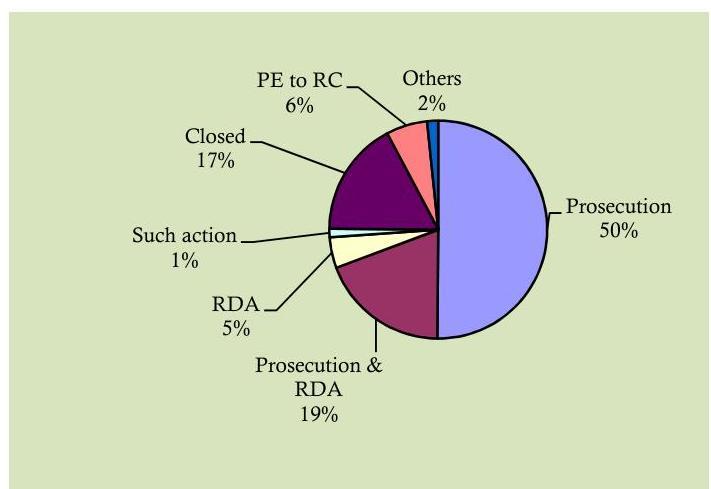
11.32 A total of 1541 cases [RCs/ PEs] were under Investigation/ Enquiry at the end of the year.
TRIAL
11.33 During the year 2018, 671 Prosecutions
were launched and Courts delivered Judgements in 850 Court Cases. Out of these, 544 cases resulted in Conviction, 233 in Acquittal, 23 in Discharge and 50 cases were disposed of for other reasons. The conviction rate was $68 %$.
11.34 The following Bar Chart shows break-up of cases decided by the courts during the year 2018 :
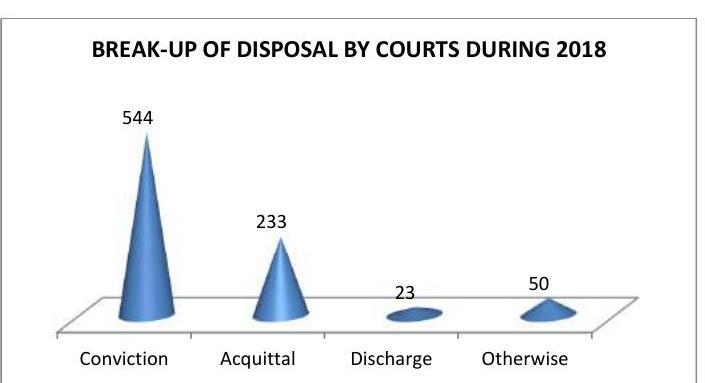
9255 trials were pending in various courts as on December 31, 2018.
INTERNATIONAL INVESTIGATION AND COORDINATION
11.35 India joined INTERPOL in the year 1949. After the formation of CBI in the year 1963, vide its circular dated 17.10.1966, the Government of India, conveyed its decision that the Central Bureau of Investigation will henceforth be the representative of the country for the purposes of correspondence with the International Criminal Police Organisation (ICPO), popularly known as INTERPOL, its call sign for radio and wireless communication. Accordingly, the INTERPOL work was transferred to the Central Bureau of Investigation, an investigating agency under the administrative control of Department of Personnel and Training. All matters relating to the NCB India are, however, dealt with by the Ministry of Home Affairs, Government of India. The
NCB India functions as an integral part of CBI, with Director, CBI being its ex-officio Head.
11.36 The mandate of NCB-India is to secure greater cooperation and share information amongst law enforcement organizations throughout the world. Pursuant to its delegated authority, NCB-India’s primary functions are:
- To facilitate international law enforcement cooperation;
- To transmit information of criminal justice, humanitarian, or other law enforcement-related nature between domestic and foreign law enforcement agencies in INTERPOL member countries, and
- To coordinate and integrate information in investigations of an international nature.
11.37 As the National Central Bureau for India, CBI is authorized unrestricted access to INTERPOL’s secure, encrypted communications network, as well as its entire array of investigative databases. Populated with millions of records contributed by INTERPOL’s 190 member countries, these databases contain vital investigative information on international fugitives; stolen and lost travel documents; missing persons; unidentified bodies; images of child sexual abuse and other matters of investigative interest. This capability facilitates law enforcement interaction in real time on investigative matters, ranging from simple criminal history checks to the sharing of sensitive criminal intelligence and investigative leads targeting transnational organized crime groups.
11.38 In addition, NCB, India is exclusively responsible for securing the publication of
INTERPOL Notices – a system of international lookouts or advisories used to assist law enforcement authorities in locating fugitives, identifying suspects and other investigative purposes on behalf of Indian law enforcement agencies and for ensuring that such notices published on behalf of other member countries are entered and maintained. NCB, India also supports the exchange of international humanitarian assistance requests involving such matters as death notifications and health & welfare checks on Indians overseas, as well as foreign nationals in India.
11.39 NCB, India, as part of International Police Cooperation Unit (IPCU) of CBI, functions around the year on $24 \times 7$ basis. It is solely dedicated and equipped to assist the Indian law enforcement agencies and their foreign counterparts in overcoming the very real cultural, linguistic and legal barriers that hinder the exchange of criminal investigative information and support across national administrations and boundaries including situations where diplomatic relations may not exist. Even for Indian law enforcement agencies, with a well-developed international criminal investigative presence, NCB-India’s services are complementary, not competitive or duplicative.
11.40 In all instances, NCB India serves to coordinate Indian law enforcement actions and responses, ensuring that it is consistent with Indian interests and law, as well as INTERPOL policies, procedures, and regulations. This includes strict adherence to Article 3 of the INTERPOL Constitution, which expressly forbids the Organization to “… undertake any intervention or activities of a political, military, religious or racial character.”
11.41 The details of the activities and the work done in the domain are mentioned below:
LETTERS ROGATORY (OUTGOING)
11.42 During the year 2018, a total of 81 LRs were sent abroad out of which 24 LRs pertain to CBI cases and 57 pertain to State Law Enforcement and Central Law Enforcement agencies. During the year 2018, 97 Execution reports have been received from Foreign Law Enforcement Agencies. It was confirmed by Indian Law Enforcement Agencies including CBI that 24 LRs are fully executed in the year 2018. These 24 LRs include 09 LRs of CBI and 15 LRs of State Police and other Law Enforcement Agencies. During 2018, 02 LRs were also treated as partially executed and closed. These LRs relate to other Central Law Enforcement Agencies. Further, during 2018, 18 LRs were returned/ withdrawn or disposed off. These include 05 LRs of CBI and 13 LRs of State Police Agencies. As on 31.12.2018, a total of 496 LRs are pending with other countries out of which 280 pertain to CBI cases and 216 pertain to State Police and other Central Law Enforcement Agencies.
LETTERS ROGATORY (INCOMING)
11.43 During the year 2018, as many as 91 Letters Rogatory (LRs) /Treaty Based Requests were received from various countries requesting to provide assistance in investigation of criminal matters. Execution Reports in 69 cases were sent to MEA/MHA, after receiving the same from Indian Investigating Agencies, for onward transmission to the law enforcement agencies of the requesting countries. Besides these, 05 LRs were otherwise disposed off as closed or withdrawn. As on 31.12.2018, 122 LRs are pending for execution.
INTERPOL Notices:-
11.44 During 2018 various notices got published by NCB-India-
- Red Notices published by NCB-India 76
- Blue Notices published by NCB-India 28
- Yellow Notices published by NCB-India 04
- Purple Notices published by NCB-India 03
EXTRADITION / DEPORTATION
11.45 The data pertaining to Red Notices published, Red Notice subjects arrested in India/
abroad and Red Notice subject extradited to India during the year 2018 is as under:-
- Fugitives wanted by India, arrested in India 13
- Fugitives wanted by India, arrested/ located in foreign countries 21
- Fugitives wanted by other countries, arrested/located in India 02
- Fugitives extradited/deported to India from foreign countries 10
- Fugitives extradited/deported from India to foreign countries 01
Details of fugitives deported/ extradited to India in 2018
| Name | Nationality | Wanted By | Date and Country of Arrest |
Date and Place of Deportation/Extradition |
|---|---|---|---|---|
| Ionut Alexandru | Romanian | Kerala Police | USA | Extradited to India on 03.03.2018 |
| Mohammed Farooq @ takla |
Indian | CBI STF Mumbai |
UAE | arrested on 08.03.2018 at IGI Airport |
| i) Mohammed Abdul Mujeeb Khan ii) Mohammed Abdul Mohsin Khan iii) Asra Mubin |
Indian | ILO Telangana | UAE | NCB Abu Dhabi vide IGCS message intimated that their authorities have decided to extradite/deport the a/m persons on 29.01.2018 |
| Mujawar | Indian | ILO Telangana | UAE | NCB Abu Dhabi vide IGCS message intimated that their authorities have decided to extradite/deport the a/m person on 04.02.2018 |
| Vinay Mittal | Indian | EO-II, EOU-V/ CBI New Delhi |
Indonesia | Extradited on 20.09.2018 |
| Name | Nationality | Wanted By | Date and Country of Arrest |
Date and Place of Deportation/Extradition |
|---|---|---|---|---|
| Palvinder Singh | Indian | SCB CBI Chandigrah |
Thailand | deported on 11/12.10.2018 |
| Mohammed Yahya | Indian | BS&FC Bangalore |
Bahrain | Extradition on 12.10.2018 |
| Mr. Michel Christian James |
British national |
ED and CBI/ AC-II/New Delhi |
UAE | Extradited from Dubai on 04.12 .2018 |
Fugitives wanted by other Countries deported/ extradited from India in 2018
| S. No. |
Year | Name | Wanted by | Red Notice No |
Offences | Date and Country of Arrest |
Date and Place of Deportation/ Extradition |
|---|---|---|---|---|---|---|---|
| 1 | 2018 | Gurung Mukhiya |
Nepal | A-11180/11- 2017 |
Murder | 08.12 .2017 , Around 0230 am this office received a fax from BOI, Jaipur Airport, about detention of one Gurung Mukhiya, holding PP no. 10464757 on the basis of LOC issued by NCB- India on the basis of the Red Notice No. A-11180/11- 2017. |
MEA ordered the surrender of the subject to Nepal on 09th February 2018 at immigration, IGI Airport Nepal. NCB Kathmandu provided details of escort team from Nepal Police which were forwarded to the Consultant Extradition on the same day. |
INTERPOL Stolen and Lost Travel Documents (SLTD) Database:-
11.46 NCB, India has uploaded data relating to lost/stolen/revoked Indian passports into the INTERPOL SLTD Database being maintained by IPCU Branch. Till 31.12.2018, data of 17, 09,324 Stolen/Lost/Revoked Indian Passports has been uploaded in the SLTD Database. During the year 2018, about 138 cases of use
of revoked/lost/stolen passports were reported by foreign NCBs.
INTERPOL Global Communication System [IGCS] messages received during 2018:-
11.47 The four Regional Desks (Asia/Middle East/USA/Europe) have received as many as 8998 requests/IGCS message/ letters from January 2018 to December 2018 from various NCBs, PLOs and Indian Law Enforcement agencies/authorities regarding various matters on police to police cooperation basis. The four regional desks of NCBIndia also worked in close coordination with other NCBs and rendered necessary guidance to them on various issues.
11.48 In addition to the above, CBI is an active partner in The Stolen Asset Recovery Initiative which is a partnership between the World Bank Group and the United Nations Office on Drugs and Crime (UNODC) that supports international efforts to end safe havens for corrupt funds. StAR works with developing countries and financial centers to prevent the laundering of the proceeds of corruption and to facilitate more systematic and timely return of stolen assets.
11.49 StAR works with partners around the world to develop the most effective tools to tackle and prevent the theft of assets critical to development. StAR works with global organizations, including the Conference of States parties to UNCAC, the G8, the G20, and the Financial Action Task Force to influence and liaise with policymakers.
11.50 VISIT OF DELEGATIONS TO CBI HEADQUARTERS
- Mr. Damien Francis Tudehope, Member of
Parliament from New South Wales Parliament visited CBI HO on 11th January, 2018.
- Mr. Ches Parsons, Director General of National Security & Critical Infrastructure of the RCMP (Royal Canadian Mounted Police), visited CBI HO on 17.01.2018.
- Ms. Aum Kinley Yangzom, Chairperson, Anti Corruption Commission, Bhutan along with delegation visited CBI HO as well as BPR\&D and CVC too in July, 2018.
- Mr. Paul M. Abbate, Associate Deputy Director FBI visited CBI HO on 07.09.2018.
- Mr. Steve Ethier, Asia Pacific Regional Manager of International Operations for the RCMP visited CBI HO on 09.10.2018.
FOREIGN VISITS OF CBI OFFICERS
11.51 During the year 2018, a total number of 70 CBI officers attended various International Capacity Building Programmes/training courses, investigations etc.
11.52 Officers from CBI were awarded the prestigious Chevening Cyber Security Fellowship and also attended the Masters Course in Anti Corruption Studies (MACS), conducted by International Anti Corruption Academy (IACA), Vienna.
TRAINING
11.53 In the year 2018, CBI Academy and the three RTCs conducted a total of 150 courses and trained 3169 Officers/Officials.
| No. of Courses | No. of Participants | Total | ||
|---|---|---|---|---|
| CBI | Non-CBI | |||
| CBI Academy | 115 | 1459 | 1140 | 2599 |
| RTC, Kolkata | 14 | 176 | – | 176 |
| RTC, Mumbai | 11 | 137 | – | 137 |
| RTC, Chennai | 10 | 257 | – | 57 |
| Total | $\mathbf{1 5 0}$ | $\mathbf{2 0 2 9}$ | $\mathbf{1 1 4 0}$ | $\mathbf{3 1 6 9 *}$ |
*includes 124 participants from Foreign Law Enforcement agencies.
RANK/ORGANIZATION WISE BREAK-UP OF THE PARTICIPANTS
| DIG & above |
SP \& Equivalent |
IOs (SI to Addl. SP) |
Law Officers |
Const to ASI |
Ministerial Staff (LDC to OS) |
Ors. | Total | |
|---|---|---|---|---|---|---|---|---|
| C.B.I. | 1 | 14 | 871 | 102 | 315 | 137 | 19 | 1459 |
| PSUs | – | 56 | 135 | – | – | – | – | 191 |
| Others | – | 144 | 52 | 26 | – | – | $124^{*}$ | 346 |
| RTCs | – | 4 | 326 | 15 | 110 | 114 | 1 | 570 |
| CPOs | – | 1 | 32 | – | – | – | – | 33 |
| State Police |
4 | 36 | 511 | 10 | 9 | – | – | 570 |
| Total | 5 | 255 | 1927 | 153 | 434 | 251 | 144 | 3169 |
| *Foreign Participants |
11.54 The CBI Academy also conducted eight courses in 2018 in which it trained 124 participants from 16 countries viz. Bangladesh, Palestine,
Surinam,Cambodia,France,Niger,Nigeria,Cameron, Maldives, Kenya, Mauritius, Swaziland, Tanzania, Zambia, Singapore and UAE.
Joint Consultative Machinery
12.0 The Scheme for Joint Consultative and Compulsory Arbitration for the Central Government Employees was introduced in the year 1966 on the lines of the Whitely Councils in the U.K.The scheme provides a platform for constructive dialogue & discussion between the representatives of the staff side and the official side for peaceful resolution of all disputes between the Government as employer and the employees. The scheme was introduced with the objectives of promoting harmonious relations and securing the greatest measure of cooperation between the Central Government as the employer and the employees in matters of common concern and with the object of further increasing the efficiency of the public service combined with the well being of those employed.
12.1 The JCM Scheme provides for three tier machinery:
(i) The National Council as the apex body; (chaired by the Cabinet Secretary);
(ii) Departmental Councils at the level of individual Ministries / Departments including their attached and subordinate offices (chaired by respective Secretaries); and
(iii) Regional / Office Councils to deal with mainly the local problems at the level of each individual office, depending on its structure. (Chaired by Head of office of respective organizations).
12.2 The scope of the JCM Scheme includes all matters relating to:
- conditions of service and work;
- welfare of the employees; and
- improvement of efficiency and standards of work.
12.2.1 Provided, however, that
(i) In regard to recruitment, promotion and discipline, consultation is limited to matters of general principles; and
(ii) Individual cases are not considered.
12.3 Under the JCM Scheme, there have been continuous interactions with staff side representatives at the National level as well as at the Departmental level and a number of important issues have been resolved amicably through mutual discussions. 46 meetings of the National Council (JCM) have been held under the Chairmanship of Cabinet Secretary since the inception of the Scheme in 1966.
Anomaly Committee
12.4 National Anomaly Committee has been setup under the Chairmanship of Secretary (P) to examine the anomalies arising out of the Implementation of the Seventh Central Pay Commission’s recommendations. The first meeting of the National Anomaly Committee was held on 17.07.2018.
Standing Committee Meeting
12.5 Meeting of the Standing Committee of the National Council (JCM) under the Chairmanship of the Secretary (P) was held on 07.03.2019.
7th Central Pay Commission Recommendation
12.6 This Department has issued OM No. 14/4/2015-JCA2 dated 31.08.2017 for implementation of a recommendation of the Seventh Central Pay Commission on Dress Allowance. In supersession of what the entitled categories of employees got earlier, they are now to be paid Dress Allowance @ 5000/- per year.
Revision of Entitlement of TA/DA to JCM Members after implementation of Seventh CPC recommendations.
12.7 This Department has issued OM No. 8/10/2008-JCA dated 20.08.2018 for implementation of a recommendation of Seventh Central Pay Commission on revision of rates of Travelling Allowance/Daily Allowance for the Staff Side Members of the National Council (NC) Departmental Council and Third Level/Regional Councils of JCM w.e.f. 01/07/2017.
ARBITRATION
12.8 An important feature of the JCM Scheme is the provision for arbitration in cases where there is no agreement between the Official Side and the Staff Side on matters relating to:-
- pay and allowances;
- weekly hours of work; and
- Leave of a class or grade of employees.
BOARD OF ARBITRATION (BOA)
12.9 A Board of Arbitration (BOA) comprising a Chairman (an independent person) and two Members, (nominated – one each by the staff side and the official side) functions under the administrative control of the Ministry of Labour & Employment. Awards of the Board of Arbitration are binding on both the sides, subject to the overriding authority of Parliament to reject or modify the awards. Most of the awards which were in favour of the employees have been implemented, except a few which could not be accepted due to their potential adverse effects on national economy / social justice.
Administrative Tribunals
13.0 The Administrative Tribunals Act, 1985 owes its origin to Article 323-A of the Constitution of India which empowers Central Government to set up Administrative Tribunals by an Act of Parliament for adjudication of grievances and disputes arising out of the conditions of service of an employee appointed to the public services and posts in connection with the affairs of the Union and the States. In pursuance of the provisions contained in the Administrative Tribunals Act, 1985, the Administrative Tribunals, set up under it, exercise original jurisdiction in respect of service matters of employees covered by the Act. As a result of the Supreme Court’s judgment dated 18.03.1997 in the case of L. Chandra Kumar & Others. Vs. UOI, the appeals against the orders of an Administrative Tribunal shall lie before the Division Bench of the concerned High Court.
13.1 The Administrative Tribunals are distinguishable from the ordinary courts with regard to their jurisdiction and procedure. They exercise jurisdiction only in relation to the service matters of the litigants covered by the Act. They are also free from many of the procedural technicalities of the ordinary courts. The procedural simplicity of the Act can be appreciated from the fact that the aggrieved person can also appear before it personally. Government can also present its cases through its departmental officers or legal practitioners. Further, only an affordable and nominal fee of $\boldsymbol{R} \boldsymbol{s} .50$ is to be paid by the applicants for filing the original application before
the Tribunal. Thus, the objective of the Tribunal is to provide speedy and affordable redress to the aggrieved applicants arising out of employment or conditions of service.
13.2 The Central Administrative Tribunal was set up on 01.11.1985. At present, it has 17 regular Benches, 15 of which operate at the principal seats of High Courts and the remaining two at Jaipur and Lucknow. These Benches also hold Circuit Sittings at other seats of High Courts. A statement showing the location of Central Administrative Tribunal Benches, the dates of their establishment and the number of courts in each of these Benches along with a list of places where they hold Circuit Sittings is given in Appendix-I.
13.3 The Tribunal consists of a Chairman and Members. It has also been the constant endeavour of this Ministry to ensure that the posts of Chairman and Members are filled up well in time and no post remains vacant for long time. The Members of Central Administrative Tribunal (CAT) and State Administrative Tribunals (SATs) are drawn from judicial as well as administrative streams, so as to give the Tribunal the benefit of domain expertise both in legal and service matters. The sanctioned strength of the Chairman is one and sanctioned strength of the Members of Central Administrative Tribunal is 65 , out of which 32 are Judicial Members and 33 are Administrative Members.
13.4 The appointment of Members in CAT is made on the basis of recommendations of a
high powered Selection Committee. Earlier, the Selection Committee was chaired by a sitting Judge of Supreme Court nominated by the Chief Justice of India. However, w.e.f. 01.06.2017 as per the new Rules, there will be a separate Selection Committee each for Judicial Members and Administrative Members. The Selection Committee for appointment of Judicial Member will be chaired by the Hon’ble Chief Justice of India or his nominee and for appointment of Administrative Members; it will be chaired by a person nominated by the Government. The names of the candidates recommended by the Selection Committee are sent to the Hon’ble Chief Justice of India for obtaining his concurrence. Thereafter, the appointments are made with the approval of Appointments Committee of the Cabinet.
However, Rules made under the Finance Act, 2017 has been challenged in various Writ Petitions before the Hon’ble Supreme Court of India and appointments of Members are being made under the old Rules/ provisions subject to final result of those Writ Petitions.
13.5 State Administrative Tribunals (SATs) were also set up in the following States –
(i.) Andhra Pradesh
(ii.) Odisha
(iii.) Karnataka
(iv.) Maharashtra
(v.) West Bengal
(vi.) Kerala
(vii) Himachal Pradesh
State Government of Haryana has requested to establish the SAT for their State, which is under
process. State Government of Tamil Nadu has also requested to re-establish the SAT. Further, the State Government of Odisha has submitted a proposal for abolition of Odisha Administrative Tribunal to this Department, which is under process.
13.6 The appointments to the vacancies in SATs are made on the basis of proposals sent by the State Governments with the approval of the Governor. Thereafter, their appointments undergo the same process as the one in respect of Central Administrative Tribunal.
13.7 Since its inception in 1985 and up to March, 2019, the Central Administrative Tribunal received $7,96,131$ cases for adjudication (including those transferred from High Courts), out of which 7, 48,016 cases have been disposed of, leaving a pendency of 48,115 cases. On an average more than $93 %$ of the cases instituted are disposed off. A statement indicating the institution, disposal and pendency of cases since inception of CAT is at Appendix-II.
13.8 Section 14(2) of the Administrative Tribunals Act, 1985 empowers the Central Government to extend the provisions of the Act to local or other authorities within the territory of India or under the control of Government of India and to Corporations or Societies owned or controlled by Government of India. In exercise of these powers, the Central Government had extended the provisions of the Act to 214 organizations so far.
13.9 In order to familiarize the newly appointed Members of CAT with the functioning of the Tribunal, a short Orientation Programme / Training is held from time to time. So far, four such Orientation Programme / Training have been held at the National Judicial Academy, Bhopal.
13.10 Further, for maintaining absolute integrity and promoting fair practices in the professional court dealings and keeping in view the general directions of the Hon’ble Supreme Court, the designated Selection Committee, in its meeting decided that a Judicial Member of CAT, who earlier practiced as Advocate in a Court in that station, should not normally be considered for posting in the CAT Bench of the same station.
13.11 It has been the constant endeavour of the Government to strengthen the infrastructure in all the Benches of CAT for their smooth functioning. During the Financial Year 2016-17, fund of Rs. 29.67 crore was allocated to CAT for purchase of land and construction of building. In the Financial Year 2017-
18 also, fund of Rs. 11.78 crore had been allocated to CAT for this purpose. In the current Financial Year 2018-19, fund of Rs. 5.00 crore was allocated to CAT for this purpose.
13.12 Hon’ble Justice Shri L. Narasimha Reddy is the Chairman of CAT. He has been appointed as Chairman, CAT with effect from 03.07.2018. Before his appointment as the Chairman, CAT, Hon’ble Justice Shri Reddy was the Chief Justice of Patna High Court. Since his appointment, the disposal rate of cases in CAT has increased a lot.
NAME, DATE OF SETTING, NO. OF COURTS AND ADDRESSES OF VARIOUS BENCHES OF CENTRAL ADMINISTRATIVE TRIBUNAL
| S.No. | Name of the Bench | Date of setting | No. of courts | Address |
|---|---|---|---|---|
| 1. | PRINCIPAL | 01.11.1985 | 6 | NEW DELHI |
| 2. | AHMEDABAD | 30.06.1986 | 1 | AHMEDABAD |
| 3. | ALLAHABAD | 01.11.1985 | 4 | ALLAHABAD |
| 4. | BANGALORE | 03.03.1986 | 2 | BANGALORE |
| 5. | CHANDIGARH | 03.03.1986 | 2 | CHANDIGARH |
| 6. | MADRAS | 01.11.1985 | 2 | CHENNAI |
| 7. | CUTTACK | 30.06.1986 | 1 | CUTTACK |
| 8. | ERNAKULAM | 01.09.1988 | 2 | ERNAKULAM |
| 9. | GUWAHATI | 03.03.1986 | 1 | GUWAHATI |
| 10. | HYDERABAD | 03.06.1986 | 2 | HYDERABAD |
| 11. | JABALPUR | 30.06.1986 | 1 | JABALPUR |
| 12. | JAIPUR | 15.10.1991 | 1 | JAIPUR |
| 13. | JODHPUR | 30.06.1986 | 1 | JODHPUR |
| 14. | CALCUTTA | 01.11.1985 | 2 | KOLKATA |
| 15. | LUCKNOW | 15.10.1991 | 1 | LUCKNOW |
| 16. | MUMBAI | 01.11.1985 | 2 | MUMBAI |
| 17. | PATNA | 30.06.1986 | 2 | PATNA |
STATEMENT SHOWING THE NAME OF BENCH AND PLACES WHERE CIRCUIT SITTINGS ARE HELD
BENCH
- ALLAHABAD BENCH
- CALCUTTA BENCH
- CHNDIGARH BENCH
- MADRAS BENCH
- GUWAHATI BENCH
- JABALPUR BENCH
- BOMBAY BENCH
- PATNA BENCH
- ERNAKULAM BENCH
PLACES
- Nainital
- Port Blair, Gangtok
- Shimla, Jammu, Srinagar
- Pondicherry
- Shillong, Itanagar, Kohima, Agartala, Imphal, Aizwal
- Indore, Gwalior, Bilaspur
- Nagpur, Aurangabad, Panaji
- Ranchi
- Lakshadweep
STATEMENT SHOWING THE POSITION OF INSTITUTION, DISPOSAL AND PENDENCY OF CASES IN THE CENTRAL ADMINISTRATIVE TRIBUNAL SINCE INCEPTION UPTO 31.03.2019.
(As provided by Central Administrative Tribunal, Principal Bench from time to time)
| S.NO. | PERIOD | INSTITUTION | DISPOSAL | PENDENCY AT THE
END OF THE YEAR |
| — | — | — | — | — |
| 1. | 1985 | 2,963 | 30 | 2,933 |
| 2. | 1986 | 23,177 | 8,934 | 17,176 |
| 3. | 1987 | 19,410 | 15,084 | 21,502 |
| 4. | 1988 | 19,425 | 13,769 | 27,158 |
| 5. | 1989 | 18,602 | 13,986 | 31,774 |
| 6. | 1990 | 19,283 | 15,495 | 35,562 |
| 7. | 1991 | 21,623 | 17,552 | 39,633 |
| 8. | 1992 | 25,184 | 23,782 | 41,035 |
| 9. | 1993 | 27,067 | 28,074 | 40,028 |
| 10. | 1994 | 26,230 | 26,409 | 39,849 |
| 11. | 1995 | 25,789 | 23,668 | 41,970 |
| 12. | 1996 | 23,584 | 20,667 | 44,887 |
| 13 | 1997 | 23,098 | 21,981 | 46,004 |
| 14. | 1998 | 21,911 | 18,394 | 49,521 |
| 15. | 1999 | 22,944 | 24,566 | 47,899 |
| 16. | 2000 | 25,146 | 31,398 | 41,647 |
| 17. | 2001 | 25,977 | 31,953 | 35,671 |
| 18. | 2002 | 25,398 | 29,514 | 31,555 |
| 19. | 2003 | 25,089 | 28,076 | 28,568 |
| 20. | 2004 | 23,825 | 27,735 | 24,658 |
| 21. | 2005 | 21,528 | 22,408 | 23,778 |
| 22. | 2006 | 18,722 | 17,774 | 24,726 |
| 23. | 2007 | 17,725 | 18,674 | 23,777 |
| S.NO. | PERIOD | INSTITUTION | DISPOSAL | PENDENCY AT THE
END OF THE YEAR |
| — | — | — | — | — |
| 24. | 2008 | 18,287 | 20,352 | 21,712 |
| 25 | 2009 | 24,496 | 23,681 | 22,527 |
| 26. | 2010 | 26,620 | 25,477 | 23,670 |
| 27 | 2011 | 25,869 | 24,750 | 24,789 |
| 28 | 2012 | 27,786 | 24,259 | 28,316 |
| 29 | 2013 | 27,442 | 21,654 | 34,104 |
| 30 | 2014 | 27,872 | 23,767 | 38,209 |
| 31 | 2015 | 26,059 | 23,051 | 41,217 |
| 32 | 2016 | 26,984 | 26,266 | 41,935 |
| 33 | 2017 | 25,386 | 20,051 | 47,270 |
| 34 | 2018 | 26,309 | 23,538 | 50,053 |
| 35 | Upto March, 2019 | 6,287 | 8,225 | 48,115 |
| 36 | Total | 7,60,483 | 7,13,213 | 48,115 |
Staff Welfare
14.0 The Central Government is the largest single employer in the country and bears the major responsibility for looking after the welfare of a large number of employees spread all over the country. Realizing that improvement in the working and living conditions of the employees and their families leads to efficiency and high morale, the Department of Personnel and Training supports various staff welfare measures. A brief account of various welfare measures dealt with by Welfare Division is given below.
RESIDENTSí WELFARE ASSOCIATION
14.1 In order to foster a spirit of mutual help and goodwill among residents of Government colonies and to promote social, cultural and recreational activities, Department of Personnel & Training (DOPT) has been encouraging formation of Central Government Employees Residents Welfare Associations (CGERWAs). Every CGERWA seeking reorganization and grants-inaid from Government is required to adopt Model Constitution prescribed by DOPT. At present, there are 95 recognized Associations. The members of the Managing Committees of these Associations are elected every two years under the provisions of a Model Constitution framed by the Department of Personnel and Training. This Department sanctions grants-in-aid only to recognized Associations, subject to a maximum of Rs.10, 000/- per annum for an Association.
AREA WELFARE OFFICERS
14.2 The Area Welfare Officers (AWOs) are nominated in residential colonies having a large number of Central Government employees. The AWOs serve as a link between the Government and residents in matters relating to the welfare of Government employees living in various colonies. They also work as field officers in coordinating and maintaining liaison with various agencies of Government such as CPWD, CGHS, Police etc. Applications are invited from Gazetted Officers working in various Ministries/Departments for being nominated as Area Welfare Officers for a period of two years. Officers desirous of being nominated as AWOs on voluntary and honorary basis are required to apply through their respective Ministries/Departments.
CENTRAL GOVERNMENT EMPLOYEES WELFARE COORDINATION COMMITTEES (CGEWCCs)
14.3 The Central Government Employees Welfare Coordination Committees (CGEWCCs) have been formed outside Delhi, at places where there are at least five Central Government Offices and the total number of Central Government Employees is not less than 1000. These Committees are responsible for coordinating the welfare activities of the Central Government employees serving within their jurisdiction. The senior most officer at the station functions as the Chairman of the Committee.
CENTRAL CIVIL SERVICES CULTURAL & SPORTS BOARD (CCSCSB)
14.4 The Central Civil Services, Cultural \& Sports Board, a society registered under the Societies Registration Act, 1860 is the Central agency for promotion of Cultural \& Sports activities amongst the Central Government employees in the country. The Board was set up in 1964 as Central Secretariat Club in the Ministry of Home Affairs. Initially, the objective of the Board was to promote cultural and sports activities amongst the Central Government Employees located in Delhi only. Subsequently, Regional Sports Boards were set up in various states. Financial grants-in-aid are sanctioned every year by the Board to the Regional Boards.
ACTIVITIES OF THE BOARD – INTER MINISTRY TOURNAMENTS 2018-19
14.5 The Board organizes Inter-Ministry Tournaments in 18 disciplines of sports. So far, the Board has organized Inter-Ministry Tournaments in Cricket, Swimming, Lawn Tennis, Football, Athletics, Wrestling, Shooting ball, Table Tennis, Carrom, Badminton, Basket Ball, Chess, Hockey, Kabaddi,
Music, Dance and Short Play, Power Lifting, Weight Lifting and Volley Ball for the yaer 2018-19.
NEW ACTIVITIES UNDERTAKEN BY THE BOARD IN 2018-19 FOR THE FIRST TIME
14.6 CCSCSB organized athletics competition and Dance and Music competition for wards of Central Government Employees. CCSCSB also organized Half Marathon for Central Government employees and their immediate family members in collaboration with (Youth Hostel Association of India) YHAI. The event was a great success. Around 1000 persons participated in the event.
All INDIA CIVIL SERVICES TOURNAMENTS HELD DURING THE YEAR 2018-19
14.7 These tournaments, which are open to Central and State Government employees, aim to give an opportunity to the civil servants to meet and interact with each other and compete. AICS Tournaments are being organized in collaboration with different States/UTs. All India Civil Services Tournaments were held in following discipline in 2018-19.
| S.No. | Game | Achievement |
|---|---|---|
| 1. | Kabaddi | 1 Gold |
| 2. | Wrestling | 6 Gold, 1 Silver and 2 Bronze |
| 3. | Lawn Tennis | 3 Gold, 2 Silver and 2 Broze |
| 4. | Weightlifting and best physique | 1 Gold, 2 Silver and 2 Bronze |
| 5. | Badminton | 4 Gold, 2 Silver and 5 Bronze |
| 6. | Athletics | 2 Gold, 1 Silver and 2 Bronze |
| 7. | Power lifting and Bench Press | 1 Gold, 1 Silver |
| 8. | Carrom | 1 Gold |
| 9. | Swimming | 4 Gold, 3 Silver |
| S.No. | Game | Achievement |
|---|---|---|
| 10. | Basketball | 1 Silver |
| 11. | Hockey | 1 Silver |
| 12. | Football | 1 Bronze |
| 13. | Table Tennis | 1 Bronze |
SCHEME FOR PROMOTION OF ADVENTURE SPORTS & SIMILAR ACTIVITIES AMONGST CENTRAL GOVERNMENT EMPLOYEES
14.8 As a welfare measure, the CCSCSB launched a Scheme for promotion of adventure sports and similar activities amongst Central Government Employees working in the Ministries/Departments. The Scheme includes upto 10 days programme having components of environmental awareness, disaster management, team spirit, capacity building, and Swaccha Bharat Campaign and activities like Trekking, Mountaineering, Rock-Climbing, Cycling in a difficult terrain, Skiing, Rafting, Para Sailing, Jungle Safari and Environmental Awareness Camps etc. 14.9 It is expected that participation by Central Government Employees in adventure sports and similar activities will give them a platform where they would learn lessons from nature and use the knowledge acquired for welfare of the society. It would also foster spirit of risk-taking, cooperative team work, capacity of readiness, vital response to challenging situations, endurance and environmental awareness. 14.10 CCSCSB provides financial assistance up to Rs.20,000/- under the scheme of promotion of Adventure Sports \& similar activities including to and fro travel charges to the Central Govt. employees.
BOARDS AFFILIATION TO NATIONAL FEDERATION
14.11 The Board is affiliated to a number of spans associations/federations at the National level. Board’s teams participate in the National Tournaments organized by these Associations/ Federations in Kabaddi, Hockey, Football, Carrom and Chess.
SPORTS FACILITIES IN DELHI
14.12 The Board has a sports complex at Vinay Marg, New Delhi which has facilities for Football, Hockey, Cricket, Athletics, Lawn Tennis, Basketball, Volleyball and practice pitches for Cricket. The Board also maintains lawn Tennis Courts at Brassy Avenue, Bharti Nagar, Pandara Road and R.K.Puram Sector 13, New Delhi. Brassy Avenue, New Delhi has facilities for Volleyball and Cricket practice pitches also. There is facility for Indoor games such as Table Tennis, Carrom and Chess at Nirman Bhawan, New Delhi.
COACHING FOR CHILDREN DEPENDENTS OF GOVERNMENT EMPLOYEES
14.13 The Board also conducts regular coaching in Cricket and Lawn Tennis for the children/ dependents of Government employees at Vinay Marg Sports Complex, New Delhi. Coaching in Lawn Tennis is also available at Bharti Nagar,
Pandara Road, R.K. Puram Sector-13, and Vinay Marg New Delhi. The Board also organizes Summer Coaching camp in Basketball, Cricket, Football, Selfdefence and Lawn Tennis for children/dependents of government employees.
PARTICIPATION OF GOVERNMENT EMPLOYEES AND THEIR FAMILIES IN SPORTING ACTIVITIES CONDUCTED IN COLLABORATION WITH SAI
14.14 The Board has introduced Scheme for Swimming for Central Government Employees and their children in collaboration with Sports Authority of India at Major Dhyanchand National Stadium & Talkatora Stadium New Delhi. Under the Scheme, Government employees and their dependents/ families avail the facility of Swimming at nominal charges. Badminton, Table tennis and Fitness Centre facilities are also extended to Government Employees under “Come and Play” scheme of Sports Authority of India to the employees and their families. Under this scheme, the amount charged by SAI is reimbursed to the beneficiary after deduction of nominal fee.
SETTING UP OF GYMNASIUM IN MINISTRIES/DEPARTMENTS
14.15 The Board has framed the Scheme for establishment of indoor Gymnasium, open Gym and augmentation of existing Gyms in Ministries/ Departments. As a Staff welfare measure, the CCSCSB provide financial assistance to the Ministries/Departments of Central Government for setting up of indoor \& open Gymnasium and augmentation of existing Gyms.
GRIH KALYAN KENDRA
The Grih Kalyan Kendra (GKK) is a registered Society under the Societies Registration Act, 1860 and functioning under the aegis of Ministry of Personnel, Public Grievances \& Pensions.
14.16 The basic objectives of the Kendra, in brief are: –
a) To promote social, economic, cultural and educational activities for the welfare of Central Government Employees and their families.
b) To impart technical and vocational training in home crafts and other household arts for useful utilization of leisure time and for better and efficient housekeeping.
c) To organize and promote economic activities that may provide opportunities for gainful employment to families of Central Government employees for supplementing family income.
14.17 The GKK is administered by GKK Board.
The Board, which has the Secretary (P) or his nominated officer as the President, is responsible for the organization and administration of GKK.
14.18 In pursuance of its objectives, GKK has been conducting the following activities:
a) Training classes in cutting, tailoring and embroidery for the housewives and grown up girls during their leisure hours.
b) Nursery education for children in the age group of 3 to 5 years.
c) Creches or Day Care Centres for children between the age of 90 days to 10 years.
d) Recreational facilities like Health Club/Gym, badminton and tennis, etc.
e) Coaching classes in Martial Arts, Yoga, Music, Dance, English Speaking Course, Computer,
Brain Development, Fine Arts, Lawn Tennis etc.
14.19 The welfare activities run by Grih Kalyan Kendra are indicated in the table given below:
| Place | Number of SamajSadans/ Centres |
Craft Centres | Nursery Schools |
CrecheCentres | Health Clubs/Gyms |
|---|---|---|---|---|---|
| Delhi | 32 | 7 | 13 | 10 | 6 |
| Mumbai | 4 | 3 | 4 | – | – |
| Chennai | 3 | – | 2 | – | – |
| Jaipur | 2 | 1 | – | 1 | – |
| Dehradun | 2 | – | 2 | – | – |
| Nagpur | 2 | – | – | – | – |
| Bangalore | 3 | – | – | – | – |
| Faridabad | 1 | 1 | 1 | 1 | – |
| Kolkata | 1 | – | – | – | – |
| Ghaziabad | 1 | – | – | – | – |
| Total | $\mathbf{5 1}$ | $\mathbf{1 2}$ | $\mathbf{2 2}$ | $\mathbf{1 2}$ | $\mathbf{0 6}$ |
14.20 The Grih Kalyan Kendra has undertaken the following activities during 2018t-
i) 1400 children in Nursery Schools, 127 Students in Craft Centres, 156 Children in Crèches, 79 Users in Health Clubs/ Fitness Centres, 621 in Outsourced Activities and 2000 in Yoga Activity have been availing the facilities.
ii) DOPT launched a Yoga training scheme w.e.f. 01.04.2015 in association with Morarji Desai National Institute of Yoga, New Delhi for the benefit of Central Government employees and their dependents free of cost. The training sessions are conducted in 25 locations in
Delhi and 14 SamajSadans of Grih Kalyan Kendra outside Delhi.Yoga Trainers have been selected by Morarji Desai National Institute of Yoga (MDNIY), New Delhi. These trainers have been engaged by Grih Kalyan Kendra, on contract basis. Government has allocated Rs. 2 crores for the scheme of Yoga Training sessions under the Non-Plan Head in 2017-18 and Rs. 1.67 Crore for the year 2018-19.
(iii) 1468 participants of Yoga Training Session at various SamajSadans in Delhi attended the International Yoga Day held on 21.06.2018. International Yoga Day was celebrated even at the SamajSadans located outside
Delhi namely, Kolkata, Chennai, Mumbai, Nagpur, Dehradun, Bangalore, Faridabad and Ghaziabad where the numbers of participants were totally 595.
KENDRIYA BHANDAR
OBJECTIVES OF THE ORGANISATION
14.21 The Central Government Employees Consumer Cooperative Society Ltd., New Delhi, operating in the name of KENDRIYA BHANDAR was set up in 1963 in pursuance of Cabinet decision as a Welfare Project for the benefit of the Central Government Employees. The society endeavors to serve the Central Government Employees and general public at large by providing quality goods of daily needs at reasonable prices and consumer items through its retail stores. The range of items which Kendriya Bhandar provides includes consumer goods, grocery items, stationery and medicines etc.
MULTI STATE COOPERATIVE SOCIETY
14.22 The Society is registered under MSCS Act 2002, as a Multi-State Co-operative Society and operates in Delhi and other States of the country.
NETWORK
14.23 The Society operates a network of 149 stores/branches in Delhi, Maharashtra, Tamilnadu, Andhra Pradesh, Karnataka, Cochin, Daman, Goa, Gujarat, Uttar Pradesh, Uttarakhand, Rajasthan, Madhya Pradesh, West Bengal, Jharkhand, Assam, Haryana, Punjab and Chandigarh etc.
14.24 At Delhi, Kendriya Bhandar has a chain of 109 nos. self service grocery consumer retail
stores beside the Institutional Sales Unit (ISU) and 05 Pharmacy stores. At Grocery/Consumer stores, all items of consumer goods, grocery items and certain stationery items are being sold. Through its Institutional Sales Unit, Kendriya Bhandar continues to provide goods to institutions like Tihar Jail, JNU/IIT Hostels, Janpath/Samrat Hotel, Hyderabad House, President House, Vigyan Bhawan, Homes of Social Welfare Department of Govt. of Delhi, Govt. Hospitals etc. In addition, we have exclusive Counter at East Block and West Block, R.K. Puram, New Delhi for sale of stationery and other products. In other parts of country, our valuable customers are being served through the network of stores/ branches as per the details given herein above.
14.25 Furthermore, Kendriya Bhandar is supplying medicines and related items to CGHS Dispensaries and Hospital in Delhi through its existing chemist shops. Kendriya Bhandar has also opened three Jan Aushadhi Generic Drug Shops in GTB Hospital, DDU Hospital and Shastri Bhawan as a part of Jan Aushadhi project of the Department of Pharmaceuticals, Govt. of India
Kendriya Bhandar has also opened new stores at AWHO, Greater Noida, AWHO Sector-82 Noida, NSG Complex, Manesar, Jamia Hamdard University (Delhi) and DMRC Colony, Mukundpur. In addition, 13 stores have been opened in Delhi-NCR under franchisee system.
SHARE CAPITAL
14.26 As on $31^{\text {st }}$ March 2018 Kendriya Bhandar had a paid-up capital of Rs.101.20 lakhs of which Rs.68.18 lakhs have been subscribed by the Central Government and the rest by individual members.
SERVICE RENDERED BY KENDRIYA BHANDAR TO THE NATURAL CALAMITIES AFFECTED STATE – KERALA
14.27 Senior Officers and Govt. of Kerala sought assistance of Kendriya Bhandar to start emergent supply of certain item at a notice of few hours. Employees of Kendriya Bhandar and management worked diligently and arranged the supplies well before time as per their requirements
MODERNISATION/AUTOMATION EFFORTS
14.28 Kendriya Bhandar has also undertaken the modernization of its retail stores including renovation, computerization etc. in order to provide a pleasant shopping experience to the customers and accordingly over 20 stores have been modernized over the last one year.
14.29 Activities such as billing to customers, purchase, inventory etc. of Stationery division of Kendriya Bhandar, located at R.K. Puram, East & West Blocks are computerized through Local Area Network. Further, in Head Office, purchases \& stocks of Consumer items, pulses and spices are computerized. Kendriya Bhandar has also undertaken computerization of godowns such as Grocery \& consumer godowns and about 100% retail stores have already been computerized and also inventory has been computerized.
14.30 Debit/Credit Card swapping machines have been installed in all stores of Kendriya Bhandar for the convenience of customers.
SALES AND FINANCIAL PERFORMANCE
14.31 Kendriya Bhandar has achieved sales of
Rs.750.14 crores during the financial year 2017-18 against the sale of Rs. 864.38 crores in Financial year 2016-17 and also achieved a net profit of Rs.1.89 crores in the F.Y 2017-18 after making provision for pay arrears of Rs.1.20 crores against the net profit of Rs.6.95 crores during the F.Y. 2016-17.
14.32 Kendriya Bhandar has declared a dividend of $10 \%$ for the year 2017-18. There is no financial assistance from Govt. to Kendriya Bhandar. Source of income of Kendriya Bhandar is trading of products, interest on FDRs etc.
BENEFITS TO CUSTOMERS
14.33 The Society has been able to maintain competitive prices for various products sold by it as compared to those prevailing in the market. In fact, selling prices prevailing in Kendriya Bhandar now are deemed as the bench mark in the market.
14.34 For better quality control, full fledged Quality Control Department is in place for monitoring the product quality and for making improvements on an ongoing basis. Packed grocery items are sold after pre-testing in laboratory. On the shelf post testing is done periodically. The goods sold in the manufacturers packing carry the warranty of the manufacturer. Complaints books are provided in all the stores for customers to enter their complaints/suggestions which are acted upon from time to time.
14.35 It is pertinent to mention that the Society has been involved in welfare activities and has always assisted the Central Government and the Govt. of NCT of Delhi in arresting the price rise at the time of crisis.
14.36 All the stores have been computerized, CCTV cameras have been provided in large number of stores as preventive measure against shop lifting, theft etc.
The Civil Service Society (Sanskriti School)
Introduction
14.37 The Civil Services Society is a society registered under the Societies Registration Act. The Society was set up in February 1995, by the wives of the officers of the All India and Allied Civil Services. The wife of serving Cabinet Secretary is the Chairperson of the Civil Services Society. The office of the Society is on Dr. S Radhakrishnan Marg, Chanakyapuri, New Delhi – 110021.
Aims and Objectives
14.38 The aims and objectives of the society, interalia, are as under: –
- To establish progressive schools or other educational institutions in Delhi or outside Delhi, open to the children of officers of the All India and Central Services. Depending on the availability of seats, children of officers of the Public sector of non – government servants may also be admitted, at the discretion of the Governing Body.
- To impart sound and liberal education to boys and girls during their impressionable years – a type of education that will lay stress on character building, team work, esprit de corps, physical development and will infuse in school children a spirit of adventure, fair play and justice.
- To develop among its students a feeling of pride in Indian culture and to produce citizens
who will truly be global and rise above social, communal, religious and provincial prejudices.
14.39 The Society started its first school with the strength of 32 students, the Sanskriti School, in New Delhi, in the year 1998. The Chairperson of the Society is also the Chairperson of the School. Sanskriti School is a recognized integrated co educational school, affiliated to the CBSE, offering education from Nursery through Class XII.
14.40 The Society believes that every child can and must realize his/her full potential, and towards this end, must be enabled through appropriate means. With this in mind, the School has a Learning Centre with Special Educators and Counselors guiding children who have special needs, through an Individual Education Program (IEP).
14.41 Likewise, for those from the relatively less privileged sections of society, the Society runs a parallel school Umang in the afternoon. Efforts are also made to mainstream some of the children. These children from the economically weaker sections are admitted through the admission process under the Delhi Education Act.
14.42 The Civil Services Society has set up a Centre for Excellence to promote teacher training initiatives. It has instituted the Sanskriti Lecture Series to motivate students by exposing them to thought processes of eminent persons.
Management
14.43 The general management of the affairs of the Society is vested in its Executive Committee.
14.44 The general management of the affairs of Sanskriti School is also guided by the Managing Committee.
Activities
14.45 As on $31^{\text {ST }}$ March, 2018, Sanskriti School has 2781 students on its rolls from Nursery to Class XII. It has well stocked libraries, smart classrooms, laboratories, a gymnasium, a football field and a swimming pool. Apart from the prescribed curriculum, Sanskriti School offers its students a choice of sports and games, like cricket, football, basketball, table tennis, swimming and wide ranging co – curricular activities like yoga, chess, theatre, music, dance, quiz, public speaking, paper craft, etc.
Finance
14.46 The Society has no income of its own other than the annual subscription of the members. For Sanskriti School the source of income is the fees collected from the students.
CIVIL SERVICES OFFICERS INSTITUTE (CSOI)
INTRODUCTION
14.47 The Civil Services Officers’ Institute is a registered society under the Societies Registration Act and was set up in February 1998. CSOI was allotted a building at K.G Marg, M.S. Apartments complex in 1998 which was later re-appropriated by CPWD to provide facilities of an Institute. Subsequently land was allotted to CSOI in 2002 at Vinay Marg, Chanakyapuri measuring 4.23 acres by Ministry of Urban Development, GOI. The new building was constructed by NBCC at a cost of Rs.44.33 crore and it became operational with effect from December 2012. The Governing Council of CSOI took a decision to run both the Institutes at their respective locations in view of increased membership.
AIMS AND OBJECTIVES
14.48 The aims and objectives of the CSOI inter alia include:-
(i) To promote welfare of the officers of the Civil Services and bring them together under one umbrella to secure complete integration of the services and to build a corps of officers imbibed with the spirit of co-operation in all aspects of Civil Services.
(ii) To hold, organize, arrange and conduct seminars, symposiums, talks, debates, workshops, lectures and other means of dispensing education to meet the needs and challenges of modern day Civil Administration.
(iii) To print and publish journals, periodicals and manuals to keep the civil servants abreast with modern day development.
(iv) To acquire and promote modern skills of Civil Administration and harmonize between different fields of Civil Administration by disseminating or exchanging knowledge thereof and by providing such other facilities as would lead to their Universal application.
(v) To establish and maintain libraries and information system to facilitate study of Civil Administration at International level and spreading information in regard thereto.
(vi) To organize and maintain, on no-profit-no loss basis, limited residential accommodation for the members of the Society coming to participate in the activities of the Association and of other bodies with cognate objectives, as well as non-members, invited to participate in the activities of the Association.
MANAGEMENT
14.49 CSOI is managed by a Governing Council headed by Cabinet Secretary, an Executive Committee headed by Secretary (DOPT), and a Working Committee headed by Additional Secretary (DOPT). Various sub committees comprising of members to assist Working Committee in its day to day smooth functioning, viz :
a) Finance sub committee
b) Food & Beverages sub committee
c) Event \& Art sub committee
d) Building Maintenance sub committee
e) IT sub committee
f) Library sub committee
g) Sports sub committee.
DEPARTMENTAL CANTEENS
14.50 As a measure of Staff Welfare, Departmental
Canteens/Tiffin Rooms have been set up in the Government Offices/Establishments to make available Beverages, snacks and meals prepared in hygiene conditions, to the employees at reasonable rates. At present about 1000 departmental canteen/ Tiffin rooms are functioning in various Central Government Offices all over India. With a view to provide good quality of service in clean \& hygienic environments, this Department has introduced a scheme for modernization of Departmental Canteens in 2015. Under the scheme, one time grant is given to canteens for their modernization to maintain hygiene and high standards of service.
14.51 Scholarship Scheme for children of employees of Non-Statutory Departmental Canteens was instituted in 1998 out of the funds in the discretionary fund of Director of Canteen. The scheme was introduced to encourage higher studies among the children of the canteen staff.
Major Initiative/ Achievements/Events under Welfare Division
14.52 CCSCSB
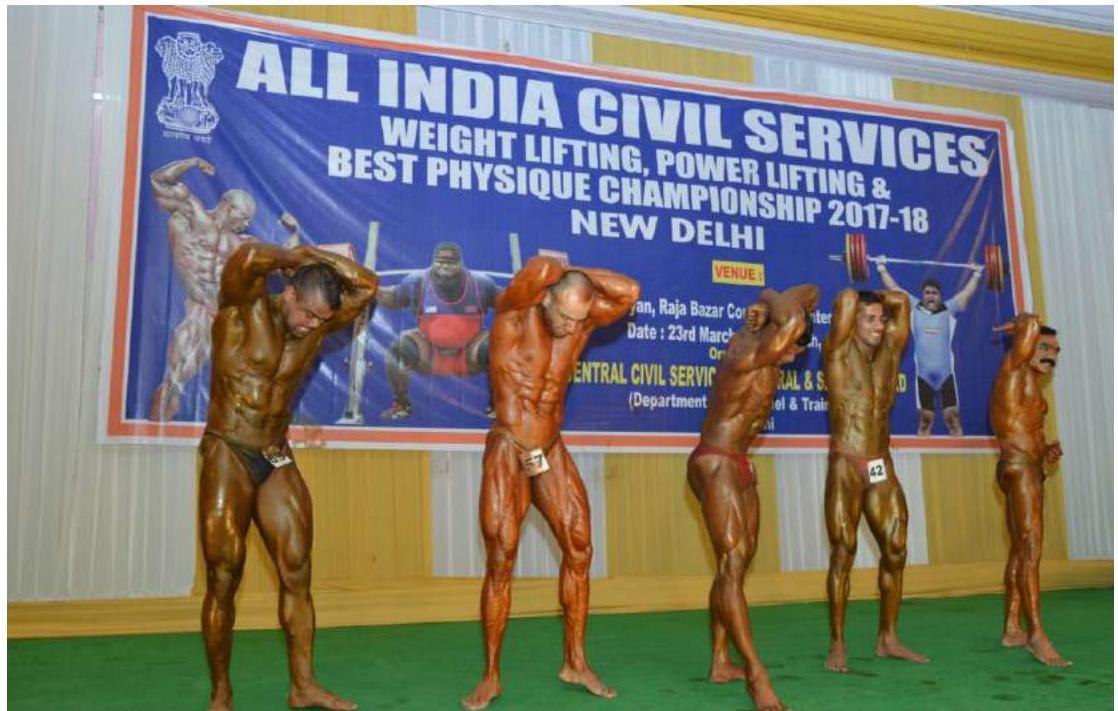
All India Civil Services Weight Lifting, Power Lifting \& Best Physique Championship 2017-18 at New Delhi
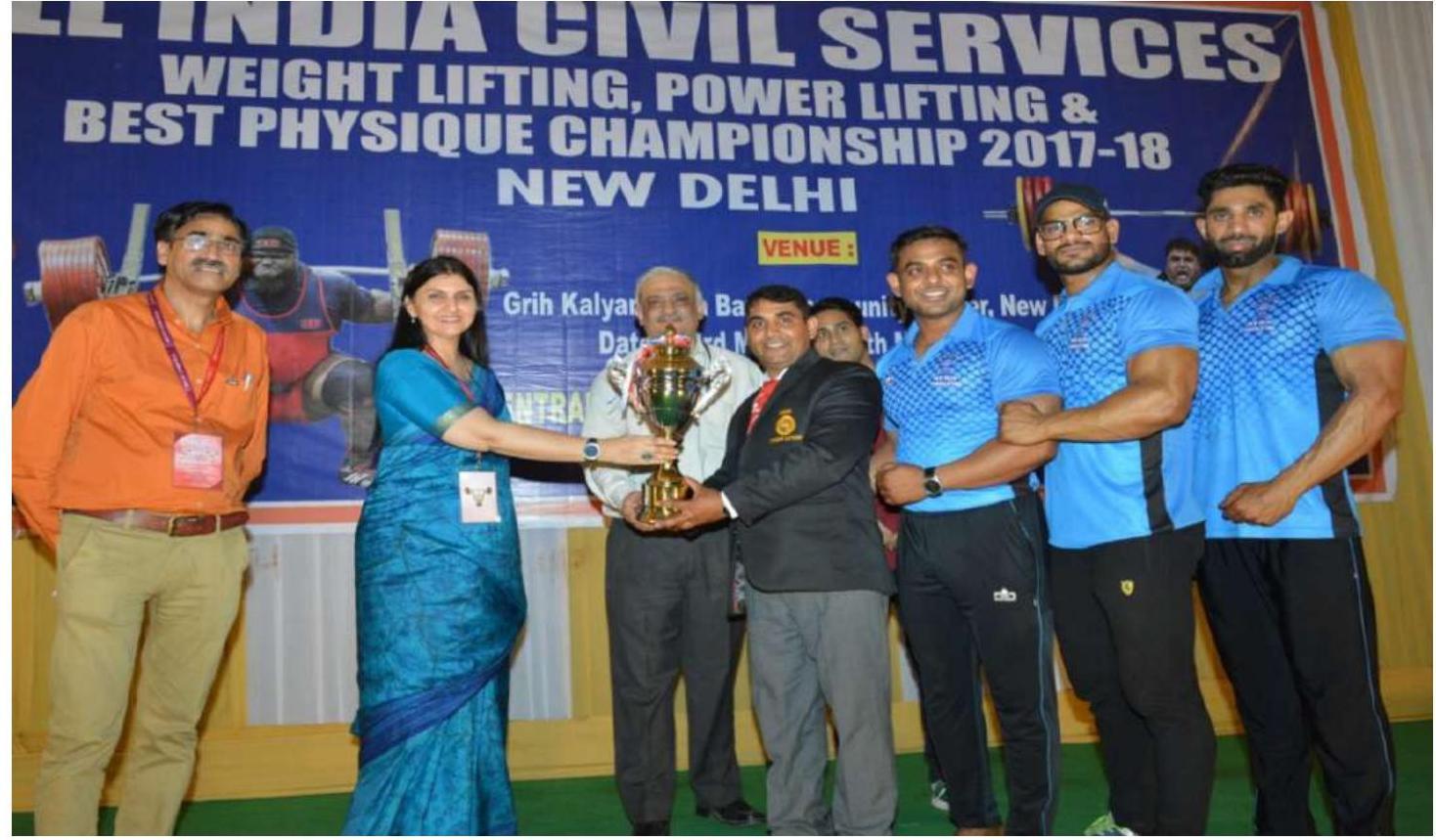
Prize Distribution Ceremony during All India Civil Services Power Lifting & Best Physique Championship 2017-18 at New Delhi
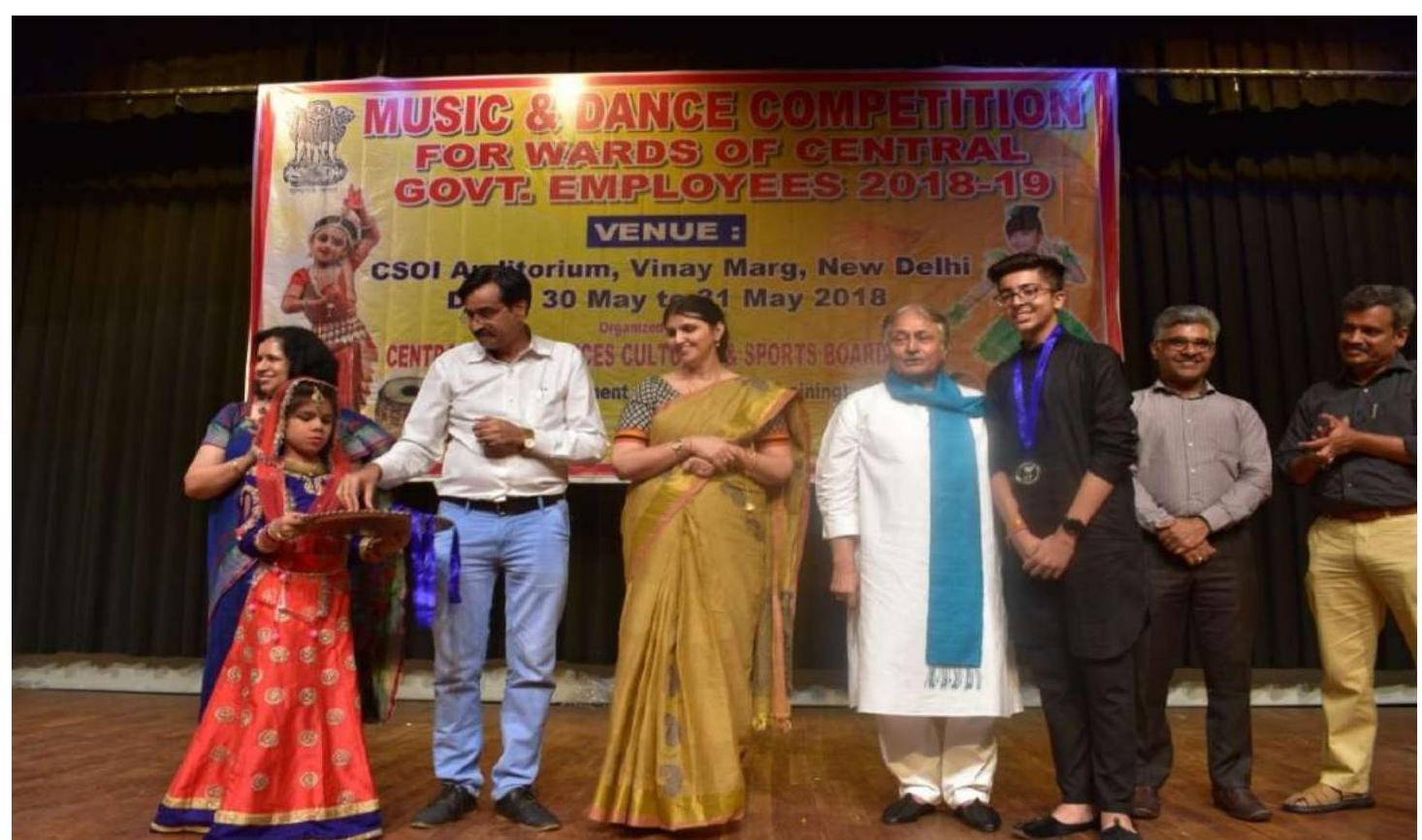
Music and Dance Competition for Wards of Central Government Employees 2018-19 at CSOI, Vinay Marg
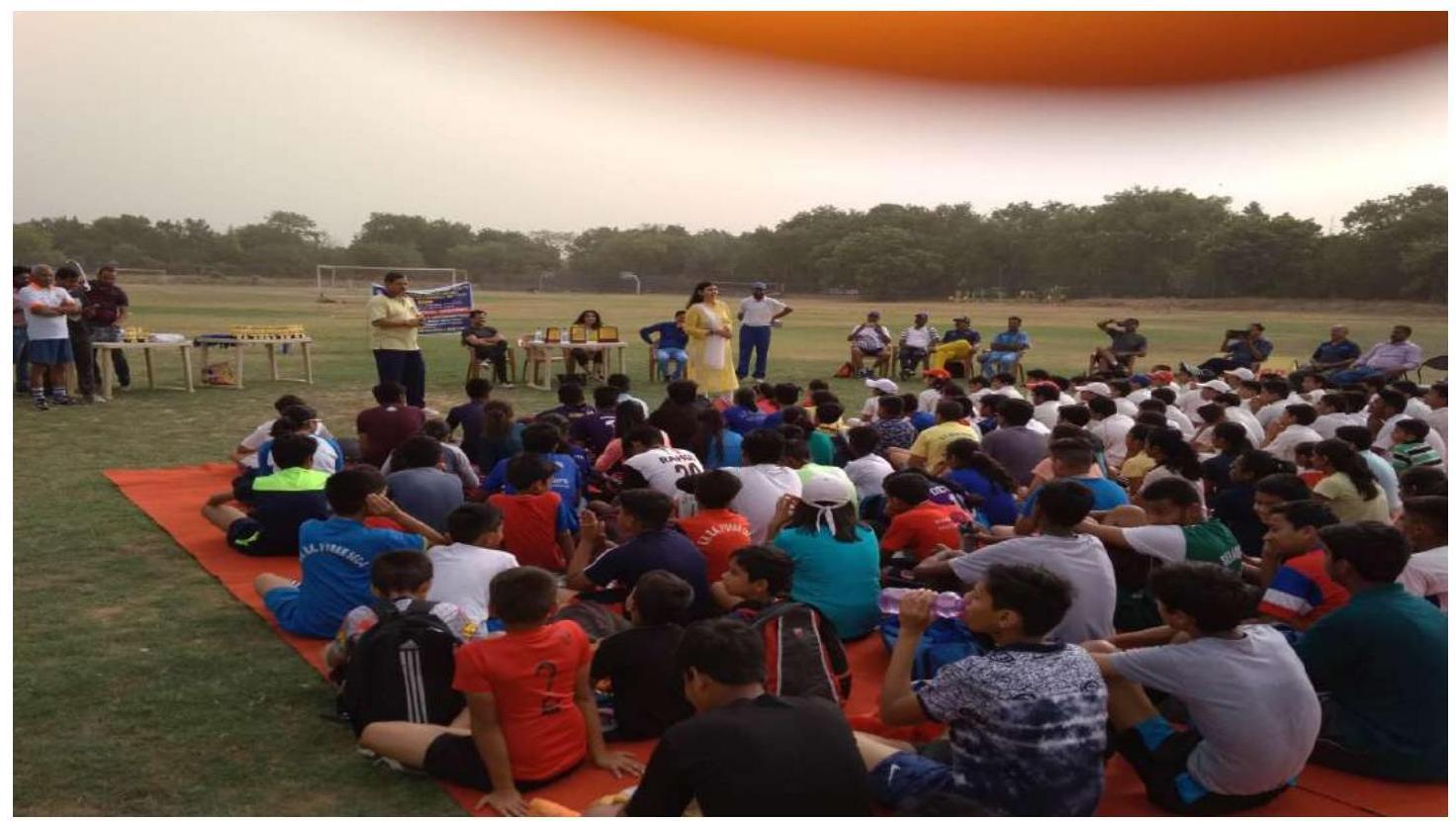
Summer Coaching Camp 2018-19 at Vinay Marg Sports Complex, New Delhi
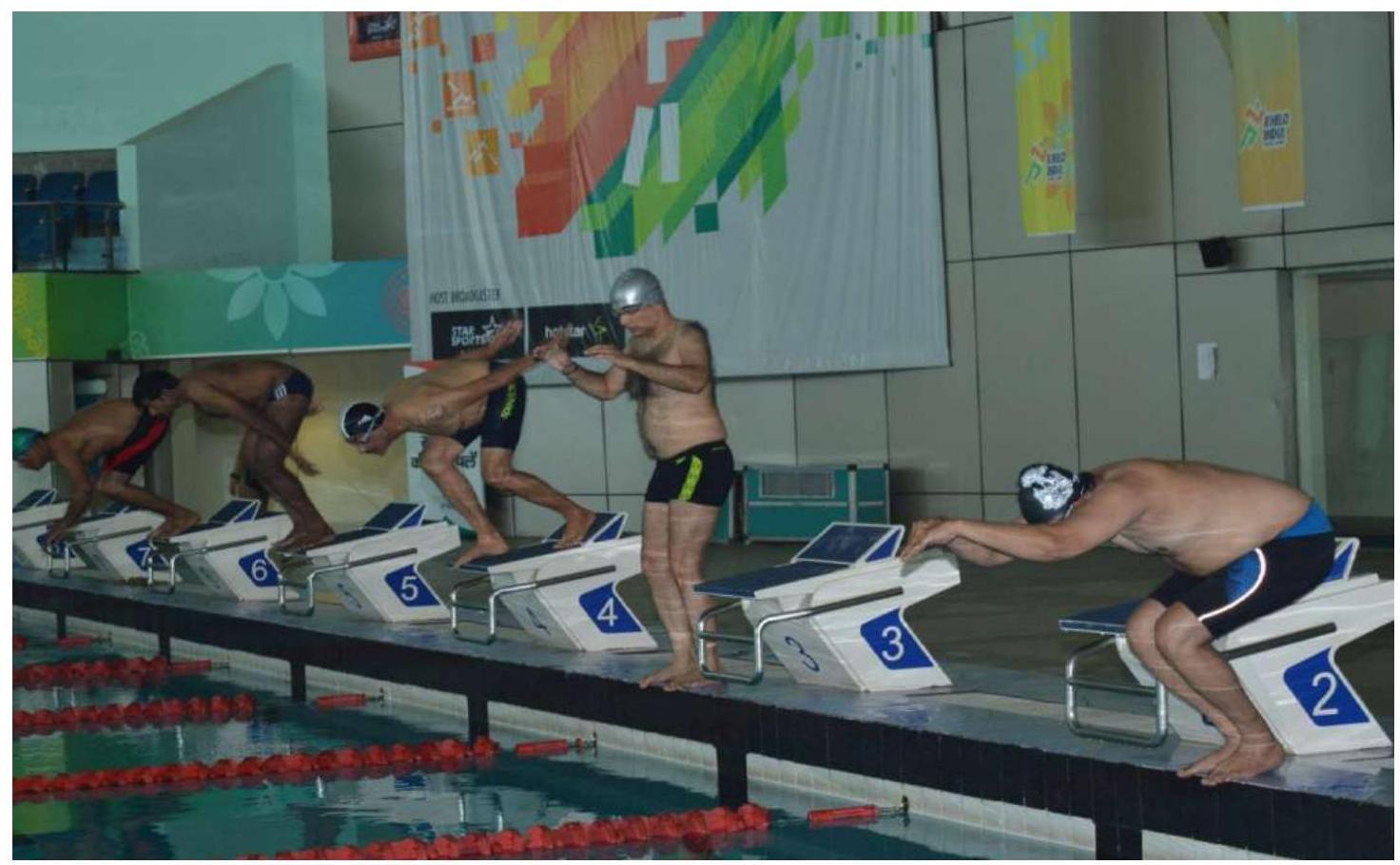
Inter Ministry Aquatic Championship 2018-19 at Talkatora, New Delhi
14.53 GKK
On the occasion of $4^{\text {th }}$ International Day of Yoga on 21.06.2018, 250 Yoga Sadhaks from Grih Kalyan Kendra participated in the Yoga Session at Connaught Place, Lodhi Garden and Talkatora Stadium organized by Ministry of AYUSH. Besides, about 750 Yoga Sadhaks performed Yoga Sessions at their respective Samaj Sadans of Grih Kalyan Kendra in Delhi, Dehradun, Nagpur, Mumbai, Bangalore, Kolkata and Chennai on this occasion.
14.54 CSOI
- Screening of regional movies on Monday and old classical on Wednesday was revived and has been appreciated by the members.
- Substantial increase in art, intellectual, cultural & entertainment activities during the year as part of welfare activities for the members.
- Talks and Interactive Sessions on ‘GST unraveled’, ‘Raza \& Gandhi’, India -Bangladesh Relations.
- Talks on India-Afghanistan international relations in the presence of former dignitaries.
- Health Talks, Talks on Life style management Music Events, Exhibition of Coin Collection
and talk on the subject, Garba Dance \& Hi Tea on the occasion of Teej Celebration. - Stage Plays- “The Would be Gentleman” by Drashta Entertainers \& “Har Guruvaar” by Subrang Theatre Group \& “August Osage County” by Dramatech.
14.55 CANTEEN
(i) Meetings were held with Ministries/ Departments for adoption/Notification of RRs for canteen staff and filling up of posts lying vacant in Departmental Canteens.
(ii) Training was imparted to canteen staff to facilitate registration of Departmental Canteens under Food Safety \& Standards Act, 2006 and Rules \& Regulations there under.
(iii) Amendment was carried out in Model RRs of the post of Halwai-cum-Cook in Type ‘D’ NonStatutory Departmental Canteens.
(iv) In the month of January 2019, an amount of Rs. 47 Lakhs has been released to five offices for modernization of their Departmental Canteens.
The Right To Information
MANDATE
- Administration of the RTI Act and Rules including amendments thereof.
- Issue of Guidelines and clarification on RTI.
- Implementation of the Annual Programme titled ‘Improving Transparency and Accountability in Government through Effective Implementation of RTI Act’.
- Management of RTI online web portal.
- Administrative matters of Central Information Commission.
- Selection of Chief Information Commissioner and Information Commissioners in the Central Information Commission.
- Framing of Right to Privacy Law.
SALIENT FEATURES OF THE RIGHT TO INFORMATION ACT, 2005
15.1 To set out a practical regime for securing information by citizens from the Public Authorities and to promote transparency and accountability in the working of all Public Authorities, the Parliament enacted the Right to Information Act in 2005.
15.2 The Act is comprehensive and covers disclosure of information by public authorities on matters of governance. It is applicable to Government at all levels- Union, State and Local and also to the bodies owned, controlled or substantially financed directly or indirectly by the Government. It covers legislative bodies, the judiciary, the executive and Constitutional bodies.
15.3 The Act casts an obligation on public authorities for suo-motu disclosure/publication of of information held by them. It also requires
the public authorities to supply information called for by any citizen and to permit him to inspect the documents and collect samples of various works. The procedure for seeking information is very simple. A person seeking information has to make a request to the concerned Public Information Officer indicating the information required. The request may be sent either by post, or be submitted in person or online if such facilty exists with the public authority. It can be made in Hindi or English or in the official language of the area in which the application is made.
15.4 The Act creates the machinery to ensure supply of information, which consists of Public Information Officers, Assistant Public Information Officers, Departmental Appellate Authorities, independent Central and State Information Commissions etc.
15.5 The Act requires information to be provided
in time bound manner. A Public Information Officer is required to send information called for at the specified address within 30 days. In case the information concerns the life or liberty of a person, it has to be provided within forty eight hours. The act provides for imposition of stringent penalty on the Public Information Officer if the information is not provided within the prescribed period which could be Rs.250 per day of delay subject to a maximum penalty of Rs. 25000.
15.6 The Act has created a system of two appeals. On not being provided information within the prescribed period or on not being satisfied with the reply provided, an applicant can make first appeal within 30 days to the departmental appellate authority, who is generally the next superior officer to the Public Information Officer. If not satisfied with the decision of the first appellate authority, the applicant can file a second appeal to the Central Information Commission or the State Information Commission, as the case may be, within 90 days.
15.7 However, certain types of information pertaining to security of the country, scientific or economic interest of the country and information on trade secrets etc. are exempted from disclosure. Certain security or intelligence organizations have been exempted from disclosing any information except that pertaining to corruption or violation of human rights. Such organizations are required to designate Public Information Officers and first Appellate Authorities to deal with applications and appeals relating to information pertaining to corruption or violation of human rights.
15.8 With a view to create a brand for the Right to Information, a logo as given below had been adopted for the RTI on 28th October, 2010. The logo is very simple and iconic. A sheet of paper with information on it, and the authority figure behind it providing the information. This represents the two key stakeholders in the process of sharing information under the RTI Act.

CENTRAL INFORMATION COMMISSION
15.9 The Government of India has constituted a Central Information Commission and, all the 29 States to which the Act applies have constituted State Information Commissions. These Commissions are high powered independent bodies which, inter-alia, can look into the complaints made to them and decide the appeals. The Commissions have power to impose penalty on the defaulting Public Information Officers. Central Information Commission entertains complaints and appeals in case of offices, financial institutions, public sector undertakings, etc. under the Central Government and the Union Territories while the State Information Commissions entertain appeals pertaining to offices, financial institutions, public sector undertakings, etc. under the concerned State Government.
15.10 The Central Information Commission, when constituted initially, had five Commissioners including the Chief Information Commissioner. With the last appointment of one Chief Information Commissioner and four Information Commissioners on 1st January, 2019. The Commission has now SIX Information Commissioners apart from the Chief Information Commissioner.
RIGHT TO INFORMATION RULES, 2012
15.11 In supersession of the Central Information Commission (Appeal Procedure) Rules, 2005 and the Right to Information (Regulation of Fee and Cost) Rules, 2005, the Right to Information Rules, 2012 has been notified in the Gazette of India on 31st July, 2012.
15.12 The Right to Information Rules, 2012 provide inter-alia that a request for obtaining information shall be accompanied by an application fee of rupees ten by way of cash against proper receipt or by demand draft or bankers’ cheque or Indian Postal Order payable to the Account Officer of the public authority. The applicant may have to pay fee in addition to application fee for obtaining documents or for inspecting the documents. The persons below poverty line are not required to pay any fee for seeking information.
15.13 The RTI Rules, 2012 also prescribe the procedure for deciding appeals by the Central Information Commission, covering the following aspects:
(i) Documents to be enclosed with the appeal;
(ii) Return of Appeal
(iii) Process of Appeal
(iv) Procedure for deciding appeals
(v) Presence of the appellant before the Commission
(vi) Presentation by the Public Authority
(vii) Service of notice by Commission
(viii) Order of the Commission
RTI WEBSITE
15.14 There is a dedicated website on RTI www. rti.gov.in, which contains valuable information including circulars, notifications and Guides on RTI, search facility for locating CPIOs and Appellate Authorities in Central Government etc. It has links with other RTI related sites as well.
ANNUAL PROGRAMME ON RIGHT TO INFORMATION
15.15 The Government has launched a Centrally Sponsored Plan Scheme “Improving Transparency and Accountability in Government through Effective Implementation of the Right to Information Act” in August, 2010 to undertake activities in the area of awareness generation and capacity building. Under the scheme, the State Administrative Training Institutes and State Information Commissions are supported through release of grants for awareness generation and training programmes of all stakeholders. The total outlay of the scheme under XIIth Five Year Plan was Rs.110.36 crores. Afterwards the Scheme has been changed to an Annual Programme. During the last financial year i.e., 2017-18 an expenditure of Rs.5.37 crores has been incurred under the Scheme. During the current F.Y i.e 2018-19, an amount of Rs 4.54 crores has been released till 31.03.2019.
TRAINING:
15.16 The above Plan Scheme has components of training of Public Information Officers / First Appellate Authorities of Centre as well as States. On the training of State PIOs, a sum of Rs.2.83 Crores was released to Administrative Training Institutes during the current Financial Year (upto 31.03.2019).
AWARENESS GENERATION FOR RTI:
15.17 The component of awareness generation includes Organization of Workshops, RTI Week Celebration, Innovative Awareness Generation Programmes and Publication of Guidebooks. During the year under review an expenditure of Rs. 141.54 lakhs was incurred on these components during the current Financial Year (till 31.03.2019).
INTERNSHIP ON RTI:
15.18 Considering the need to consolidate and document the experiences of the Ministries / Departments of Government of India in the implementation of RTI, its successes, constraints in implementation, to identify the areas which need more attention, to address the gap areas and to see what more needs to be done to help achieve the objectives of the RTI Act, DOPT provides Short Term Internships to Undergraduates pursuing the five year integrated course in Law and pursuing Graduation in Law to conduct an analysis of applications received under RTI Act in Select Public Authorities. During the year under review, Internship was offered to 10 (Ten) interns under RTI Internship Programme from 26.06.2018 till 25.08.2018 out of which 09 (Nine) interns successfully completed the internship.
RTI FELLOWSHIP:
15.19 The RTI fellowship of 3-month duration is awarded every year to four fellows in the age group of 25-40 years from the field of Media/Journalism/ Civil Society Organizations associated with RTI/RTI Trainers to conduct field based research on themes relating to RTI with the aim that the research output will enhance our understanding of the status of the
implementation of the Act, including its success, constraints in its implementation and how those are being/could be overcome and what more needs to be done to help achieve the objectives of the Act. During the fellowship period each fellow is granted a total stipend of upto Rs.2.00 lakhs. The fellowship has been started from 2010.
RTI CELLS IN MINISTRIES / DEPARTMENTS
15.20 Department of Personnel & Training provides a one-time grant of Rs.50, 000/- under the Annual Programme for setting up RTI Cells in the Central Ministries / Departments to streamline receipt and disposal of RTI applications / appeals and orders. So far 39 Central Public Authorities have received grants for setting up RTI Cells.
RTI ONLINE PORTAL
15.21 A web portal namely ‘RTI Online’ has been launched to provide the facility for the Indian Citizens to file online RTI applications and first appeals and also to make online payment of RTI fees. The prescribed fee can be paid by the applicant through internet banking of the State Bank of India as well as by Credit/Debit cards of VISA / Master, through the payment gateway of SBI, which is linked to RTI Online portal.
15.22 The RTI online portal provides for sending online replies to applications and appeals, though reply can be sent by regular post also. For the successful implementation of this facility, extensive training to the CPIOs / FAAs has been provided by DOPT, with the help of NIC. Till 31.03.2019, 2234 Public Authorities have been aligned with this portal.
SUO MOTU / PROACTIVE DISCLOSURE
15.23 Section 4(1)(b) of the RTI Act lays down the information which should be disclosed by Public Authorities on a suo motu or proactive basis. Sections 4(2) and 4(3) of the Act prescribe the method of dissemination of this information. In order to improve the proactive disclosure, Government of India constituted a Task Force on Suo motu disclosure in May, 2011. After considering the recommendations of the Task Force, the Government of India has issued guidelines to Central Ministries / Departments for Proactive Disclosure under section 4 of the RTI Act on 15.4.2013. These guidelines envisage –
(a) Suo motu disclosure of more items under section 4,
(b) guidelines for digital publication of proactive disclosure,
(c) detailing of certain clauses of section 4(1)(b) to make disclosure more effective
(d) compliance mechanism for suo motu disclosure
(e) personal information of an individual not to be disclosed
15.24 As per the guidelines, Pubic Authorities may publish information relating to procurement, public private partnerships, transfer policy and orders, RTI applications, CAG and PAC paras, citizens’ charter, discretional and non-discretionary grants, foreign tours of Prime Minister and Ministers.
15.25 The guidelines further provide that each Central Ministry/ Public Authority should get its proactive disclosure package audited by a third party every year and that such audit should be communicated to the Central Information Commission annually through publication on their own websites along with the names of the third party auditors. Under these guidelines it is mandatory that a senior officer of the level of Joint Secretary in the case of Ministry/Department and Additional HoD in the case of attached/ subordinate offices, is nominated as nodal officer for ensuring compliance with the proactive disclosure guidelines.
15.26 State Governments have also been requested to consider issuing similar guidelines, along with templates for disclosure at various levels, for better implementation of suo motu disclosure at State level. Four areas have been identified for development of templates viz. Public distribution system, Panchayats, MGNREGA and Primary and Secondary Schools.
15.27 A facility to upload the reply of RTI applications and first appeals on the respective website of the Ministry/Department has been started from $31^{\text {st }}$ October, 2014. All the Ministries/ Departments of Govt. of India have been requested to upload the reply to RTI application and first appeal on their respective websites, except the replies relating to the personal information of an individual, if they do not serve any public interest.
16
Grievance Redressal Mechanism & Citizens’ Charter
Citizens/ Client’s Charter and Sevottam Compliant Public Grievance System of the Department:
16.1 The Citizens’/Clients’ Charter of the Department is being reviewed by the Task Force constituted by the Department. The services included in the citizens’/clients’charter are:
i. Processing of proposals for ACC approval.
ii. Allocation of Service on the basis of result of Civil Services Examination (Display on website of this Department)
iii Nomination of candidate to whom service allocated for Foundation Course (Display on website of this Department)
iv Release of holiday list for the Government Department/organisations.
v. Release of Grants-in-aid to staff side Secretariat of National Council (JCM).
vi. Grant of advice on disagreement cases with UPSC on disciplinary matters.
vii. Clarification on ACRs/APARs.
viii. Processing for extension of ad-hoc appointment /Grant of approval.
ix. Processing of proposals for framing/ amendment/relaxation of RRs (including proposals received online on RRFAMS).
x. Cadre Clearance for Deputation.
xi. NOC for filling up of posts in Government organisation.
xii. Nomination of officers under domestic Funding of Foreign Training- Long Term Training Programmes (6 months- 1 year) \& Short Term Training Programmes (up to 6 month).
xiii. Nomination of officers for Advanced Professional Programme in Public Administration (APPPA).
xiv. Advice /clarification to Ministries/ Departments on the issue of Reservation in services to SC, ST, OBC, PWD and ExServicemen.
xv. Payment to vendors for invoices submitted, except air bills, submitted complete in all respects.
16.2 Review of implementation of Citizens’/ Clients’ Charter is a continuous process and the Department is committed to include more services and improve service standards.
Public Grievances Redressal System
16.3 The Department is implementing the centralized Public Grievances Redressal and Monitoring System (CPGRAMS), an online grievance redressal mechanism, developed and monitored by the Department of Administrative Reforms and Public Grievances (DARPG). During the period
from April, 2018 to March, 2019 the Department has received 18591 grievances in CPGRAMS, out of which 17091 grievances have been disposed of.
16.4 In addition, this Department receives grievances in printed/handwritten copies as well from citizens and forwarded by other Ministeries/ Departments of the Government of India. These Grievances are forwarded to various Divisions concerned in DoPT for examination and redressal. The grievances which do not pertain to this Department are forwarded to the Ministries / Departments concerned and the petitioners are informed, accordingly.
16.5 Grievance redressal position, the obstacles which prevent as early resolution as well as measures to improve on the performance are discussed at regular intervals under the Chairpersonship of both the JS (PG) and Secretary (P).
16.6 Joint Secretary (Admn.), DoPT is the Nodal Officer of Public Grievances for DoPT. As per the instructions of Department of Administrative Reforms & Public Grievances, Wednesdays are observed as meeting-less days so that the citizens can meet the officers concerned with their grievances.
Information and Facilitation Centre
16.7 Information and Facilitation Centre (IFC) of this Department is functioning with a Help Desk for providing information to the citizens, both at North Block and Lok Nayak Bhawan, New Delhi. Apart from facilitating and guiding the citizens, the IFC disseminates information regarding Department of Personnel and Training and its activities. IFC has been set up with a view to facilitating easy accessibility for the citizens.
Progressive Use of Hindi in Official Work
17.0 The Ministry continued to make concerted efforts to promote the use of Hindi in official work and to ensure compliance of the provisions of the Official Language Act, 1963 as amended in 1967 and Official Language Rules, 1976 framed thereunder. Various Orders/Instructions issued from time to time by the Department of Official Language with a view to ensure proper implementation of the Official Language Policy of the Union are also implemented in the Ministry.
17.1 MACHINERY FOR IMPLEMENTATION AND TRANSLATION
17.1.1 The Ministry has a full-fledged Official Language Division headed by a Joint Director (OL) with 01 (One) Deputy Director (Post Vacant) and 02 (Two) Assistant Directors (one post vacant) and other supporting staff. This Division caters to the needs of the Department of Personnel and Training. There is a separate OL section under a Deputy Director (Official Language) with necessary supporting staff in the Department of Administrative Reforms and Public Grievances. Likewise, there is also a separate OL section under 01 (One) Assistant Director (OL) with necessary supporting staff in Department of Pension and Pensioners’ Welfare. Besides monitoring the implementation of the Official Language Policy and the Annual Programme, the Official Language Division arranges in-service training for the staff for learning Hindi Language, Hindi Stenography and Hindi Typewriting. It also undertakes translation
of the materials received from various Sections/ Desks of the Department from English to Hindi and vice versa such as General Orders, Standard forms, Notifications, Resolutions, Cabinet Notes (except the annexures relating to other Ministries/ Departments), Administrative and other Reports, Press Releases and Periodic Statements/Summaries etc. referred to in section 3(3) of the Official Language Act, 1963 in addition to Parliamentary and Budgetary matters.
17.2 VARIOUS COMMITTEES FOR EFFECTIVE IMPLEMENTATION OF OFFICIAL LANGUAGE POLICY
17.2.1 Kendriya Hindi Samiti
Kendriya Hindi Samiti headed by the Hon’ble Prime Minister suggests various ways and means to the Ministries/Departments to promote the use of Official Language Hindi in the official work. Last meeting of the committee was recently held on 06.09.2018 under the chairmanship of the Hon’ble Prime Minister. The directions and follow up actions the Committee are being implemented in the Department.
17.2.2 Hindi Salahakar Samiti
This is a high committee consisting of 30 members. The Hindi Salahakar Samiti of this Ministry was reconstituted on 12.04.2014 after the constitution of $16^{\text {th }}$ Lok Sabha. The twelvth meeting of the committee was held in New Delhi under the
chairmanship of Hon’ble Minister of State (PP) on $16^{\text {th }}$ February, 2018 in which progressive use of Hindi in official work of the Ministry was reviewed.
17.2.3 Kendriya Rajbhasha Karyanvayan Samiti
Kendriya Rajbhasha Karyanvayan Samiti is headed by the Secretary, Department of Official Language which reviews the ongoing progress of the use of Hindi in all Ministries/Departments of Government of India. The directions of this Committee are being complied with in the Department.
17.2.4 Official Language Implementation Committee (OLIC)
The meetings of the Official Language Implementation Committee (OLIC) of the Department of Personnel and Training are held periodically in the Department to discuss the Quarterly Progress Reports and suggest various measures for progressive use of Official Language Hindi in the Department. The meetings of Official Language Implementation Committee (OLIC) are being held regularly in the Department. Last meeting was held on 23.01.2019. The Quarterly Progress Reports related to Official Language Hindi are reviewed in the meetings of Official Language Implementation Committee (OLIC) and various measures are taken for progressive use of Official Language Hindi in the Department.
17.2.5 Official Language Implementation Committee (OLIC) of Attached Offices
All the attached/subordinate offices of the ministry have their own Official Language Section and they have their own Official Language Implementation Committee (OLIC). The meetings of Official Language Implementation Committee are held regularly in these offices and the representatives of the Department also attend these meetings.
17.3 SPECIFIC MEASURES TAKEN FOR PROMOTING THE USE OF OFFICIAL LANGUAGE HINDI
17.3.1 Quarterly Progress Report and Annual Assessment Report
To assess the work done by the personnels in Hindi in their official work, a Quarterly Progress Report is compiled after collecting relevant data from various Divisions/Sections in a prescribed proforma and sent to the Department of Official Language, Ministry of Home Affairs on regular basis. Similarly, Annual Assessment Report is also sent to the Department of Official Language, Ministry of Home Affairs.
17.4 CASH AWARDS AND INCENTIVE SCHEMES
Various incentive schemes of the Department of Official Language to encourage officers and employees to do their official work in Hindi are in vogue in all the government departments. One such scheme is in vogue in this Department under which cash awards are given to staff members who carry out their official work (Noting & Drafting) in Hindi.
17.5 HINDI WORKSHOPS
Hindi Workshops are organized in the Department to remove the hesitation among the officers and employees to do their official work in Hindi in which all the participants are given practical training of Rajbhasha Hindi. During the period under review, three Hindi Workshops were organized on 18.05.2018, 12.09.2018 and 07.12.2018 at North Block, New Delhi and the fourth workshop is proposed to be held on $26^{\text {th }}$ March, 2019.
17.6 ORGANISING HINDI FORTNIGHT/ DIWAS
Hindi Fortnight was organized in the Department from $13^{\text {th }}$ September, 2018 to $27^{\text {th }}$ September, 2018. During the fortnight ten (10) competitions namely Hindi Noting & Drafting (Hindi/Non-Hindi), Hindi Essay Writing (Hindi/Non-Hindi), Official Language Hindi and General Knowledge, Translation, Hindi Story Writing, Hindi Extempore and Hindi Poetry Recitation etc. were organized. Hindi Symposium:
Challenges Being Faced in Working in Hindi as Official Language was also organized as the $10^{\text {th }}$ competition in this series on this occasion in which a Hon’ble member of Hindi Salahkar Samiti along with a large number of officers and employees of the Department enthusiastically participated and the participants who secured first, second and third positions and also those who performed well were awarded with cash prizes and commendation certificates by the Hon’ble Minister of State in the award ceremony organized on $1^{\text {st }}$ February, 2019.
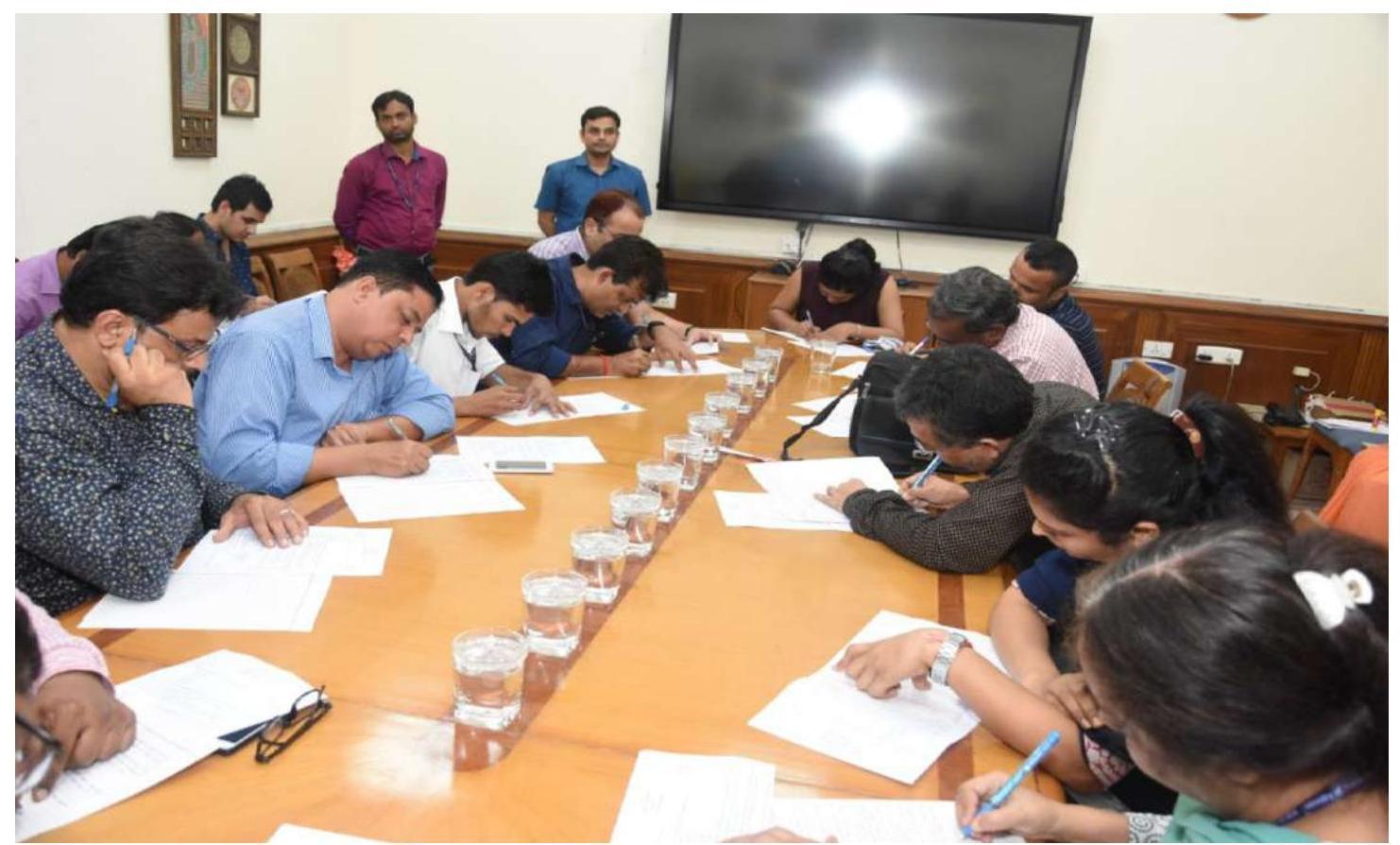
17.7 HINDI IN TRAINING INSTITUTIONS
The two Training Institutions under the Ministry viz. Lal Bahadur Shastri National Academy of Administration (LBSNAA), Mussoorie and the Institute of Secretariat Training and Management (ISTM), New Delhi have made considerable progress in providing the training materials in Hindi also. In
LBSNAA, the teaching material of main subjects are provided in book form and translation of the lecture notes of the topics taken by the faculty members is provided immediately on the demand of trainee officers. Institute of Secretariat Training and Management (ISTM) also has its all the training material available in bilingual form.
17.8 MONITORING AND INSPECTION
The progress made in Hindi for effective implementation of the Official Language Policy is reviewed on the basis of Quarterly Progress Report and Annual Assessment Report. The progress made in the progressive use of Hindi is discussed at length in the quarterly meetings of internal Official Language Implementation Committee in which remedial measures are suggested to remove the shortcomings found.
Besides, Divisions/Sections and the Attached Offices of the Ministry are inspected by Official Language Section of the Department of Personnel and Training in a phased manner and necessary measures are taken and directions are given to overcome the practical difficulties experienced in the course of implementing the Official Language Policy of the Union.
During the year under review, subordinate offices viz. Institute of Secretariat Training and Management (ISTM) and Public Enterprises Selection Board (PESB) located at New Delhi were inspected on 30.10.2018 and 30.11.2018 from the point of view of implementation of Official Language in their official work and the progressive use of Hindi in their work was also reviewed. Other subordinate/attached offices namely AntiCorruption Branch of CBI located at Port blair and Staff Selection Commission, North Eastern Region located at Guwahati are scheduled to be inspected from 25.03.2019 to 28.03.2019 and 02.04.2019 to 04.04.2019 respectively as per normal course of inspection being carried out every year to take the stock of the progress made in the implementation of the Official Language Hindi.
17.9 RAJBHASHA SHIELD YOJANA
With a view to promote competitive and cooperative feeling and synergy among subordinate offices and headquarters for promoting progressive use of Rajbhasha Hindi in the official work of the Department, an ambitious shield scheme entitled Rajbhasha Shield Yojana consisting of two parts was launched. The first part is meant for the sections located at Headquarters under which Rajbhasha Shield would be given to the section using Hindi in its official work more than any other section and the officers and employees working there in Hindi would be rewarded. The second part of the scheme is meant for the Subordinate Offices in which provisons have been made to give the Rajbhasha Shield to the Subordinate Office doing its official work in Hindi more than any of the Subordinate Offices. AdminIV and Reservation (Estt.) sections at Headquarters and Staff Selection Commission (SSC) among Subordinate Offices have been selected as the winners for their outstanding work in Hindi for the year 2016-17 and 2017-18 respectively. The yojana has created a spirit of competition and dynamism for progressing use of Official Language Hindi among the officers and employees of the Department.
Progressive Use of Hindi in Official Work
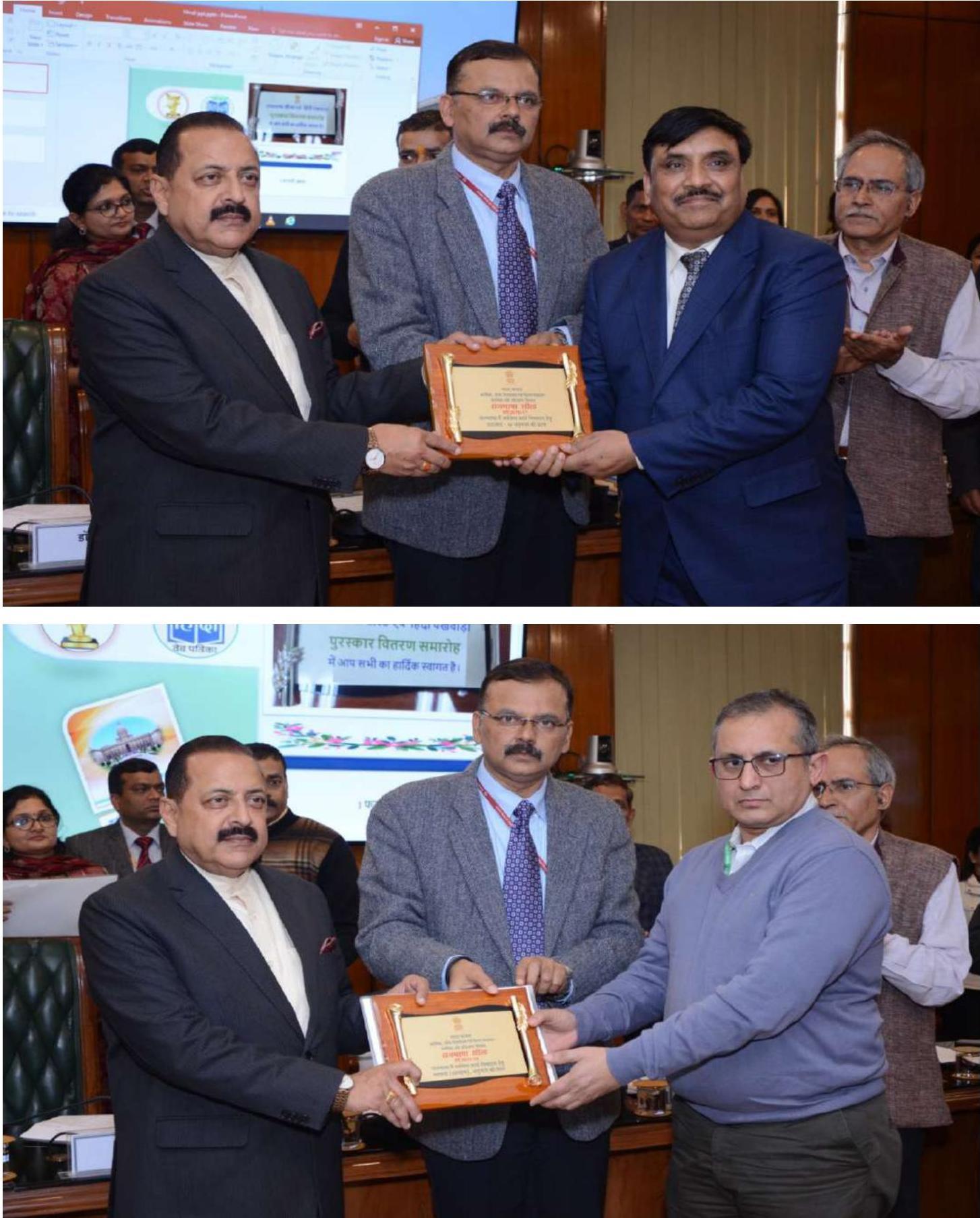
Distribution of Rajbhasha Shields to winner sections and subordinate office under Rajbhasha Shield Yojana by Hon’ble Minister of State Dr. Jitendra Singh
154 | ANNUAL REPORT 2018-19
17.10 Release of e-Magazine “KAUSHAL”
In a first of its kind initiative the Department of Personnel and Training has started an e-magazine christened as “KAUSHAL” to provide a platform to the officers and employees of the Department to make a creative, conducive and positive environment for progressive use of Hindi Language in official work. This initiative leads to a keen desire among the officers and employees to give vent to their creative urge in Hindi. Hence, this ambitious initiative would help create a positive synergy among the officers and employees to do their official work in Official Language Hindi which in turn will make public administration more and
more citizen centric and decentralized. This is a progressive step to make Official Language Hindi more popular among the officers and employees of the Department which would go a long way in translating the vision of ‘Sabka Sath Sabka Vikas’ of Government of India into reality by rendering public administration and public service delivery mechanism more inclusive. It would also make public administration more responsive and accessible with greater participation of citizens from across the country irrespective of linguistic diversity. The magazine has been released by Hon’ble Minister of State (PP) during award distribution ceremony held on $1^{\text {st }}$ February, 2019 and the link of magazine is available on website of the Department.
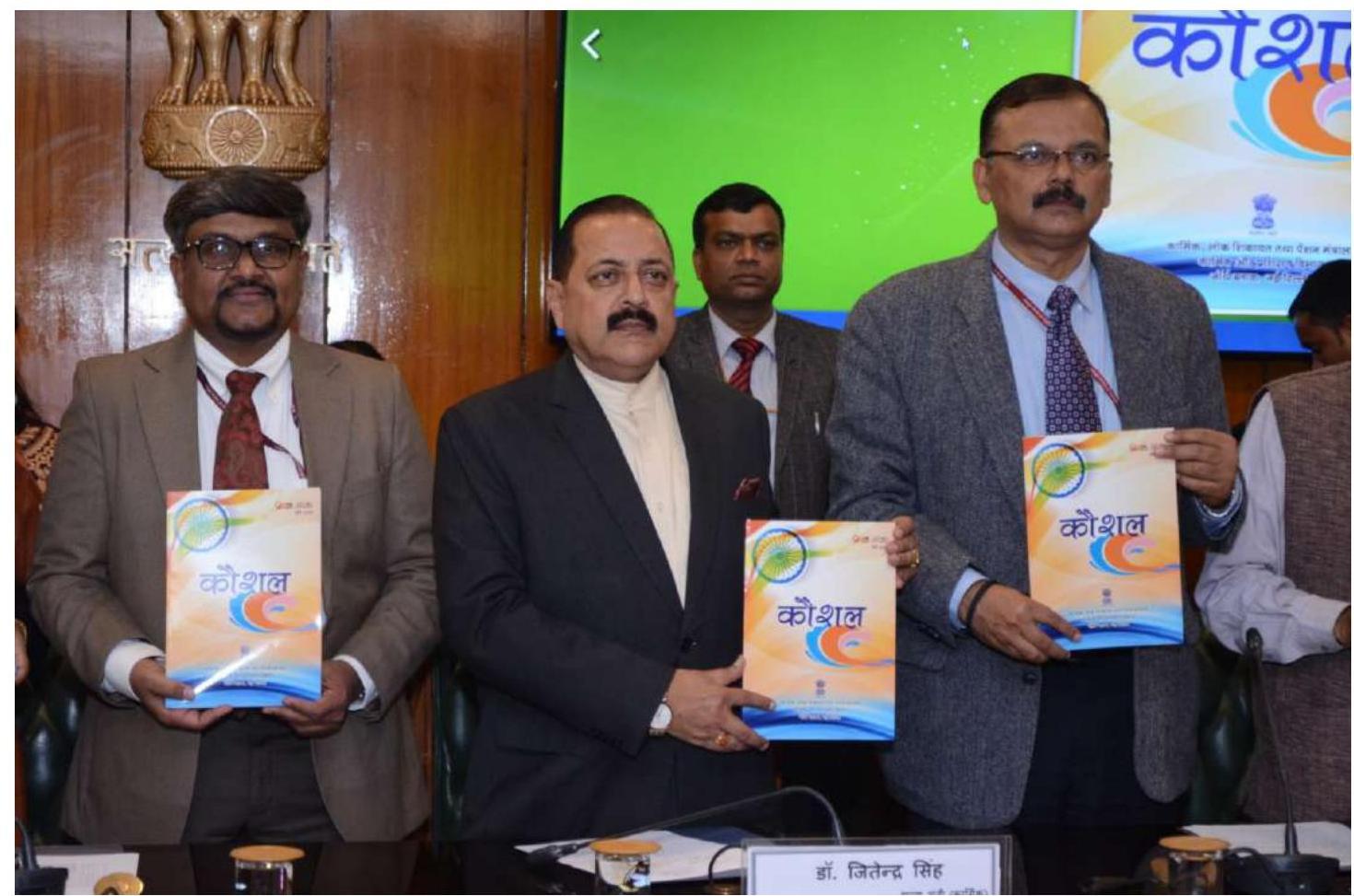
Release of e-Magazine “KAUSHAL” by Hon’ble Minister of State Dr. Jitendra Singh
Financial Management
18.1 Secretariat: The provision is for expenditure of the Ministry of Personnel, Public Grievances & Pensions in respect of:
a) Department of Personnel \& Training which is entrusted with the work relating to framing / interpretation of rules and regulations; recruitment, promotion and reservation policy; induction, training and refresher courses for all levels / grades of Civil Services posts; service conditions, career and manpower planning, vigilance, discipline and welfare activities of Central Government servants; investigation and prosecution in corruption cases and other serious crimes; redressal of grievances of public servants.
b) Department of Administrative Reforms \& Public Grievances which is entrusted with matters relating to Administrative Reforms, O\&M and policy, coordination and redressal of grievances including those pertaining to Central Government Agencies; hosting of Civil Service Day, PM’s Award, Chief Secretaries Conference etc.
c) Department of Pension \& Pensioners Welfare which administers all activities relating
to retirement benefits including Gratuity, Pension, fringe benefits to pensioners, etc.
18.2 Central Bureau of Investigation: The provision is for establishment-related expenditure of the Central Bureau of Investigation which is entrusted with investigation and prosecution in corruption cases against public servants, private persons, firms and other cases of serious crimes. This also includes provision for various projects such as CBI e-Governance, Modernization of Training Centres of CBI, Establishment of Technical and Forensic Support Units, Comprehensive modernization \& purchase of land/ construction of office/ residence buildings for CBI.
18.3 Staff Selection Commission: The provision is for establishment-related expenditure of the Staff Selection Commission including expenditure on the conduct of examinations for recruitment of staff in Central Ministries/ Departments etc.
18.4 Central Administrative Tribunal: The provision is for establishment-related expenditure of the Central Administrative Tribunal which is entrusted with the redressal of grievances exclusively of public servants. This also includes provision for Purchase of Land and Construction of Building for various Benches of CAT.
18.5 ISTM, LBSNAA & Training Division: The provision includes establishment related expenditure of Institute of Secretariat Training \& Management (ISTM), Lal Bahadur Shastri National Academy of Administration (LBSNAA) \& Training Division, DOPT. These Organizations arrange several training programmes including foundation courses, refresher courses, mid-career training, etc. so as to equip all levels / grades of Secretarial functionaries with adequate exposure to the latest rules and regulations, aptitude etc., expenditure on domestic / overseas travel, course fees etc. in respect of CSS / CSSS officials who are to undergo mandatory training at ISTM as a pre-condition for consideration for promotion to next higher grade have also been included centrally in the budget of this Ministry.
18.6 PESB \& CIC: The provision is for establishment related expenditure of Public Enterprises Selection Board and Central Information Commission.
18.7 Lokpal: The provision is for establishment and construction related charged expenditure for Lokpal.
18.8 Loans to AIS Officers: The provision is meant for reimbursement to State Governments towards House Building Advances paid to All India Service Officers.
18.9 Training Schemes: This also includes provision for Training schemes like Training for all, Domestic Funding for Foreign Training, Upgradation of LBSNAA to a Centre of Excellence, and Augmentation of Training Facilities at ISTM.
18.10 Administrative Reforms \& Pensioners’ Scheme: This also includes Scheme provision for Department of Administrative Reforms \& Public Grievances scheme for Modernisation of Government Offices, Pilot projects on Administrative Reforms which consists of promotion of e-governance, fostering of good governance, learning from success, sevottam etc. It also includes allocation for Department of Pension’s scheme “Pensioners Portal”.
18.11 IIPA \& NCGG: This also includes Grants in Aid allocations to Indian Institute of Public Administration and National Centre for Good Governance.
18.12 Autonomous Bodies of DOPT: The provision includes Grants-in-aid assistance to Grih Kalyan Kendra \& Central Civil Services Cultural \& Sports Board.
18.14 RTI: Fund allocations in respect of DOPT’s Propagation of RTI Act.
18.15 Establishment Related
Demand No-72, Ministry of Personnel,Public Grievances & Pensions (Rs. In crore)
| | Actuals | BE | Actuals | RE | BE |
| — | — | — | — | — | — |
| | 2017-18 | 2018-19 | As on $31^{\text {st }}$
Mar, 2019 | 2018-19 | 2019-20 |
| REVENUE | | | | | |
| Administration of Justice (CAT) (Major Head -2014) | | | | | |
| Salary | 78.53 | 83.14 | 86.23 | 86.32 | 89.72 |
| Others | 21.96 | 23.72 | 23.82 | 24.41 | 25.75 |
| Total | 100.49 | 106.86 | 110.05 | 110.73 | 115.47 |
| Public Service Commission(SSC) (Major Head -2051) | | | | | |
| Salary | 29.30 | 31.43 | 32.63 | 32.49 | 34.10 |
| Others | 318.82 | 254.69 | 109.78 | 194.62 | 206.12 |
| Total | 348.12 | 286.12 | 142.42 | 227.11 | 240.22 |
| Secretariat General Services (M/o Personnel, PG \& P) (Major Head -2052) | | | | | |
| Salary | 77.23 | 89.99 | 83.52 | 88.90 | 94.07 |
| Others | 36.17 | 52.18 | 32.49 | 41.80 | 48.66 |
| Total | 113.40 | 142.17 | 116.02 | 130.70 | 142.73 |
| Police- Criminal Investigation and Vigilance (CBI and Interpol \& Coord Wing) (Major Head -2055) | | | | | |
| Salary | 488.78 | 490.11 | 533.42 | 517.51 | 536.81 |
| Others | 129.85 | 124.39 | 157.64 | 169.92 | 148.00 |
| Total | 618.63 | 614.50 | 691.06 | 687.43 | 684.81 |
| Training(LBSNAA, ISTM \& Other Training Schemes) (Major Head -2070) | | | | | |
| Salary | 22.45 | 33.39 | 29.26 | 29.70 | 32.55 |
| Others | 47.17 | 58.19 | 67.57 | 68.48 | 65.34 |
| Total | 69.62 | 91.58 | 96.83 | 98.18 | 97.89 |
| | Actuals | BE | Actuals | RE | BE |
| — | — | — | — | — | — |
| | 2017-18 | 2018-19 | As on $31^{\text {st }}$
Mar, 2019 | 2018-19 | 2019-20 |
| Lok Pal
(Major Head -2062) | | | | | |
| Salary | 0.00 | 1.45 | 0.00 | 0.00 | 29.71 |
| Others | 0.00 | 2.34 | 0.00 | 0.00 | 66.58 |
| Total | 0.00 | 3.79 | 0.00 | 0.00 | 96.29 |
| Other Expenditure (PESB & CIC)
(Major Head -2070) | | | | | |
| Salary | 12.15 | 12.27 | 11.94 | 12.49 | 13.66 |
| Others | 20.32 | 14.27 | 16.16 | 16.79 | 18.35 |
| Total | 32.47 | 26.45 | 28.09 | 29.27 | 32.01 |
| TOTAL (REVENUE) | | | | | |
| Salary | 708.44 | 741.78 | 777.00 | 767.41 | 830.62 |
| Others | 574.28 | 529.77 | 407.46 | 516.01 | 578.80 |
| Total | 1282.72 | 1271.55 | 1184.46 | 1283.42 | 1409.42 |
| CAPITAL | | | | | |
| Capital Outlay on Police
CBI-Motor Vehicles / Machinery \& Equipments
(Major Head -4055) | 2.49 | 2.10 | 1.16 | 2.19 | 4.20 |
| Capital Outlay on Public Works | | | | | |
| Staff Selection Commission (Major Head -4059) | 0.08 | 0.01 | 0.00 | 0.00 | 0.00 |
| CAT- Purchase of land \& Construction of Buildings for various benches of CAT (Major Head- 4059) | 1.88 | 5.00 | 4.48 | 5.00 | 11.05 |
| Lokpal- Construction of Building (Major Head- 4059) | 0.00 | 0.50 | 0.00 | 0.00 | 5.00 |
| Loans \& Advances to State Government HBA to AIS Officers (Major Head -7601) | 11.22 | 1.65 | 0.49 | 0.75 | 1.65 |
| TOTAL (CAPITAL) | 15.66 | 9.26 | 6.13 | 7.94 | 21.90 |
| GRAND TOTAL (GRANT NO 70) | 1298.38 | 1280.81 | 1190.59 | 1291.36 | 1431.32 |
18.16 Details of Central Sector Schemes/ Projects of this Ministry as per Statement of Budget Estimates (SBE) 2019-20
Scheme wise allocations are given below: (Rs. in crores)
| SI. No. | Name of the Scheme | Revenue
Or
Capital | Budget
Estimates
2018-19 | Revised
Estimates
2018-19 | Expenditure
as on 31
Mar, 2018 | Budget
Estimates
2019-20 |
| — | — | — | — | — | — | — |
| 1 | 2 | 3 | 4 | 6 | 7 | 8 |
| I | Training Schemes | | | | | |
| (a) | Training for All – Support
for Training Activities and
Capacity Building for Project
Appraisal | R | 26.00 | 26.00 | 26.00 | 28.00 |
| (b) | Domestic Funding for Foreign
Training | R | 60.00 | 60.00 | 60.00 | 66.00 |
| (c) | Augmentation of Training
Facilities at ISTM | R | 1.00 | 2.83 | 1.54 | 3.00 |
| | | C | 1.00 | 1.00 | 0.06 | 30.77 |
| (d) | Improvement of Infrastructure
and up gradation of Essential
facilities at LBSNAA – Up
gradation of LBSNAA to a
Centre of Excellence | R | 11.00 | 11.00 | 10.86 | 11.00 |
| | | C | 17.75 | 17.75 | 17.74 | 18.00 |
| | Total – Training Schemes | | 116.75 | 118.58 | 116.20 | 156.77 |
| II | Administrative Reforms & Pensioners’ Scheme | | | | | |
| (a) | Plan Schemes for
Administrative Reforms | R | 30.00 | 30.00 | 22.47 | 31.50 |
| (b) | Pensioner’s Portal | R | 6.00 | 5.75 | 5.48 | 6.00 |
| | Total – Administrative Reforms
\& Pensioners’ Scheme | | 36.00 | 35.75 | 27.95 | 37.50 |
| | Total | | 152.75 | 154.33 | 144.15 | 194.27 |
| | Revenue | | 134.00 | 135.58 | 126.35 | 145.50 |
| | Capital | | 18.75 | 18.75 | 17.80 | 48.77 |
18.17 AUDIT OBSERVATIONS IN RESPECT OF MINISTRY OF PERSONNEL, PUBLIC GRIEVANCES & PENSIONS
18.17.2 Comptroller \& Auditor General of India
No C\&AG para is pending in this Ministry
18.17.1 Public Accounts Committee
No PAC para is pending in this Ministry.
18.17.3 Statutory Audit Paras
| S.No. | Name of the office | No. of outstanding paras as on 31/10/2017 |
No. of Outstanding paras as on 31/03/2019 |
|---|---|---|---|
| 1 | Department of Personnel \& Training | 51 | $\mathbf{5 1}$ |
| 2 | Staff Selection Commission | 72 | $\mathbf{3 2}$ |
| 3 | Union Public Service Commission | 5 | $\mathbf{4}$ |
| 4 | Institute of Secretariat Training \& Management | 12 | $\mathbf{8}$ |
| 5 | Department of AR \& PG | 11 | $\mathbf{7}$ |
| 6 | Deptt. of Pensions \& Pensioners’ Welfare | 6 | $\mathbf{9}$ |
| 7 | Lal Bahadur Shastri National Academy of Administration |
9 | $\mathbf{1 7}$ |
| 8 | Central Administrative Tribunal | 37 | $\mathbf{4 1}$ |
| 9 | Central Vigilance Commission | 12 | $\mathbf{1 5 *}$ |
| 10 | Central Information Commission | 9 | $\mathbf{1 4}$ |
| 11 | Central Bureau of Investigation | 139 | $\mathbf{1 7 0}$ |
| Total | 363 | $\mathbf{3 6 8}$ |
*Figures updated till 31/10/2018
All the concerned authorities have been instructed to take steps for early settlement of the audit objections.
Department of Administrative Reforms and Public Grievances
Vision
Excellence in governance for the benefit of all citizens.
Mission
To foster excellence in governance and pursuit of administrative reforms through:
- Improvements in government policies, structures and processes.
- Promoting citizen-centric governance with emphasis on grievance redressal.
- Innovations in e-Governance.
- Documentation and dissemination of best practices.
Objectives
- Promoting administrative reforms in government policies and processes.
- Formulation of policy and coordination of issues relating to redress of grievances.
- Dissemination of governance knowledge and best practices.
- Promoting reforms through e-Governance.
EXECUTIVE SUMMARY
19.0 The Department of Administrative Reforms and Public Grievances is the nodal agency of the Government of India for administrative reforms as well as redressal of public grievances relating to the States in general and those pertaining to Central Government agencies in particular. The Department endeavors to document and disseminate successful governance practices by way of audio-visual media and publications. The Department also undertakes activities in the field of international exchange and cooperation to promote public service reforms.
19.1 The Department is headed by the Secretary, Department of Administrative Reforms & Public Grievances and Pensions \& Pensioners’ Welfare. Available Staff Strength is one Secretary, One Additional Secretary, 2 Joint Secretaries, 7 Directors/Deputy Secretaries and 17 Under Secretary level officers in the Department. There are 7 Divisions in the Department namely Administrative Reforms, Organization \& Methods, e-Governance, Documentation \& Dissemination, International Exchange \& Cooperation, Administration \& Coordination and Public Grievances. An organizational chart of the Department is at Annexure-II. Incumbency
position of Under Secretary and above level officers is at Annexure-III. Information regarding steps taken by this Department for Prevention of sexual harassment of women at workplace and welfare of SC, ST, OBC and Persons with Disability (PWD) are at Annexure-IV and Annexure-V respectively.
19.2 As per the Government of India Allocation of Business Rules, the following subjects have been allocated to the Department of Administrative Reforms & Public Grievances:
- Administrative Reforms, including e-governance and dissemination of best practices.
- Organization and Methods.
- Policy, coordination and monitoring of issues relating to –
(a) Redress of public grievances in general; and
(b) Grievances pertaining to Central Government agencies. - (a) Research in public management;
(b) Liaison with State Governments, professional institutions etc. in public management matters. - Administration of Central Secretariat Manual of Office Procedure:
PERFORMANCE (2018-19)
| SI.No. | Objective | Targeted Activities |
|---|---|---|
| 1. | Formulation of policy and coordination of issues relating to redress of grievances. | (1.1) Review of pendency of grievances in Ministries/ Departments/ Organizations (including all subordinate offices) |
| (1.2) Training of CPGRAMS in Ministries. (1.3) Capability building of State ATIs for bringing in service delivery in their respective State/ Government/ Department. |
||
| 2. | Dissemination of governance knowledge and best practices | (2.1) Providing financial assistance to States/ UTs for professional documentation and dissemination of Good Governance practices. |
| (2.2) Production of documentary films on good governance practices | ||
| (2.3) Publishing of books containing articles on shortlisted and awarded initiatives. | ||
| (2.4) Publication of biannual e-magazine ‘Minimum Government-Maximum Governance’ | ||
| 3. | State Collaboration Initiative | (3.1) DARPG has sanctioned 41 projects till date in various States/UTs. |
| SI.No. | Objective | Targeted Activities |
| — | — | — |
| 4. | Redress of public grievance | (4.1) Total no of public grievances disposed of in $2018-14,98,519$. |
| 5. | Promoting reforms through
e-Governance | (5.1) Organizing National Conference on e-Governance and National Awards. |
| | | (5.2) Publishing of Compendium of select papers on issues of e-Governance, a booklet on excellence in e-Governance, a booklet on citations for National e-Governance Award Winners, and a compilation of conference papers |
| 6.* | Transparency/Service delivery in the Department | (6.1) A Pilot Project of Study of Citizens’ Charters of two Ministries/Departments viz., Ministry of External Affairs (MEA) and Central Board of Direct Taxes (CBDT) was conducted through Quality Council of India (QCI) for improvement of public service delivery through effective implementation of Citizens’ Charter
(6.2) The single objective of the Project was to undertake a diagnostic study of services provided by these two Ministries/Departments with a view to enhancing the respective Citizens’ Charters by making it more citizen-centric.
(6.3) The Citizens’ Charter of 80 Ministries/ Departments are available on goicharters.nic.in. |
| 7.* | Administrative Reforms | (7.1) Prime Minister’s Awards for Excellence in Public Administration.
(7.2) Organising Civil Services Day.
(7.3) Development of case studies on best practices.
(7.4) Promotion of Administrative Reforms through simplification of procedure such as abolition of affidavits and promotion of self certification.
(7.5) Develop Good Governance Index, recommended by Sectoral Group of Secretaries on Governnance to present a state-wise comparative picture about the strong and week areas of service delivery, which would help them in generating performance improvement mechanism. |
| SI.No. | Objective | Targeted Activities |
|---|---|---|
| 8.* | Improving Internal Efficiency/ Responsiveness. |
(8.1) Update departmental strategy to align with Plan priorities/objectives of the Scheme. |
| 9.* | Ensuring compliance to the Financial Accountability Framework |
(9.1) Timely submission of Action Taken Notes on Audit paras of C&AG. (9.2) Timely submission of Action Taken Reports to the PAC Sectt. on PAC Reports. |
| 10. | e-Office Progress | (10.1) 43 Central Ministries and Departments have already achieved the target of complete e-Office. |
| 11. | National Centre for Good Governance (NCGG) |
(11.1) The Centre is envisaged to be the apex think- tank that would guide the Government and help in implementing good Governance reforms. |
- Mandatory objectives
19.3 FUNCTIONS
(i) Matters relating to administrative reforms.
(ii) Organization of Civil Services Day and Prime Minister’s Awards for Excellence in Public Administration.
(iii) Capacity building, change management and Government Process Re-engineering to provide reform through e-Governance.
(iv) e-Office Mission Mode Project under NeGP.
(v) Organisation of National Conference on e-Governance and National awards on e-Governance.
(vi) Management of Public Grievance Redressal Mechanism.
(vii) Documentation and dissemination of Good Governance Practices – innovations, adaptation and replication.
Important events/achievements of the Department
19.4 Promoting Prime Minister’s Awards for Excellence in Public Adminstration
The Prime Minister’s Awards for Excellence in Public Administration are awarded by Hon’ble Prime Minister of India to select districts and implementing units under various categories. On 21st April, 2018, Hon’ble Prime Minister presented the Prime Minister’s Awards for Excellence in Public Administration to selected districts and implementing units under various categories. Hon’ble Prime Minister conferred Awards to 11 best performing districts in implementation of priority programmes namely (i) Pradhan Mantri Fasal Bima Yojana (ii) Deen Dayal Upadhayay Grameen Kaushalya Yojana, (iii) Pradhan Mantri Awas Yojana (Gramin \& Urban) and (iv) Promoting Digital Payments. Two Awards were also conferred
under Innovation category, one of which was for an ‘Aspirational district’.
19.5 PUBLIC GRIEVANCES
19.5.1. An online system for grievance redress, called the ‘Centralized Public Grievance Redress and Monitoring System (CPGRAMS) has evolved since 2007. At present its upgraded version 6.0 is in operation w.e.f. 04.01.2018 and is accessible at http://pgportal.gov.in and also through www. darpg.gov.in.
19.5.2. During the year, the Division has extensively used the System to forward public grievances to both the Central Government Ministries/Departments/Organisations as well as the State Governments concerned. The inflow of both centre and State related grievances is in two forms (i) through the CPGRAMS and (ii) through post. The grievances received by post are digitized and sent online through the System as well as by post to the Central Ministries/Departments/ Organisations/State Government concerned.
19.5.3. Dashboard have been created for all the head of the Ministries/Departments for accessing the relevant information pertaining to pendency of grievances in the respective Ministries/ Departments and sub-ordinate organizations affiliated to them on CPGRAMS. User-id and passwords have been duly provided to all concerned.
19.5.4. For better monitoring, the format of analytical reports generated online through CPGRAMS has been duly modified and additional reports created for the purpose. The colour coding
of the Ministries/Departments have been done as per their performance on CPGRAMS. The format includes receipts, disposal and % disposals with reference to cases pending for 2-6 months, 6-12 months and more than one year.
19.5.5. A Project Management Unit (PMU) was set up in the Department for monitoring the reforms suggested in the study reports on the Grievance Analysis Study conducted by Quality Council of India for identifying grievance prone areas, root cause analysis and systemic reforms. The PMU recommended 81 reforms out of which 35 reforms have been implemented. An online Dashboard was launched by the MoS(PP) on 11.4.2018 for monitoring further action on the reforms recommended by PMU which is accessible at “pgportal.gov.in”.
19.5.6. Public Grievances Call Centre was operated through NICSI w.e.f. February, 2016 on pilot basis till $31^{\text {st }}$ March, 2019 for reminding the concerned officials of 40 Ministries/Departments/ Organizations to expedite the disposal of grievance petitions pending for more than two months. The PG Call Centre has also collected feedback from the petitioners on some of the grievances disposed through CPGRAMS.
19.5.7. Public Grievance Mechanism of PMO available on website www.pmoindia.gov.in has been integrated with the pgportal.gov.in. This enables transfer of grievances lodged to the PMO to the Central Ministries/Departments/Organisations and State Governments and monitoring of public grievances through online CPGRAMS.
19.5.8. The Public interface of “pgportal.gov.in”
has been duly integrated with the pensioners’ portal and an option has been provided to the users to lodge pension related grievances to the pensioners’ portal by clicking the relevant option on the pg portal. This prevents the lodging of same grievance on pg portal and pensioner’s portal thus avoiding duplication.
19.5.9. A Mobile App has been made available in the pg portal allowing lodging of public grievances from android based mobile. The Action Status can also be viewed on the mobile itself. A new Mobile App with some added features has been developed and has been integrated with Unified Mobile Application for New-age Governance (UMANG).
19.5.10. Operational trainings on Centralized Public Grievance Redress and Monitoring System (CPGRAMS) have been held regularly on the new features of CPGRAMS. 375 official have been trained during the period 1.4.2018 to 31.3.2019.
19.5.11. During the period from 2018-19, a total of ten intensive review meetings including meetings through Video Conferencing Sessions have been held for reviewing the status of pending public grievances in Ministries/Departments/ organisations and expediting action on them.
19.5.12. An Award Scheme was launched for recognizing outstanding performance on CPGRAMS through issue of Certificate of Appreciation. The Scheme not only takes into consideration the number of grievances disposed by the Ministries/Departments/Organizations, but also the feedback of the petitioners whose grievances have been closed in the System. Upto
December, 2018, 30 Certificates of Appreciation has been awarded. Certificate of appreciation was awarded by MoS (PP) to 9 Ministries/ Departments/ Organizations listed on CPGRAMS for the first and second quarter of 2018 viz. NITI Ayog, M/o Textiles, M/o Labour, D/o Administrative Reforms and Public Grievances, D/o Science and Technology and D/o Defence Finance, D/o Investment and Public Asset Management, Ministry of Textiles, UIDAI.
19.6 Citizens’ Charter
19.6.1 The Department of Administrative Reforms and Public Grievances in its efforts to provide more responsive and citizenfriendly governance, coordinates the efforts to formulate and operationalise Citizen’s Charters in Central Government, State Governments and UT Administrations. It provides guidelines for formulation and implementation of the Citizen’s Charters as well as their evaluation. The Citizen’s/Client’s Charter (CC) was first introduced simultaneously in Central Departments and in all State Governments in May, 1997. The Citizen’s/ Client’s Charter of DARPG has been reviewed and updated in February, 2019 which has been uploaded on the website of the Department as well as on the “goicharters.nic.in”. A copy of updated Citizen Charter of DARPG is at Annexure.VI.
19.7 Sevottam
19.7.1 Sevottam is a generic framework for achieving excellence in public service delivery. It comprises of 3 modules namely, Citizen’s Charter, Grievance Redressal Mechanism and Capability Building for Service Delivery. As part of the Strategic
Plan for Capability Building towards implementing Sevottam QMS, a Scheme for Strengthening of State ATIs/CTIs was implemented during the $12^{\text {th }}$ Five Year Plan 2012-2017 by establishing a Sevottam Training Cell in ATIs/Govt. approved Training Institutions in 10 States. This Scheme has been extended for a further period of 3 years till 31.03.2020.
19.8 INTERNATIONAL EXCHANGE AND COOPERATION:
19.8.1 The Department works as the nodal point in respect of matters relating to international cooperation in the field of Public Administration and Governance, which includes organizing programmes and visits of the foreign delegations to India and visits of Indian delegations abroad as part of projects / bilateral measures taken up in accordance with the Memorandum of Understandings (MOUs)/Agreements signed between India and other countries (bilateral or multilateral).
19.8.2 Department of Administrative Reforms and Public Grievances as the institutional member and Board member of Commonwealth Association for Public Administration and Management (CAPAM) is actively engaged with various strategic programmes and activities of CAPAM in promoting good governance across the Commonwealth.
19.8.3 Under Capacity Building in the field of Public Administration and Governance, the Department has organized three customized short-term Foreign Training Programmes on the theme ‘Minimum Government with Maximum Governance’ through e-Governance based Citizen Centric On-line Services, for officers from Government of India and the States/UTs, including
PM Award winners/National e- Governance Award winners in the Korea Development Institute (KDI), Seoul, South Korea in May-June, 2018, Maxwell Syracuse University, New York, USA in November, 2018 and Duke Centre for International Develoment (DCID), Duke University, Durham, USA during January, 2019.
19.8.4 Department has signed/renewed an Memorandum of Understanding (MoU) with the Public Service Division of the Republic of Singapore on Cooperation in the field of Personnel Management and Public Administration on $1^{\text {st }}$ June, 2018.
19.8.5 CAPAM International Innovation Awards Programme was held in conjunction with CAPAM Biennial conference during 22-24 October, 2018 at Georgetown, Guyana. Out of the four categories, India won awards in 2 categories. The initiative entitled Unnayan Banka- Reinventing Education Using Technology of Banka District, State of Bihar has been selected under the Category “Innovation Incubation”. Another initiative entitled Unified Agriculture Markets, Co-operation Department of Government of Karnataka has also been selected under the Category ‘Innovation in Public Service Management’ and India won gold medal to this initiative.
19.9 Promoting Adoption of Selfdeclaration and Self-attestation
DARPG has pursued with Ministries/Departments of the Govt. of India and the State/UTs to review the requirement of Affidavits and Attestation by Gazetted Officers in various application forms. About 58 Ministries/Department of the Central Government and majority of the States/UTs have already abolished requirement of Affidavit and
Attestation by Gazetted officers except where it is required under a statute.
19.10 Minimum Government Maximum Governance Initiatives (implementation of e-office-Mission Mode Project)
e-Office is one of the Mission Mode Projects (MMPs), under the National e-Governance Plan (NeGP). The project is aimed at significantly improving the operational efficiency of Central Government Ministries and Departments through improvement in the workflow mechanisms and associated with office procedure manuals. The DAR&PG is the nodal agency for implementing the project “e-Office”. Effective steps have been taken to expedite implementation of e-office in Central Government Ministries/Departments. 43 Central Ministries and Departments have already implemented e-Office fully and about 31 Central Ministries/Departments have also started showing improving trends.
19.11 INITIATIVE FOR SWACHHATA PAKHWADA:
19.11.1 DAR\&PG undertook massive cleanliness drive and activities during the Swachhata Pakhwada w.e.f. $15^{\text {th }}$ September to $30^{\text {th }}$ September, 2018. The Department undertook various activities for cleanliness of office premises, canteens, toilets, and surrounding areas adjacent to the building during the programme. Poster(s) Competition was organized on the theme ‘Swacch Bharat’ by the Department on this occasion.
19.12 Promoting Documentation and Dissemmination of Good Governance Initiatives
The Documentation and Dissemination Division of the Department primarily carries out the activities of documentation and dissemination of good governance practices of Central and State Governments and Union Territory Administration with a view to facilitate sharing of experience with one another and replication elsewhere.
This Department brings out its e- Magazine titled ‘Minimum Government – Maximum Governance’ (MGMG) as an e-Book in its endeavors to document and disseminate successful good governance practices. In the e- Magazine, write-ups based on the shortlisted initiatives as listed at Annexure. VII of PM Awards and National e- Governance Awards instituted by DARPG have been compiled. It is published on the website of the Department in e-Book form biannually.
19.13 Promoting e-Governance (National e-Goverance Awards)
The Department of Administrative Reforms \& Public Grievances along with the Ministry of Electronics and Information Technology, in association with one of the State Governments, has been organizing the National Conference on e-Governance every year since 1997. This conference provides platform for the senior officers of the Government including IT Secretaries of State Governments, IT Managers of the Central Government, and resource persons, experts, intellectuals from the industry and academic institutions, etc. to discuss, exchange views and experiences relating to various e-Governance initiatives. This year the Award Ceremony for distribution of National Awards for e-Governance 2018-19 has been organized on $27^{\text {th }}$ February, 2019 at Dr. B. R Ambedkar International Convention Centre, New Delhi. Awards were given under 6
categories to recognize achievements in the area of e-Governance. A list of Awarded Projects is as under:-
Awarded Projects
| S.No. | Award | Project Name | State |
|---|---|---|---|
| Category-I: Excellence in Government Process Re-engineering for Digital Transformation | |||
| 1 | GOLD | Digital Land (Comprehensive System of Land Management) | Uttar Pradesh |
| 2 | SILVER | Khanij Online | Chhattisgarh |
| 3 | SPECIAL JURY AWARD | IRCTC Rail Connect Mobile App | Delhi/Gol |
| Category- II: Excellence in providing Citizen – Centric Delivery | |||
| 4 | GOLD | UMANG | Delhi/Gol |
| 5 | SILVER | MahaRERA | Maharashtra |
| 6 | SILVER | National Scholarship Portal 2.0 | Gol/Delhi |
| Category-III: Excellence in District level initiative in e-Governance i. North-East States + Hilly States ii. UTs (including Delhi) iii. Other States | |||
| 7 | GOLD | MDDA ERP | Sub category (i) | Uttarakhand |
| 8 | SILVER | Hello Doctor-555 |
| Uttarakhand |
| 9 | GOLD | Punarvas | Sub category (iii) | Andhra Pradesh |
| Category IV: Outstanding research on Citizen Centric Services by Academic/ Research Institutions | |||
| 10 | GOLD | Wind power forecasting services for the Whole state of Tamil Nadu | | Tamil Nadu/Gol |
| 11 | SILVER | Targeted Intervention to Expand and Strengthen TB Control Among the Tribal Populations under RNTCP, India | | Uttar Pradesh/Gol |
| Category V: Innovative Use of ICT in e-Governance solutions by Startups [Startup as defined by Department of Industrial Policy and Promotion (DIPP) Government of India] | |||
| 12 | SILVER | www.chemicals4construction.com | | Gujarat |
| Category VI: Excellence in Adopting Emerging Technologies | |||
| 13 | GOLD | Ultra Resolution UAV based Geo-ICT enabled Property Tax management system for Municipal area of Bhiwani | | Haryana |
| 14 | SILVER | iStart Rajasthan | | Rajasthan |
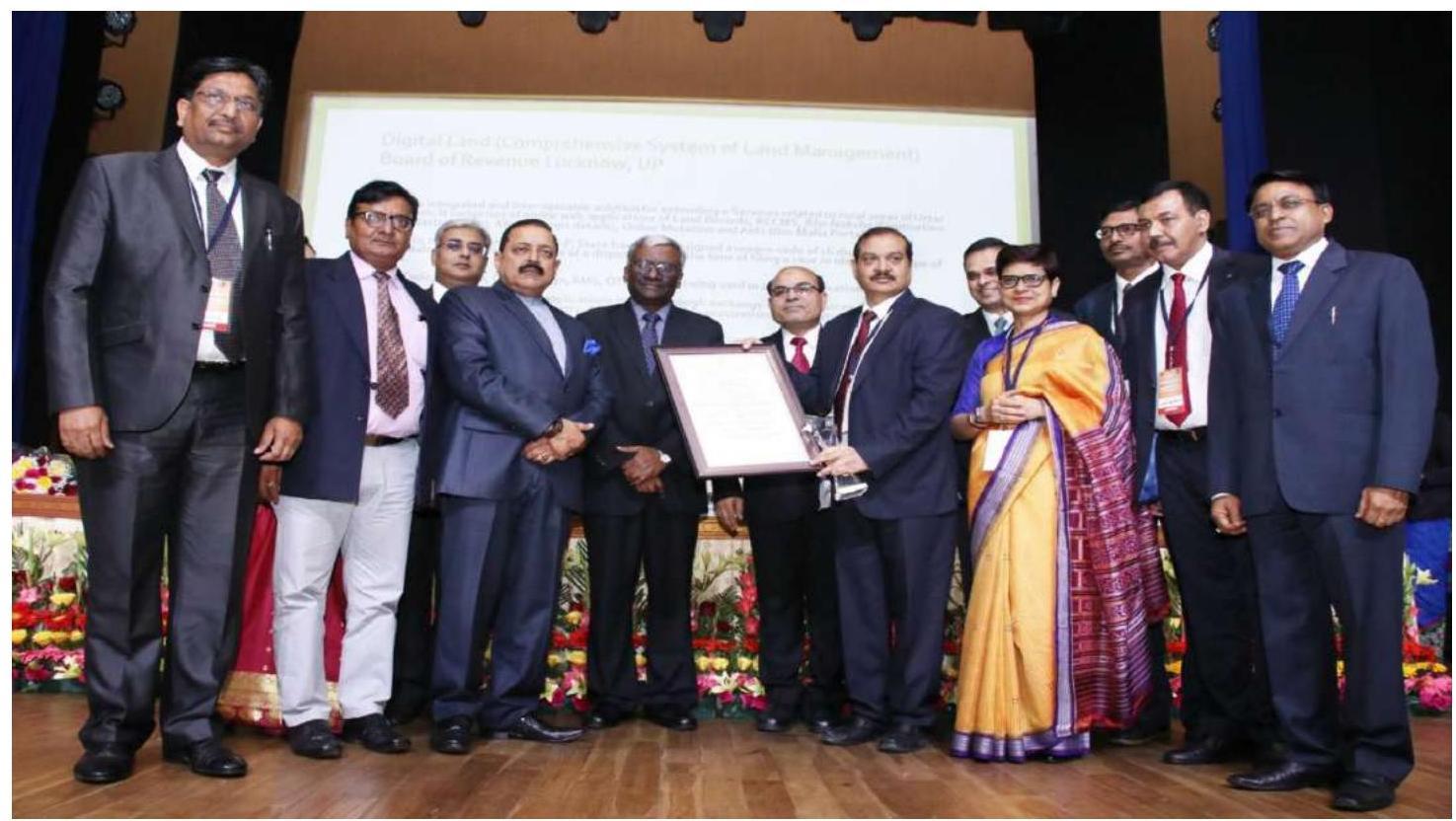
The Digital Land (Comprehensive System of Land Management) team led by Shri Pravir Kumar (Project Head) accepting the Gold award for the category Excellence in Government Process Re-engineering for Digital Transformation
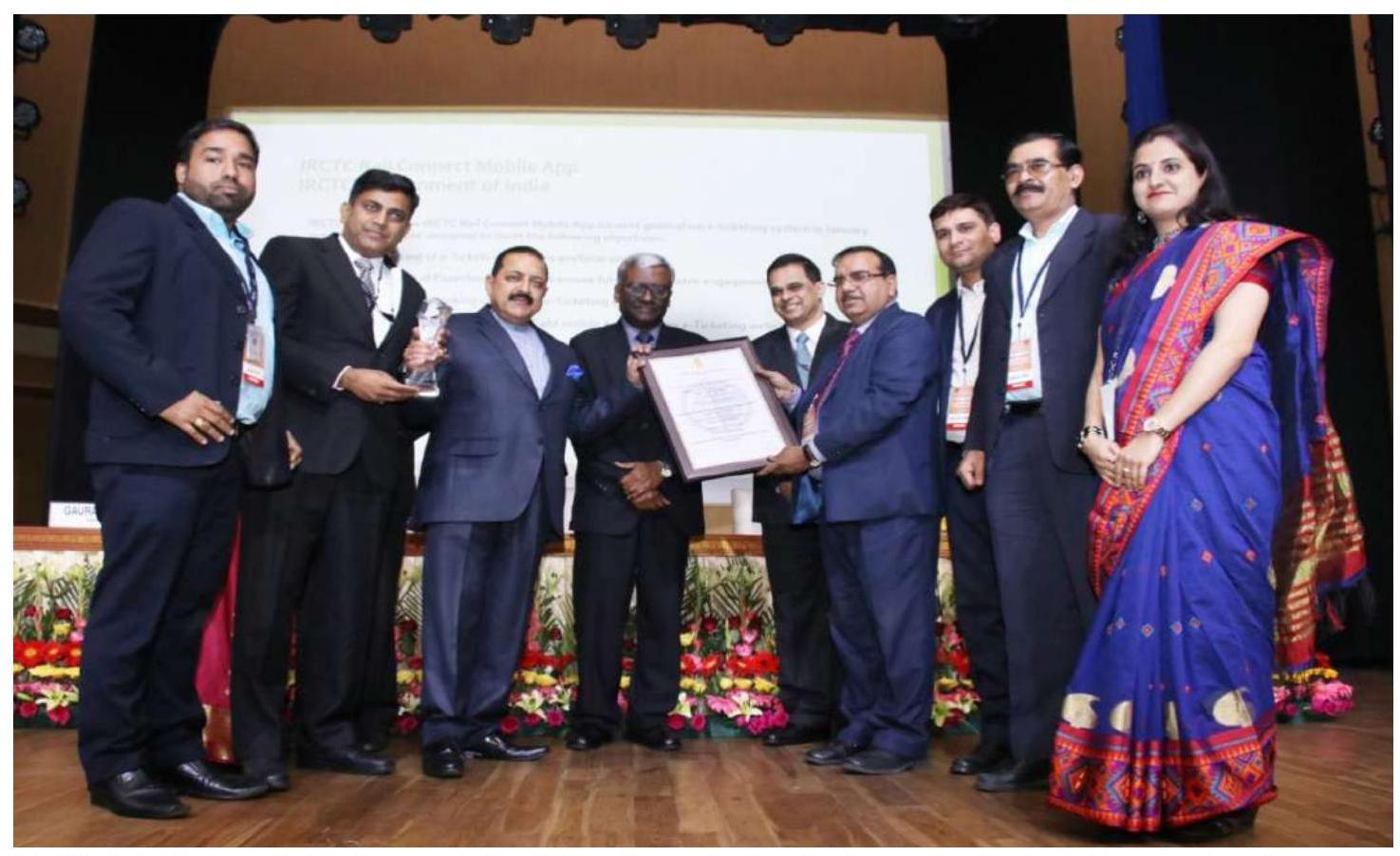
The IRCTC Rail Connect Mobile App team led by Shri Sunil Kumar (Project Head) accepting the Special Jury award for the category Excellence in Government Process Re-engineering for Digital Transformation
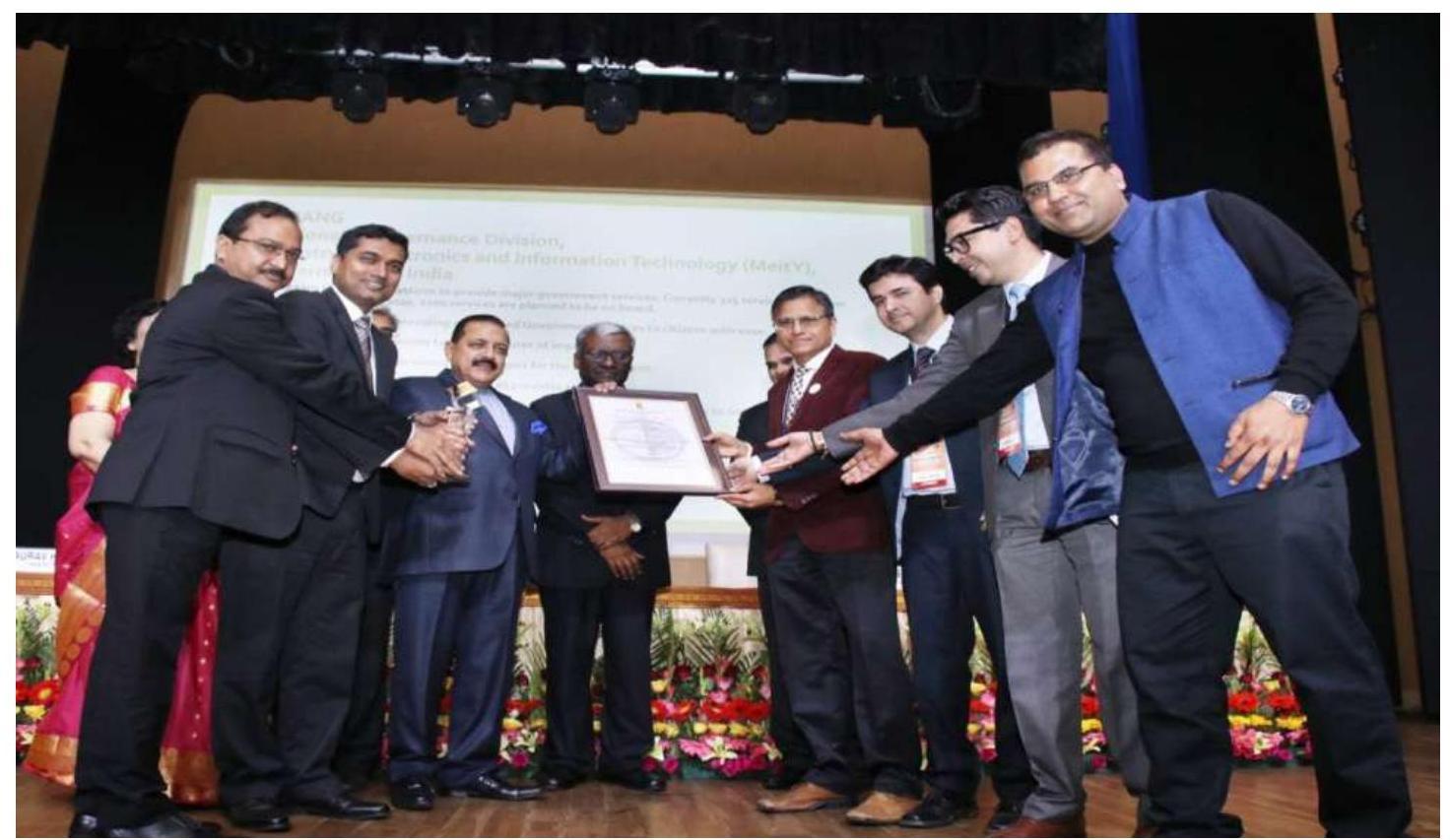
The UMANG team led by Shri Neeraj Kumar (Project Head) accepting the Gold award for the category Excellence in providing Citizen-Centric Delivery
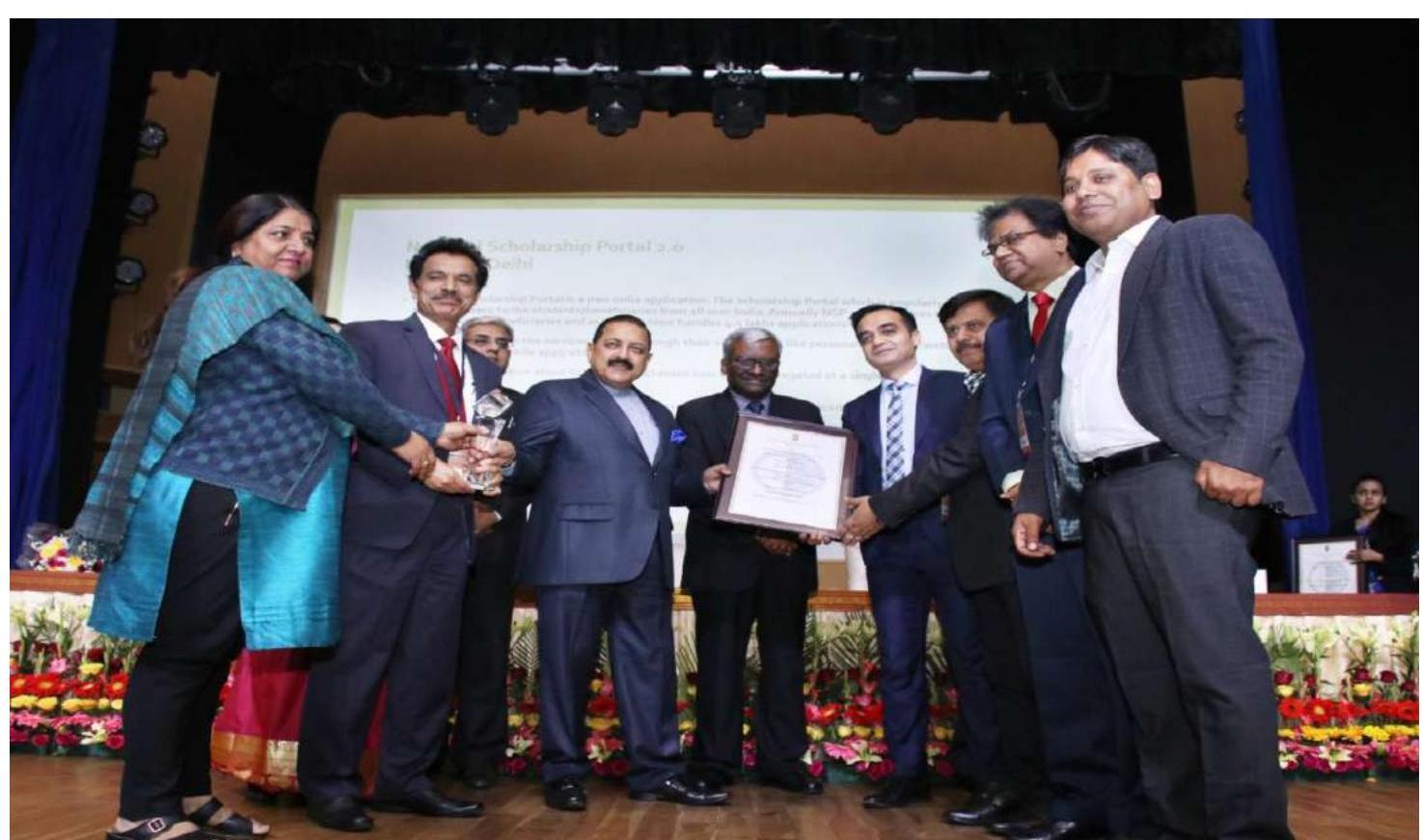
The National Scholarship Portal 2.0 team led by Shri S.B. Singh (Project Head) accepting the Silver award for the category Excellence in providing Citizen-Centric Delivery
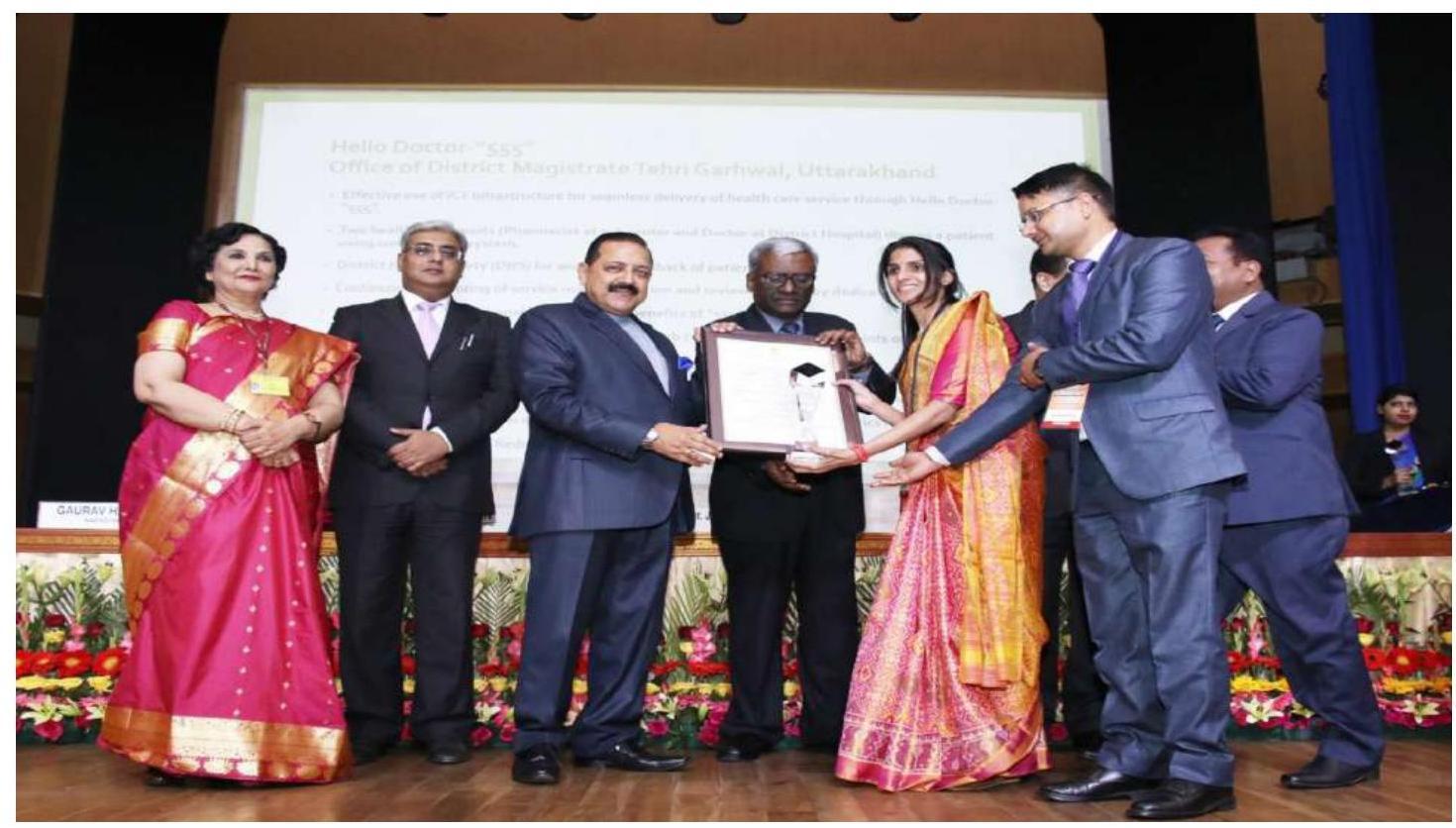
The Hello Doctor 555 team led by Ms. Sonika (Project Head) accepting the Silver award for the category Excellence in District level initiative in e-Governance i. North-East States + Hilly States ii. UTs (including Delhi) iii. Other States
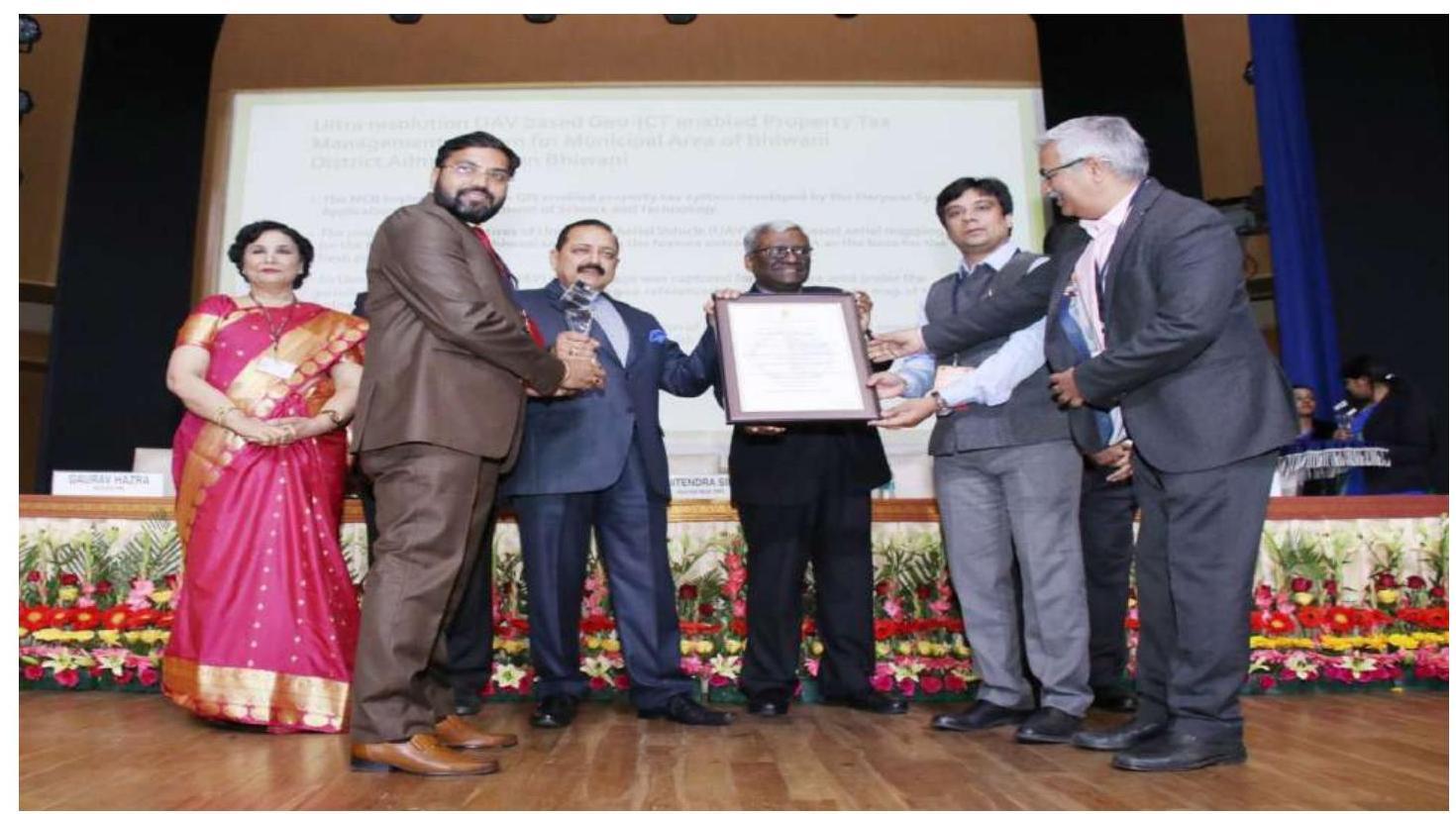
The Ultra Resolution UAV based Geo-ICT enabled Property Tax management system for Municipal area of Bhiwani team led by Shri. Anshaj Singh (Project Head) accepting the Gold award for the category Excellence in Adopting Emerging Technologies.
19.14 CELEBRATION OF INTERNATIONAL DAY OF YOGA
19.14.1 DARPG celebrated $4^{\text {th }}$ International Day of Yoga on $21^{\text {st }}$ June, 2018. In this connection, regular Yoga classes in the premises of $5^{\text {th }}$ Floor, Sardar Patel Bhawan during the month of June, 2018 where
all senior officers including Secretary, AR&PG and other officers/officials participated. Officer/officials of this Department also participated in the $4^{\text {rd }}$ International Day of Yoga held on $21^{\text {st }}$ June, 2018 at different places.
20
CHAPTER
Administrative Reforms
Civil Services Day, 2018 and Prime Minister’s Awards Scheme for Excellence in Public Administration
20.1 Government of India celebrates April 21 every year as ‘Civil Services Day’ to rededicate themselves to the cause of citizens and renew their commitment to public service and excellence in work. This date coincides with the date when the first Home Minister of Independent India Sardar Vallabhbhai Patel addressed the first batch of Indian Administrative Service Officers at Metcalfe House New Delhi. The first such function was held in Vigyan Bhavan, New Delhi on $21^{\text {st }}$ April, 2006. On this occasion, the Hon’ble Prime Minister conferred “Prime Minister’s Awards for Excellence in Public Administration” to acknowledge, recognize and award the extraordinary and innovative work done by officers of the Central and State Governments including Districts.
20.2 12 th Civil Services Day event was organized on 20-21 April 2018 at Vigyan Bhavan, New Delhi and inaugurated by Hon’ble Vice President of India on $20^{\text {th }}$ April 2018. On $21^{\text {st }}$ April, 2018, panel discussions in plenary and breakaway sessions on Aspirational districts, identified priority programmes followed by a Wrap up session were organized on the day. On $21^{\text {st }}$ April 2018, the programme included a plenary session on “Artificial Intelligence for Effective Governance”.
Two documentary films namely ‘A film on Journey of PM’s Awards’ and ‘New India- Shaping the Future’ were screened during the event.
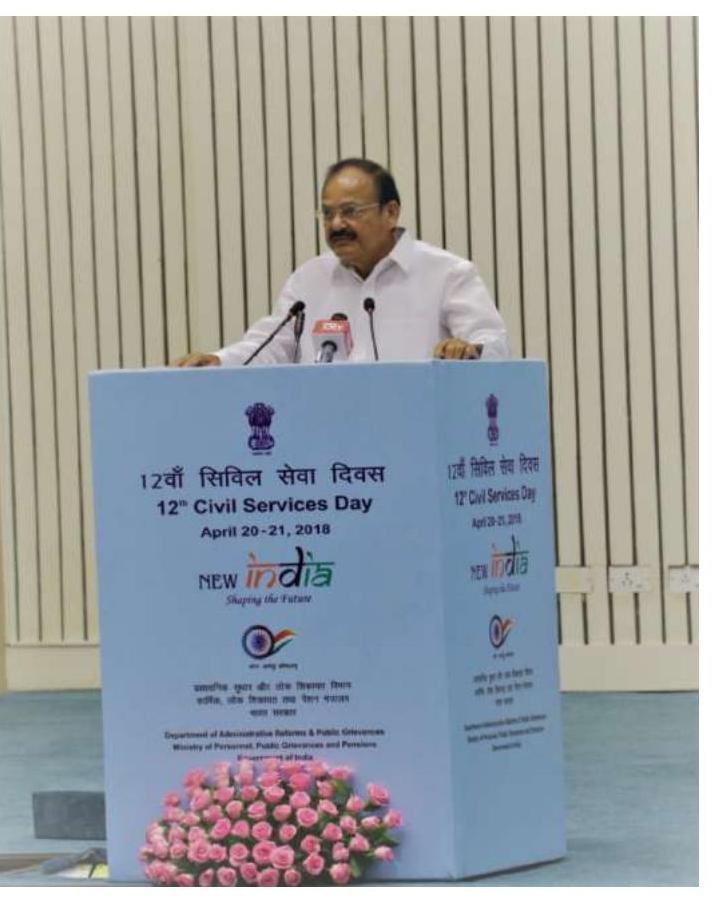
Hon’ble Vice-President of India inaugurating the 12th Civil Service Day function at Vigyan Bhavan New Delhi on $20^{\text {th }}$ April, 2018
Prime Minister’s Awards for Excellence in Public Administration, 2018
20.3 The Prime Minister’s Awards for Excellence in Public Administration were awarded by Hon’ble Prime Minister of India to select districts and implementing units under various categories on $21^{\text {st }}$ April, 2018. Hon’ble Prime Minister conferred
Awards to 11 best performing districts in implementation of priority programmes namely (i) Pradhan Mantri Fasal Bima Yojana (ii) Deen Dayal Upadhayay Grameen Kaushalya Yojana, (iii) Pradhan Mantri Awas Yojana (Gramin & Urban) and (iv) Promoting Digital Payments. Two Awards were also conferred under Innovation category, one of which was for an ‘Aspirational district’.
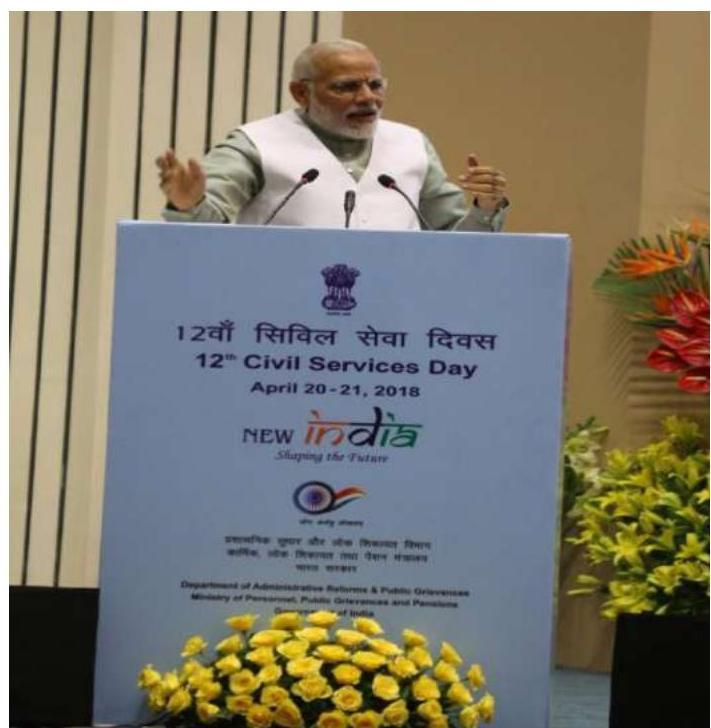
Hon’ble Prime Minister addressing the $12^{\text {th }}$ Civil Services Day function in New Delhi on $21^{\text {st }}$ April, 2018
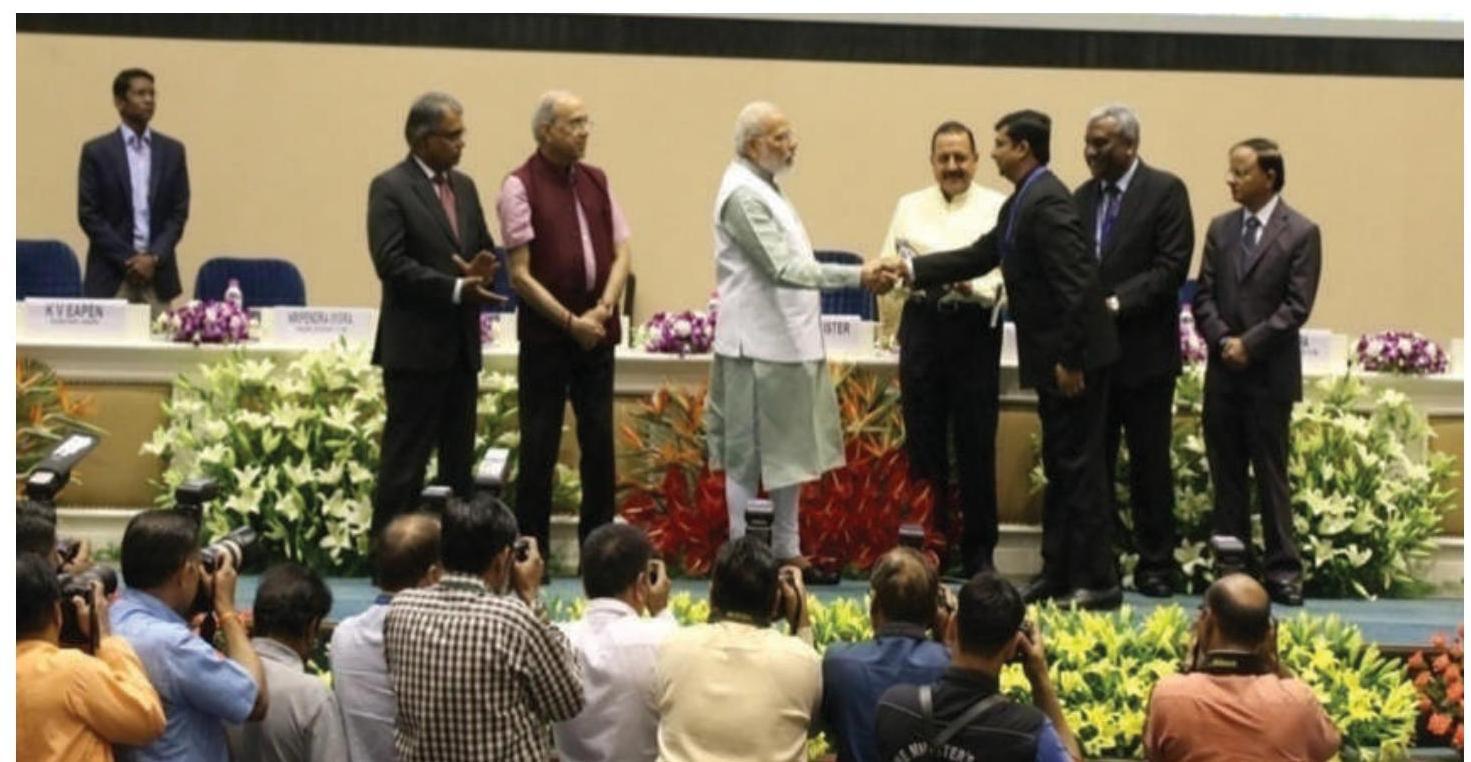
Hon’ble Prime Minister presenting the PM Awards for Excellence in Public Administration in New Delhi on $21^{\text {st }}$ April, 2018
20.4 A new category of awards for Additional Secretary/Joint Secretary level officers and Director/Deputy Secretary serving in Government of India was also introduced in 2018 to recognize their contribution towards bringing about
transformational improvements in processes/ systems through simplification, process reengineering etc. Two awards were conferred in this category.
20.5 Application for PM Awards is received online on a designated portal and evaluated by three hierarchical Committees i.e. Screening Committee chaired by Additional Secretary level officers, Expert Committee chaired by Secretary, Department of AR&PG and Empowered Committee chaired by Cabinet Secretary. Citizens’ feedback of shortlisted Districts/Organizations obtained through Call Centre, spot study reports and presentation/interaction by the Districts etc. are taken into account while selecting the candidates for PM Awards.
State Collaboration Initiatives
20.6 DARPG provides funds to the State Governments under the scheme “State Collaboration Initiatives” with a purpose to build collaboration with State Governments for improving public service delivery. The scheme was revised in 2015-16 to include funding for replication of PM awarded and National e-Governance awarded initiatives.
20.6.1 The objective of the State Collaboration Initiative is to promote and support improvement in public administration for improving service delivery through a programmatic approach which will:
i. Develop collaborative relationships with central ministries, states and other stakeholders
ii. Develop a coherent programme of initiatives which will support and encourage administrative reform and put citizen at centre stage, particularly the poor
iii. Build capacity at district, state and centre to ensure optimal use of systems and resources.
Good Governance Index
20.7 Department of Administrative Reform and Public Grievances (DARPG), GOI has taken a lead in developing the proposed Good Governance Index (GGI) recommended by Group of Secretaries (GoS) on Governance. The proposed Good Governance Index (GGI) would not only present a comparative picture but also yield valuable state-wise insights about their strong and weak areas of service delivery, which would help them in generating performance improvement mechanism.
20.7.1 The parameters of Good Governance are being developed through consultation with various stakeholders. A brief detail of activities undertaken as part of consultation is provided below:
National Consultative Meeting:
A one-day national consultative meeting was organised at Centre for Good Goverannce (CGG), Hyderabad on 04 May 2017 chaired by Secretary, DARPG, Gol. The purpose of the meeting was to present CGG’s approach and methodology for design and development of Good Governance Index (GGI) and to seek inputs for refinement in the same.
Meeting with Ministries of Government of India
Three rounds of consultations [(i) 01-02 June, 2017 (ii) 08 June, 2017 (iii) 15-16 June,2017] have been undertaken with 25 Ministries of Government of India. The purpose of the meetings was to
understand their mandate/priorities and focus to achieve Good Governance as well as a wide range of state/district-level data to identify suitable indicators which are output and outcome oriented.
State-Level Consultations
- The purpose of the consultation was to seek state’s feedback/comments/suggestions on indicators and make necessary amendments, if needed.
- Regional conference involving Northern states organized by the DARPG, Gol at Nainital during 07-08 July 2017. Second conference involving remaining states was organized on 22 July 2017 at CGG, Hyderabad. Third conference was organized by the DARPG, Gol at Goa during 14-15 September 2017. Fourth consultation was done at Guwahati during 22-23 December 2017.
National Centre for Good Governance (NCGG)
20.8
National Centre for Good Governance was established as an autonomous institute under the aegis of the Department of Personnel and Training by upgrading the erstwhile National Institute of Administrative Research, Lal Bahadur Shastri National Academy of Administration, Mussoorie. DARPG is an administrative authority for NCGG from 8.11.2017. NCGG has been administratively transferred from DoP&T to DARPG on 08.11.2017.
20.8.1
The Centre is envisaged to be the apex think-tank that would guide the Government and help in implementing good Governance reforms. It seeks to be a high-level institute for research and capacity building to deal with the entire gamut of governance issues from the National to State to the local level and in sectors across the Government.
20.8.2
NCGG is governed by a Governing Body, under the Chairmanship of the Cabinet Secretary, Gol and a Management Committee with Secretary, Department of Administrative Reforms and Public Grievances (DARPG), Gol as the Chairperson.
Objectives of NCGG
- To be a think tank for governance & policy reforms, cutting across administrative, social, economic, and financial spheres.
- To function as a national repository on information on best practices, initiatives, and methodologies that promote Good Governance, E-Governance, innovation, and change management within the government.
- To initiate and participate in action research and capacity building on various aspects of regulatory and development administration, public policy, governance, and public management at National/State & local levels.
- To advise on key issues in governance and development synergy across various Ministries/Departments of Gol and State Governments.
- To promote sharing and replication of innovative ideas and best practices in Governance.
- To interact with national and international organizations, in and outside government, engaged in research and capacity building in the above spheres.
Mandate of NCGG
To promote Good Governance by:
- Carrying out Action Research/ Studies on issues relating to governance.
- Capacity Building on Public Policy and Governance at both National and International level.
- Organizing consultations, workshops, seminars & talks to promote improved governance.
Undertaking initiatives for citizen centric governance.
Activities of NCGG
Capacity Building Training Programmes (CBTP) on Public Policy and Governance for Neighboring Countries
International
- NCGG has been conducting Capacity Building Training Programme (CBTP) for the civil servants
of Bangladesh, Myanmar \& Maldives entrusted by Ministry of External Affairs (MEA), Govt. of India. - NCGG is also conducting Capacity Building Training Programme (CBTP) for the civil servants of Gambia.
Capacity Building Training Programmes (CBTP) on Public Policy and Governance for the States/ UTs
National
- NCGG has been conducting Training Programmes on Public Policy and Governance for the Officers of State Civil Servants for Odisha, Madhya Pradesh, Rajasthan, Manipur, Mizoram\& Sikkim.
- NCGG is currently engaged to train the officers from Government of Gujarat on Comprehensive Training Programme – Public Private Partnerships (PPP).
- Capacity Building Training/Workshops for the Govt. officers on SDGs (Proposed).
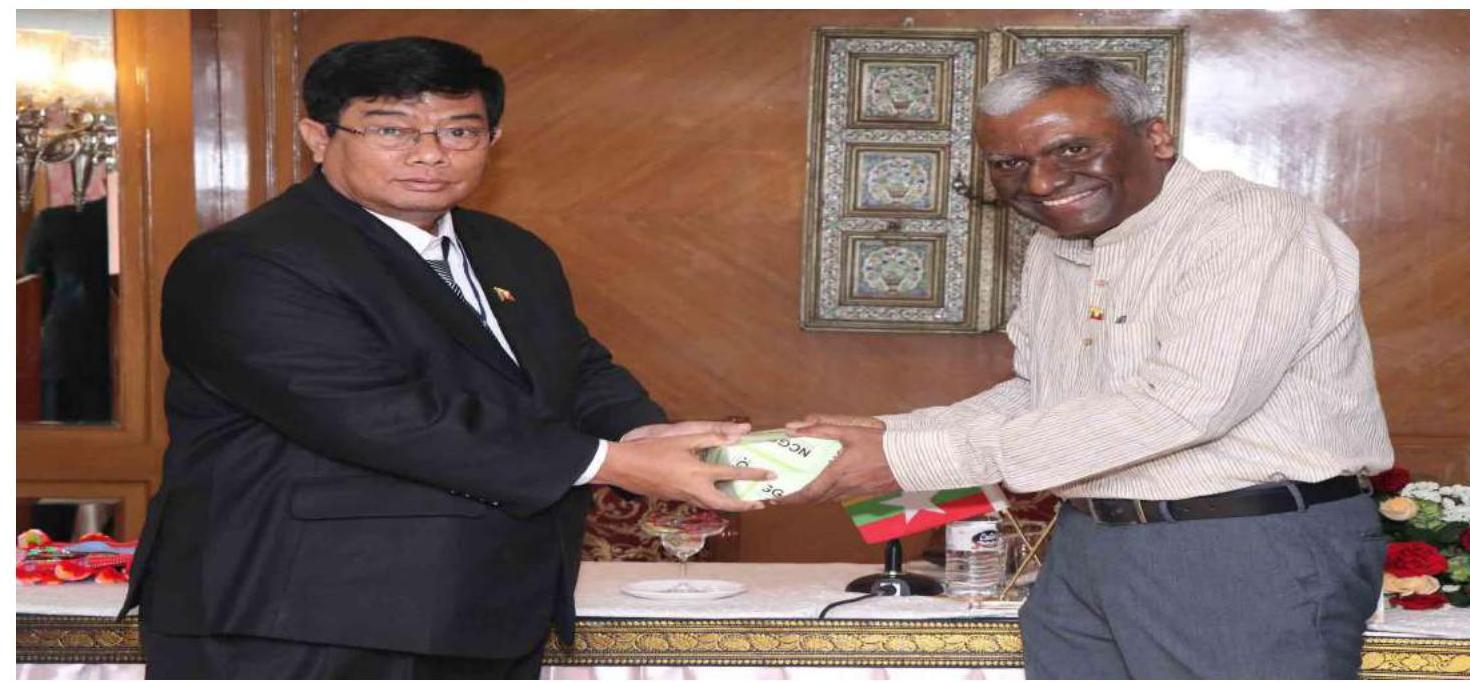
Mid-Career Training Programme for District Administrators of Myanmar( $25^{\text {th }}$ March, 2019 – $06^{\text {th }}$ April, 2019)
Administrative Reforms
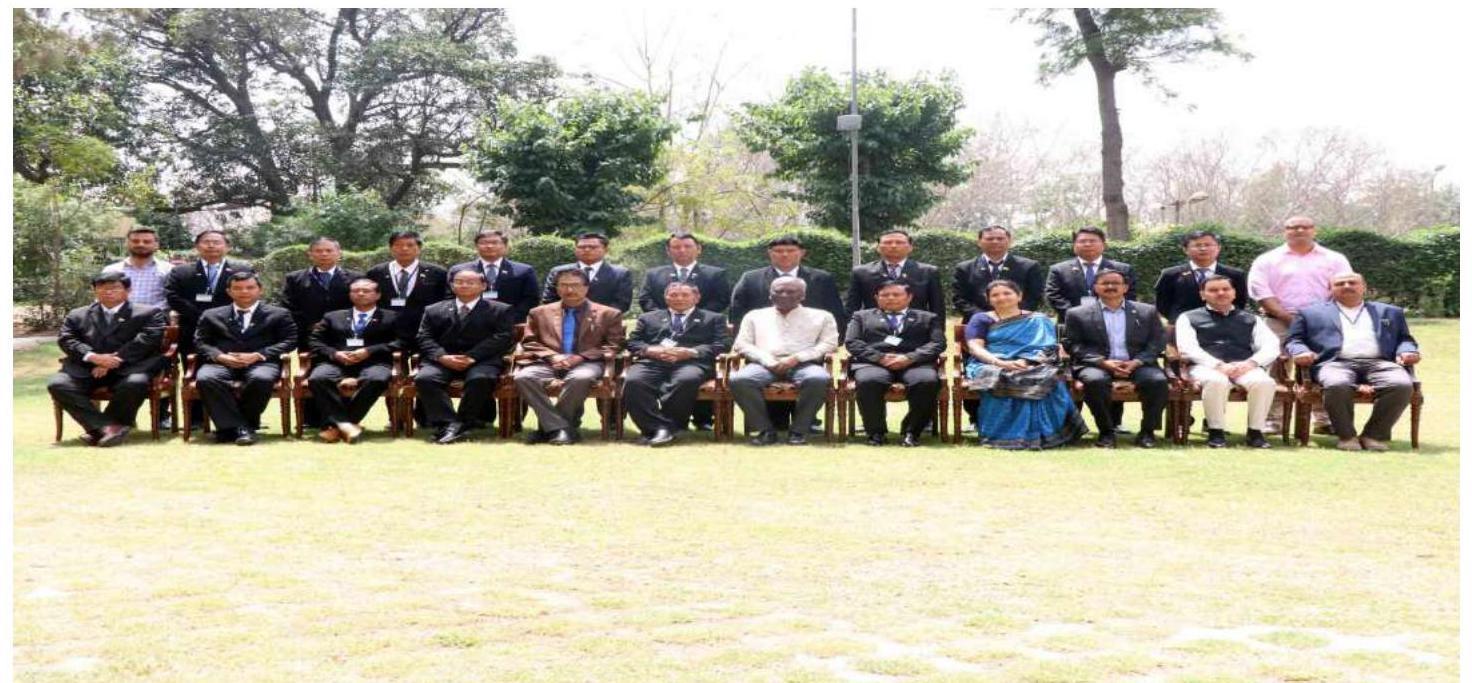
Group Photograph of Mid-Career Training Programme for District Administrators of Myanmar
(25th March, 2019 – 06th April, 2019)
PUBLIC GRIEVANCES
MANDATE
The Public Grievances Division is responsible for issuing policy guidelines and coordinating & monitoring of issues regarding redress of public grievances and staff grievances for the Central Government. In accordance with federal principle of governance, the grievances relating to States are forwarded to concerned State Government for appropriate action. In its efforts to provide a more responsive and citizen friendly governance, the PG Division coordinates efforts to formulate and operationalize the Citizen’s Charters of various Ministries/Departments/Organisations and State Governments. The PG Division also coordinates the implementation of Sevottam which is a part of a citizen centric quality management framework for better service delivery.
21.1 The Allocation of Business Rules, 1961, allocates to DARPG inter alia, the responsibility for Policy, Coordination and Monitoring of issues relating to (a) Redress of Public Grievances in general and (b) Grievances pertaining to Central Government Agencies, in particular. The Public Grievance Division is responsible for this activity since December 1987. From 1997, the Division has also been made responsible for several Citizen Centric Initiatives under the platform of ‘Responsive Government’. These include Citizens’ Charter, Information Facilitation Counters, and Quality Management System (QMS) framework called Sevottam, for bringing improvement in public service delivery on a continuous basis.
21.2 The management of Public Grievances today envisages reduction in grievances, by bringing continuous improvement in Public Service Delivery through the extension of Quality Management System ‘Sevottam’ at the
Centre as well as in the States. Accordingly, a Scheme for strengthening of State ATIs through implementation of Sevottam Cell is in place under which 10 State ATIs are being funded by the Department under the scheme.
21.3 The Public Grievances Division has undertaken the following activities during the year:-
21.4 Grievance Redress
21.4.1 An online system for grievance redress, called the ‘Centralized Public Grievance Redress and Monitoring System’ (CPGRAMS) has evolved since 2007. At present its upgraded version 6.0 is in operation w.e.f. 04.01.2018 and is accessible at http://pgportal.gov.in and also through www. darpg.gov.in. It provides for one time registration anytime, anywhere 24X7 and enables the citizen to see all the grievances lodged by him and their status on a single screen through the Registration
numbers generated on lodging of the grievance. Citizens can use a Mobile App for lodging of public grievances and the action Status can also be viewed on the mobile itself. This mobile app is integrated with Unified Mobile Application for New-age Governance (UMANG). The app is available in both Android and iOS versions.
21.4.2 A new mobile app called MyGrievance has been developed. This app is integrated with CPGRAMS and is available in Android version.
21.4.3 Public grievance mechanism of PMO, the President’s Secretariat, the Directorate of Public
Grievances (Cabinet Secretariat), Department of Administrative Reforms & Public Grievances (DARPG) and the Pensioners’ portal has been duly integrated through CPGRMS thus enabling grievances lodged to any of these entities to be transferred to the Central Ministries/Departments and State Governments online through CPGRAMS. The CPGRAMS interlinks 87 Central Ministries/ Departments/Organistions and 36 States /UTs. There are more than 46,000 sub-ordinate users listed on it which includes subordinate and field officers also. CPGRAMS is also available in Hindi.
Grievance Receipts/disposal in CPGRAMS as on 31.03.2019
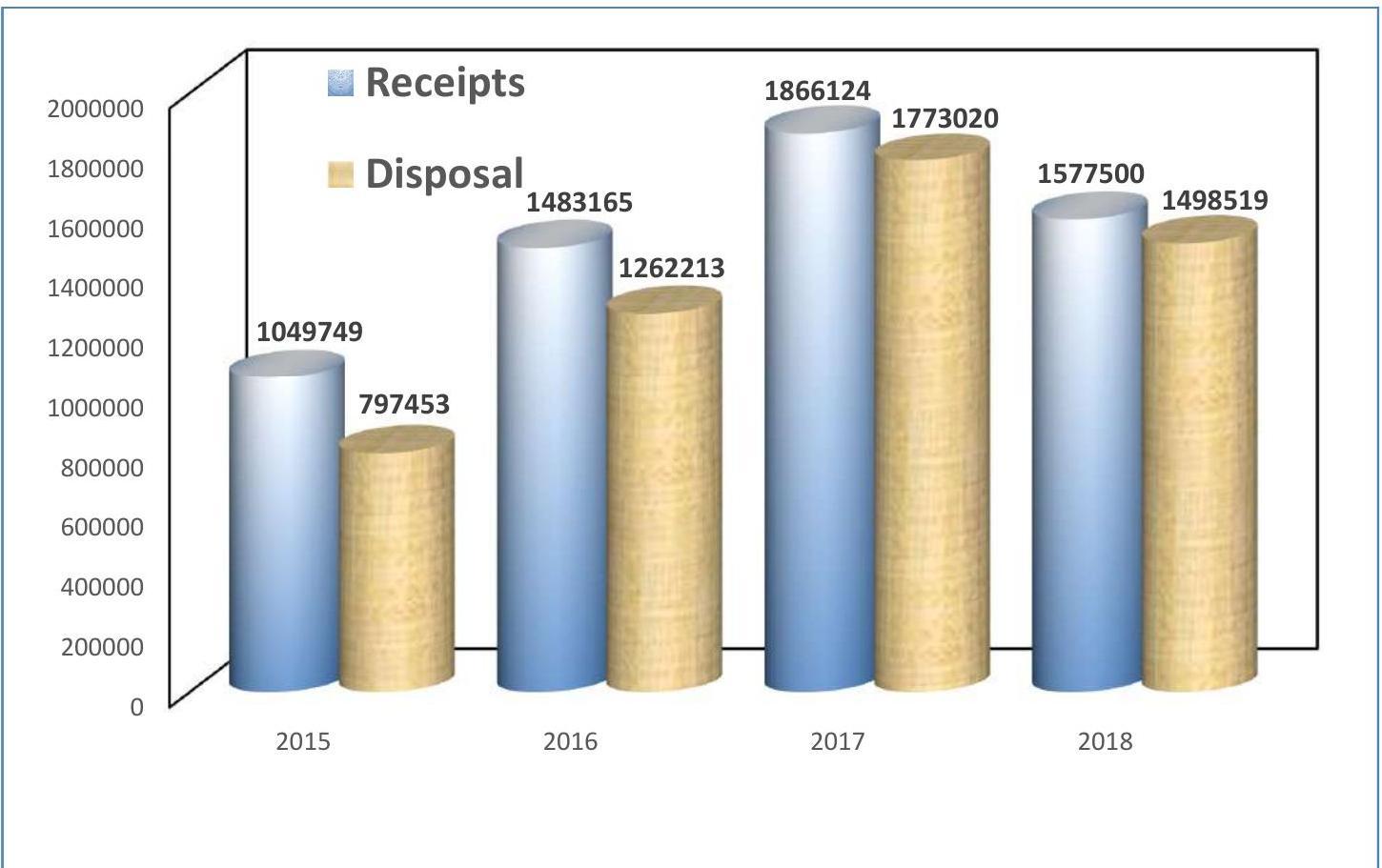
Year-wise Receipts/Disposal graph on grievances received on CPGRAMS
Salient features of CPGRAMS:
| Total No of Organizations registered in CPGARMS |
Total Ministry/ Departments/ States/UTs |
Total grievances sent to States by DARPG in 2018-19 as on 1.4.2018 to 31.03.2019 |
|---|---|---|
| 49000 | 123 | $12,527^{*}$ |
- Total No. of Grievances Received by DARPG is 33868 out of which 5159 have been received Manually/by Post
21.4.4 Extending CPGRAMS to State
Governments/Union Territories – During the year, the Division has extensively used the System to forward public grievances to the State Governments. The inflow of State related grievances is in two forms (i) through the CPGRAMS and (ii) through post. The grievances received by post are digitized and sent both through the System as well as by post to the State Government concerned. Redress response as received is sent by post, to the complainant. During 2018-19 a total of 12,527 grievances have been sent to State Governments by Department of ARPG. Out of these, 10366 were received electronically, and 2161 were received by post or given in person by the complainants.
21.4.5 A Public Grievances Call Centre that was made operational through NICSI on pilot basis w.e.f.February, 2016 till 31.3.2019 for reminding the concerned officials of 40 Ministries/Departments/ Organizations and expediting grievance petitions which are pending for more than two months. The PG Call Centre has also collected feedback from the petitioners on some of the grievances disposed through CPGRAMS.
21.4.6 A new version 6.0 of Centralized Public Grievance Redress and Monitoring System
(CPGRAMS) with several features viz. one time registration, lateral transfer of grievances among Ministries/Departments/organizations, etc. has been introduced in January, 2018. During the year 2018-19, 8 operational trainings on CPGRAMS have been conducted. During the training, the new features of CPGRAMS are discussed and problems being faced by the nodal Public Grievance Officers while redressal of grievances are solved.
21.4.7 During the period from 2018-19, a total of ten review meetings including five meetings through inter-active Video Conferencing Sessions were held for reviewing the status of pending public grievances in Ministries/Departments and expediting action on them. The status of Public Grievances in 87 Central Ministries/Departments and 10 State Governments have been reviewed in these meetings.
21.4.8 An Award Scheme has been launched for recognizing outstanding performance on CPGRAMS through issue of Certificate of Appreciation. The Scheme not only takes into consideration the number of grievances disposed by the Ministries/ Departments/ Organizations, but also the feedback of the petitioners whose grievances have been closed in the System. Upto December, 2018, 30 Certificates of Appreciation have been awarded. This year, Certificate of appreciation was awarded by MoS (PP) on 08.01.2019 to 9 Ministries/ Departments/ Organizations listed on CPGRAMS for the first and second quarter of 2018 viz. NITI Ayog, M/o Textiles, M/o Labour, D/o Administrative Reforms and Public Grievances, D/o Science and Technology and D/o Defence Finance, D/o Investment and Public Asset Management, Ministry of Textiles, UIDAI.
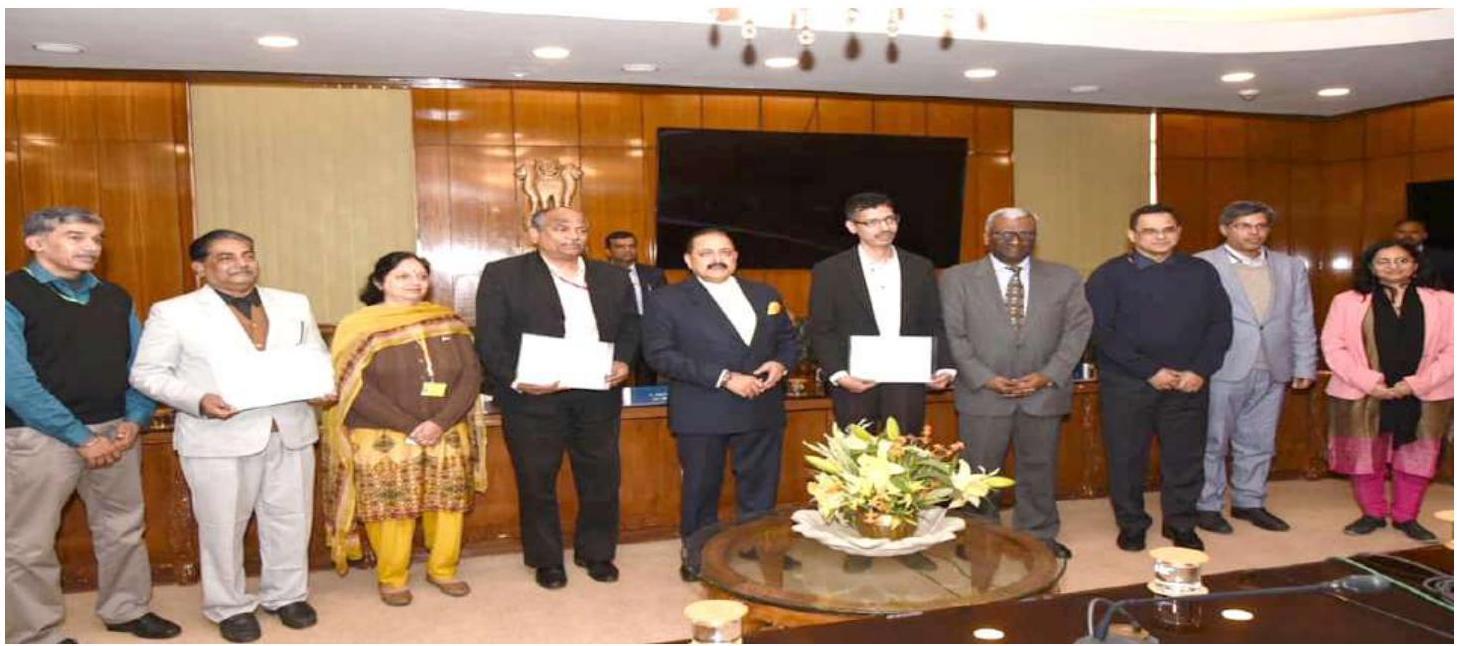
Hon’ble Minister Dr. Jitendra Singh Distributed Awards for CPGRAMS Performance
21.4.9 For Updation and Review of the Citizens’ Charters
The meetings were held on 20.12.2018 and 4.2.2019 under the Chairmanship of Secretary, DARPG with 10 Ministries/Departments/organizations. Four inter-active sessions through Video Conference were held on 21.1.2019, 20.2.2019, 11.3.2019, and 25.3.2019 under the Chairmanship of Additional Secretary for review and updation of the Citizens’ Charters with 87 Ministries/Departments and 10 State Governments. The Ministries/Departments were requested to review and update their Citizens Charter by 30th April, 2019.
21.4.10 A Delegation of Egyptian Government Officials and Cooperative for Assistance and Relief Everywhere
A delegation of Egyptian Government officials and Cooperative for Assistance and Relief Everywhere, (CARE) International, officials visited the Department of Administrative Reforms & Public Grievances on 26th February, 2019 to discuss and understand process, modalities, and operation of Citizen Charter process being followed in India.
21.5 Public Service Delivery
21.5.1 One of the Citizen Centric Initiatives That
There were taken by this Department to develop a Quality Management System (QMS) framework called ‘Sevottam’ for bringing excellence in service delivery by Government organizations. This has institutionalized an assessment-improvement framework for improving the quality of service delivery on a continuous basis through the involvement of Ministries/Departments and citizens. Sevottam comprises 3 modules in relation to a public service organization viz., (a) Citizens’/Clients’ Charter that specifies the service delivery standards, (b) Grievance Redress Mechanism that gets activated if the service delivery is not as per standards in the charter, and (c) Service Delivery Capability of the organization to deliver service as per standards in the charter.
21.5.2 As Part of the Strategic Plan for Capability Building
As part of the Strategic Plan for Capability Building towards implementing Sevottam QMS, a Scheme for Strengthening of State ATIs/CTIs was implemented during the 12th Five Year Plan 2012-2017 by establishing a Sevottam Training Cell in ATIs/Govt. approved Training Institutions.
in 10 States. This Scheme has been extended for a further period of 3 years till 31.03.2020. The Scheme has also resulted in building capacity of the ATI to become consultants for implementing Quality Management System ‘Sevottam’ in the departments of the State Governments, including replication of best practices from other States/ UTs. A number of on-campus and off-campus training programmes and workshops have been held by the ATIs for sensitizing the officers of the State Government for implementation of Citizens’ Charter and Grievance Redress Mechanism.
21.5.3 An amount of Rs.39.00 lakh has been released under the above scheme to two State ATIs viz., Haryana and Punjab in 2018, based on their performance and the utilization certificates received from them.
21.6 CITIZENS’/ CLIENTS’ CHARTERS
21.6.1 A Pilot Project of Study of Citizens’ Charters of two Ministries/Departments viz., Ministry of External Affairs (MEA) and Central Board of Direct Taxes (CBDT) was conducted by the PG Division through Quality Council of India (QCI) for improvement of public service delivery through effective implementation of Citizens’ Charter. The single objective of the Project was to undertake a
diagnostic study of services provided by these two Ministries/Departments with a view to enhancing the respective Citizens’ Charters by making it more citizen-centric. The Study has been completed and the final report of the Study has been shared with MEA and CBDT. The MEA have already revised the Citizen’s Charter based on the recommendations made in the study. CBDT has already initiated action for revising their Citizens’ Charters as per the recommendations made in the Study.
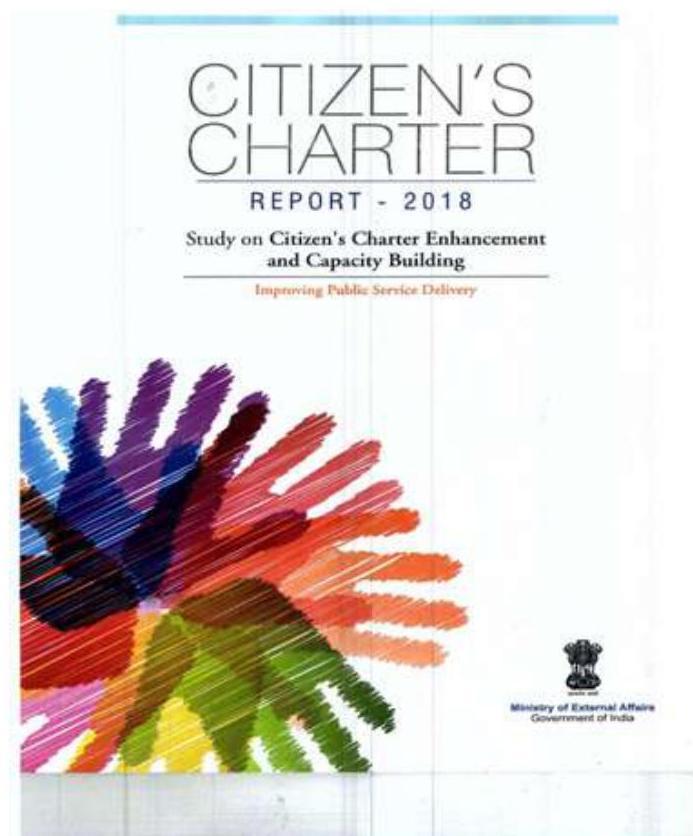
Organisation and Methods Division
MANDATE
- Formulation and simplification of office procedures.
- Publication and updating of the paper based Central Secretariat Manual of Office Procedures (CSMOP), electronic based Central Secretariat Manual of e-Office Procedure (CSMeOP) and Record Retention Schedule (RRS).
- Aiding and advising the Central Ministries/Departments and States/UTs Governments on O&M aspects.
- Implementation of the Plan Scheme of Modernization of Central Government offices located in the city of Delhi and NCR.
Central Secretariat Manual of Office Procedure (CSMOP)
22.1 The Central Secretariat Manual of Office Procedure, 2019 (CSMOP) which will cater to both electronic and paper based file system is under finalization of the Department. It merges the key provisions of CSMOP 2015 and 2012 (manual of electronic office procedure). The CSMOP 2019 seeks to bring about enhanced systemic efficiency in file management system and office procedures. The salient features of draft CSMOP 2019 are as under:-
- The Manual will have 16 chapters. Definitions have been categorized as Glossary and given at the end of the CSMOP 2019. Decision making in Government, Knowledge Management, and Digitization Framework are three new Chapters.
- The latest practices in e-Office procedures have been included. Digital Signature
Certificate shall be provided to all Section Officers and above rank officers.
3. Record Management practices in CSMOP, 2019 have been made in consonance with the provisions of the Public Records Act, 1993 and the Category-A and Category-B records shall be permanent record. Category-C records shall be maintained in accordance with the Record Retention Schedule of the Department prepared in consultation with the National Archives of India.
4. CSMOP 2019 places emphasis on Monitoring of Disposal with specific provision for monitoring of Receipts, time limits for disposal of cases, monitoring of court cases/CAT orders, register of parliamentary assurances.
22.2 An inter-Ministerial Committee constituted under the Chairmanship of the Additional Secretary, Department of Administrative Reforms \& Public Grievances (DAR\&PG) to review the Records
Management procedure (contained in the CSMOP & CSMeOP) and Records Retention Schedule of the Government of India last revised in the year 2012 has given its recommendations. The draft Report has been circulated to all the Members and will be finalized in the current financial year.
Modernization of Government Offices Scheme
22.3 In order to give catalytic effect to modernization of offices as an overall process of Administrative Reforms, the DARP\&G is implementing a Plan Scheme for Modernization of Government offices located in the city of Delhi
since the year 1987-88. The scheme has been extended to the Government offices located in NCR in the year 2018.
22.4 Under the Scheme the Department provides $75 %$ financial assistance of the total cost of the project which is recommended by an Inter-Ministerial Screening Committee and the beneficiary has to chip in with $25 \%$ of the cost. Since the year 1987-88 till date, the DAR\&PG has extended a financial assistance of 83.79 crore approximately for financing 479 modernization projects/proposals.
23
CHAPTER
e-Governance
23.1 The Department of Administrative Reforms & Public Grievances along with the Ministry of Electronics and Information Technology, in association with one of the State Governments, has been organizing the National Conference on e-Governance every year since 1997. This conference provides platform for the senior officers of the Government including IT Secretaries of State Governments, IT Managers of the Central Government, and resource persons, experts, intellectuals from the industry and academic institutions, etc. to discuss, exchange views and experiences relating to various e-Governance initiatives.
23.2 National Awards for e-Governance
23.2.1. This year, the Award Ceremony for distribution of National Awards for e-Governance 2018-19 has been organized on 27th February, 2019 at Dr. B. R Ambedkar International Convention Centre, New Delhi. Dr. Jitendra Singh, Hon’ble Minister of State (Independent Charge) of the Ministry of Development of North Eastern Region, Minister of State in the Prime Minister’s Office, Personnel, Public Grievances and Pensions, Department of Atomic Energy and Department of Space has presented the National e-Governance Awards. Awards were given in 6 categories to recognize achievements in the area of e-Governance. The six categories under which Awards were presented are as follows:
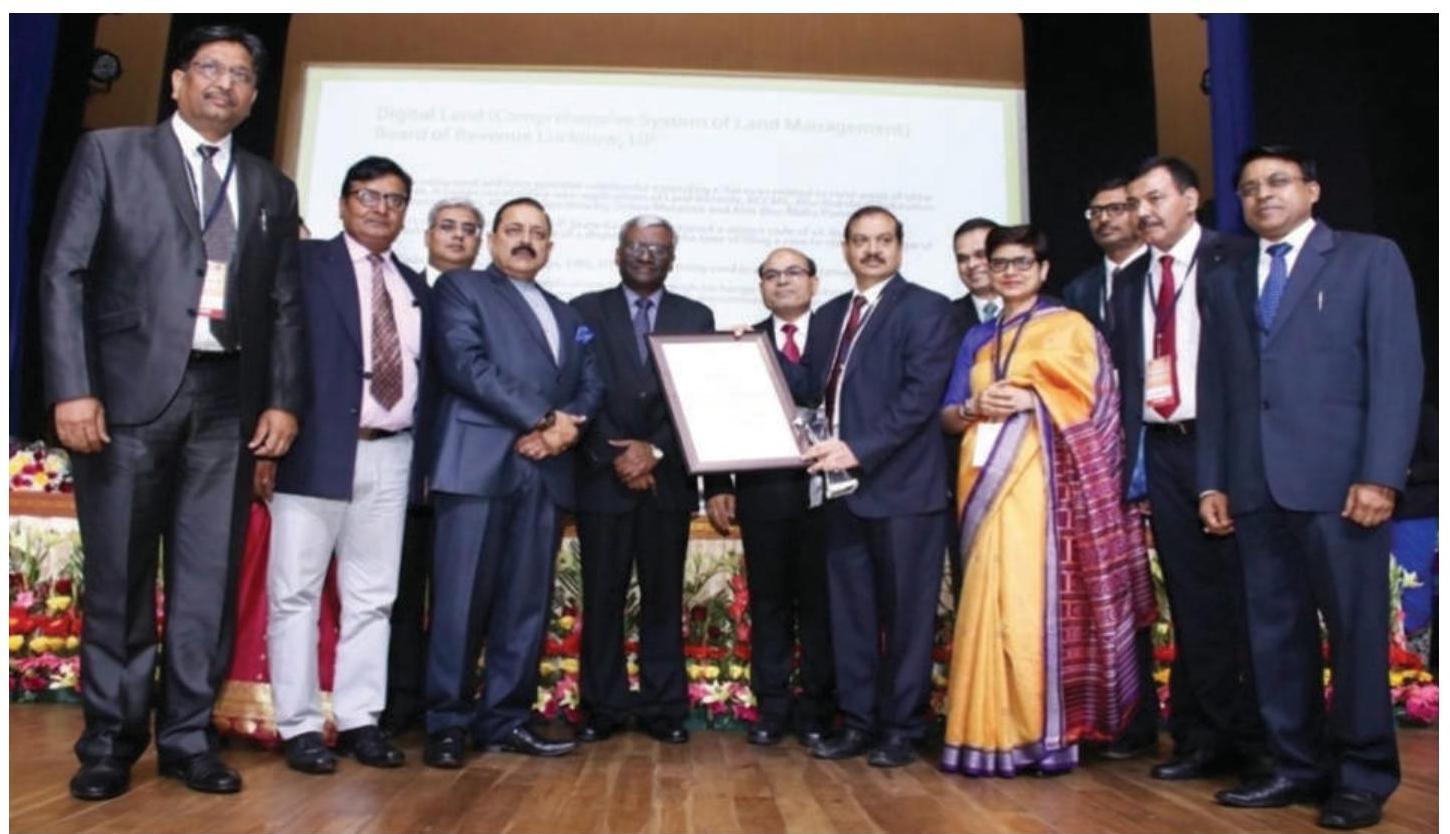
The Digital Land (Comprehensive System of Land Management) team led by Shri. Pravir Kumar (Project Head) accepting the Gold award for the category Excellence in Government Process Re-engineering for Digital Transformation
(i) Excellence in Government Process Reengineering for Digital Transformation.
(ii) Excellence in providing Citizen-Centric Delivery.
(iii) Excellence in District level Initiative in e-Governance (i) North-East States + Hilly States (ii) UTs (including Delhi) (iii) Other States.
(iv) Outstanding research on Citizen Centric Services by Academic/Research Institutions.
(v) Innovative Use of ICT in e-Governance solutions by Start ups [Start up as defined by Department of Industrial Policy and Promotion (DIPP) Government of India]
(vi) Excellence in Adopting Emerging Technologies.
23.2.2 Gold and Silver Awards in each category has been presented. A Special Jury Award has
also been presented in Category-I for IRCTC Rail Connect Mobile App. An Exhibition has also been organised to showcase the best practices, innovative technologies and ICT solutions. The event included an experience sharing session on some of the awarded initiatives which are : –
- IRCTC Rail Connect Mobile App
- UMANG
- MDDA ERP
- Punarvas
- Hello Doctor 555
- Wind Power forecasting services for the State of Tamil Nadu
- Ultra Resolution UAV based Geo ICT enabled Property Tax Management System for Municipal Area of Bhiwani.
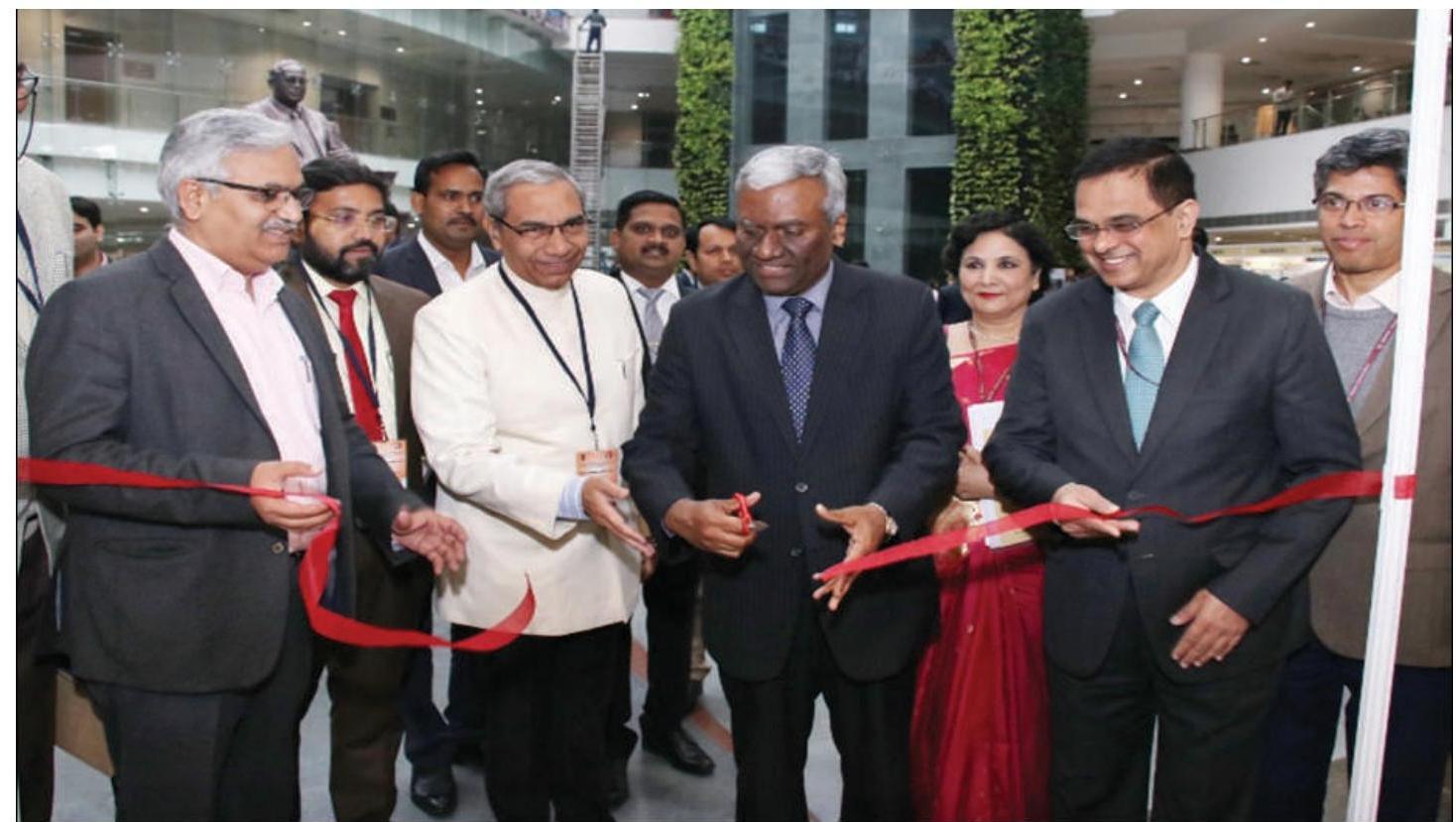
Inauguration of the Exhibition by Sh. K. V. Eapen, Secretary, DARPG during the Award Ceremony
23.2.3 The focus was on Citizen Centric Services and application of technology for encouraging development. It is hoped that the exposure will help in digital transformation of the country by replication of some of the projects. A film of 10 minutes duration, showcasing the award winning projects of National Awards for e-Governance. 2018-2019 was launched at the event. Two books were also released viz. (i) Compendium of Selected Papers and (ii) Excellence in e-Governance.
23.2.4 The Event was attended by a large number of delegates from Government of India, State Governments, Industry, Academia, and Private Sector.
23.3 e-OFFICE
23.3.1 DAR&PG is the nodal Department for implementation of e-office project in Central Ministries/Departments. National Informatics Centre (NIC) is the technical partner of DARPG in this project. The e-Office Mission Mode Project (MMP) was launched in 2011-12 in a phase manner. DARPG provides financial assistance to the central Ministries/Departments for e-office implementation.
23.3.2 Effective steps have been taken by DAR\&PG to expedite implementation of e-office in all central Government Ministries/Departments by conducting regular review meetings and also by establishing a project monitoring unit in the Department. 43 Central Ministries and Departments have already achieved the target of complete e-office and about 31 Central Ministries/ Departments have also started showing improving trends.
23.3.3 On the spot inspection of Ministries/ Departments who have achieved $80 %$ target is done before certification. Also Ministries/ Departments performing poorly are invited/ visited for understanding their issues and prepared roadmaps for improving their performance.
23.4 Guidelines for Indian Government Websites (GIGW)
23.4.1 NIC had brought out the Guidelines for Indian Government Websites (GIGW) in 2009, which was adopted by Department of Administrative Reforms \& Public Grievances. The GIGW were circulated by the DAR\&PG, way back in May, 2009 to all central Ministries/Departments for compliance and also furnishing status of action taken in the matter. Subsequent, to that DAR\&PG and Cabinet Secretariat have made several references to all the central Ministries/Departments for early compliance of the websites with the GIGW.
23.4.2 Due to continuous monitoring 66 Central Ministries/Departments have now become GIGW compliant and many central Ministries/ Departments are on the way of becoming GIGW compliant in near future. NIC in collaboration with DARPG brought out second edition of GIGW-2018 and the same was circulated to all Ministries/ Departments of Govt of India along with all State Government/ UT Administration for compliance.
24
CHAPTER
International Exchange and Cooperation
24.1 The Department of Administrative Reforms & Public Grievances (DARPG) deals with matters relating to international exchange and cooperation in the field of Public Administration and Governance, which includes, among other things, organizing programmes and visit of Indian delegations to foreign countries and visit of foreign delegations to India as part of projects / bilateral measures in furtherance of activities included in the Memorandum of Understandings (MOUs) / Agreements signed between India and other countries (bilateral or multilateral).
24.2 The aim of international exchange and cooperation component is to share information, best practices and personnel across national governments. Presently bilateral MOUs in the areas of Public Administration and Governance have been signed with France, Malaysia, Singapore, United Kingdom, Portugal, China and trilateral MoU with Brazil and South Africa (IBSA).
24.3 India-Portugal Cooperation
24.3.1 Department has signed an MoU in June, 2017 with Ministry of the Presidency and of Administrative Modernization, Government of Portuguese Republic on ‘Cooperation in the field of Public Administration and Governance Reforms’. The areas of co-operation under this MoU includes Digital transformation of Government, Administrative simplification and process reengineering, Public Service Delivery, Building
and developing staff capability, Sharing good governance practices in public administration, Public Grievance Redress Mechanism.
24.3.2 In pursuance of the MoU, a four member Indian delegation led by Secretary (DARPG) visited Lisbon, Portugal on 8-9 May, 2018 to attend a first Senior Consultative Body meeting held under the Memorandum of Understanding signed with Government of Portugal. During the meeting both sides discussed initiatives and approach for Digital Government, Administrative Simplification \& Public Service Delivery and Public Grievance Redress Mechanism
ASSOCIATION WITH MULTILATERAL ORGANIZATIONS IN THE FIELD OF PUBLIC ADMINISTRATION
24.4 Cooperation with International Institute of Administrative Sciences (IIAS)
24.4.1 The Department is an institutional member of the International Institute of Administrative Sciences (IIAS) since 1998. IIAS was established for the purpose of promoting the development of Administrative Sciences, better organization and operation of public administrative agencies, improvement of administrative matters and techniques and for the progress of International Administration. Additional Secretary (DARPG) is on the Council of Administration of IIAS in an exofficio capacity. Additional Secretary (DARPG) has
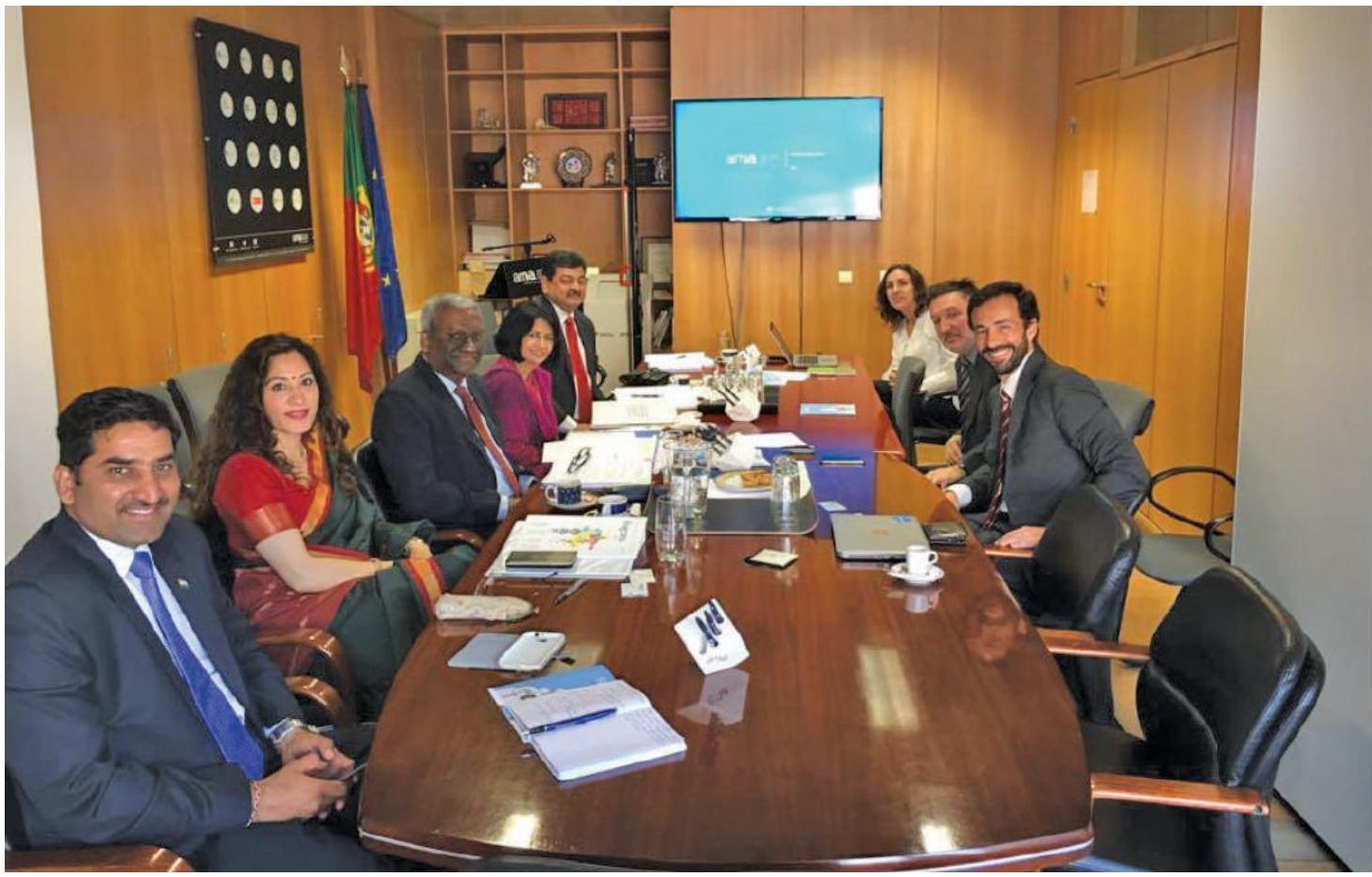
From left to Right: Mr Amararam Gujar (First Secretary, HOC and Commercial), Ms. K. Nandini Singla, Ambassador of India in Portugal, Mr. K.V. Eapen (Secretary, AR&PG), Ms. Smita Kumar (Joint Secretary, AR&PG), Mr. Sanjay Goel (Joint Secretary, MEITY), First from Right Ms. Ana Claudia AMA, Mr. Eduardo Ramos, Director Asia Ocenia Division in Ministry of Foreign Affairs, Mr. Pedro Silva Dias CEO AMA – First Senior Consultative Body meeting held in Lisbon, Portugal
been nominated Vice President for South East Asia and the Pacific region of IIAS for the term 2016-19.
24.5 Cooperation with Commonwealth Association for Public Administration and Management (CAPAM)
24.5.1 The Commonwealth Association for Public Administration and Management (CAPAM) is a membership organization dedicated to strengthening public management and consolidating democracy and good governance throughout the Commonwealth. Since inception, CAPAM has grown to a network of over 1100 members across the Commonwealth countries. The Department became an institutional member of CAPAM in 1997.
24.5.2 CAPAM International Innovation Awards Programme was held in conjunction with CAPAM Biennial Conference during 22-24 October, 2018 at Georgetown, Guyana. Out of the four categories, India won awards in 2 categories. The initiative entitled “Unnayan Banka- Reinventing Education Using Technology of Banka District, State of Bihar has been selected under the Category ‘Innovation Incubation’.” Another initiative entitled “Unified Agriculture Markets, Co-operation Department of Government of Karnataka has also been selected under the Category ‘Innovation in Public Service Management’ and India won gold medal to this initiative.
24.6. Capacity Building in the field of Public Administration and Governance
24.6.1 As part of its international collaborative efforts, Department has been exploring the possibility of learning and sharing the administrative experiences of other countries, particularly in the area of e-Governance and online delivery of public services.
24.6.2 During 2018, the Department has organized three customised short-term Foreign
Training Programmes on the theme ‘Minimum Government with Maximum Governance’ through e-Governance based Citizen Centric On-line Services, for officers from Government of India and the States/UTs, including PM Award winners/ National e- Governance Award winners in the Korea Development Institute (KDI), Seoul, South Korea in May-June 2018 and Maxwell Syracuse University, New York, USA during November, 2018 and Duke Centre for International Development (DCID), Duke University, Durham, USA during January, 2019.
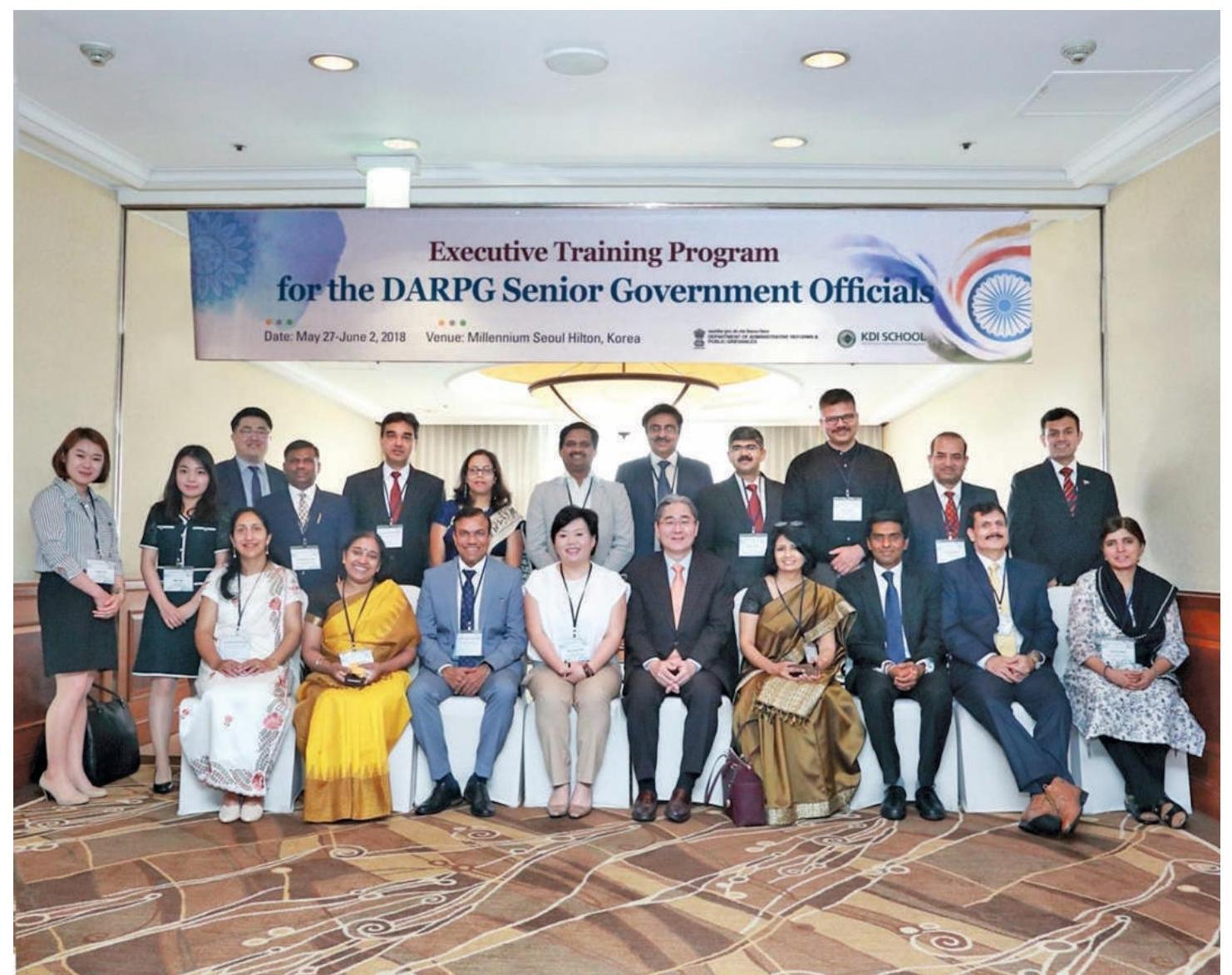
Training Programme organised at Korea Development Institute (KDI), Seoul, South Korea
Exchange and Cooperation with other countries
(i) A 8 member delegation from the Cabinet Division of the Government of Bangladesh visited India as a part of their capacity development programme during 20th $28^{\text {th }}$ January, 2019. The delegation visited Department on $22^{\text {nd }}$ January, 2019 to share experiences on Public Grievances. During discussions, presentation on Public Grievance Redressal was made before the Bangladesh delegation.
(ii) A delegation comprising of Egyptian Government officials and CARE (Cooperative
for Assistance and Relief Everywhere) International Team visited Department on $26^{\text {th }}$ February, 2019 to carry on discussion on the administrative reforms being administered by this Department with particular focus on Citizen Charter. The visiting delegation interacted with a team of Officers led by Joint Secretary, Department of Administrative Reforms and Public Grievances. The delegation was given a presentation on Citizen Charter.
25
CHAPTER
Documentation and Dissemination Division
25.1 The Documentation and Dissemination Division of the Department primarily carries out the activities of documentation and dissemination of good governance practices of Central and State Governments and Union Territory Administration with a view to facilitate sharing of experience with one another and replication elsewhere. The activities dealt by the Division are detailed below:-
25.2 Financial Assistance to State Governments/ UT Administrations for professional documentation and dissemination of ‘Good Governance Practices’
The objective of the Scheme is to provide financial assistance to support professional documentation and dissemination of good governance initiatives by the States/UT with a view to share experiences with each other and replicate elsewhere. So far eighty two projects have been sanctioned. Financial assistance of upto Rs.3.00 lakh is provided for professional documentation. The report is required to be in e-Book form, instead of paper documentation, alongwith a short documentary film.
25.3 Organization of Regional Conferences: –
Regional Conferences are organized on specific
themes in association with various State Governments with a view to bring National and State level organizations along with other stakeholders to share experiences in the formulation and implementation of good governance practices. This year, first Regional Conference on the theme “Good Governance: Focus on Aspirational Districts” was held in the month of September, 2018 at Bhopal, Madhya Pradesh. Second Regional Conference on the theme “Good Governance Initiatives” was held in the month of October, 2018 at Kohima, Nagaland. Third Regional Conference on the theme “Good Governance: Focus on Aspirational Districts” was held in the month of December, 2018 at Thiruvananthapuram, Kerala.
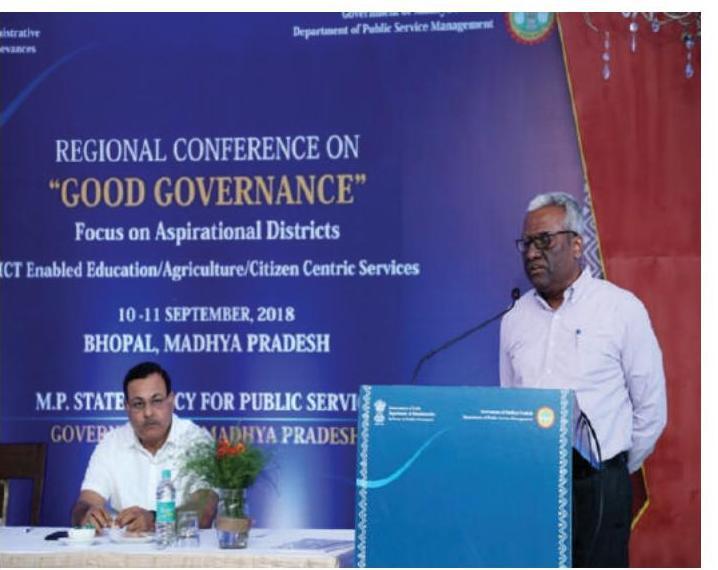
Shri K. V. Eapen, Secretary, DARPG addressing the valedictory session of 2-day Regional Conference at Bhopal on 10-11 th September, 2018.
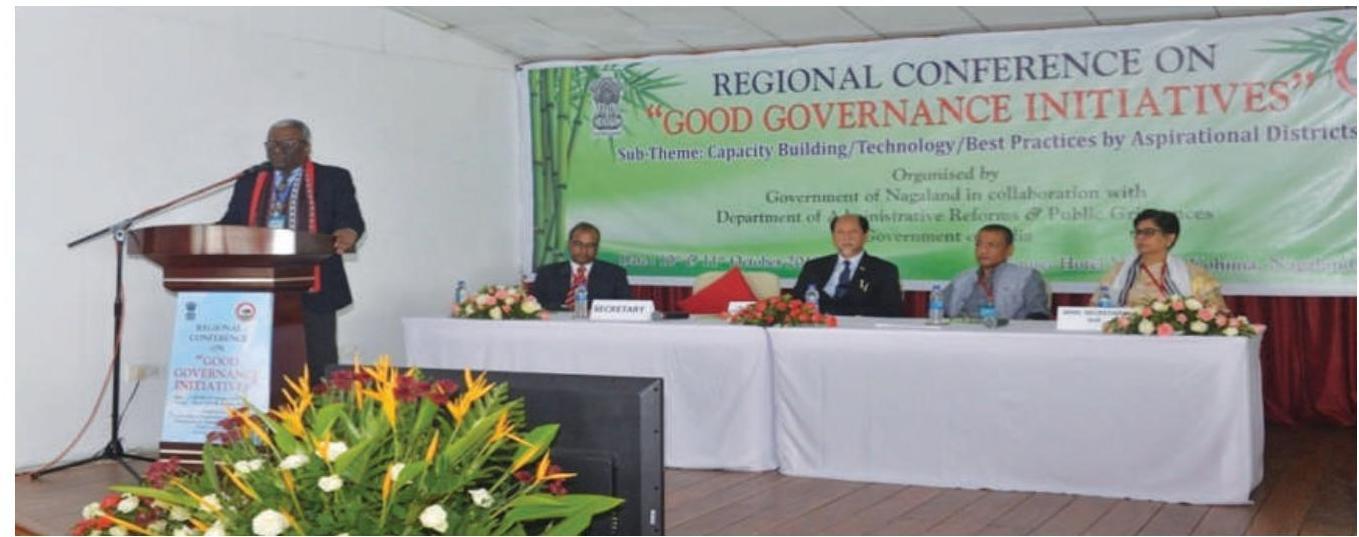
Shri K. V. Eapen, Secretary, DARPG, addressing the inaugural session of two-day Regional Conference at Kohima, Nagaland on 10-11th October, 2018, Shri Abhishek Singh, Commissioner & Secretary, Government of Nagaland; Shri Neiphiu Rio, Chief Minister, Nagaland; Shri R. Binchilo Thong, Chief Secretary, Nagaland; and Smt. Vasudha Mishra, Additional Secretary, DARPG are on the dais
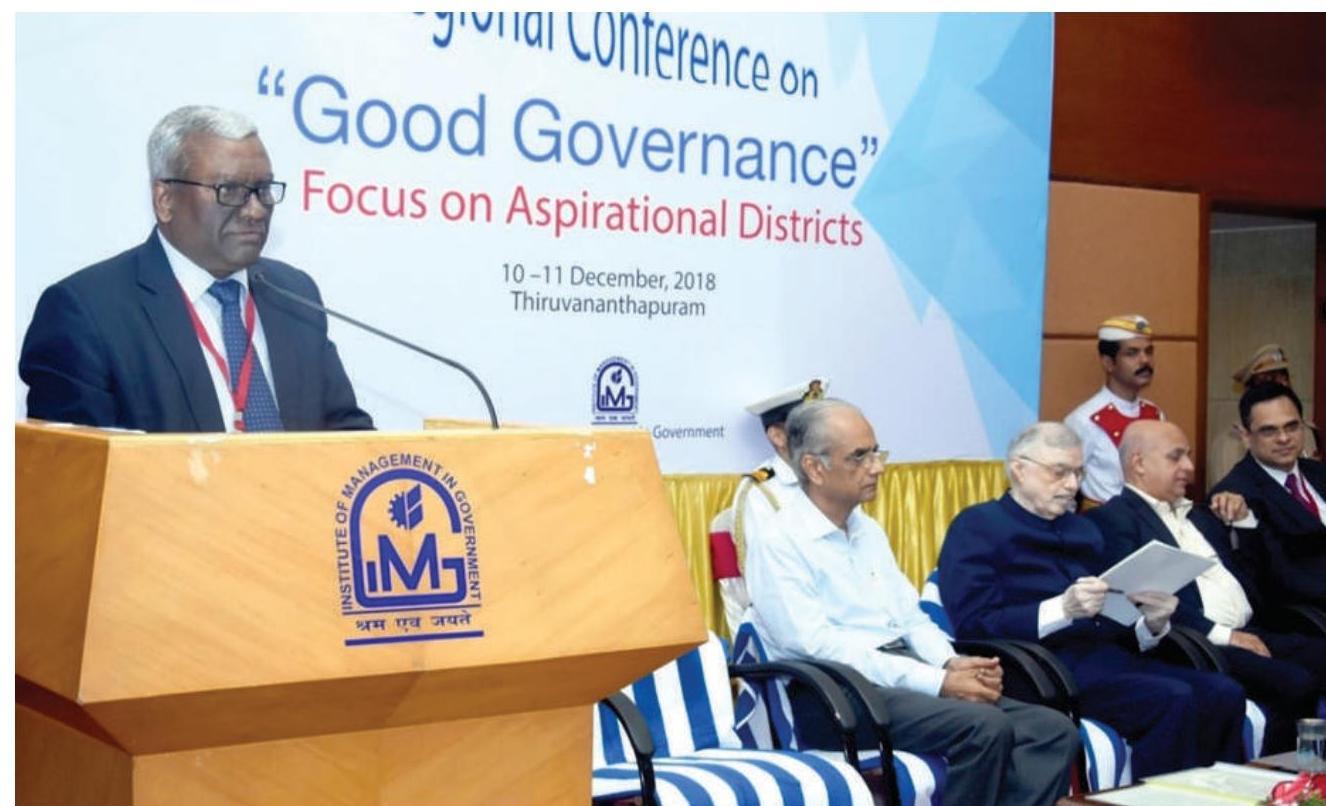
Shri K. V. Eapen, Secretary, DARPG addressing the session of 2-day Regional Conference at Thiruvananthapuram on 10 – 11th December, 2018.
25.4 Publication of Books
This Division publishes books containing articles on select award-winning good governance initiatives. These articles are on the initiatives which were either shortlisted or have been conferred Prime Minister’s Award or National e-Governance Awards.
The Division has already published a series of books on the subject. In the financial year 2018-19, three books namely ‘New Pathways’ (on 28 successful Innovations and 34 Success Stories in implementation of select Priority Programmes); ‘Aspirational Districts: Unlocking Potentials’ (Book on development of Strategies for transforming
Aspirational Districts) and ‘Emulating Excellence – Takeaways for Replication’ have been published.
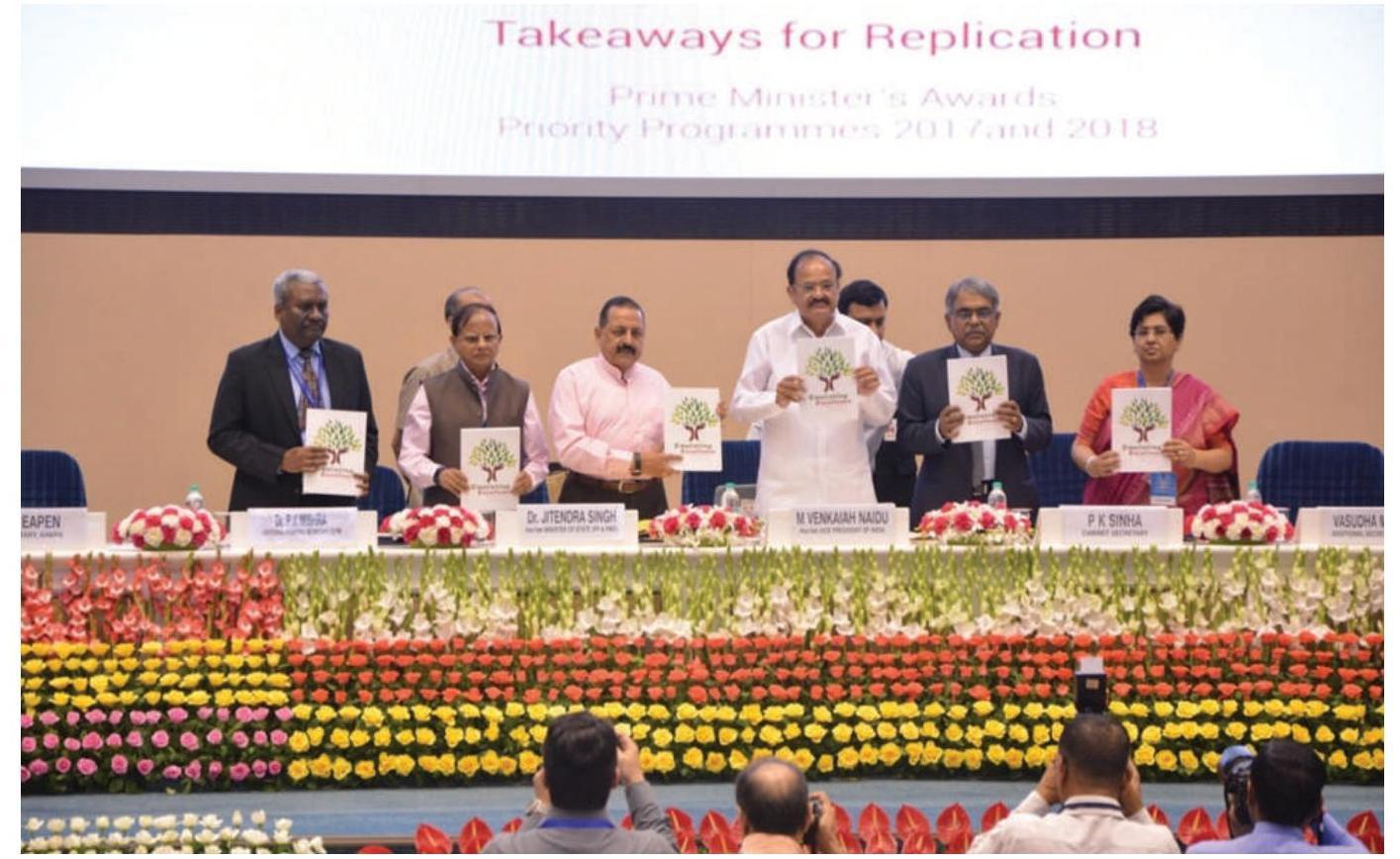
Shri M. Venkaiah Naidu, Hon’ble Vice-President of India releasing the book “Emulating Experience – Takeaways for Replication” on $20^{\text {th }}$ April, 2018 at Vigyan Bhavan
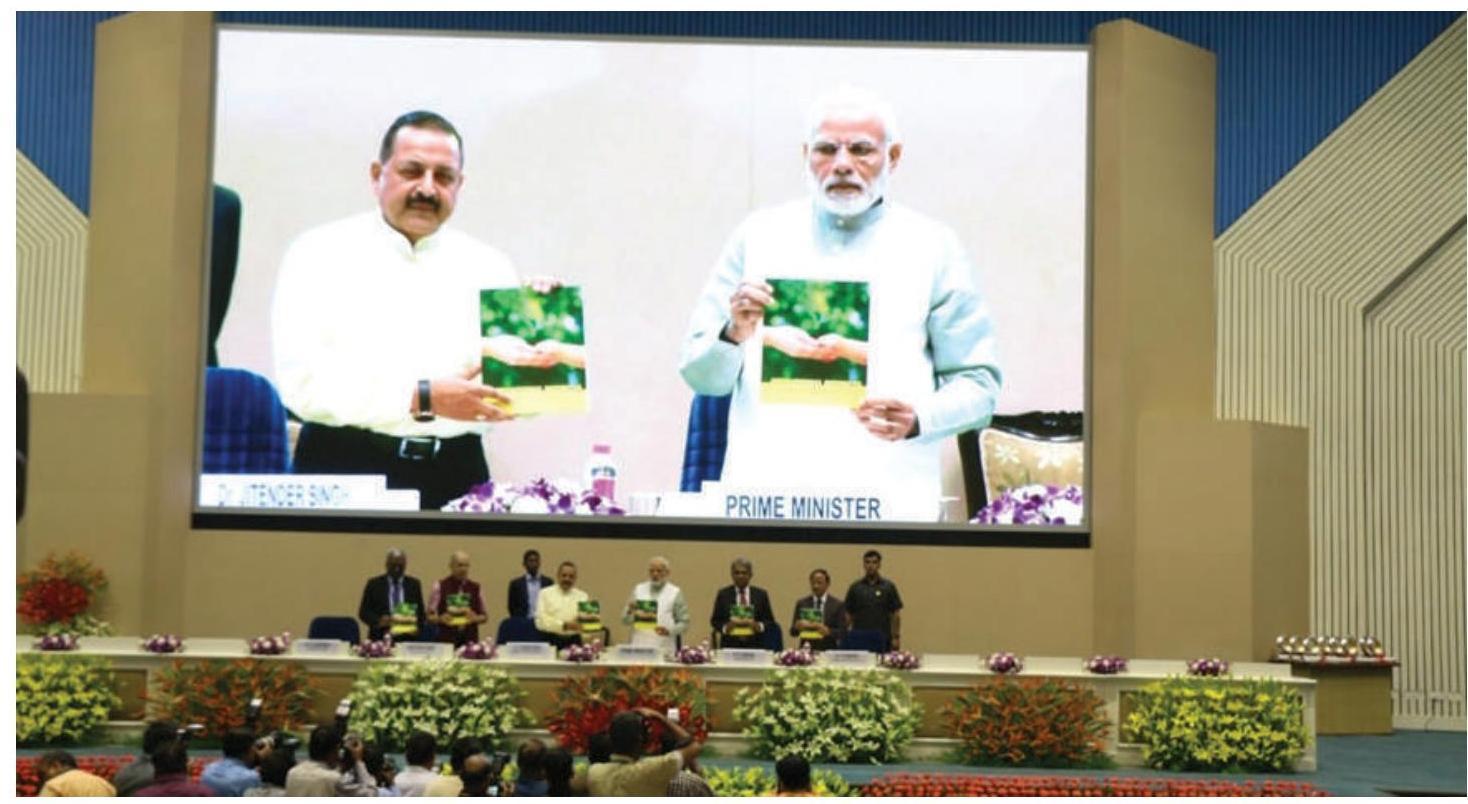
Shri Narendra Modi, Hon’ble Prime Minister releasing the book “Aspirational Districts: Unlocking Potentials” on the occasion of Civil Services Day on $21^{\text {st }}$ April, 2018 at Vigyan Bhavan.
25.5 Exhibition on the occasion of Civil Services Day, 2018
An exhibition on Success stories of identified priority programmes (Pradhan Mantri Fasal Bima Yojana, Promoting Digital Payments, Pradhan Mantri Awas Yojana-Urban & Rural, and Deen Dayal Upadhyaya Grameen Kaushalya Yojana) and
shortlisted Innovations by districts and Central, State organisations was organized. Creative works of Civil Servants were also showcased in the Exhibition. This included books, music, paintings etc. The exhibition was inaugurated by Shri M. Venkaiah Naidu, Hon’ble Vice-President of India on the occasion of Civil Services Day held on 20th April, 2018.
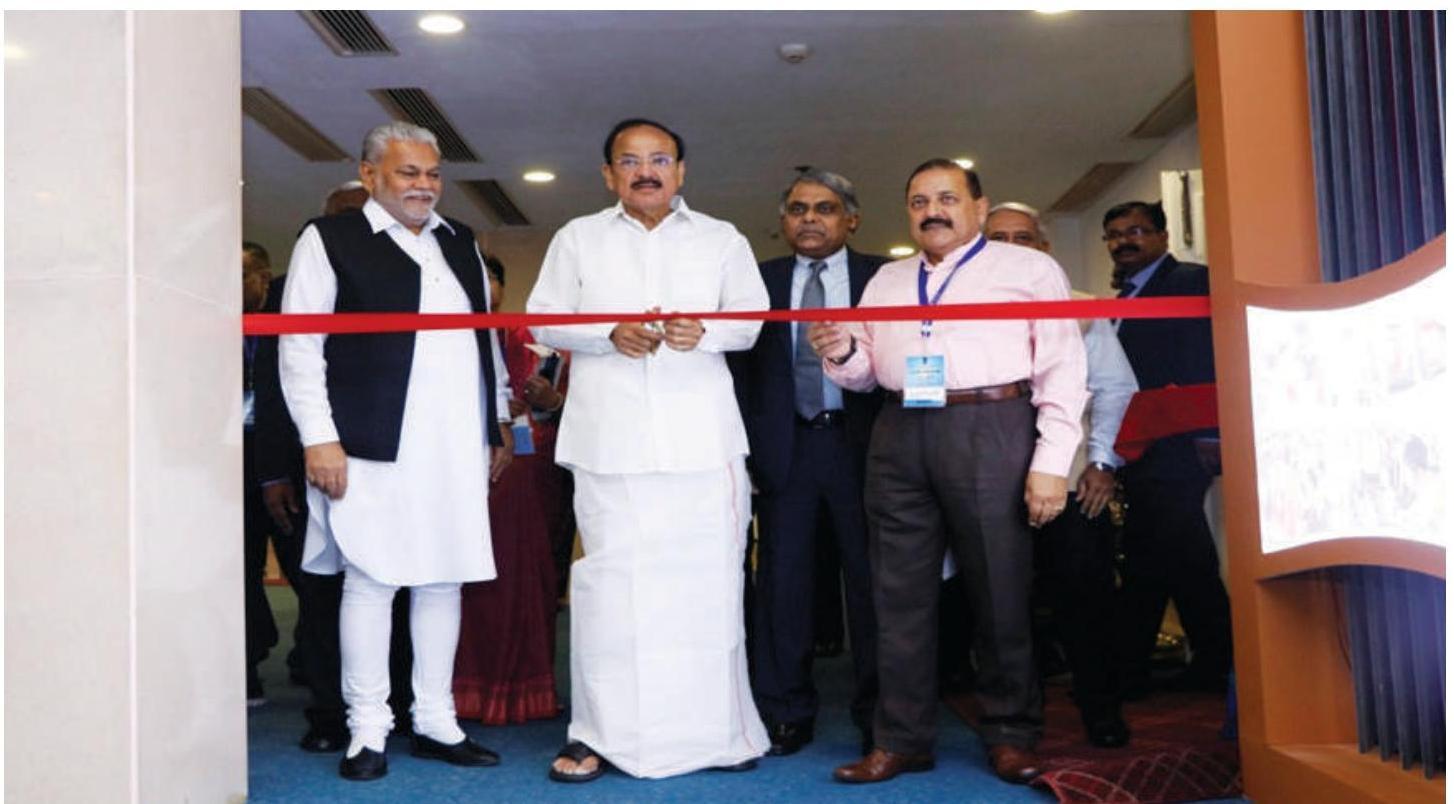
Shri M. Venkaiah Naidu, Hon’ble Vice-President of India inaugurating the exhibition on the occasion of Civil Services Day held on $20^{\text {th }}$ April, 2018 at Vigyan Bhavan
25.6 Production of Documentary Films on Best Practices
The Department is engaged in producing documentary films on best practices across the country. These films are immensely useful for the administrators as they facilitate dissemination of success stories and their replication. Eighty five such documentary films have been produced so far. In current financial year, two films namely ‘Journey of PM Awards, 2018’ and ‘New India- Shaping the Future’ have been produced \& screened during CSD,
2018. The films are available on the Department’s website, as well as social media platforms such as twitter and facebook. One film on e-Governance award initiative was produced and screened during National Award Ceremony held on $27^{\text {th }}$ February, 2019.
25.7 Publication of ‘Minimum Government Maximum Governance’ – A biannual e-Magazine
25.7.1 The Department of Administrative Reforms and Public Grievances brings out its eMagazine titled ‘Minimum Government – Maximum
Governance’ (MGMG) as an e-Book in its endeavors to document and disseminate successful good governance practices. In the e-Magazine, write-ups based on the shortlisted initiatives of PM Awards and National e-Governance Awards instituted by DARPG have been compiled. It is published on the website of the Department in e-Book form biannually.
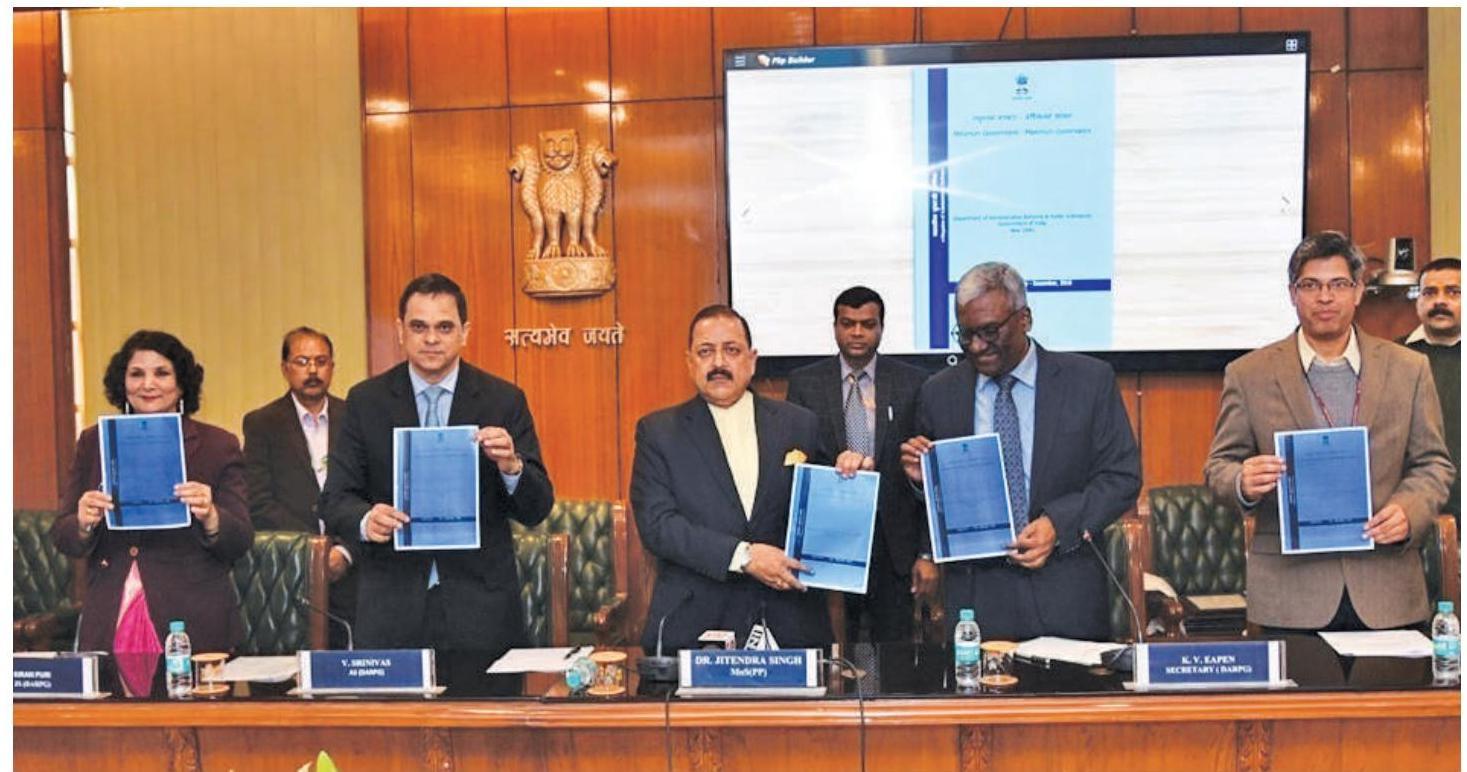
Dr. Jitendra Singh, Hon’ble Minister of State (I/C), Ministry of DONER, MoS (PMO), Ministry of Personnel, Public Grievances and Pensions, Department of Atomic Energy & Space releasing the July-December 2018 issue of the DARPG e-Magazine, Minimum Government – Maximum Governance on 12.02.2019.
25.7.2 The July-December, 2018 issue of the e-Magazine contains write-ups on 16 select good governance initiatives that have been shortlisted for Prime Minister’s Awards, 2018 for Excellence in Public Administration for effective implementation of identified Priority Programmes and Innovation to
Districts or Implementing Units and other Central \& State Organizations. This issue has write-ups on the Priority Programmes, namely Promoting Digital Payments, Pradhan Mantri Awas Yojana-(Urban \& Rural), Pradhan Mantri Fasal Bima Yojana and Innovations- Aspirational Districts \& others.
Hindi Section
26.1 Hindi Section of the Department of Administrative Reforms and Public Grievances is committed to comply with various guidelines issued by the Department of Official Language to promote the usage of Hindi language in the office.
26.2 The main function of the Section is to render Hindi translation of the works specifically materials related to Civil Services Day held on 20-21 April, 2018 entrusted by various sections/ officers of the Department and implementation of the Official Language Policy, which mainly include compilation of quarterly reports received from various sections of the Department and send it in an integrated form to the D/o Official Language in time; organizing quarterly meeting to discuss these reports. In addition, all the officers/sections are made aware of the guidelines issued from time to time by the D/o Official Language in connection with promotion of Hindi and their compliance is also ensured.
26.3 Hindi Pakhwara was organized in the Department during September 14-28, 2018 wherein various competitions were held i.e. Essay writing competition, Noting Drafting competition, Dictation and General Knowledge etc. Many officers/employees participated in these competitions and cash prizes were awarded to the winners of these competitions.
26.4 It is significant that Department has attended the meetings organised by Department of Official Language, Ministry of Home Affairs on various topics regarding implementation of Official Language Policy for Ministries/Departments.
26.5 The website of Department of Administrative Reforms and Public Grievances has been updated and made bilingual.
Department of Pension and Pensioners’ Welfare
27.0 The Department of Pension & Pensioners’ Welfare was set up in 1985 as part of the Ministry of Personnel, Public Grievances and Pensions to formulate policy and coordination of matters relating to retirement benefits of Central Government employees. Being the nodal Department for pension and pension related matters, the Department receives a large number of references from Ministries/Departments/PSUs, etc. The Department also renders advice on interpretation of Pension Rules and considers cases referred to it by Ministries/Departments for relaxation of the provisions of Pension Rules. In 2007, the Department initiated a web-based scheme – Pensioners’ Portal- which has now been expanded to run all pension welfare activities of Central Government Pensioners.
Vision
Active and dignified life for Pensioners
Mission
- Formulation of Pension Policy.
- Timely and smooth payment of pension and other retirement benefits for Central Government Employees.
- Simplification of rules/guidelines and procedure and their dissemination.
- Facilitating prompt redressal of the pension related grievances.
- Promoting the welfare of pensioners.
6.1 The Department administers the following rules:
i. CCS (Pension) Rules, 1972
ii. CCS (Commutation of Pension) Rules, 1981
iii. CCS (Extra-ordinary Pension) Rules – 1939
iv. GPF (CS) Rules, 1960
v. CPF (India) Rules, 1962
vi. Payment of Arrears of Pension (Nomination) Rules, 1983
7.2 The approximate number of Central Government Pensioners is as follows:
| Category of Central Government Pensioners |
No. of Pensioners as on March 31, 2018 |
|---|---|
| Civil | $10,06,811$ |
| Defence | $30,86,919$ |
| Postal | $3,09,601$ |
| Railways | $14,72,000$ |
| Telecom | $3,27,959$ |
| Total | $62,03,290$ |
27.3 Pensioners’ Portal:
The scheme,’Pensioners Portal’was started with an objective to serve as a one stop information source for the pensioners of Government of India and also facilitate redressal of their grievances online. With the passage of time, new activities were added under the ‘Pensioners Portal’ which now includes
CPENGRAM, Bhavishya, Anubhav and Sankalp etc. with an objective to create a single window system for civil pensioners.
Pensioners’ Portal through its website provides pensioners with updated information on pension rules, personalized pension road map, online calculator for calculation of pension/family pension and redressal of Pensioners’ grievances through CPENGRAM. These features, for the sake of convenience, have also been made available to pensioners through the Mobile App of the department. With effect from 01.01.2017, for ensuring transparency and accurate and timely settlement of pension dues it was made mandatory for all Ministries/ Departments to process cases on Bhavishya. Experiences of retirees while working in the government are being preserved in Anubhav which has become a treasure-house of information pertaining to various Departments. The workshops are being organised to prepare them for postretirement life under Sankalp. 69.09 lakh hits were
received on Pensioners Portal as on 26.03.19.
27.4 Centralised Pension Grievance Registration and Monitoring System (CPENGRAMS):
The Department of Pension & Pensioners’ Welfare has implemented the improved version of CPENGRAMS. During the period under report, concerted efforts were made to bring down the pendency of old grievances while maintaining the quality in disposal for which regular review meetings were held with the Nodal Officers of various Ministries/ Departments. As a result, 41026 grievances were disposed-off during 01.04.2018 to 31.03 .2019 as compared to 34684 during the previous year i.e. 01.04.2017 to 31.03.2018.
The time limit to redress grievances is 60 days. During the period 01.04.2018 to 31.03.2019, 87.4% grievances were disposed of within 60 days as compared to $85 \%$ during the previous year i.e. 01.04.2017 to 31.03 .2018 .
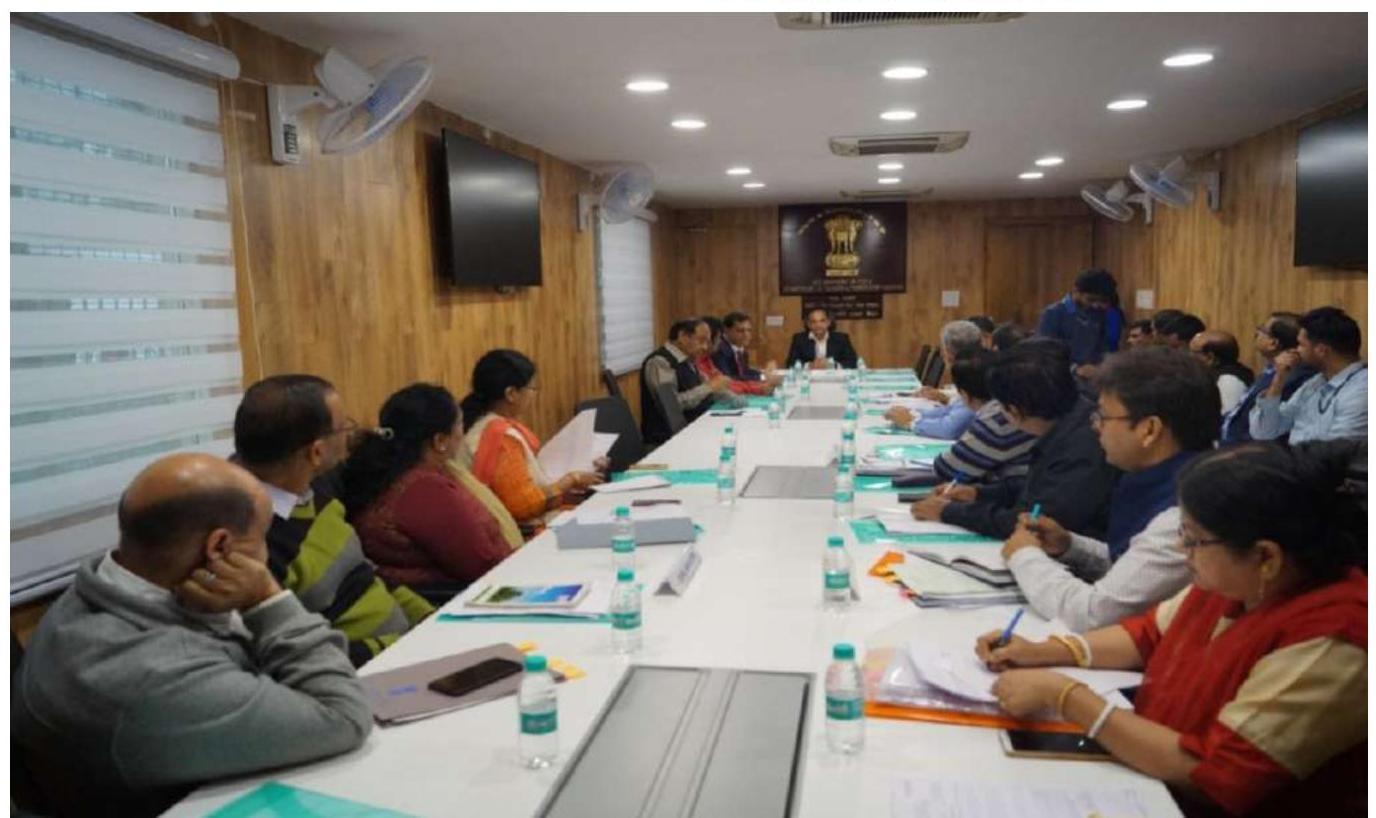
This department got conducted a root cause Analysis of pensioners’ grievances by an independent third party, keeping in focus the quality of disposal, which in some cases was not satisfactory. The methodology adopted was
a comprehensive review of focus ministries and after a Root Cause Analysis arrive on the basis of the grievances. The feedbacks were also analysed along with the redressal procedure.
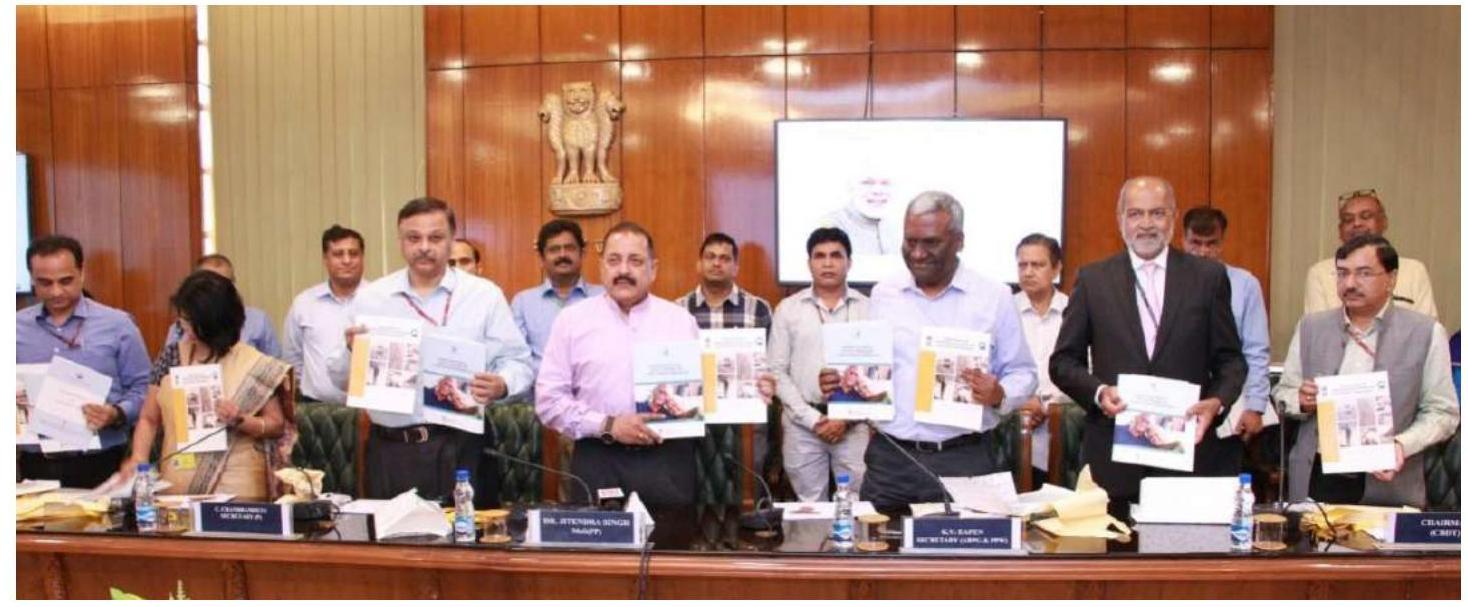
As a result of this exercise the various stakeholders of grievances were identified and action taken to rectify the root causes of such grievances. This included meetings with banks in such cases where delay took place in initiation of pension/ family pension, disruption in pension credit, discrepancy in pension amount, not providing pension slips, delay in giving effect to change in branch as desired by the pensioner. Similarly, issues pertaining to CPAO were taken up such as revision of pre- 01.01.2016 pension revision cases, delay in issue of revised authority etc.
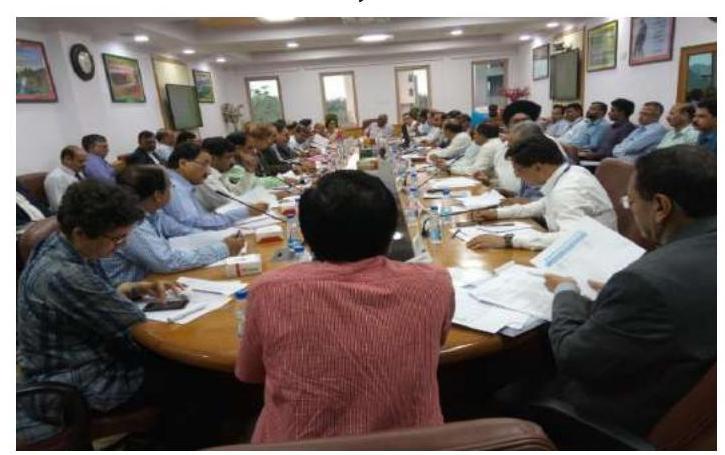
27.5 Pension Adalat:
This Department had started the unique experiment of holding Pension Adalat of those cases in CPENGRAMS which were either routinely closed by various Ministries or not disposed of within the time-line of 60 days. The methodology adopted was to invite all the stake-holders of a particular grievance on a single table viz. the concerned Department, the PAO, the concerned Bank and representative of the Pensioner and resolve the case across the table. Accordingly, the first Pension Adalat of the Department was held on September 20, 2017. 29 grievances, pertaining to different Ministries/Departments, which were old or where the pensioners had expressed dissatisfaction over the disposal by the concerned authorities, were selected from the unresolved grievances in CPENGRAMS. The petitioners as well as the concerned stakeholders viz. Ministry/ Departments/Organization/CPAO/Bank, etc were
invited to attend the above Adalat. During the first Pension Adalat, out of the 29 selected cases, 19 cases were resolved in the Adalat itself. 18 out of these 19 cases, were resolved by accepting the
claims of the Pensioners. Suitable instructions were given to the concerned Departments in the remaining cases. As on November 30, 2017, out of 29 grievances raised in Adalat, 26 have been resolved.
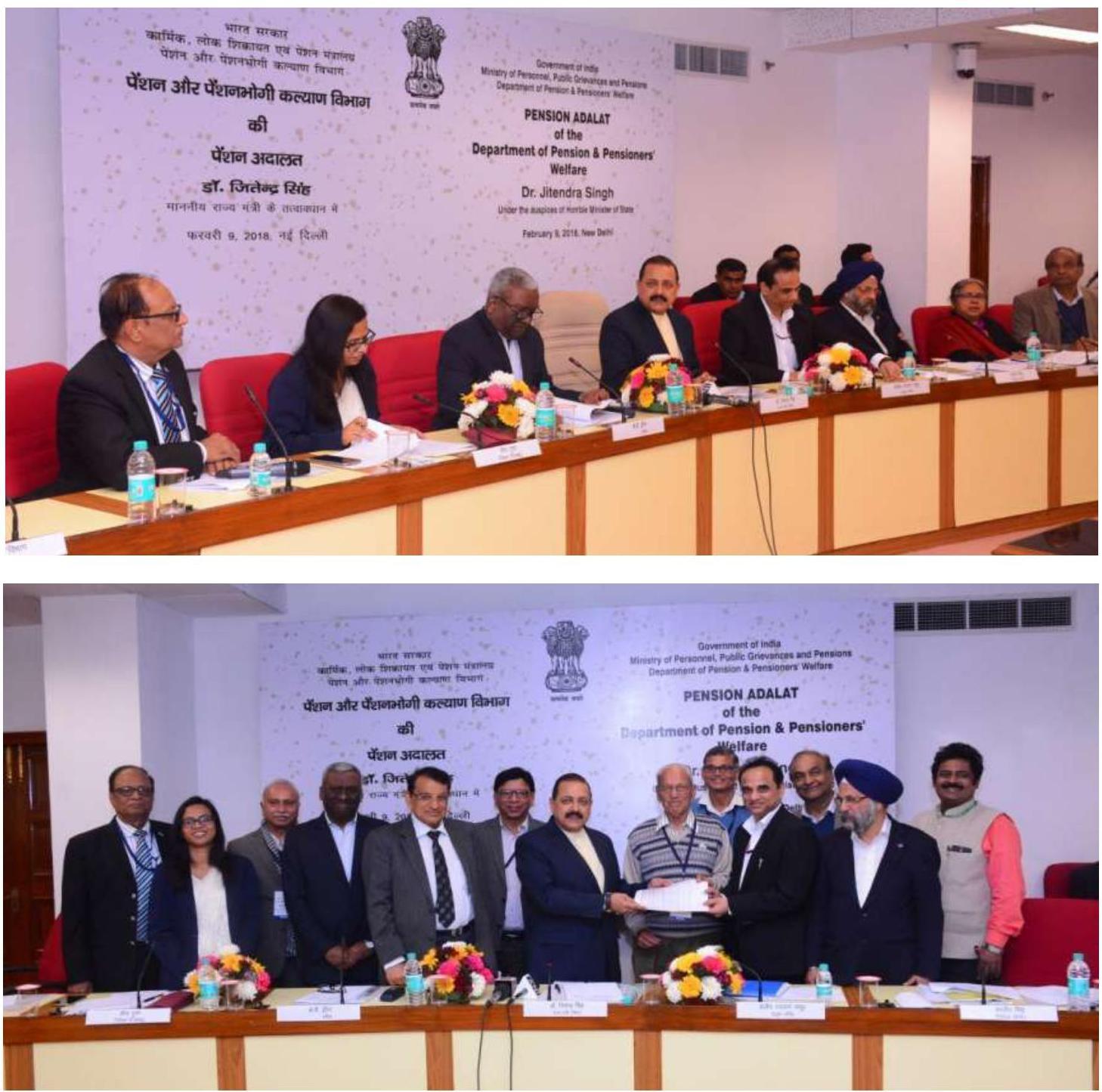
Encouraged by the response and speedy justice delivered, the Department organised the $2^{\text {nd }}$ Pension Adalat on February 9, 2018. 34 pending pension grievances were taken up and the various
stakeholders from Ministries, Departments, Banks, CPAO, were called upon to redress the grievances on the spot. The cases included revision of Family Pension, Commutation of Pension, final settlement
of GPF, Fixed Medical Allowance etc. Out of the 34 selected cases, 20 cases were resolved in the Adalat itself. Out of these, 19 cases were resolved by accepting the claims of the Pensioners. Suitable instructions were conveyed to the concerned Departments for resolving the remaining cases. As on November 30, 2018, out of 34 grievances raised in Adalat, 30 have been resolved.
The Departmental Parliamentary Standing Committee for Ministry of Personnel, Public Grievances & Pensions in its $95^{\text {th }}$ Report appreciated the system of holding Pension Adalats and suggested that a day may be dedicated to the Pensioners, as a part of good governance, and efforts be made to minimise their grievances. The Committee had suggested holding Pension Adalats, on a particular day, across Ministries, throughout the country, with this objective in view.
All India Pension Adalat – 2018: In its attempt to devote one day in the year to Pensioners, Department of Pension \& Pensioners’ Welfare conducted an All India Pension Adalat on September 18, 2018, which was inaugurated by the Hon’ble MoS (PP).
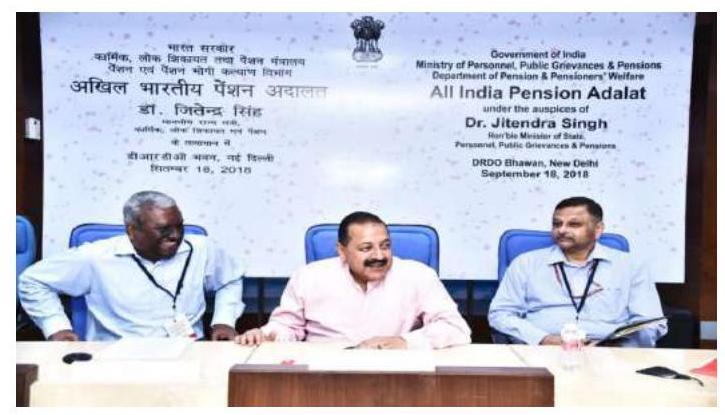
These Adalats were conducted across Ministries/ Departments throughout the country including all the Central Armed Police Forces (CAPFs) as well as non-Civil Ministries viz. Defence, Railways, Telecom
and Posts. The Chief Secretaries of States were also asked to conduct Adalats for the All India Service Pensioners who fall within the jurisdiction of this Ministry. The model followed was to bring all the stake-holders viz.the Heads of the Department, the PAO office and the concerned Bank, on one table along with the pensioner or his representative and provide on-the-spot resolution. From the reports received, 12,849 cases were taken up for redressal in these Pension Adalats. 9,368 (73%) grievances relating to Central Govt. Ministries/Departments/ Organisations were resolved on the same day. In addition to this, States/UTs, also conducted Pension Adalat for All India Service retired officers, during which 1614 grievances were settled on the same day. This was one of the largest Pensioner Grievance resolution exercises ever undertaken in the country.
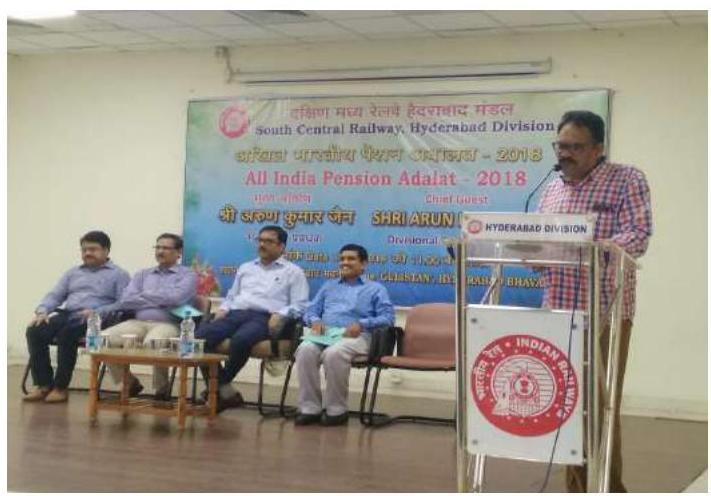
On the same day, the Department of Pension \& Pensioners’ Welfare also took up 32 grievances of various Ministries where the pensioner has expressed his / her dissatisfaction over the disposal by the concerned authorities. These cases were selected from the unresolved grievances in CPENGRAMS portal. In addition, 4 cases which could not be resolved in the last Pension Adalat were also reviewed. Out of these, 22 cases were settled on-the-spot in the Adalat. Suitable instructions/
directions were given in the remaining cases to the concerned Departments/PAO’s/CPAO’s/Banks to resolve the grievances within a given time frame.
27.6 BHAVISHYA – Online Pension Sanction and Payment Tracking System:
The total numbers of pensioners of civil Ministries/ Departments in the Central Government is 10.06 lakhs as on 31/03/2018. A very large percentage of grievances pertain to delay in commencement of pensions by various departments. To streamline the process of pension sanction, DOPPW introduced unique innovative centralized pension processing software called ‘Bhavishya’ for all Central Government Civil Ministries/Departments. The ‘Bhavishya’ software was indigenously made by the Department of Pensions and was meant to be a common platform for processing of pension cases on this platform by all Civil Ministries and Departments of Government of India. This software brought all the stakeholders on a common platform who were till date decentralized on to a single platform. Bhavishya has laid down the foundation of e-PPO with the integration of PFMS system of Controller General of Accounts and PARAS system of Central Pension Account Office. The system laid down a common methodology incorporating all the rules and regulations of CCS (Pension) Rules, 1972 and automatic calculation of pension. This system does automatic pension processing of dues and therefore eliminates manual intervention ensuring transparency in the system. The system on its own keeps throwing up alerts to the pensioner as well as to the stakeholders for meeting out the deadlines prescribed for various stages. As on date in 407 offices pension papers are moving electronically from retiree to Head of Office, Pay and Account Office and to CPAO.
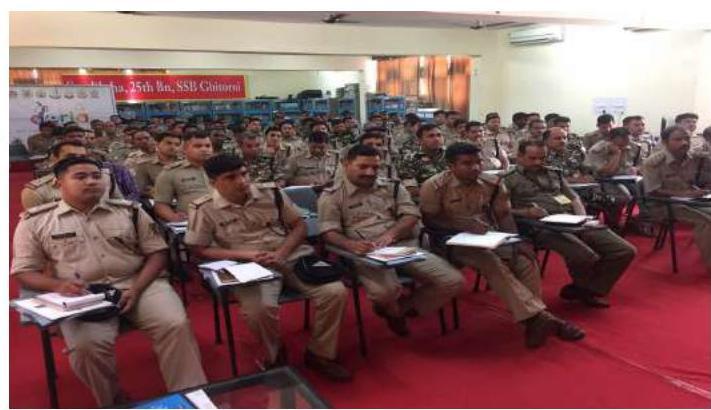
Till date, 6880 DDOs are on the board of Bhavishya processing pension cases of 34554 retiring/ retired employees/family pensioners. Further, this application has so far cumulatively processed and issued PPOs in respect of 58,425 employees till 26.03.2019.
All the Central Armed Police Forces (CAPFs) i.e BSF, CRPF, CISF, Assam Rifles, ITBP and SSB are on-board and processing their pension cases through Bhavishya. Bhavishya has also been made operational for processing the Family Pension/ Invalid Pension/ Extra Ordinary Pension/ExtraOrdinary Family Pension cases for the employees covered under National Pension system (NPS).
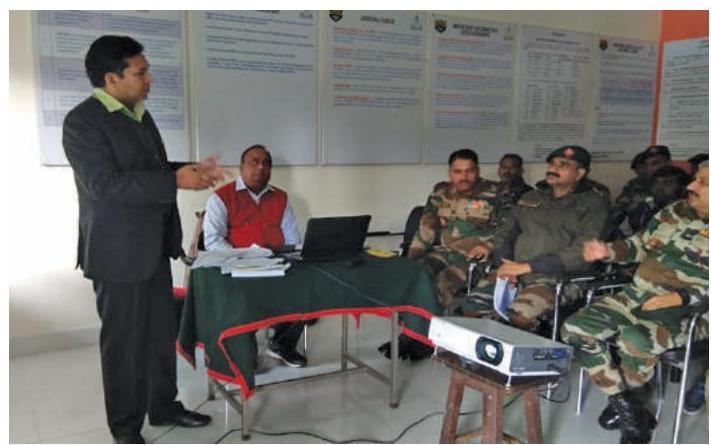
After covering Ministries/Departments, Bhavishya has been expanded to cover Central Government Employees working under UTs and Delhi Police Administration. Accordingly, Hands-on training to 96 dealing officials of Delhi Police Administration
has been completed by November, 2018 while the same for UTs i.e. Chandigarh, Daman & Diu, Dadar\& Nagar Haveli and Lakshadweep are under process.
27.7 Creating awareness on pensioners’ entitlements and Rules:
As recommended by the Parliamentary Committee of the Ministry of Personnel, Public Grievances and Pensions in its $95^{\text {th }}$ report, the Department this year made more efforts to reach out to the pensioners, especially family pensioners, to inform them about government schemes meant for them including changes brought about in their entitlements. A major part of this effort was the making of a documentary by the Department highlighting simplification of rules effected with respect to the pensioners’ entitlements. This documentary was posted on the official website of the Department, as well as on YouTube and 1.86 lakh hits were recorded showing that it was quite popular and had the desired effect.
Electronic, print and social media have a vital
role in creating awareness of pensioners who are residing in various parts of the country. This Department therefore, planned and executed an awareness campaign by utilizing all of the above as well as holding awareness programs/ workshops in different parts of the country. As against a budget provision in FY 2018-19 under the head Advertisement and Publicity of Rs. 3.73 crores, an amount of Rs. 3.61 crores was incurred by 27.03.2019. The pensioners’ entitlements were published in 423 national and regional dailies through the year.
Training programs at various locations were also organised for the retirees, pensioners and dealing staff. In this year, 1390 retirees participated in pre-retirement counselling held at Delhi, Kolkata, Lucknow, Ghaziabad, Patna and Chennai. 943 officials processing the pension cases were imparted training about pension rules and online processing of pension cases. 120 master trainers were created to further impart the training in their organization about pension rules and process.
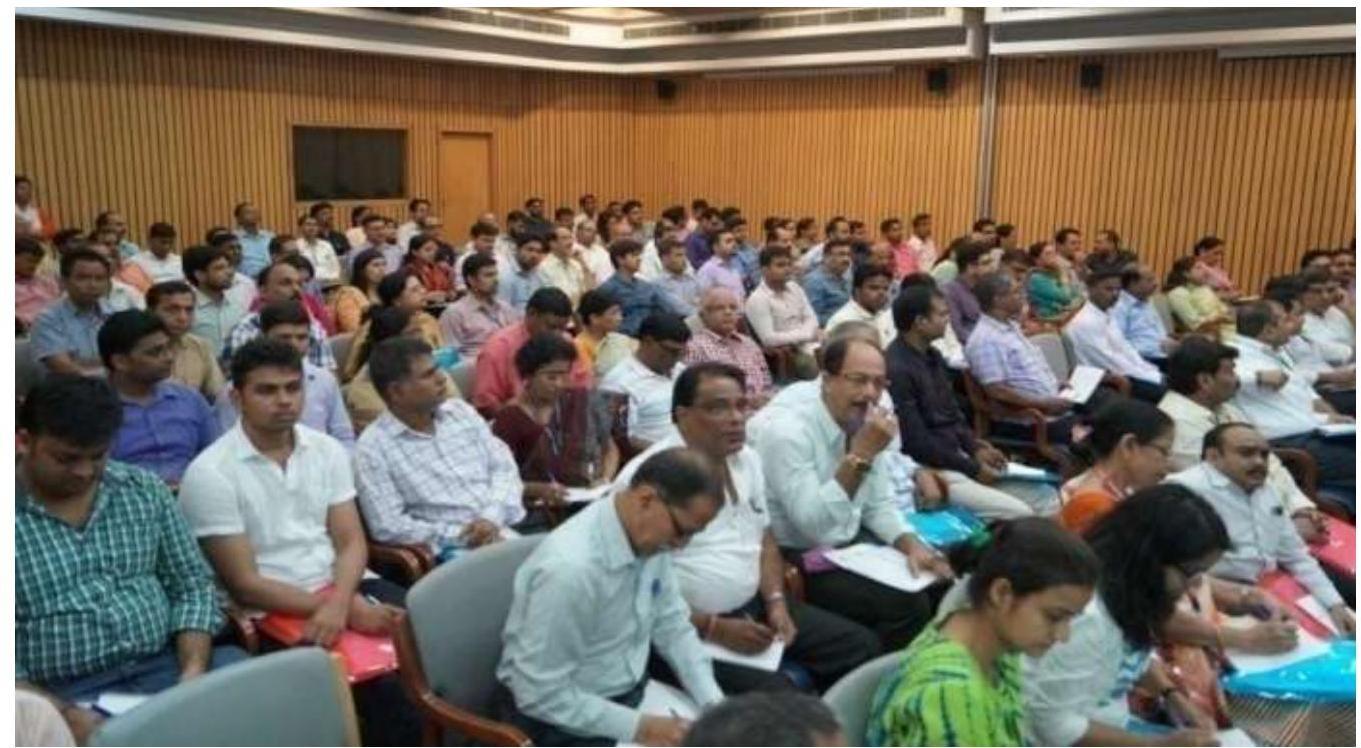
27.8 ANUBHAV:
On the directions of the Hon’ble Prime Minister of India, Department of Pension & Pensioners’Welfare had launched an online platform entitled ‘Anubhav’ for sharing experiences of retiring government employees while working with the Government. It is envisaged that over a period of time, this will create a wealth of institutional memory with replicable ideas and suggestions. This will prove an invaluable tool for helping in future governance related issues since a treasure trove of wealth shall be left behind by the retiring generations of Government employees and officers.
Further, this department organised an analysis of the Anubhav portal through an independent third party with the objective to improve the working of the portal and concretizing the system of shortlisting best write ups for Anubhav Awards. It may be recalled that Anubhav Awards were instituted in order to encourage Government servants to leave behind their experiences. As a result of the same, a proper system for evaluation of write ups was put in place with participation of departments other than DoPPW in the evaluation committee. Different areas of working were also short-listed for the awards so that all areas of government working get by and large covered and to give maximum participation of all departments with respect to their work.
During the Third Anubhav Award Ceremony, six Awards were given by the Hon’ble Minister of State (PP) on September 18, 2018 to selected write-ups published from April 1, 2017 to March 31, 2018 on Anubhav Portal.
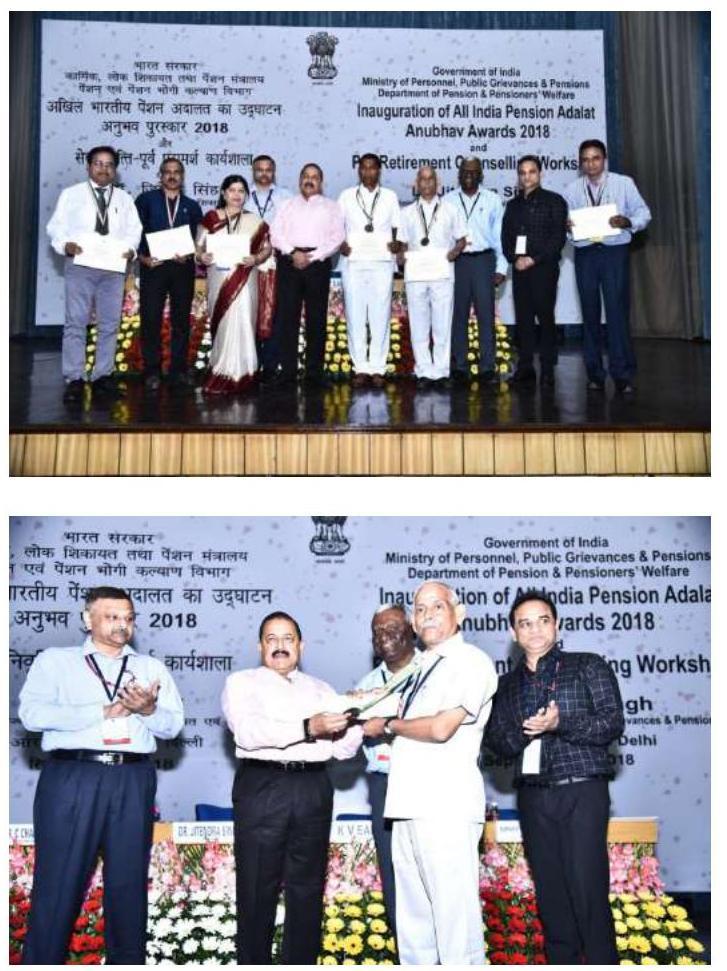
Third Anubhav Awards distribution on September 18, 2018
91 organizations have registered on Anubhav Portal of this Department, 5992 write-ups have been published and 2498 write-ups which have been uploaded are waiting to be published as on 31.03.2019.
27.9 SANKALP:
India has a fast aging population. Average life expectancy has risen to 69 years India and pensioners have on an average 10 years of postretirement life. Their withdrawal from the work sphere has important implications for them and in most cases lead to their confinement within their private sphere. In short, at retirement, social vulnerability increases and physical health goes down due to an inactive life. Ironically, at the time of retirement the Pensioner is at the height
of experience in the area in which he has devoted his entire career.
Keeping these factors in view, the Department initiated the scheme entitled ‘Sankalp’ which aims to prepare retiring/retired Government servants for a fulfilling post-retirement life. Under Sankalp, pre-Retirement Counseling Workshops are being organized for retirees. These counselling sessions provide a detailed overview of entitlements of the pensioner and other benefits, CGHS facilities, investment plans, income tax incentives to senior citizens and voluntary engagement after retirement. Till date, 46 such Pre-Retirement Counselings Sessions have been organized, benefitting 5272 number of employees.
‘Training of Trainers’ workshop has also been initiated to strengthen in-house capabilities of Government Ministries/Departments for conducting their own Pre-retirement counseling for their retiring employees. The Department has conducted 15 ‘Training of Trainers’ workshops till date creating a pool of around 760 trainers. These Master trainers are able to further conduct PreRetirement Counseling (PRC) for their employees within Departments.
As the desire to remain active and socially connected attracts retired volunteers to service, D/o Pension & PW took up following activities this year where pensioners have offered their services voluntarily.
- Pensioners’ Associations took up cleanliness drives in schools, residential complexes, streets, drains as well as in Parks. They also conducted awareness drives on waste collections amongst children, shop-keepers and households.
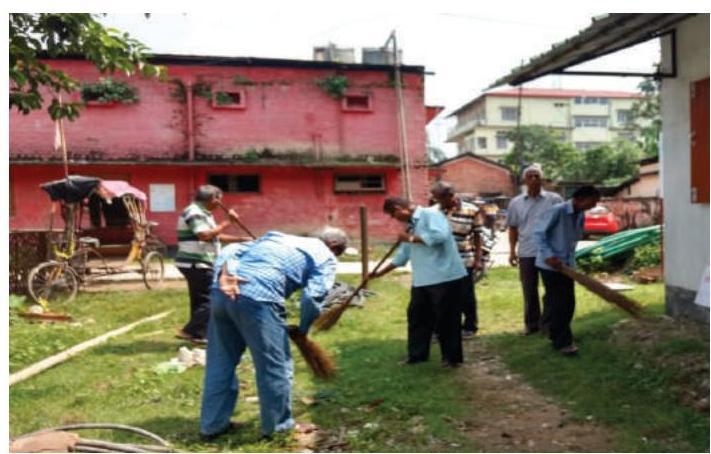
- Tree plantation drive was organized on 20.7.18 by retirees residing in Rohini, Delhi
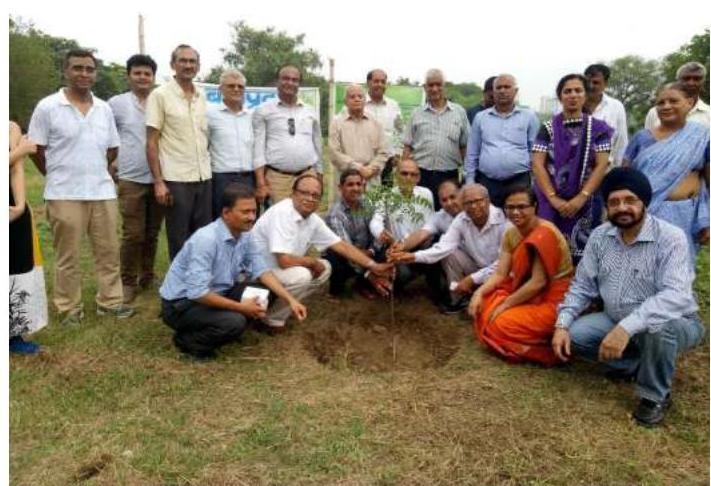
- A workshop was organized on 10.01.18 in the presence of Hon’ble MoS (PP) wherein about 125 retirees interacted with 6 NGOs with a view to explore volunteer activities in their post retirement life.
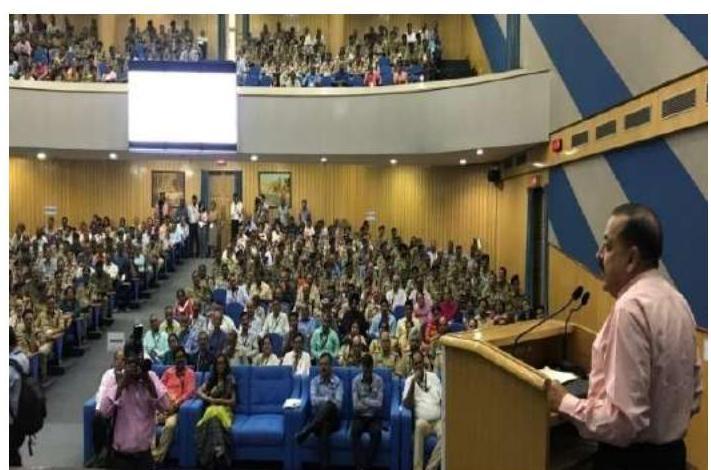
- A special awareness program on geriatric health care and yoga was organized on 11.07.18 with the help of doctors of the AIIMS & Morarji Desai National Institute of Yoga at Delhi.
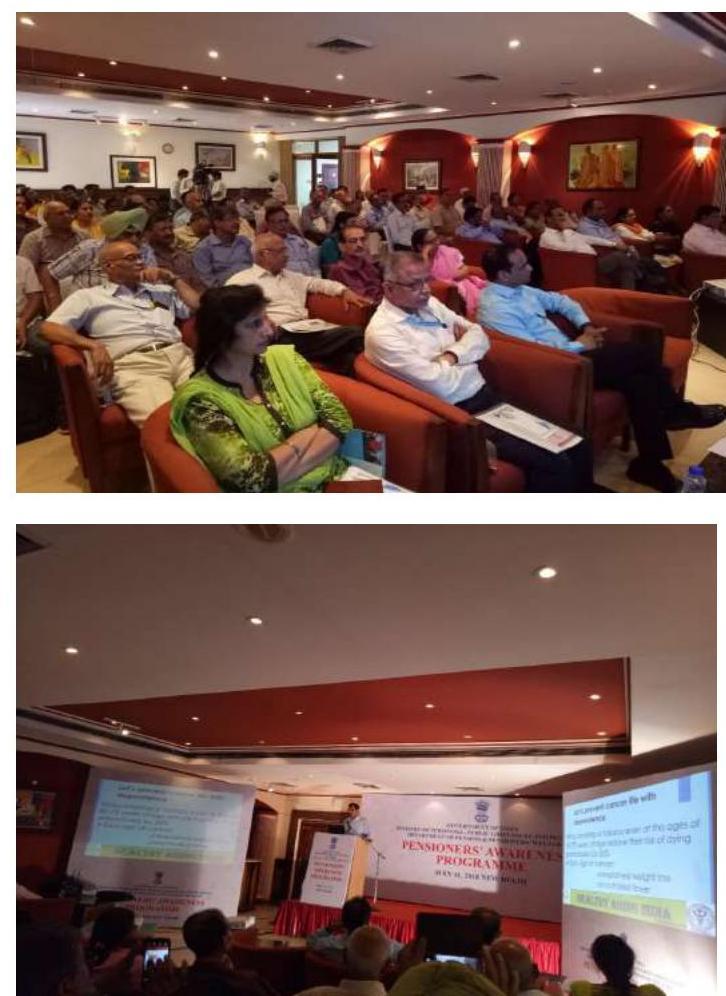
- Keeping in view the great discomfort experienced by very senior and ailing Pensioners in queuing up outside Banks in the month of November to give their Life Certificate, the Department undertook a path breaking initiative: involve Pensioners’ Associations in eight cities on a pilot basis and obtain Digital Life Certificate from home of such Pensioners. For achieving this objective, the Department procured 24 portable tablets through GeM, equipped with IRIS scanners, since often fingerprints do not get picked up easily of aged people. This was a pilot program conducted in Noida/Delhi, Chandigarh, Dehradun, Mumbai,
Mysore, Vadodara, Trivandrum \& Bangalore. Till 30.11.2018, 2200 number of DLCs was obtained from homes of aged Pensioners.
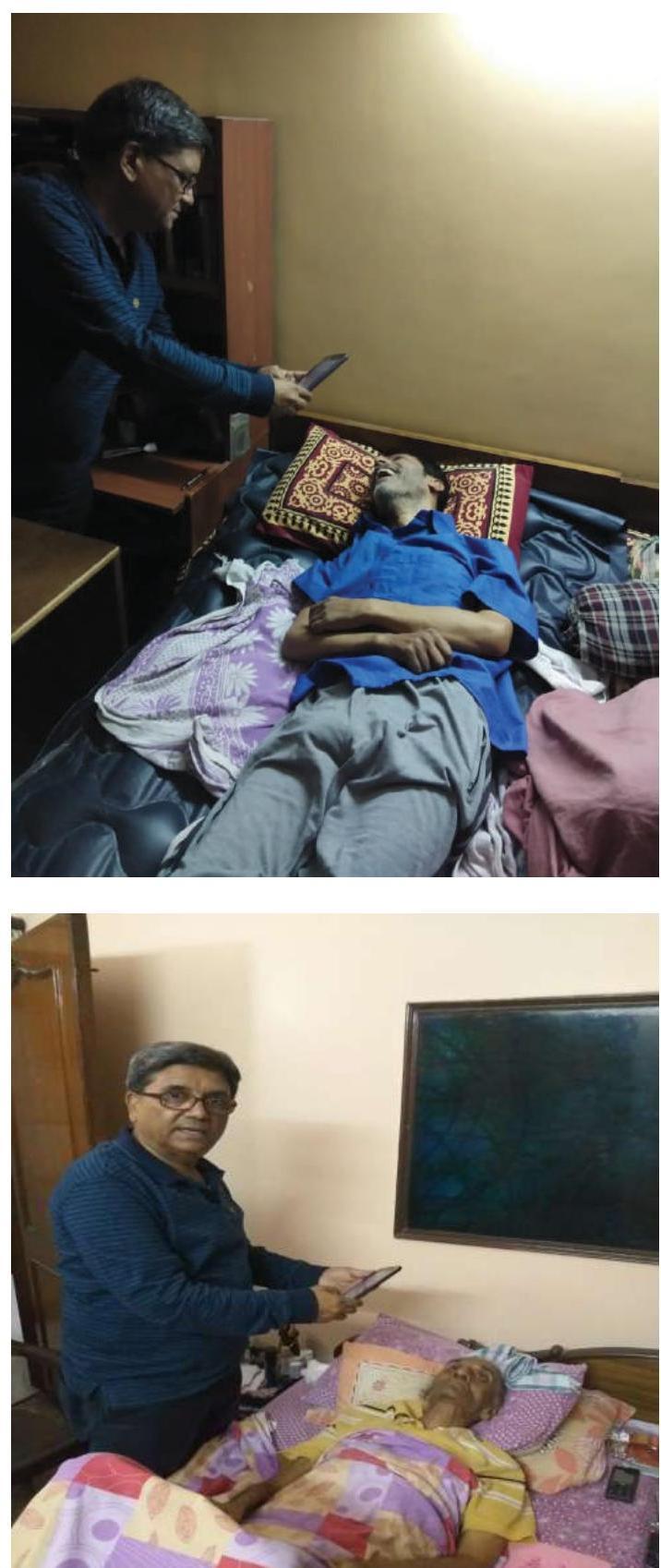
27.10 JEEVAN PRAMAAN:
An Aadhar based scheme for online submission of digital life certificate through Jeevan Pramaan portal was launched by the Hon’ble Prime Minister in November, 2014. Keeping in view the welfare of pensioners’ this Department has been promoting Digital Life Certificate i.e. Jeevan Pramaan. The scheme benefits pensioners specially the old and infirm who can submit life certificate from the comfort of their homes anywhere in the country or abroad. This is an additional facility made available to Central Government pensioners. It is designed to eventually cover all pensioners across the country.
DLC from home Pilot Project: The DoPPW, is conducting Pilot Programme to reach out to aged (above 80 years) and infirm pensioners who are unable to visit bank branches and stand in queue for submission of Annual Life Certificate in the month of November, to submit Jeevan Pramaan from their home. The Pilot Programme was run w.e.f. 01.11.2018 through identified Pensioners Associations in Dehradun, Mumbai, Bangaluru, Vadodara, Trivandrum, Mysore, Chandigarh, Noida and Delhi during the current F.Y 2018-19.
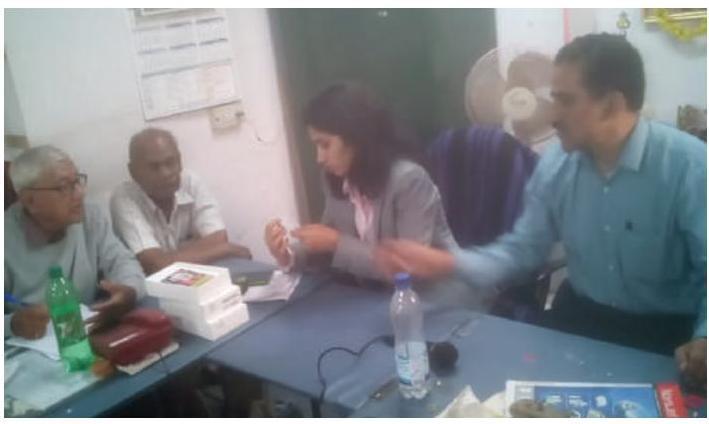
Other efforts made by the Department towards this endeavour include: –
(i) A Documentary was made, explaining in
detail the way in which Digital Life Certificate can be submitted for making the Pensioners aware of the methodology for the same. This documentary was posted on YouTube and till November 30, 2018, 1,70,000 hits were recorded. This has particularly helped those Pensioners who are either abroad with their children or those who due to age or illness are not in a position to leave the comfort of their homes. The film by its concept covers all the steps and information required for giving DLC. As a result of this publicity including through audio-visual, Social network media like Twitter, Whatsapp etc. to reach out to the pensioners, the total number of DLCs received by November 30,2018 were 2,83,852 as compared to $2,38,446$ in the previous corresponding period recording a jump by $19 %$.
(ii) Meetings with Banks and requesting them to instruct their branches that any pensioner going to submit Life Certificate to any bank branch should not be returned without submission of life certificate. It was stressed that the entire procedure should be automated i.e. downloading Digital Life Certificate (DLC) generated by Jeevan Pramaan Server and matching the details with their data base and sending SMS to pensioner regarding matching/mismatching of the data for uninterrupted payment of pension. Banks were also requested to cooperate with Pensioners Associations during the Pilot Programme in those places where Pilot Programme was conducted.
27.11 Standing Committee of Voluntary Agencies (SCOVA):
A Standing Committee of Voluntary agencies
(SCOVA) has been set up under the Chairmanship of MOS (PP) with a view to provide feedback on the implementation of policies/programmes of this Department besides mobilizing voluntary effort to supplement the Government action. The SCOVA consists of a Standing Group (5 members) and a Rotating Group (10 members). SCOVA was
reconstituted in January, 2018. The last SCOVA meeting was held under the Chairmanship of Dr Jitendra Singh, Hon’ble Minister of State (PP) on March 23, 2018 in New Delhi, which was attended by representatives of various Pensioners Associations and the Ministries/Department.
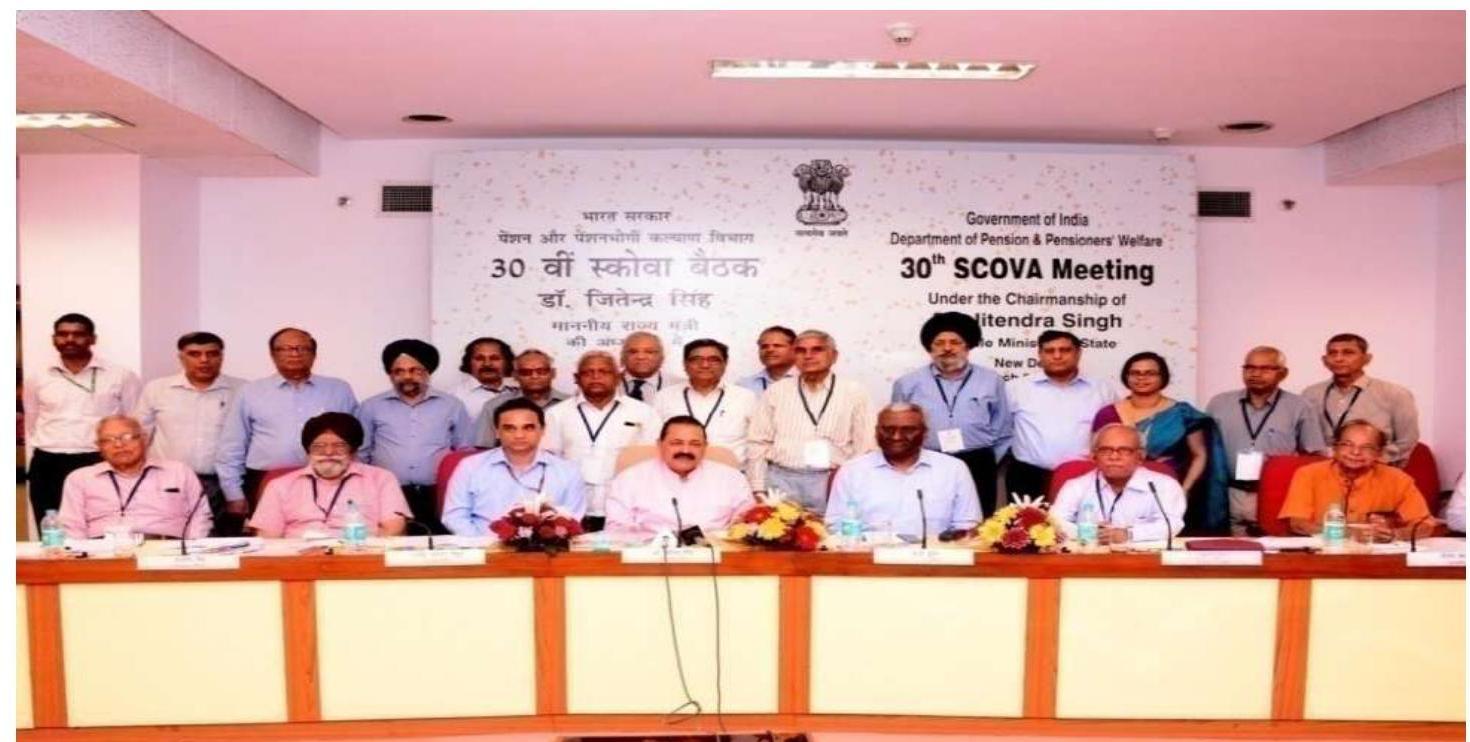
27.12 Dearness Relief to Pensioners/ Family Pensioners:
Revised rates of Dearness Relief (DR) to Central Government Pensioners/Family Pensioners on implementation of decision taken on recommendation of $7^{\text {th }} \mathrm{CPC}$ are admissible at following rates:-
| Date from which payable |
Rate of Dearness Relief per month |
|---|---|
| From 01.01 .2018 | $7 %$ of Basic Pension/Family Pension |
| From 01.07 .2018 | $9 \%$ of Basic Pension/Family Pension |
| From 01.01 .2019 | $12 \%$ of Basic Pension/Family Pension |
For the convenience of all Ministries/Departments/ Banks/Treasuries/Post Offices, orders are hosted on the website of this Department. This facilitates faster payment of enhanced DR by Pension Disbursing Authorities.
The process has been streamlined to ensure that enhanced DR orders are issued with a minimum time lag with reference to the orders for enhancement of DA.
27.13 Important Policy decision(s)
- The minimum pension has been incurred to Rs.9,000/- per month as against existing minimum pension of Rs.3,500/- per month.
- The minimum disability pension and family pension covered under CCS(EOP) Rules of a Government servant/ family of the deceased Government servant holding a pensionable post has been enhanced to Rs.18,000/- per month vide OM No. 1/4/2016-P&PW(F) dated 02.08.2017.
- The ceiling of gratuity has been increased from the existing Rs. 10 lakhs to Rs. 20 lakhs.
- A new slab of death gratuity has been added. The family of a Government servant dying while in service with a qualifying service of 11-20 years would be entitled to death gratuity at 20 times of emoluments.
- Ther rates of ex-gratialumpsumcompensation being paid to the families of employees who die in performance of duty has been increased from existing 10-15 lakhs to Rs. 2545 lakhs, depending upon the circumstances in which the death occurs.
- Orders were issued on 04.08.2016 and 12.05.2017 for revision of pension of Pre2016 pensioners/ family pensioners.
- The Constant Attendant Allowance being paid to disability pensioners has been revised from the existing Rs.4500/- p.m to Rs.6750/p.m. vide OM No. 1/4/2017-P\&PW(F) dated 02/08/2017.
- The Department issued an order dated July 19, 2017 increasing the amount of Fixed Medical Allowance from Rs.500/- per month to Rs.1000/- per month payable to the Central Government Pensioners residing in areas not covered under CGHS, w.e.f. 01.07.2017.
- The Department issued orders on July 19, 2017 stating that the Family Pension to divorced daughter to be granted even in
such cases where divorce proceedings had been filed in a competent court during the life time of employee/pensioner or his/her spouse but divorce took place after their death, provided the claimant fulfils all other conditions for grant of family pension under Rules 54 of CCS (Pension) Rules, 1972. - To ensure timely payment of pension benefit, DoPPW issued an order dated August, 2017 for handing over the pensioner’s copy of PPO at the time of retirement alongwith other retirement dues. The pensioner is no longer required to visit the bank for getting first payment of pension.
- Vide Order dated 31.01.2018 Certification of CMO has been dispensed with for claiming Fixed Medical Allowance to the pensioners residing in the city not covered under CGHS.
- Rule 38 of the Central Civil Services (Pension Rules), 1972, after obtaining approval from the Department of Expenditure is in the process of being amended to provide that Government employees who retire on account of any bodily or mental infirmity may be granted invalid pension without linking it with the length of qualifying service. In other words, the Government servants are now eligible for invalid pension even if their qualifying service is less than 10 years.
- Orders have been issued on 04.01.2019 that pre-2006 pensioners, who retired from $5^{\text {th }} \mathrm{CPC}$ pay scale of Rs. 6500-10500/- or equivalent pay scales in the earlier pay commission periods, would be entitled to revision of pension w.e.f 1.1.2006 with reference to the Grade Pay of Rs 4600/- instead of Rs 4200/-.
- The Department issued an order dated $10^{\text {th }}$ October 2018 for revision of disability pension
and family pension under CCS (EOP) Rules to pre 1996 and pre 2006 disability pensioners and family pensioners under CCS (EOP) Rules and included Non-practicing Allowance (NPA) for revision of disability pension and family pension covered under CCS (EOP) Rules to retired medical officers.
15. The Department issued an Office Memorandrum dated 24th January, 2019 allowing two family pensions under CCS (EOP) Rules on death of a re-employed pensioner on his death attributable to Govt. service, vide OM No. 01/03/2016- P&PW(F) dated 24/01/2019.
16. A Committee under the Chairmanship of Secretary, Department of Pension and Pensioners Welfare was constituted by Department of Financial Services to suggest measures for streamlining the implementation of National Pension Scheme. The Committee submitted its report on 28.02.2018. Based on the recommendations of the Committee, the Government has taken the following decisions: –
- Enhancement of the mandatory contribution by the Central Government for its employees covered under NPS Tier-I from the existing 10% to $14 \%$.
- Providing freedom of choice for selection of Pension Funds and pattern of investment to Central Government employees.
- Payment of compensation for non-deposit or delayed deposit of NPS contributions during 2004-2012.
- Tax exemption limit for lump sum withdrawal on exit has been enhanced to $60 \%$. With this, the entire withdrawal will now be exempt from income tax.
27.14 ख्वख्ता ही सेवा, 2018 (SHS)”
DoP\&PW, vide letter dated August 27, 2018 \& September 6, 2018 had requested 47 Pensioner Associations identified under Pensioner Portal Plan Scheme for observance of “स्वखता ही सेवा, 2018 (SHS)” from $15^{\text {th }}$ September, 2018 to October 02, 2018. A special cleanliness drive was also undertaken of the office by this Department along with beautification of surroundings and cleaning of common area during the period.
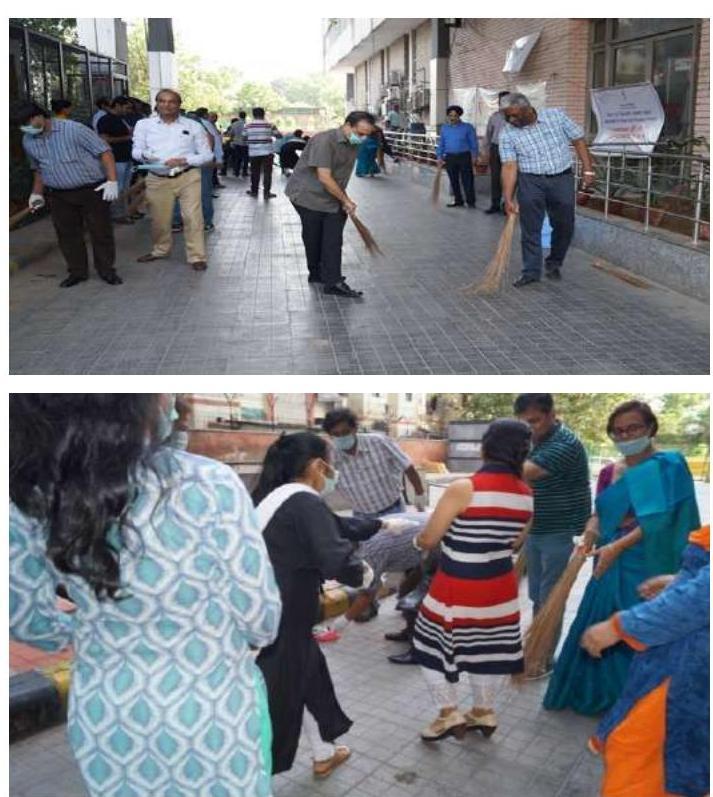
27.15 Hindi Pakhwara
Hindi Pakhwara was organized by the Department in the month of September from 14- 28 September, 2018 to inculcate the spirit of use of Hindi in official noting, drafting and communications. Seven Hindi Competitions – Hindi Noting and Drafting, Hindi Translation, Hindi Slogan Writing, Hindi Advertisement, (three competitions, one for officers and two for staff) Official Language questionnaire and General Knowledge were organized for the staff members and awards were distributed to all
the first three winners in each competition. Total seventeen winners were given certificates during the Hindi Pakhwarda Award Ceremony by the Department.
27.16 Miscellaneous activities:
I. Facilitation Centre -A facilitation centre for Pensioners was made with a view to provide a seating space for pensioners who visit the DOPPW either to register their grievance or to discuss pension related issues with officials. This also serves the purpose of a Conference Room for DoPPW.
II. Implementation of E-office – D/o Pension & PW receives many references on pension rules from different Ministries/Departments as well as individual grievances from pensioners. Earlier retrieving a previously lodged grievance was a tedious issue since thousands of postal dak is received every week. Therefore, it was decided to implement e-office completely and make DoPPW a paperless office. As on date all receipts and file movement takes place through e -office and for accomplishing this task an appreciation certificate was awarded to DoPPW by Hon’ble MoS (PP).
III. Implementation of Employee Information System- The Department implemented EIS module for generating salary of employees. All information regarding joining of individual to working in different pay scales was made online available to DDO as well as to working employee. Employees can generate salary slip on any month through this system.
IV. Speeding up the process of pension revision of pre-2016 pensioners-The following steps were taken by the Department to speed up the pension revision of pre-2016 pensioners –
- Concordance table was released to make uniformity amongst various authorities for fixation of pension.
- Bhavishya module was expanded with inbuilt calculation, so that Head of Office working in different Ministries/ Departments may process the case expeditiously.
- Meeting organised with banks to clear the pendency of paying arrear to pensioners at their end.
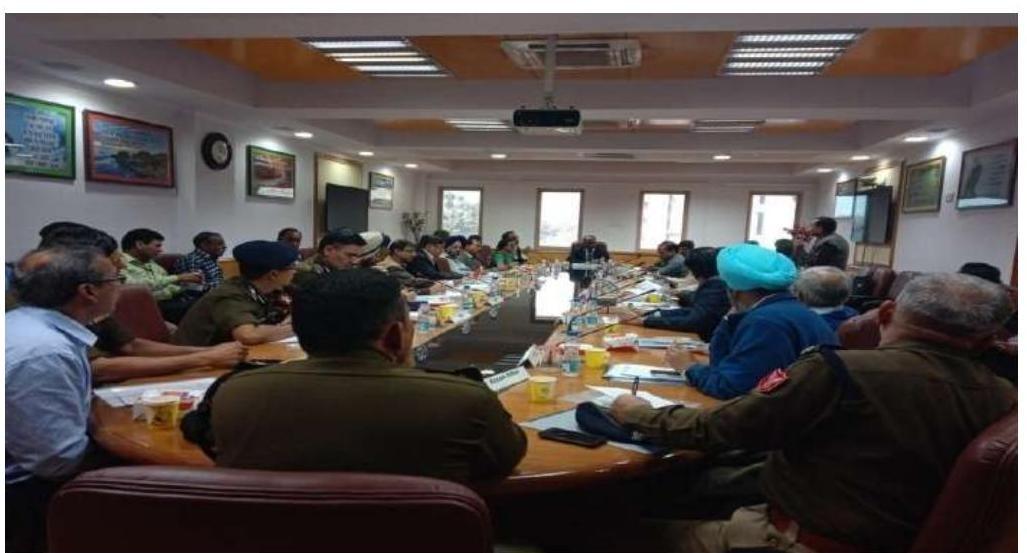
Secretary (Pension) reviewing status of revision of pre-2016 pensioners/ family pensioners.
27.17 Yoga Session: – The Department of Pension and Pensioners’ Welfare celebrated $4^{\text {th }}$ International Day of Yoga on 21.06.2018 at Lok Nayak Bhavan, New Delhi. On this occasion this department organised Yoga Sessions from 19.06.2018 to 21.06.2018 at Lok Nayak Bhavan, New Delhi. The Yoga Session programme was completed successfully. All officers and staff have participated during the yoga sessions. On the request of Officers/Staff of this Department, Yoga
sessions have further been arranged once in a week with the help of Yoga Expert from Morarji Desai National Institute of Yoga, Ministry of Ayush from 29.06.2018 to 27.07.2018. This Department has also been organizing Yoga sessions twice a week from February, 2019 to March 2019 with the help of Yoga Expert from Morarji Desai National Institute of Yoga, Ministry of Ayush.
ANNEXURES
218 | ANNUAL REPORT 2018-19
Department of Personnel and Training
Incumbency Position of Group ‘A’ Officers in D/o Personnel and Training as on 31.03.2019
| Post | Name of Incumbent |
|---|---|
| Secretary(Personnel) | Dr.C. Chandramouli |
| Additional Secretary | 1. Shri.Lok Ranjan |
| 2. Shri.Pradip Kumar Tripathi | |
| 3. Shri. Srinivas Ramaswamy Katikithala | |
| 4. Ms. Sujata Chaturvedi | |
| Joint Secretary | 1. Shri.Vijoy Kumar Singh |
| 2. Shri.G.Dev Tripathi | |
| 3. Shri.Mukul Ratra | |
| 4. Smt. G. Jayanthi | |
| Director | 1. Shri.J.Srinivasan |
| 2. Shri.Kabindra Joshi | |
| 3. Ms. Rajul Bhatt | |
| 4. Ms. Sagarika Patnaik | |
| 5. Shri. Shri Prakash Dubey | |
| 6. Shri. Subramanya M.S. Rao | |
| 7. Ms.Varsha Sinha | |
| Principal Staff Officer | 1. Shri. Neeraj Sagar |
| Deputy Secretary | 1. Shri.A.K.Saha |
| 2. Shri.Ashish Madhaorao More | |
| 3. Shri. Ashok Kumar Jain | |
| 4. Ms. Ashwini Dattatraya Thakre | |
| 5. Shri.A.N.Narayanan | |
| 6. Shri. Anindya Bhattacharya | |
| 7. Shri. Anurag Sharma | |
| 8. Shri.I.P.Nagpal | |
| 9. Shri.Juglal Singh | |
| 10. Ms. Khushboo Goel Chowdhary | |
| 11. Shri. Moloy Sanyal | |
| 12. Shri. Naeem Ahmad Siddiqui | |
| 13. Ms. R. Gayathri |
| Post | Name of Incumbent |
|---|---|
| 14. Shri. Shivendra Chaturvedi | |
| 15. Ms. Smita Sarangi | |
| 16. Shri. S.P. Pant | |
| 17. Shri. Syed Imran Ahmed | |
| 18. Shri. U.S. Chattopadhyay | |
| 19. Shri. Umesh Kumar Bhatia | |
| 20. Ms. Vanita Sood | |
| Senior Principal Private Secretary | 1. Shri. Harish Kumar Chawla |
| 2. Shri. M.P. Varadharajan | |
| 3. Shri. Mukesh Bali | |
| 4. Shri. Panna Lal | |
| 5. Shri. P. Suresh | |
| 6. Shri. Ramesh Chand | |
| 7. Shri. Satish Kumar Thakur | |
| Principal Private Secretary | 1. Shri. A. Arun |
| 2. Ms. Anita Kalra | |
| 3. Shri. Amit Munjal | |
| 4. Shri. A.Y. Aanad Raj | |
| 5. Ms. Dalvinder Kaur | |
| 6. Shri. Jay Prakash Singh | |
| 7. Ms. Jayashree Halder | |
| 8. Ms. Jyoti Arora | |
| 9. Shri. Lalit Kumar | |
| 10. Shri. Laxmi Narain | |
| 11. Ms. Maninder Kaur Grover | |
| 12. Shri. Manoj Duggal | |
| 13. Shri. Mathew Joseph | |
| 14. Shri. M.S. Rawat | |
| 15. Shri. Munesh Chand | |
| 16. Shri. Premakumaren V.K. | |
| 17. Shri. Raghunath Sethi | |
| 18. Shri. R.K.Malhotra | |
| 19. Ms. Sangeeta Toppo | |
| 20. Shri. Satish Kumar | |
| 21. Shri. S.G. Mulchandaney | |
| 22. Ms. Sripada Swarnlatha | |
| 23. Shri. Sunil Kumar | |
| 24. Shri. Umesh Kumar Barua | |
| 25. Shri.Yati Raj Sehgal |
| Post | Name of Incumbent |
|---|---|
| Under Secretary | 1. Shri. Ajay Kumar Singh |
| 2. Shri.Amit Srivastava | |
| 3. Shri.Amit Srivastava | |
| 4. Smt. Anita Bilung | |
| 5. Shri. Anil Bajpai | |
| 6. Shri. Arvind Thakur | |
| 7. Shri. Avinash Chandra | |
| 8. Shri. Biswajit Banerjee | |
| 9. Shri. Brij Mohan | |
| 10. Shri. Chandra Shekhar | |
| 11. Shri. Chattra Mani | |
| 12. Shri. Chirabrata Sarkar | |
| 13. Shri. Dasari Ramesh Babu | |
| 14. Shri. Debabrata Das | |
| 15. Shri. George Deepak Toppo | |
| 16. Ms. Gracy Varghese | |
| 17. Shri. Jai Narain | |
| 18. Ms. Jayashree Chellamani | |
| 19. Ms. Jyotsna Gupta | |
| 20. Dr. Kartik Haeadekatti | |
| 21. Shri. K. Prakasham | |
| 22. Shri.K.C. Raju | |
| 23. Shri.K. Srinivasan | |
| 24. Shri. Kulbhushan Malhotra | |
| 25. Ms. Manjula Juneja | |
| 26. Ms. Manmeet Kaur | |
| 27. Shri. Manoj Gupta | |
| 28. Shri. Mukesh Kumar | |
| 29. Shri.Pankaj Gangwar | |
| 30. Shri. P.K. Jaiswal | |
| 31. Shri. Pradeep. A | |
| 32. Shri. Pradeep kumar | |
| 33. Shri.Praveen Pal Singh | |
| 34. Ms. Preeti Khanna | |
| 35. Shri. Raj Kishan Vatsa | |
| 36. Shri. Rajbir Singh | |
| 37. Shri. Rajesh Sharma | |
| 38. Shri. Rajeev Bahree |
| Post | Name of Incumbent |
|---|---|
| 39. Shri. Raju Saraswat | |
| 40. Shri. Rakesh Kumar Gupta | |
| 41. Shri. Rishi Pal | |
| 42. Shri. R.P.Tewari | |
| 43. Shri. R. Venketasan | |
| 44. Shri. Sandeep Saxena | |
| 45. Shri. Sanjay Kumar | |
| 46. Shri. Sanjay Kumar Das Gupta | |
| 47. Shri. Santosh Kumar Verma | |
| 48. Shri. Satish Kumar | |
| 49. Shri. S.P.R.Tripathi | |
| 50. Shri. Subandu Basu | |
| 51. Shri. Sunil Kumar Mandi | |
| 52. Shri. Sukdeo Sah | |
| 53. Shri. Surya Narayan Jha | |
| 54. Smt. Taruna Jangpangi | |
| 55. Shri.Udai Bhan Singh | |
| 56. Shri. Vasanthi V. Babu |
Incumbency Position of Group ‘A’ Officers in Public Enterprises Selection Board as on 31.03.2019
| Chairman (PESB) | Shri.K.D.Tripathi |
|---|---|
| Member (PESB) | 1. Shri.M.K.Gupta |
| 2. Shri.Madhusudhan Prasad | |
| Secretary(PESB) | 1. Ms. Kimbuong Kipgen |
| Director | 1. Shri.Kailash Dan Ratnoo |
| Principal Staff Officer | 2. Shri. Ram Roshan |
| Deputy Secretary | 1. Shri.C.A. Jacob |
| Senior Principal Private Secretary | 1. Shri. Rajender Singh |
| 2. Shri. Virendar Aggarwal | |
| Principal Private Secretary | 1. Shri. Arvind Bhardwaj |
| 2. Shri. Girish Kumar Ahuja | |
| 3. Shri. Suneel Kumar | |
| Under Secretary | 1. Shri. Ajit Kumar |
ANNEXURES
Annexure-II
ORGANIZATION CHART OF DEPARTMENT OF ADMINISTRATIVE REFORMS AND PUBLIC GRIEVANCES
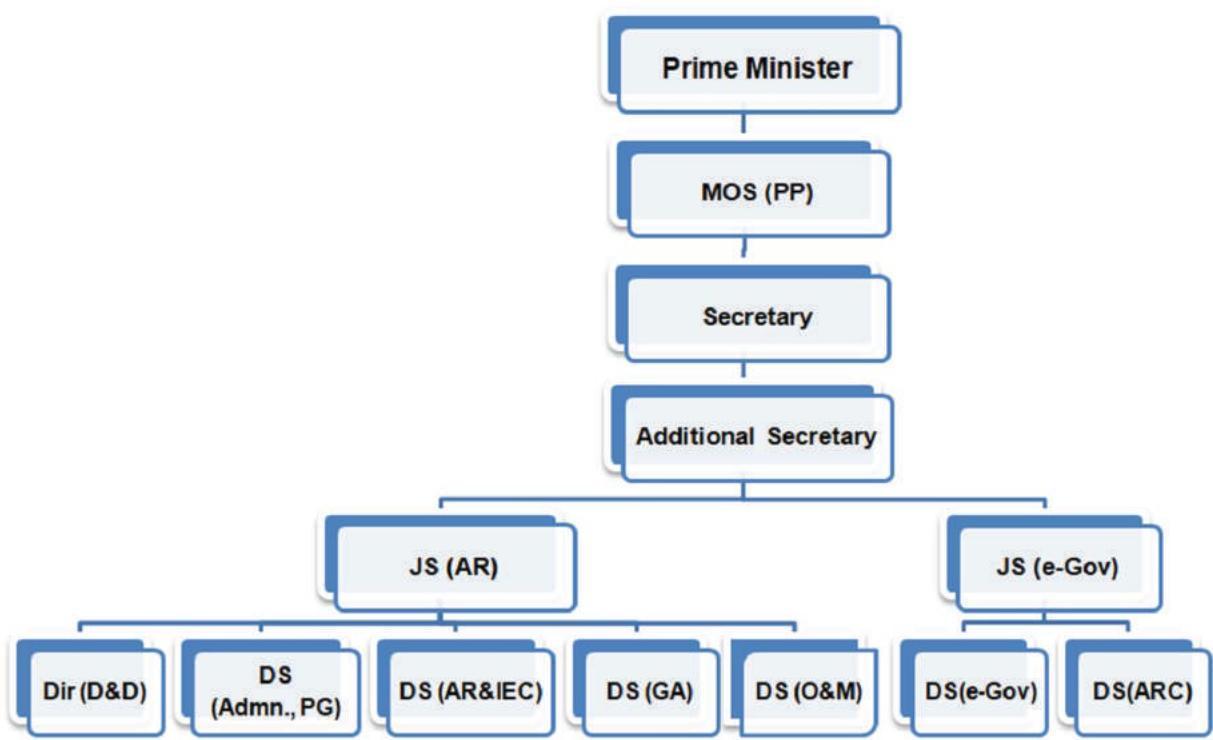
Department of Administrative Reforms and Public Grievances
Incumbency Position of Under Secretary and above level Officers in D/o AR&PG as on 31.03.2019
| Post | Name of Incumbent |
|---|---|
| Secretary | Shri K.V.Eapen |
| Additional Secretary | Shri V.Srinivas |
| Joint Secretary | 1. Shri V.Shashank Shekhar 2. Ms. Kiran Puri |
| Director | 1. Smt. Alpana Shukla Rao |
| Deputy Secretary | 1. Shri Satish Kerba Jadhav 2. Smt. Renu Arora 3. Shri Sandeep Mohan Prasad 4. Smt. Prisca Mathew 5. Shri Ajit Kumar Sah 6. Shri Sandesh Saxena |
| Under Secretary | 1. Shri Dhananjay Kumar 2. Shri Jagdish Kumar Ambwani 3. Shri Jitendra Sihwag 4. Smt. Pratibha Ahuja 5. Shri L.K. Halder 6. Shri Din Dayal 7. Shri Khamchin Naulak 8. Shri Gya Prasad 9. Smt. Vibhuti Panjiyar 10. Shri Kumar Sanjeet |
| PPS | 1. Shri Satish Kumar |
Annexure-IV
Department of Administrative Reforms and Public Grievances
Prevention of sexual harassment of women at work place
An Internal Complaint Committee has been constituted in Department of Administrative Reforms and Public Grievances for prevention of sexual harassment of women at work place comprising of following members:
(i) Ms. Kiran Puri, Joint Secretary
- Chairperson
(ii) Ms. Alpana Shukla Rao, Director - Member
(iii) Ms. Prisca Mathew, Deputy Secretary - Member
(iv) Ms. Hazel Siromoni, representative sponsored by YWCA - Member
Women employees are being made aware of existence of said Committee from time to time through circulars, display on notice boards and interactions. No complaint of sexual harassment from any of the women employees has been received during the year.
Department of Administrative Reforms and Public Grievances
Welfare of SC, ST, OBC and Persons with Disability (PWD)
As on 31.03.2019, the incumbency position of SC, ST, OBC and Persons with Disability (PWD) in the Group A, B and C category of officials of Department of Administrative Reforms and Public Grievances is as under:
| Category | Total | SC | ST | OBC | PWD |
|---|---|---|---|---|---|
| Group-A | 24 | 4 | 3 | 3 | — |
| Group-B | 39 | 6 | 1 | 5 | $1(\mathrm{OH})$ |
| $1(\mathrm{HH})$ | |||||
| Group-C | 19 | 8 | — | 1 | $1(\mathrm{OH})$ |
| $\mathbf{8 2}$ | $\mathbf{1 8}$ | $\mathbf{4}$ | $\mathbf{9}$ | $\mathbf{3}$ |
The Department has appointed a Nodal Officer to look into the complaints/ representations, if any, received from SC, ST and OBC officials and as also to watch their welfare. As per instructions of DoPT, the Department is submitting annual report regarding SC, ST, OBC and PWD incumbents online through the URL “rrcps.nic.in”. No complaint from SC, ST, OBC and PWD officials is received during the year.
CITIZEN’s CHARTER DARPG
VISION
Excellence in governance for the benefit of all citizens.
MISSION
To foster excellence in governance and pursuit of administrative reforms through:
- Improvement in Government policies, structures and processes
- Promoting citizen-centric governance with emphasis on grievance redressal
- Innovations in e-Governance
- Documentation & Dissemination of best practices
SERVICES/SERVICE STANDARDS and TIMELINES
| S.No | List of Services and service standards | Timeline |
|---|---|---|
| 1 | Redressal of Public Grievances: i. Action on grievances – Forwarding and monitoring for action by authorities concerned |
Within 60 days |
| ii. Monitoring of grievances (by senior Officials) | One Review Meeting and one VC every 3 months | |
| iii. Training on CPGRAMS (for Officers dealing with grievance redressal) | Once in a month | |
| 2 | Recognition of excellence \& innovation through i. Prime Ministers Awards for Excellence in Public Administration and Civil Services Day |
Once a year |
| ii. National Awards for e-Governance | Once a year | |
| 3 | Documentation \& Dissemination of best practices i. Regional Conference on good governance initiatives |
2-3 conferences in a year |
| ii. Production of documentary films on best practices | Films on PM Awarded/e-Gov. Awarded initiatives in a year. | |
| iii. Six monthly magazine ‘Minimum Government Maximum Governance’ (MGMG) | Two issues containing shortlisted PM/e-Gov. Awarded initiatives in a year. | |
| 4 | Support to Office Modernisation (Assistance to a set of Central Government Offices located in Delhi NCR) | Once a year (i) inviting proposals by May of the year (ii) release of funds by July of the year (iii) monitoring of release by March of the year |
| 5 | Assistance to States: i. Financial assistance to States/UTs/CTIs for Professional Documentation and Dissemination of good governance initiatives/practices through e-book (electronic) along with production of short documentary film under the Plan Scheme. |
(i) Proposals for Financial Assistance received up to 30th September of a year (complete in all respects) are placed before Evaluation Committee for consideration & recommendations within a month. (ii) Financial Assistance is released within 1 week from sanction of the project. |
|---|---|---|
| ii. Scheme for Strengthening of all State ATIs/CTIs through implementation of Sevottam Cell – For ATIs/ CTIs from whom the proposals are received. | Up to Rs. 20 lakh each upto Financial year 2019-2020 | |
| 6 | e-Governance Facilitating implementation of e-office – Providing assistance to Central Ministries/Departments |
30 days |
| 7 | IE\&C Bilateral Cooperation with other countries and foreign training of officers |
At least two training programmes in a year. |
CONTACT DETAILS OF OFFICER(S)
Deputy Secretary,
Department of Administrative Reforms and Public Grievances,
Sardar Patel Bhawan, New Delhi-110001
TelephoneNo: 23401429/23401408
Telefax: 23401444
Email: dirpg-arpg@nic.in
GRIEVANCE REDRESSAL
Visit the link https://pgportal.gov.in. Visit the website of CPGRAMS/PG potal – www.pgportal.gov.in _ > Register yourself as a user -> Register your grievance.
Expectations from the citizens with regard to Public Grievance Redress:
i. Grievance is to be lodged after registering on the above given CPGRMAS/pgportal link and supporting documents may be uploaded, if found necessary.
ii. For registration, correct credentials (eg- Name, Address, Phone and e-mail) to be provided.
iii. Issues given below will not be taken up for redressal and hence, may not be registered:
a. Sub-judice cases or any matter concerning judgment given by any court
b. Personal and family disputes.
c. RTI matters.
d. Anything that impacts upon territorial integrity of the country or friendly relations with other countries.
e. Suggestions
iv. Any grievance sent by e-mail will not be attended to/ entertained. Please lodge your grievance at pgportal.gov.in
EXPECTATIONS FROM CITIZENS / STAKEHOLDERS.
Citizens should first try to access the relevant information from the public domain.
i. Citizens should first take up their grievances directly with Ministries/ Departments / State Governments.
ii. Any query on the programme, scheme or activity of the Department should be clear and specific.
iii. All stakeholders participating in any activity or event of the Department should send the complete relevant information in time.
RIGHT TO INFORMATION
Visit the link www.rti.gov.in
Month &Year of Issue: February, 2019
Month \& Year of the Next Review: August, 2019.
Annexure-VII
Publication of e-Magazine titled “Minimum Government-Maximum Governance” e-Magazine,’Minimum Government Maximum Governance’ – January to June, 2018
| S. No. | Select Priority Programmes of National e-Governance Awards 2018 |
|---|---|
| Excellence in Government Process Re-engineering | |
| 1. | Aadhaar enabled Supply Chain Management, Vijaywada, Govt. of Andhra Pradesh |
| 2. | INAM PRO+ Gold, M/ORTH, Govt. of India |
| 3. | e-Abgari- mobilizing revenue resources, Govt. of West Bengal |
| 4. | e-Vidhan, Govt. of Himachal Pradesh |
| 5. | e-Migrate, MEA, Govt. of India |
| Outstanding Performance in Citizen- Centric Service Delivery | |
| 6. | e-ILP, Online Inner Line Permit, Govt. of Arunachal Pradesh |
| 7. | Integrated Service Delivery, GHMC, Hyderabad, Govt. of Telangana |
| 8. | Online Grievance Redressal System, Navi Mumbai Municipal Corporation, Govt. of Maharashtra |
| 9 | Soil to sale- solution for doubling farmers income, Rajkot, Govt. of Gujarat |
| 10. | Samarakshane- workflow solution for crop insurance, Govt. of Karnataka |
| Innovations in existing Government Projects | |
| 11. | MeeSeva 2.0- electronic service delivery, Hyderabad, Govt. of Telangana |
| Best District level initiatives through ICT | |
| 12. | e-Office implementation at DC office, Itanagar, Govt. of Arunachal Pradesh |
| 13. | e-District- East Khasi Hills District, Govt. of Meghalaya |
| 14. | Disaster Management Mobile App ADDMA, Aizawal, Govt. of Mizoram |
| 15. | Rohtang Permit- online Pass Issuance, Govt. of Himachal Pradesh |
| 16. | Padhe Dantewada Likhe Dantewada- mobile app based student tracking system, Govt. of Chhattisgarh |
| 17. | e-Megh- early flood warning system, Valsad, Govt. of Gujarat |
| 18. | Online Development Permission, Hyderabad, Govt. of Telangana |
| S. No. | Select Priority Programmes of National e-Governance Awards 2018 |
|---|---|
| Use of spatial technology and GIS in e-Governance | |
| 19. | Remote Sensing & GIS based mapping for Water Supply and Sanitation, Nagpur, Govt. of Maharashtra |
| 20. | North Eastern District Resources Plan Geo Portal- Applying Space technology in governance, Govt. of Meghalaya |
| 21. | GOPLUS- Portal for land use and services, Govt. of Odisha |
| Innovative use of ICT by Central Government/ State Government PSUs | |
| 22. | Smart Energy Infrastructure \& Revenue Administration, Patna, Govt. of Bihar |
| 23. | INFRACON- transparent procurement of infrastructure consultants, NHAIDCL, Govt. of India |
| 24 | SAP based ERP in Rajya Vidyut Prasaran Nigam, Govt. of Rajasthan |
| 25. | Sabooj Saathi- enhancing access to education in rural services, Kolkata, Govt. of West Bengal |
| Outstanding initiative in e-Governance by Academic/ Research Institutes and NGOs including Cooperatives/ Federations/ Societies | |
| 26. | Mahatma Jyotiba Phule Jan Aarogya Yojana- providing quality critical care to low income families, Govt. of Maharashtra |
| Replication/ Adaptation of the best e-Governance projects/ practices awarded during April 2014 to March, 2017 | |
| 27. | Manav Sampada-e-HRMS, Govt. of Himachal Pradesh |
e-Magazine, ‘Minimum Government Maximum Governance’ (July-December, 2018)
| S. No. | Select Priority Programmes of Prime Minister’s Award 2018 for Excellence in Public Administration |
|---|---|
| Promoting Digital Payments | |
| 1 | Bishnupur, Manipur |
| 2 | Daman, Daman &Diu |
| 3 | Sonipat, Haryana |
| 4 | Bokaro, Jharkhand |
| 5 | Bhavnagar, Gujarat |
| Pradhan Mantri Awas Yojana- Gramin | |
| 6 | Kangra, Himachal Pradesh |
| 7 | Kawardha, Kabirdham, Chhattisgarh |
| Pradhan Mantri Awas Yojana- Urban | |
| 8 | GHMC, Hyderabad, Telangana |
| Pradhan Mantri Fasal Bima Yojana | |
| 9 | Beed, Maharashtra |
| 10 | Shivganga |
| Innovations- Aspirational Districts | |
| 11 | Unnayan Banka- Reinventing Education using Technology, Bihar |
| 12 | Lighting Abhujhmad with Public Cooperation, Narayanpur, Chhattisgarh |
| 13 | Swachh Sangram, Vizianagaram, Andhra Pradesh |
| Innovations- Others | |
| 14 | U.P. 100, D/o Home, Uttar Pradesh |
| 15 | Community Engagement for Saving Daughters, National Health Mission, Rajasthan |
| 16 | Garbage Clinics- Solution for Garbage- free towns, Ambikapur, Sarguja, Chhattisgarh |
Department of Pension and Pensioners’ Welfare
ORGANISATIONAL CHART
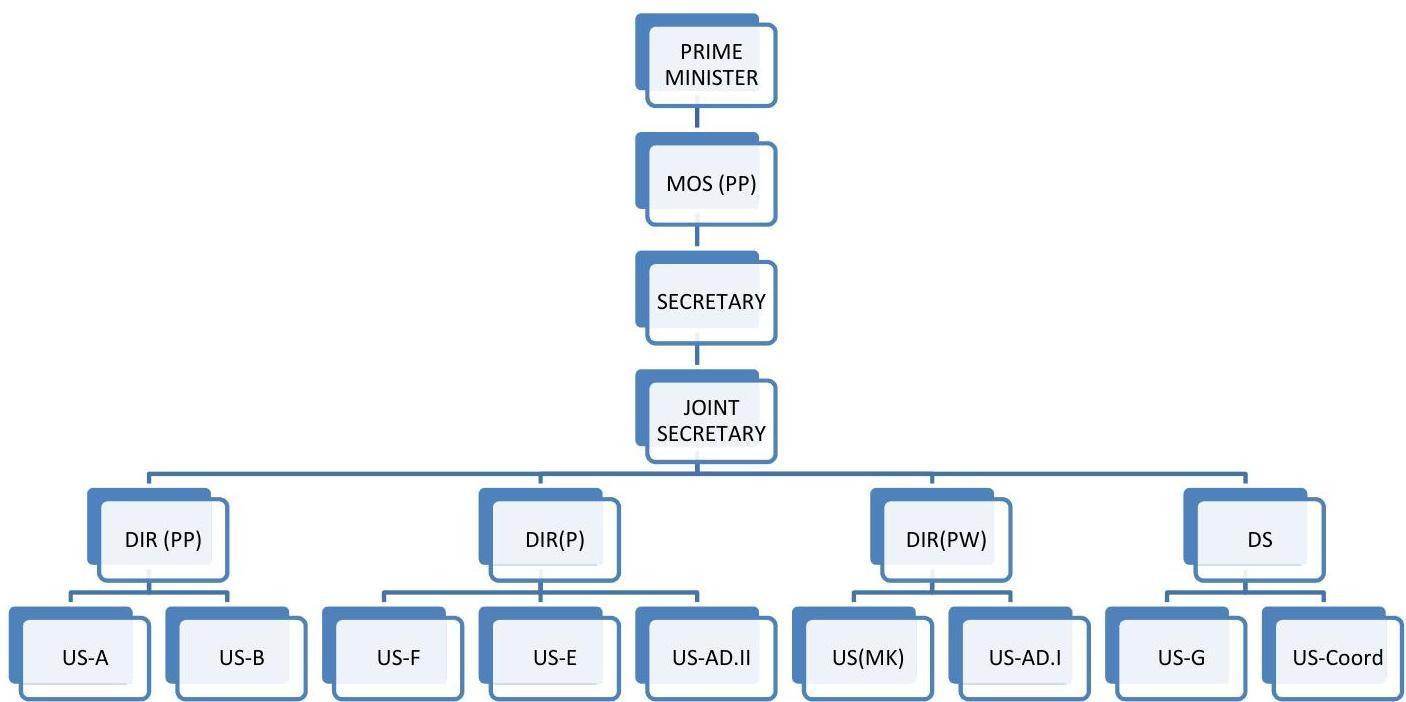
Annexure IX
Incumbency position of Officers in
D/o Pension & Pensioners Welfare as on 01/01/2019
| Post | Name of the incumbent |
|---|---|
| Secretary | Shri K.V. Eapen |
| Joint Secretary | Shri Sanjiv Narain Mathur |
| Director | Smt. Seema Gupta Shri Harjit Singh Smt. Sujasha Choudhury |
| Deputy Secretary | Shri Sanjay Wadhawan |
| Under Secretary | Shri Sanjoy Shanker Shri S. K. Makkar Shri Charanjit Taneja Shri Manoj Kumar Shri S. Chakrabarti Shri Ashok Kumar Singh Shri Rajendra Kumar Dutta Shri T .C. Varghese Shri Subhash Chander |
| Assistant Director(OL) | Ms. Pushpalata Kumari |
| Section Officers | Shri Rajesh Kumar Shri D. P. Singh Smt. Kiran Batra Shri Prashant Gupta |
Ministry of Personnel, Public Grievances & Pensions Government of India